 Swift
Conservation News
Swift
Conservation News
A Simply Stunning project in Nivelles, Belgium!
We hear again and again that renovations of "Listed" historic buildings
cannot include any features for wildlife, lest they impinge on the
original design. Not true at all, it seems!
Here in the grand and vast Romanesque church in Nivelles, about 200 new
Swift habitations have been created inside the ancient walls,
complementing the hundred or so Swift nests that already existed in the
original Scaffold Pole Holes that the medieval builders left unfilled
to enable quick re-scaffolding of the building whenever needed.
So about 300 nest places are now available for Swifts in this
ancient and magnificent church, re-born from ruins after severe
destruction in both World Wars.
Achieved and project managed by Martine Wauter's groups Martinets sans
Frontières / SOS Martinets and the Municipality of Nivelles, working
together to benefit Swifts and enhance biodiversity for all.
What an example to us all!
|

Photo © Cuspysan / Wikipedia
|

Swift
Conservation got together with Barry's local government and 51 architecture, creators of architecture for birds and beasts, to
achieve a milestone project, the erection of a brand new Swift Tower at
Barry Bay in South Wales. on a most attractive stretch of coastline,
reputed to be a bit of a migration hotspot.
Edward Mayer of Swift Conservation gave the inaugural talk, all about
Swifts and why they need help, and then led a visit to the Bay to see
the new tower in action. Not only was there a fly past of Sand Martins,
bang on cue, but there were also some Swifts! Hopefully they will nest in it in the years to come!
|
 
The tower incorporates insulated accommodation for numerous pairs of
Swifts, plus oakwood lined accommodation for small bats.
Photos © 51 architecture
|
Rather bad news for Swifts, we are very sorry to see
This chart on the right,
prerpared this year by the highly-respected British Trust for
Ornithology, shows that or every 100 Swifts that were present here in
the UK in1995, there are perhaps 15 now.
A ghastly decline. What are we going to do about it? More inspirational
talks, more persuasion, more co-operation with business and local
government, more nest box projects, more work with the media.
How about you?
|

Chart © BTO
|
New Swift Homes in France!
Projet Bouygues Immobilier, rue Ambroise Paré, Amboise in Touraine
|
This
project with Bouygues Immobilier followed a meeting that SOS Martinets,
the influencial French Swift Group, had with the elected town
councillor for Amboise who has the following responsibilities:
Sustainable management,
Green
urbanism & rewilding, Greenspaces and ecological transistion. The
Councillor gave SOS Martinets her backing for this project, a vital
step forward, and an introduction to the architects for this project, Parallèles
Architecture.
Carolyn Knowlman of SOS Martinets writes: Having e-mailed the architect
information about Swifts including lots of photos of other projects, we
agreed to meet. We went to their offices in Tours where Joanne Falourde
of Parallèles Architecture received us. We looked at the plans together
and suggested suitable spots for nest boxes.
A
few weeks later we were contacted by Bouygues Immobilier to attend the
installation of some of the nest bricks, supplied by Nat'H, to check
they were being fitted correctly. To comply with site security we had
to tog ourselves out in hard hats, fluorescent gilets and thick-soled
rubber shoes! Those working on the site were all interested and
enthusiastic. We gave out our little books " Je Suis un Martinet" and
went home tired but happy. It was all plain sailing, and Bouygues said
that they'd be in touch about their other projects. Watch this space!
The Project Team
Michel Toussaint, Carolyn and Tim Knowlman and Annie Schubnel from SOS
Martinets, and the Architect Madame Albrecht from Bouygues
Immobilier
All photos © SOS Martinets
Site Plans © Parallèles
Architecture
|
|
Swift Homes go up just in time!
Simon Strickland writes from Winteringham North Lincolnshire:
"I saw a Swift
tower down South some years ago during a bird society AGM. It intrigued me!
Then I
noticed that the Swift population was declining in my village and
so I started to try and help them by putting 4 Swift boxes in the church tower with timed calls,
but after 5 failed years I decided to move the nest places nearer to where the nest sites
are, along a street with the nests in the eaves but only one storey high.
The new
‘tower’ with 11 nestplaces with nest cups fitted is along the same street at the same
height, in an area where the Swifts constantly fly by. I will play Swift calls and
with luck may get some interest this year. One Swift was seen over
the village yesterday, 27 April, so there is hope!!
The project has cost nothing;
Martin made the tower; Mike and Phil have sourced wood and paint,
another Martin has agreed to the site and provided power, Adam erected
the tower, Andy has provided access.
And I chose the site to provide
cover from direct sunshine and with clear flypaths.
A great village effort
all paid for with jars of my honey!"
|


Photos © Simon Strickland
|
|
Swift Accommodation at Westminster Abbey!
After the recent Coronation, the next best bit of news from the heart of London is that
Westminster Abbey has been putting up some nest boxes for Swifts to
breed in when they come back from Africa in May. They have been sited on
a suitable ancillary building, not the Abbey itself.
This is a great idea! The Abbey's College gardens, which the nest boxes
overlook, are a good, well-planted peaceful place for wildlife, bats are already using
it for their nocturnal feeding runs, and the Thames is nearby, a river
that attracts Swifts to fly up and down it of a Summer
evening.
The idea of the Abbey gardening team, Matilda and Danny (seen in the
photo here with Edward Mayer of Swift Conservation) the nest boxes were
chosen to match the building colour (Victorian red brick), and to fit
neatly under the broad eaves.
The chicken wire
above them, as you can see in the photo on the right, is to deter Feral
Pigeons from nesting on top of them and driving away the hoped-for Swifts.
The project was promoted by Anna Wyse, Environment
and Sustainability Manager at the Abbey as part of a continuing effort to improve biodiversity there.
We are hopeful it will be a
great success and lead to further projects
to support Central London biodiversity, very much needed in our
increasingly wildlife-excluding urban world.
If you see any Swifts above and about the Abbey and the adjacent school
and Parliament buildings this Summer, do please let us know! We will of
course pass the information on to the Abbey staff, who will be very
keen to know.
|


Photos: © Westminster Abbey / Anna Wyse
|
Yorks Swifts get new homes!
Hundreds of residents in Scarborough, North
Yorkshire, are waiting right now for some of the fastest birds in the
world to return from Africa and nest in their homes!
Property managers Sanctuary houses people in Scarborough, and it is also helping Swifts, due to arrive back there in May.
Swifts
nest under the pantiles of Sanctuary's 1950's homes and these homes now
need re-roofing, which can be disastrous for Swifts as they lose access to their
nests and cannot breed.
So Sanctuary is installing 230 Swift nest boxes in Eastfield and Barrowcliff, accommodating half the town's Swifts.
Insensitive re-roofing elsewhere is one of the reasons behind Swifts'
50 per cent decline in Yorkshire since 1995. To remedy this situation,
Sanctuary paid for and put up special Swift nest boxes on all the
houses they re-roofed.
North Yorkshire Coast Swift
Group chairman Rob Stark says that, working with architects Alan Wood
and Partners, and Leeds-based Jennings Roofing, Sanctuary has achieved
a "model project".
This is in addition to other Swift nest boxes which have been put up by
the North Yorkshire Coast Swift Group in the Pickering and Whitby area.
If you live on the North Yorkshire Coast and would like to help Swifts, do get in touch with Rob! Just click HERE!
|
 Above: Swifts dashing through the sky and Justin Walker, contractor for Jennings Roofing Ltd based in Leeds, fitting one of the new Swift boxes.
Above: Swifts dashing through the sky and Justin Walker, contractor for Jennings Roofing Ltd based in Leeds, fitting one of the new Swift boxes.
Photos © Piotr Szczypa & James Hardisty
|
We talk at Falsterbö!
Early in 2024 we gave a talk on Supporting and Enhancing Urban
Biodiversity to Swedish BirdLife on ZOOM. The result was that they
invited us to give two talks at the prestigious and fun Falsterbö Bird
Fair in the far South of Sweden.
It's the jumping off point for millions of birds that migrate South
for
the winter, some going as far as South Africa and the Southern oceans.
Famous for its Honey Buzzard migration, it is in fact a good place to
see many others; raptors, waders and hirundines as well as warblers.
We met again Susanne Akesson, the academic at the University of Lund who initiated data logging
for Swifts, discovering for the first time exactly where they go
for the winter and the routes they take to get there. She is now researching sleep in Swifts, and the likely
results will probably overturn all theories advanced so far. |

Dusk at Falsterbö looking out across the sea to Denmark - the famous "Bridge" is out of view on the right.
Some migrating birds will rest for the night in the woods and fields
and along the shore then set off again at dawn, while others, smaller,
will fly by night.
You can hear them calling as they fly high above you in the dark.
Some don't stop, but just keep on flying - next stop Denmark.
Photo: © Edward Mayer
|
On
our visit to Sweden we were very lucky to meet again our old friend Jan
Homgren, one of Europe's pioneers in Swift research. Back in 2003 he
had aready established his own loft colony, based on the famous
pioneering work of Peter Lack in the Oxford Natural History Museum
tower and Erich Kaiser in Kronberg. Here he is (on the left) with his
friend Britt and me at the Bird Fair. On the right you can see his
colony set up for sustained observation in the loft of his home at
Skurup in Skane.
|
A Swedish Swift Study Colony

Jan Holmgren's Swift colony - in action now
formore than 20 years. It has seen its ups and downs but it is still
active, contributing to up to the minute Swift research in
collaboration with the University of Lund.
Photo: © Edward Mayer
|
|
Leuven University Swifts saved

Our Swift colleague in Leuven (Louvain) Belgium, Louis-Philippe Arnhem,
who looks after the Swifts in that city, (most of whom are nesting in
old and ancient buildings of the Catholic Church and University), sent
us these pictures of his latest project, aimed at sustaining the Swift
population of the Minderbroedersklooster (the Minor Brothers Cloister).
Here in the Onze-Lieve-Vrouw Ter Koorts (Our Lady of the Fevers)
Chapel, part of this complex, the Swift nesting places in the old
scaffold support holes have been assured exclusively for them by a
simple adaptation to exclude feral pigeons.
This is by using "Ferristones", made from a slice of an ordinary
brick
inserted as a wedge that stops pigeons from entering or roosting.
Pioneered by Mauro Ferri, one of Italy's most successful and prominent Swift experts,
they are simple, ridiculously cheap, and fully effective in any similar
aperture.
They can be made and installed by any bricklayer - see the diagram and instructions above opposite.
|
Images by Louis-Philippe Arnhem and (above) Mauro Ferri
 Twenty of the old scaffold pole holes have now been adapted for excluive use by Swifts - one is shown above
Twenty of the old scaffold pole holes have now been adapted for excluive use by Swifts - one is shown above
|

The
March for Nature happened in London on the 22nd June, just before the
election, aimed at telling the UK's political parties that wildlife and
the environment really do matter.
It was unique in that almost every environmental organisation in the UK took part - for the first time ever!
Surprisingly for those outside the UK, the political parties here pay
little attention to environmental matters, and appear blithely ignorant
of what the continuing collapse in the wildlife of Europe's most
nature-depleted nation means for our present and future in economic,
social and health terms.
"Ignorance is bliss" - as very few Members of Parliament live outside
cities and towns, we fear that the only birds most can recognise are
pigeons, ducks, and chickens, and a turkey too at Christmas plus of course the Robin. "A
Swift? What's that?"
At best, they seem to think that installing a few bee hives or planting
some trees, or encouraging school children to plant a few tomato
plants will solve everything. Last year we offered Members of
Parliament free training in supporting
urban biodiversity - the offer was refused. Likewise our local MP never
responded to an offer to train her team.
But the march was brilliant, massive creativity, a stunning atmosphere of love for nature, brilliant publicity.
Sadly the BBC more or less ignored it - the reason? Well, it seems to have been because there wasn't any violence!
|
The March for Nature
Photos: Restore Nature Now and Cathi du Toit / 51architecture.com
|
Rome - Spot the Swifts!
The Trevi Fountain hosts Swifts! Our supporter Jane Jackson sent us
this photo showing where she saw the Swifts who breed in the sculptures
of the famous fountain.
See if you can spot them too when you go to Rome! And maybe let us know if you do - photos very welcome!
By the way, Rome has plenty of Pallid Swifts too, you can see them from
April to October, right in the centre, and over Trastevere, they roost
and nest in roller blind boxes on 19th and early 20th Century
buildings, just watch for them slipping up into them at dusk!
Photo courtesy of Jane Jackson
|

|
 
Karen Blixen loved birds and bird song and turned her extensive garden
into a woodland and water nature reserve, full of birds, which you can visit any day. And the restaurant is ace!
|
Karen Blixen's Home in Rungstedlund, Denmark
We visited Denmark in late June and were lucky enough to go to the
Karen "Out of Africa" Blixen Museum at her former home, a fascinating visit,
and...... a big surprise, they had Swifts nesting in the eaves and in special Swift
nest boxes too! You can see six of them in the adjacent photo.
Photos by Swift Conservation
|
|
High Weald Swifts of Kent!
|
High Weald Swifts,
is a group that promotes and enables practical, pragmatic conservation
efforts within its Kentish target area, provides very valuable services from minimal resources.
It has installed nest boxes this year on three schools, two churches
and numerous houses, and also managed an exemplary Swift brick
installation on a new-build GP surgery at Tonbridge.
In addition it has over the past 6 months, as part of its raising
awareness remit, given several talks and run a Swift walk, and promoted
its work at community fairs.
It has successfully negotiated with two housing developers in Tonbridge
to reach agreement on the installation of Swifts boxes at two large
housing developments.
On the organizational / local government front it has promoted its
charity actively attending local planning meetings, national events and
the International Biennial Swift Conference held this year in Trieste.
Left, Cheryl Mason and a colleague staff their stall at a show. Their extensive work is an example to us all!
Photo by High Weald Swifts
|

Photo by Swift Conservation
|
Our Swifts are doing well!
We
have our own colony of Swifts at Swift Conservation's central London HQ
in West Hampstead. Between 20 and thirty Swifts nest in eaves in these
1930's flats, and we have put up another 30 + nestboxes to encourage
more. Breeding started off very very slowly this year, with hardly any
visible Swift activity, but we could hear them calling from the eaves,
so we knew they were there. Then when the weather got really warm, then
hot, activity just boomed. We had stunning aerial get-togethers and
hair raising flypasts low over our balcony as they accessed the eaves
above and behind us, and then at the very end of June, lots of "banging" too.
Meanwhile Extinction Rebellion has been putting up these little blue
plaques. This one is at West Hampstead's Overground Station, there are
others for other bird species too about Hampstead. A timely reminder of
what is going on and why we need to keep working to save our wildlife
from elimination in the cause of "Growth".
|
New Swift Nest Boxes in Denmark & at Severn Valley Country Park
Above:
More nestboxes go up on a house in Southern Denmark. Inger and Asger have
been hosting Swifts for over ten years here now. The first Swifts there used
a Starling nestbox, with success.
Then they put
up some more each year for the Swifts. These are the latest batch,
blocked with cloth bungs to stop Sparrows taking them over. The strings
are pulled and the bungs removed as soon as the Swifts are back!
Note: All the boxes were occupied by June this year!
On the right:
the Severn Valley Country Park Volunteer Group puts up four Swift
nestboxes under a footbridge over the River Severn. That wasn't the
difficult bit! Clearing the site of obstructing bushes to let the
Swifts gain access took much more time and effort.
The four new
nestboxes join about 150 others (about 70% used) about the Park. Swift
calls will be used to attract birds to the boxes.
We wish all these great Swift supporters every success!
|
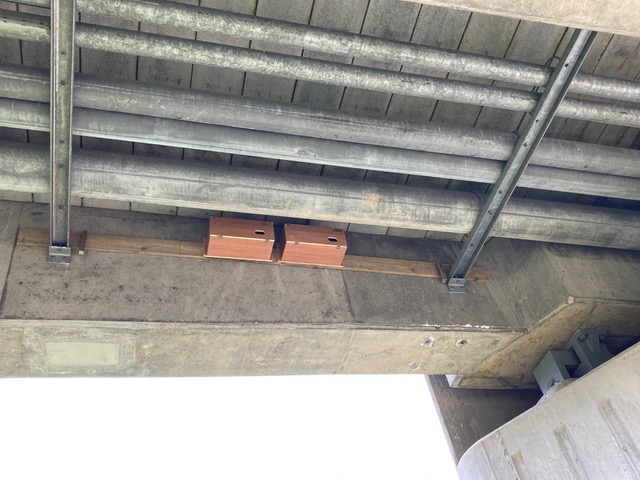 Stories & photos courtesy of Severn Valley County Park Volunteer Group & A Lund
Stories & photos courtesy of Severn Valley County Park Volunteer Group & A Lund
|
|
The Night Shift goes Red Light
If Swifts are the Day Shift of insect hunters, then
Bats are the Night Shift! But LED streetlights can play havoc with
nocturnal creatures, and can drive away bats.
More than 13,000 streetlights across Worcestershire have been
converted to LED as part of the County Council’s on-going £2 million
‘Rapid LED Roll-Out’ programme, and the project also includes installing bat friendly street lighting.
In
2019, the Council installed its first stretch of bat-friendly lights in
what was believed to be a UK first. Bat friendly street lighting has now been
installed in ecologically sensitive areas.
The award-winning project in Warndon,
Worcester, sets a high standard for others to follow: we just hope that
they do! Bats have vanished from many of their old familiar haunts in
the past 50 years, or even less, we'd love to see them return.
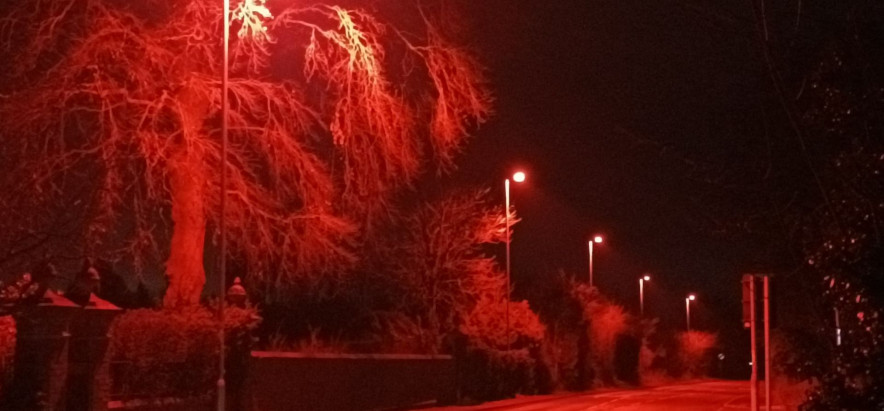
Stories & photos courtesy of Worcestershire CC and Martinets Sans Frontières
|
Councillor Richard Morris, Cabinet Member for the Environment at Worcestershire County Council, said:
“The bat friendly lights are part of this project and they better suit the local environment. The
amber and red lights being used may look a little different,
but we would like to assure those using the area at night that the
colour of the lights has been through rigorous safety checks.
We
know bats are an indicator of biodiversity health and so, if we protect
our bats, we are also protecting the local environment.’’
Below, a photo from Jette, Brussels, showing a sign in their new Red Light Area for
Bats! This red lit zone runs alongside a road running past a woodland area rich
in bats and other wildlife, keeping them safe and letting them hunt in
peace.
|
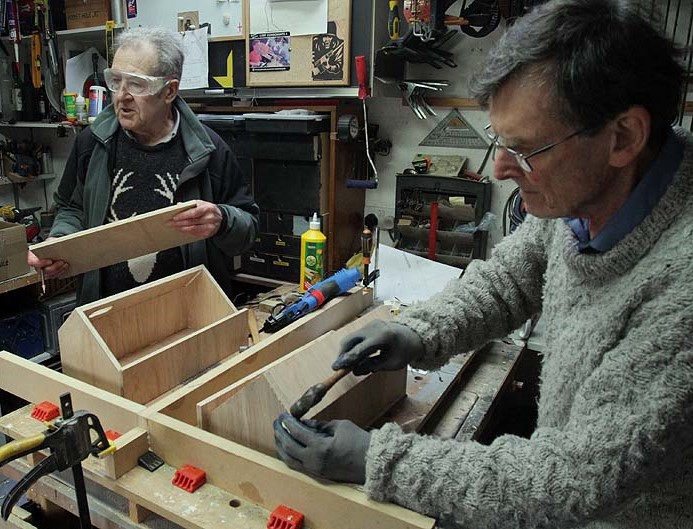
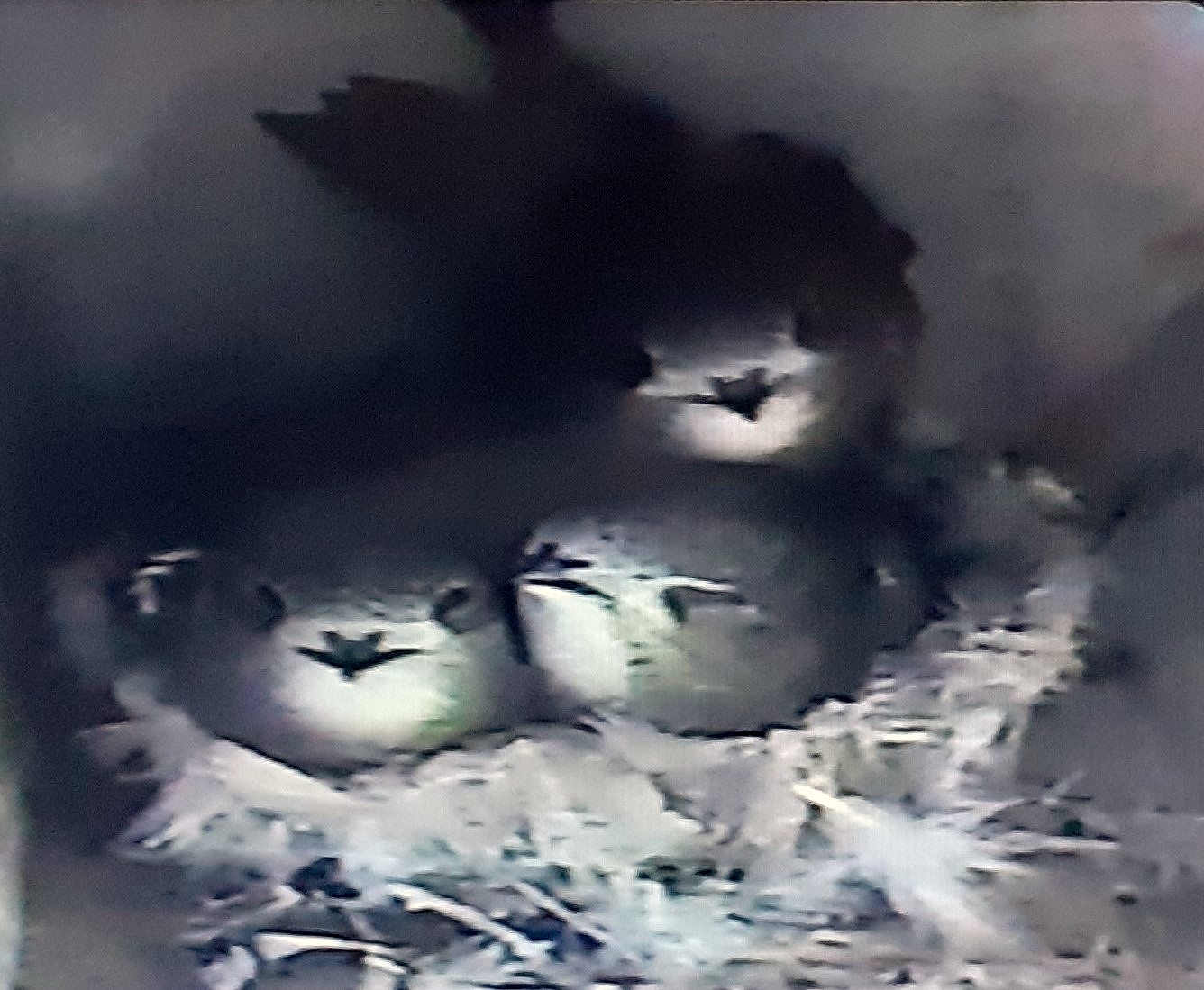
|
News from Harleston!
Peter Metcalf tells us the latest news from the famous Swift town of Harleston
in South Norfolk.
They are augmenting the current stock of about 150 Zeist style Swift nesting boxes in and around the town
in the weeks before the birds return in May.
This
will build on the reputation of the town
as a leader in Swift conservation. The idea is to give new
and refurbished nesting boxes to interested host families, as well as
adding boxes to known locations which have a successful breeding
record.
Top
left: Nest boxes being assembled in the workshop, below, three Swifts
in a nest box, probably all chicks, above right a Swift accessing one
of the Harleston nest boxes.
Photographs: © Peter Metcalf & Ian Rumsey
|
Machynlleth, Powys
Right: Swift
nest boxes go up in Machynlleth, a unique and historic town in the Dyfi
Valley in Powys, Wales. It is located in the heart of the UNESCO Dyfi
Biosphere set amidst breathtaking natural scenery.
These nest boxes are
the vital component in the "A Home For Swifts" campaign to get more Swifts to nest in the
town.
Wales has suffered some of the steepest declines in Swifts in the whole
of the UK, but is putting a huge effort into fitting new nestboxes to
try and solve this problem.
Swift Conservation donated £500 towards this project, and will be
giving a talk, and meeting Swift enthusiasts in Machynlleth on 6th
April 2024 at their Swift Festival, at the Y Tabernacl Auditorium.
|
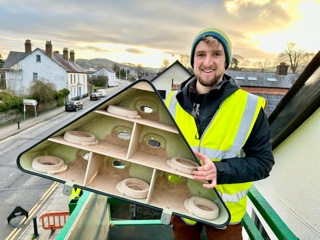
|
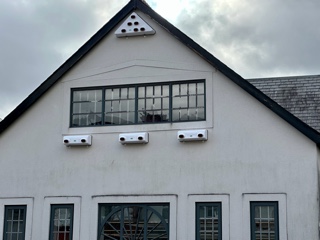
Photographs: © DyFi Biosphere
Below: the Machynlleth Co-op Store - the boxes (above) are on another facade
Below Right: the banner with Ben Porter's Swift photograph that advertises the "Home for Swifts" project
|
Left: Swift nest boxes fitted at the front of the Machynlleth Co-op Store
Thank You the Co-op!
The Project Launch for this will be in April at the Swift Festival,
which will also be attended by Jonathan Pomroy, the well-known wildlife
artist.
He too will also be giving a talk and also an innovative bird sketching and painting
session, and the event will be attended by Ben Porter, award winning wildlife photographer.
Free admission! Contact 01654 703355 or e-mail info@moma.machynlleth.org.uk
For lots more information about the Project click here
|
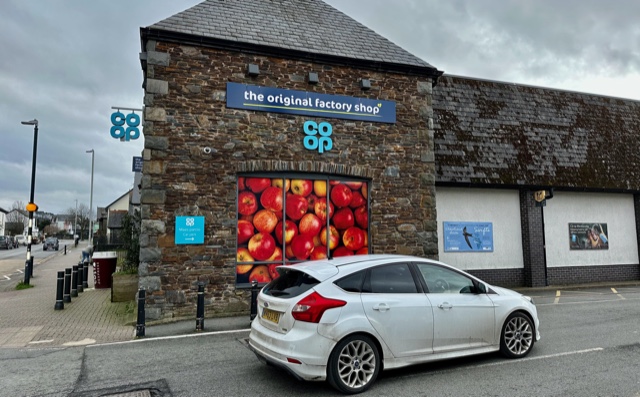
|
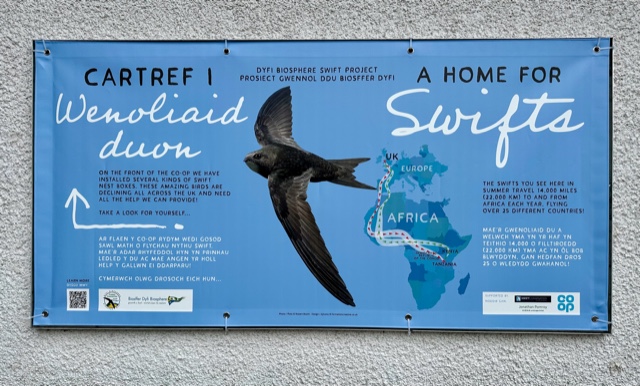
|
The Leaside Trust
Leaside
is a community place in East London, set beside the River Lea, where
you can meet, play, and learn to support each other.
Everyone is
welcome. Its mission is to serve the local community, especially young
people, by providing opportunities for water based activity, environmental learning and adventure.
From kayaking iconic London waterways, paddleboarding, mountain biking, and hiking to boat rentals and venue hire. The
activities offer fun, new eperiences and a community connection. Everyone is
welcome, so why not join up?
The Leaside Trust is a Registered Charity No. 1027645.
|
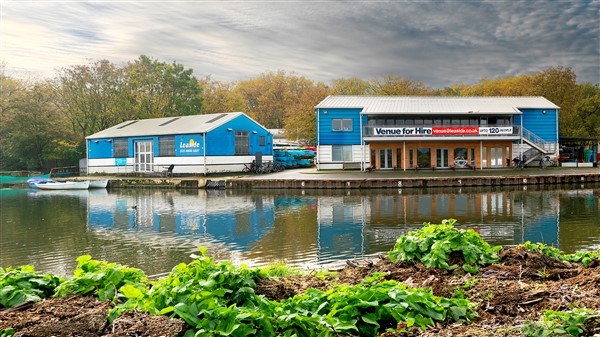
Photographs: © The Leaside Trust
|
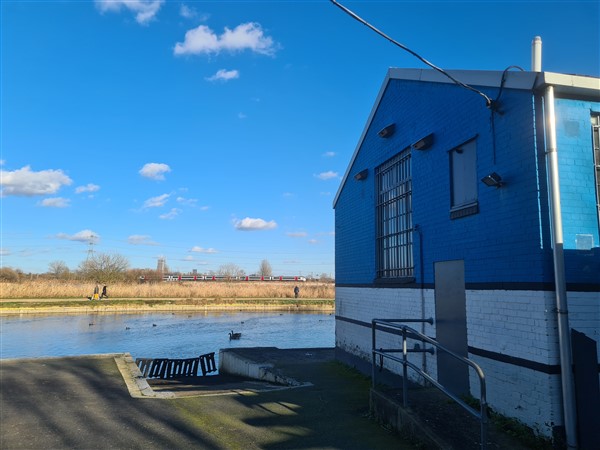
|
Above
- the Leaside Trust's centre. Leaside is committed to supporting and
enhancing biodiversity.
As part of that policy it has recently set up
Swift nestboxes donated by Swift Conservation.
You can see three of them on the left, in a good site right opposite
Hackney Marshes where the Swifts' insect food should be plentiful.
Why not visit? Take a canal boat ride, or do some kayaking, or just
wander the Marshes and revel in the local Skylarks' song, and
watch out for some Swifts whizzing by!
A great way to ease off those inner-city tensions!
|
Major new Swift nest-box projects going up in 2023!
Going up in Wales, at Sheffield University and in Leicestershire!
Below,
a huge array of Impeckable nest boxes on the Venue Cymru arts
and conference centre in Llandudno - just the perfect place for
Swifts!
Photograph: © Len Haworth
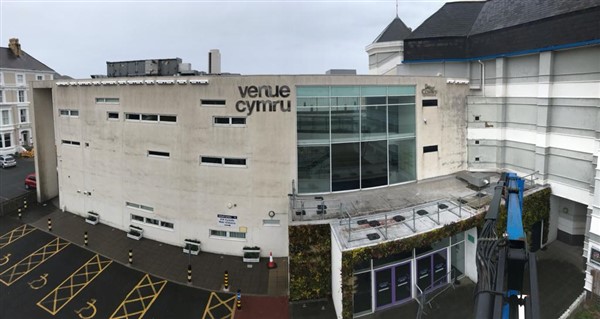 |
Welsh Government - 950 nests
Leicestershire CC - 364 nests
Sheffield University - 32 nests
There are some really very serious indeed Swift nest box projects taking off in both England and Wales.
Late in 2023 we were told of the above projects, and we think that more are on their way in Wales.
Most if not all are using the Welsh-manufactured Impeckable glass fibre
nest boxes, rain-proof so well suited to the wetter West coast and
climate with a life of 50 years, and proven success in many locations.
Photograph: © Len Haworth
 |
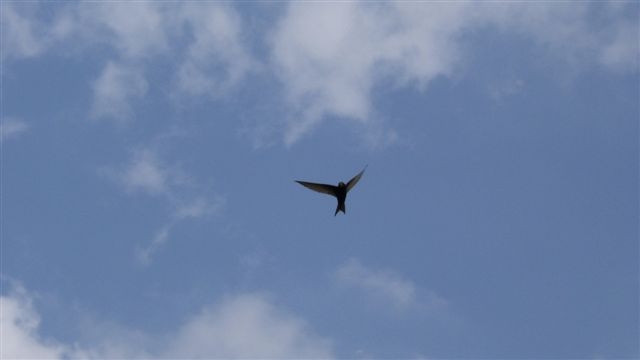
|
Lone Swift over the Bay of Biscay
Jane Jackson writes to us:
"Back in August I took the ferry to Santander - and was very
surprised when a lone Swift joined us! We were treated to a glorious
acrobatic display around the boat for at least 15 minutes. We also
had numerous Orcas - water spouts everywhere. At first I found
myself trying to look at both - but very quickly it was the Swift
that had my full attention! Just when I thought I'd seen my last Swift of the year - this was a real bonus.
I have no idea if Swifts often accompany boats on their migration -
but thought you might be interested."
And we are!!! You can see Jane's Lone Swift on the left. Has anyone else seen this phenomenon?
Photograph: © Jane Jackson
|
Cala Homes, a major UK property developer, has just introduced its
Urban Biodiversity Strategy
|
It's very interesting! Download your copy
|
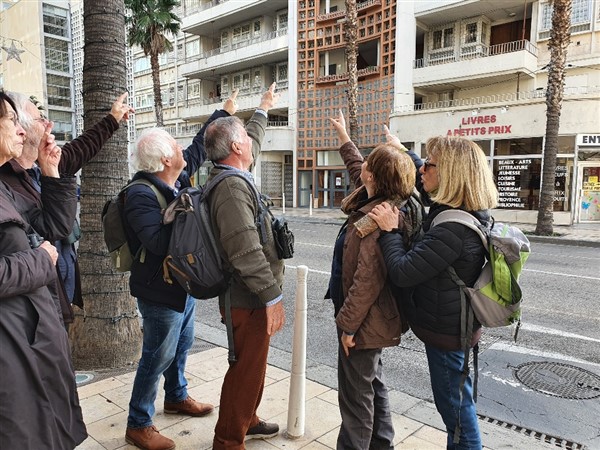
Above:
Near the Mediterranean waterfront in Toulon, Southern France. Key
speakers from Switzerland, the UK and Belgium attending the Toulon
Urban Biodiversity Conference are shown by conference organiser Katherine Dubourg (on
the right) exactly where Swifts are nesting in modernist 1960's offices
and apartment blocks, now needing major restoration and repair.
On the right, two views of the massive new Chalucet development in
Toulon; the lower photo shows two of the Swift Bricks inserted into
the fascia (the black dots are their entrance holes).
Toulon presents particular problems for Swifts and urban biodiversity.
A historic and in parts very run-down building stock is housing
thousands of Swifts, both Common and Pallid species. As the city
adjusts to the modern world, and rebuilds, Swifts are in danger of
losing their nest places. But local activists are on the case,
persuading property owners and developers to preserve existing nest
places and create new ones, mapping every nesting site that they
can discover, and logging their sites with the Municipality for legal
protection to fall into place.
Key property owners, such as the French Navy, are helping. The result?
300 new nest places being set up in the former Navy Arsenal area,
just one of many similar projects within Toulon's old town.
Many old historic buildings within the core of the Old Town, around the
restored Municipal Market, now have Swift Bricks installed, while old
nest sites have in some cases been retained successfully. It was a very
interesting and impressive visit showing what a group of about 40 local
activists can achieve in a major and fast-evolving city.
|
The Toulon Urban Biodiversity Conference November 2022

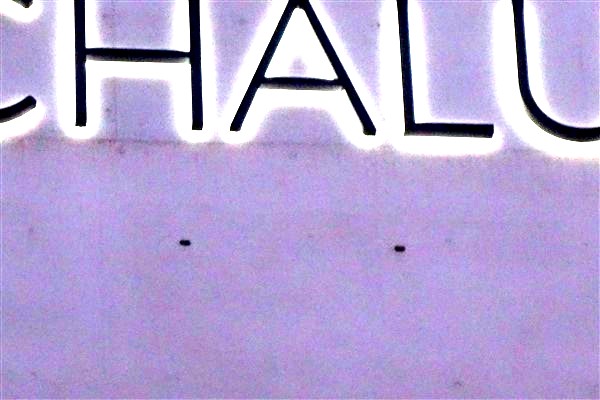
Swift
Conservation's Edward Mayer was invited to open the Toulon Urban
Biodiversity Conference. His talk was followed by expert contributions
from key speakers Marcel Jacquat and Bernard Genton of Switzerland,
Martin Wauters
of Belgium, Gérard Gory from Nȋmes (France) and Yasmine Corazzini from
Nice (France). One day of lectures and discussions was followed by two
days of visiting local Swift projects and viewing local nature reserves
and biodiversity projects.
Organised
by the Ligue pour la Protection des Oiseaux and supported by local
government and NGO's, the Toulon Conference brought together
ornithologists, local and international activists, local government,
nest box manufacturers and tourism promoters.
Photographs: © MS Mayer / Swift Conservation
|
Swifts in Herefordshire Churches - the Staunton Swift Project
The
Herefordshire Bat Research Group (HBRG) has been raising awareness for Swifts since
2014, as part of a local Bats and Swifts Project. The biggest danger to Swifts is the loss of
nest sites during repair and renovation works, so surveying and mapping their nest
sites is important so we know where they are and what sites need protecting.
A
total of 128 churches were surveyed by local volunteers for Swifts with
34 Schwegler Swift boxes being installed at 12 Herefordshire
churches. A mammoth task, and so far Swift presence has been recorded in 11 out of 28 boxes.
To see their inspirational and very interesting illustrated report download it here.
|
 
The above photographs show
Swift droppings, "pellets", recovered during survey work on vacated
nest places. Left: pellets as found. Right, a pellet broken open to
reveal the indigestible remains of aerial insects, indisputable evidence
that the pellets came from aerial insectivores enjoying a pure insect
diet.
Photographs: © HBRG
|
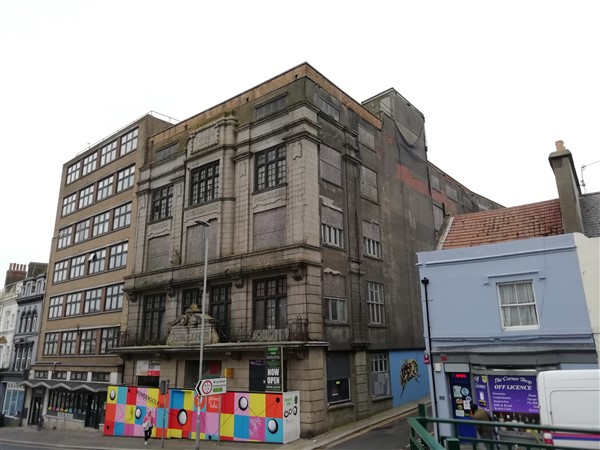
You
may have noticed earlier this year that we were supplying Action for
Swifts "S" type built-in Swift Bricks to this social enterprise project
in Hastings. The old Hasting's Observer building has been converted
into apartments, workshops and a social support centre. As part of
that project it is hoping to contribute to supporting local
biodiversity - Swifts to be precise!
The photograph above shows the Observer Building before the refurbishment
project got going. The photo on the right shows the newly-installed
Swift Bricks in the lift shaft wall, on the left of the side street
leading up from the main street below.
|
The Hastings Observer Building update!
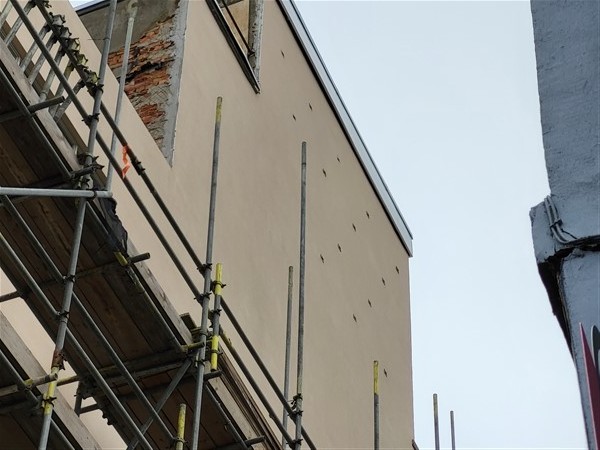
Photographs: © Hastings Swift Group and Swift Conservation
|
We Visit Thames Water's Beckton Sewage Treatment Works (STW)
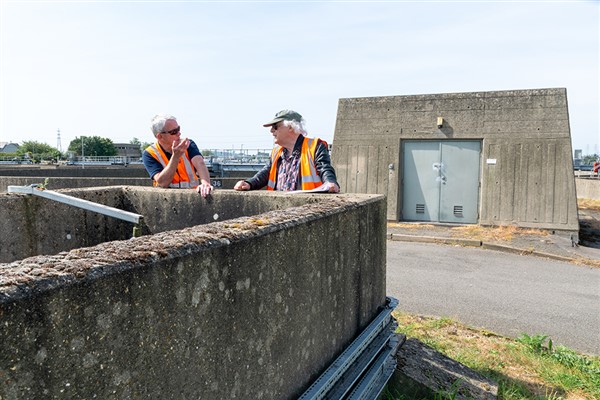
Swift Conservation's Edward Mayer (right) and Beckton Creekside Nature Reserve Warden Danny Regan (left) discuss the possibilities amidst vibrant Spring birdsong
We were invited to visit Beckton STW in East London (the largest in
Western Europe) to discuss what they could do to attract Swifts to
breed at their huge site, much of which is devoted to supporting
wildlife. The result? With any luck we might be putting up a Swift Tower there with the help of our freinds at 51architects.
Beckton's
wildlife riches are spectacular. It has Peregrine Falcons, Kestrels,
Barn Owls, Tawny Owls, and Buzzards (we saw one), Little Gulls transit
through it, and while we were there Greenfinch, Chaffinch, Goldfinch, Whitethroat, Blackcap, Chiffchaff
and Sedge Warblers were all singing away. There are plenty of other
birds there too, and in Autumn and Winter the nearby tidal banks of the
Thames are packed with waders such as Godwit, Avocet and Curlew.
|
Plan a Visit!
There
is good public access to the nature reserve, so visit while the
Spring migrants are still in full song. You won't regret it!
Photos © Peter Thomas 51architecture
|
London's Ragged School Museum in E3 installs Action for Swift's Swift Bricks
The
Ragged School Museum is a landmark of Victorian philanthropy combining
two important national stories; the struggle for free universal
education and the role of philanthropy in driving social change.
Opened as a Ragged School by Dr Thomas Barnado in 1877 these former
canal warehouses on Copperfield Road in Mile End were saved by local
activists from demolition in the early 1980's. The Ragged School Museum
offers primary schools a Victorian lesson in an authentic setting.
This programme runs to near capacity with schools participating from
Greater London and the South East. But Number 46 Copperfield Road, the
largest of the School's three buildings, needs to be renovated, and
about half of the Museum's space is not yet fit for public use.
In
June 2019 the Heritage Lottery Fund approved the development of the
site, permitting extensive refurbishment. This project will bring over
618 sqm into productive public use. A new permament exhibition in an
atmospheric building will bring to life in the most vivid way the
struggles of the Victorian poor and the power of education to change
lives.
Below, a Regent's Canalside view of the School.
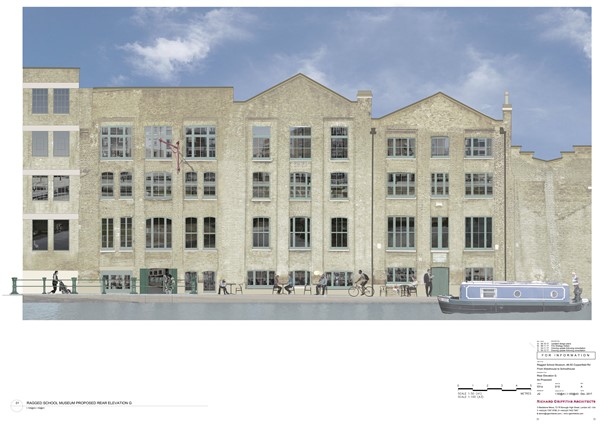
|
Swifts
used to nest in houses on the nearby Victoria Park Road until they were
pulled down. So Erica Davies, Director of the Ragged School Museum,
thought it would be a nice idea to host Swifts in the renovated
warehouse that is to become a central part of the Museum.
Working with Swift Conservation and Action for Swifts, Erica and the
design team oversaw the installation of Dick Newell's "S" Bricks,
ground-breaking lightweight Swift Bricks that can be matched to the
existing brickwork's colour and texture.
Photo © Erica Davies / The Ragged School Museum
|
The Worcester 6 Business Park Swift Tower goes up!
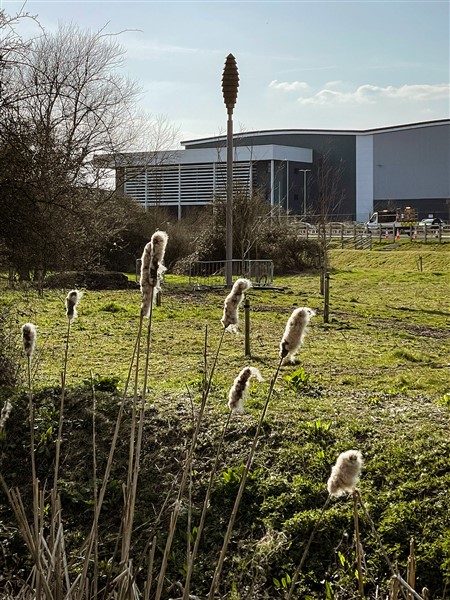 Photos © Peter Thomas 51 architecture
Photos © Peter Thomas 51 architecture
|
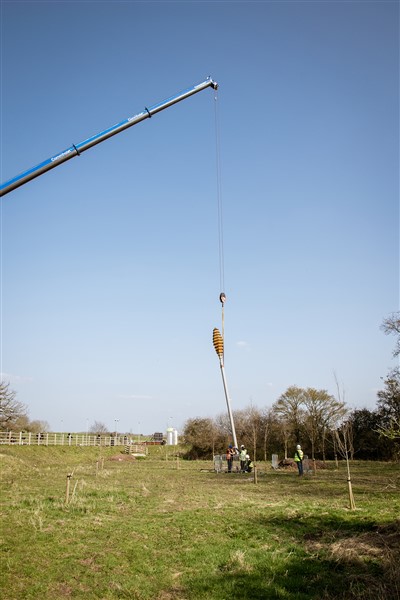 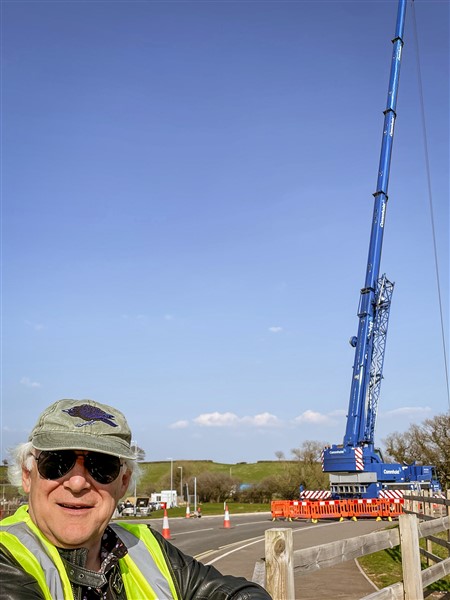
Together with our friends Peter and Cathi at 51 architecture, we have been
working on the design of new-concept Swift Towers and nest-boxes for
some years now.
This has resulted in the production of nestboxes in a radical new
material, Barsmark, made from recycled wall insulation, and a range of
Swift towers based on mobile phone masts, for rigidity, strength, wind
resistance and an appearance that, these days, blends into the urban
and near-urban landscape.
The towers provide accommodation for Swifts in snug, very well
insulated wood lined chambers, reminiscent of the old woodpecker holes
used by tree-nesting Swifts in the ancient forests of Europe. The bats
have crawl spaces made of oak shingles.
The biggest of these towers provides for 24 pairs of Swifts, and one
has just been set up in a small river-side nature reserve, full of
birds and other wildlife, beside the Worcester 6 Business Park, just
outside Worcester. The photos show the installation and the result.
|
|
We work with MA Product and Furniture
Design Students at Birmingham City
University on Swifts
and their nest box needs
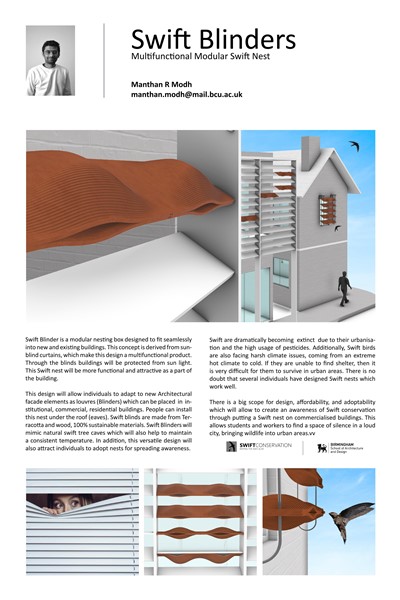 Photos © Nuno Lourinho/Birmingham City University
Photos © Nuno Lourinho/Birmingham City University
|
During February and March we spent time with 6 students
from Birmingham City University and their Course Director
Nuno Lourinho. The students, Forum Gorsiya, Stefan Ionita,
Quihan Li, Yifei Ma, Manthan Raieshkumar Modh and Yufan
Xu, all prepared detailed designs for Swift nest boxes.
The
aim was to bring new and innovatory designs to the commercial market,
for manufacturing in factories and for sale in big numbers, here and
abroad. The UK market at present is seeing shortages of Swift nest
boxes right across the board. Many suppliers are out of stock, others
are struggling to fulfil orders. So the demand is there, and new
products that "look outside the box" and are not just a box screwed to
a wall but integrate with modern building design values are badly
needed.
The designs were judges in a competitive setting, and the winner was Manthan
Raieshkumar Modh, with his highly innovative and elegant
"Swift Blinders", long terracotta tiles that doubled up as
sun-blinds and Swift nest places, based on their
traditional nesting places in Roman tiled roofs. Tow other designs became the runners-up.
The long-term aim is to
bring one or more of these designs to the marketplace. So a period of
product refinement with mass manufacture in mind will be starting soon.
We will try and bring you more information about this as things
progress.
|

70 Nestboxes for 70 London Schools
Celebrating 70 Years of H M The Queen's rule
The Cameron Bespolka Trust
and their Young Ambassador Kabir Kaul, a passionate birder who attended
one of our early lectures on Swifts (that one paid off, didn't it!) have been
running a scheme to supply bird nest boxes to 70 schools in London.
The aim is to interest, enthuse and teach young people at their schools
about wild birds through direct experience, an aim we wholeheartedly agree
with.
The Cameron Bespolka Trust's mission is to create opportunities for
young people to engage with and appreciate nature. They work with and
for 14 to 17 year olds, a crucial period for keeping young people involved and
connected. They try to reach in particular those who have not had the
chance to experience the outdoors.
All
the nestboxes have now been taken up, but do contact us if you are
interested, as we support nest box projects all over the UK.
|
Swift Conservation is working this year with the the Cameron Bespolka Trust
to help with their very imaginative scheme to educate and inspire
children by setting up nestboxes for birds at carefully-selected
schools in London.
We have supplied 20
nestboxes for Swifts at schools that are keen, have suitable buildings
to support the nestboxes, and come up
with management plans to assure us the birds will be safe and
well-looked after, and the results accurately assessed.
You can help with a donation to Cameron Bespolka, and/or Swift Conservation!
Below: A typical Swift nest box - similar ones will be fitted to the London Schools joining the project in 2022
|
Sheffield S6 Swifts goes for "S" Bricks
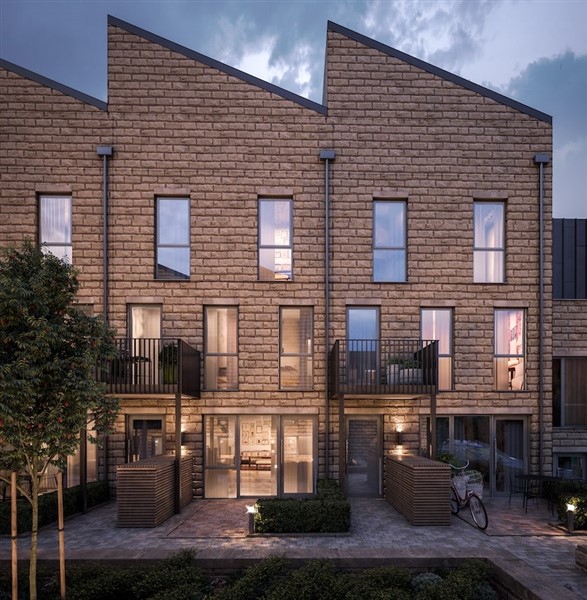
S6 Swifts and Edward Mayer of Swift Conservation have been advising at
a new homes development in North Sheffield, at Oughtibridge, where
3 storey houses are being constructed by the River Don, (right) an
ideal site for Swifts. The Swift Bricks, (shown upper right) are faced
with the same stone as is used for the buildings shown above. The Swift
Bricks will be inserted very near the top of each dwelling, so the
Swifts get the height and easy access they need.
Photographs & Images Clockwise from above © Sky House plc, Dick Newell/Action for Swifts, Mel / S6 Swifts
|
S6 Swifts is a small Swift support group operating in the
north of Sheffield, covering an area with a high concentration of late
Victorian houses, with a resulting significant resident population of Swifts that
visit every Summer to breed there. Their web site is HERE
Although S6 Swifts only started up in July 2021, they have fitted
117 new nest spaces so far and have arranged to fit more in 2022.
In fact, they hope to have fitted 200 new nest places before the Swifts arrive
in May. They already have hundreds of followers on social media and will be
fitting the first educational nest boxes, the first of hopefully many, at local schools,
again this Spring.
|
Taylor Wimpey's Burghley Green development in Cambourne & Swifts
Sadly, the population of Swifts in
the UK declined by 58% between 1995 and 2018, resulting in the species being
added to the UK’s Red List for Birds in December 2021.
To
help address this biodiversity crisis, Taylor Wimpey has worked with
Action for
Swifts to incorporate "S" Bricks into the exterior walls of 85 new
homes at the Burghley Green development in Cambourne. These
traditional-looking houses with broad expanses of brickwork, big gables
and brick construction should be most attractive to Swifts, as well as
to their human owners!
|
More
"S" Bricks are planned for Varsity Grange, in Northstowe. As a result, many local
Swifts will now be able to find a safe place to nest when they return from
Africa in May.
Other
regular visitors to local homes and gardens, such as House Sparrows,
Blue Tits, Great Tits and House Martins, will also benefit from this
innovative
approach to eco-friendly
development, as they all may use "S" Bricks
too.
Dick Newell, spokesperson for Action for Swifts, explained: “We’re grateful to Taylor Wimpey
for their help with our projects to help Swifts and other birds too. Natural nesting places like trees and hedges can take a
few years to get established where new homes are built, so natural habitats can
take a long time to materialise. For these reasons, building new homes with ready-made
nest bricks is a quick way to tackle the rapid decline of Swifts and other
small cavity-nesting species.”
Jordan
Last, Planning Co-ordinator for Taylor Wimpey East Anglia, added: “The work
that we do goes far beyond building high quality homes. We’re committed to
leaving a positive, lasting legacy around our developments and we think a
crucial part of this is safeguarding the natural environment and native
wildlife.
“We’re
delighted that the first Swift nest-places are now in place and ready to accommodate
their new residents at Burghley Green and soon, Varsity Grange. Looking ahead to the
future, we plan to replicate this approach across multiple sites throughout the
region.”
Image © Courtesy of Talor Wimpey East Anglia
|
Mainz in the Rhineland goes for UK GRP nest boxes
We
recently received these photographs from Consultant Biologist Jens
Tauchert in Nackenheim, Rhineland. These nest boxes are installed
on the buildings of a German chemicals company, Werner & Mertz in
Mainz (the town where the Pfizer Covid vaccine was created).
Above you can see five of the multiple nestboxes fitted just below roof
level, and in the photo on the right, their relationship to the
chemical plant.
Photographs © provided by Jens Tauchert courtesy of : Beratungsgesellschaft NATUR dbR Website: www.BGNATUR.de
|
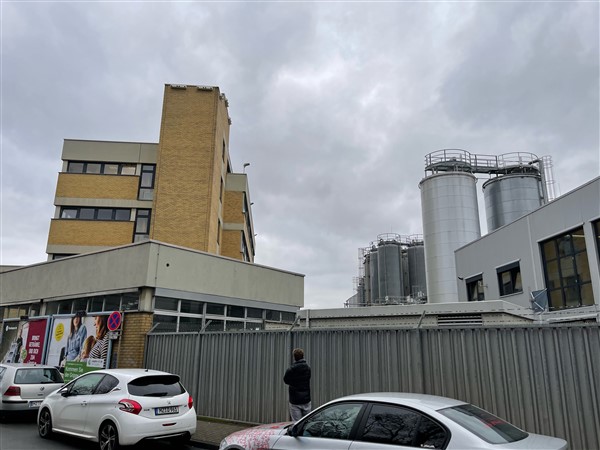
A
good
sight to see - these UK made nestboxes being exported and set up in
Germany, where the very first commercial Swift nestboxes were
manufactured over 50 years ago, and where creating nest places for
Swifts on a big scale took off well before it did here in the UK.
|
West Hampstead flats estate tries to boost Swifts with new nest places
Images © Courtesy of Cholmley Gardens Co.Ltd. and Ron Oruci of Treehab Construction Co.Ltd.
|
Edward
Mayer of Swift Conservation, working with Ron Oruci, site manager for
Treehab Construction, has been fitting Swift nestboxes made by
Impeckable and John Stimpson to a major 1920's estate of apartments in
West Hampstead, London NW6, Cholmley Gardens.
A dozen nest places have been fitted to lightwell walls and roof top
tank houses, with more planned for erection in 2022 and 2023.
Cholmley Gardens has a famous historic populaton of these spectacular
birds, nesting in the "open" eaves, and sadly driven out of many other
such apartment estates in the area by unsympathetic roof repairs and
intolerance.
Although reduced in number in recent years, the Cholmley Swifts are hanging on,
and it is hoped that the new nestboxes will encourage other Swifts
to move in and join the incredible Summer fun as the birds scoot about
all over the sky, past human residents sipping aperitifs on their balconies
on hot Summer evenings. Bliss!
|
ALDI's store in Bangor, Wales, Commits to Swifts!
This new
Aldi site, currently under
construction on Caernarfon Road in Bangor, will have special "Impeckable GRP" nest-boxes
for Swifts installed at the rear of the building, says North Wales
Wildlife Trust’s Swift project manager, Ben Stammers. These GRP nestboxes are guaranteed for 50 years.
Thanks to the
developer Bampton Property
Group Limited, the building will provide much-needed accommodation for
these long-distance migrants, in serious decline across Wales.
|
‘The
new site is close to one of the
few remaining Swift colonies in Bangor’, says Ben, ‘so it’s hoped the
new
boxes, designed and made by Wrexham-based company Impeckable, will
allow the Swifts to expand their local population. Swifts are our
fastest birds
in level flight – they can sleep, eat, drink, mate and preen on the
wing, and
may spend two or even three years in the air before returning to find a
place to breed. Nesting in buildings, their options are steadily
reducing as insulation, refurbishment and new designs eliminate old
nest sites. So the Wildlife Trust has been working
across North Wales to promote Swift box installation, and we’re
delighted that
Bampton Property Group have considered them with this measure.’
Gwynedd Council helped to facilitate
this collaboration, and have recently had Swift boxes installed on their own office
buildings in Caernarfon. ‘Although Swifts now also face a
problem of declines in their insect prey, we’re hoping that more widespread
provision of nest boxes and Swift bricks (which are built into walls) will
at least start to address their housing crisis. This would contribute towards
the Wildlife Trust’s vision for nature recovery networks across Wales.’
A spokesperson for Bampton Property
Group said: ‘We take our biodiversity commitments very seriously, and in this
case are glad to be able to do something to help these amazing birds’
To find out more about nature
recovery, or how you can help swifts, you can visit the North Wales Wildlife
Trust website: visit North Wales
Wildlife Trust
Image © Courtesy of ALDI Supermarkets plc / Bampton Property Group
|
HRH Prince Charles is interviewed on the BBC and he says:
"There is something irresistible about a Swift - We are part of Nature, not apart from it"
Prince Charles' world "Would come to an end if the Swallows House Martins & Swifts didn't return"
To see the full BBC Interview with Simon Armitage in
"The Poet Laureate has Gone to His Shed"
please click here and to see the text click here
|
Photograph © John Duckfield/Wikipedia
Prince Charles has equipped his Welsh country home Llwynywermod, just outside the Brecon Beacons National Park,
with Swift nest boxes and a calling system to lure them in.
You can rent a holiday cottage at this complex, so why not stay and see how the Swifts are doing? Use this link!
Duchy of Cornwall Holiday Cottages
|
Reed St Mary Church near Royston fits Swift nest boxes into its tower
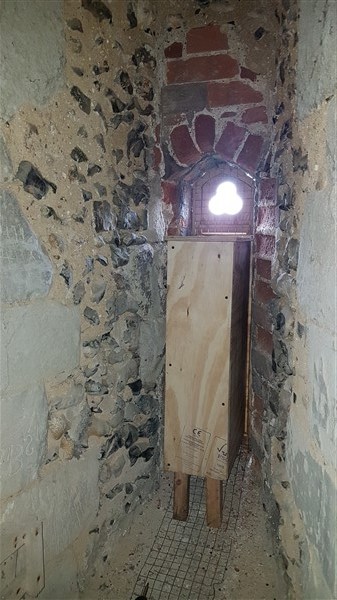 Reed St Mary Church near Royston and Cambridge in North Hertfordshire. Reed St Mary Church near Royston and Cambridge in North Hertfordshire.
A beautiful little church dating from Saxon times, and now hoping to host Swifts in its tower.
Another project of Gavin Vicary and North East Hertfordshire Swifts, helping Swifts survive in their locality.
Such nest boxes are easy and cheap to make, last for years and can
safely be left for the Swifts to just get on with their private lives.
Why not visit this lovely place and enjoy its peace and tranquility?
For more information click here.
Photographs © Gavin Vicary NEHS
|
|
The
results were impressive. 42 nest cavities, with 14 triple nest boxes
fitted at 7 water pumping stations. Above: the Berkhamstead pumping
station. Right: Bow Bridge. Other pumping stations fitted similarly
are Bricket Wood, Holywell Hill, Piccots End, Shakespeare Road
and Harpenden.
We hope that each site
will soon be re-planted with wildlife supporting shrubs, such as
Berberis, Holly, Yew, Blackthorn, Wild Cherry, Spindle Tree, Ivy, Field
Maple, Rowan, Dogwood, Oak, Juniper and others.
|
Affinity Water fits Swift Nest boxes to its Hertfordshire pumping stations
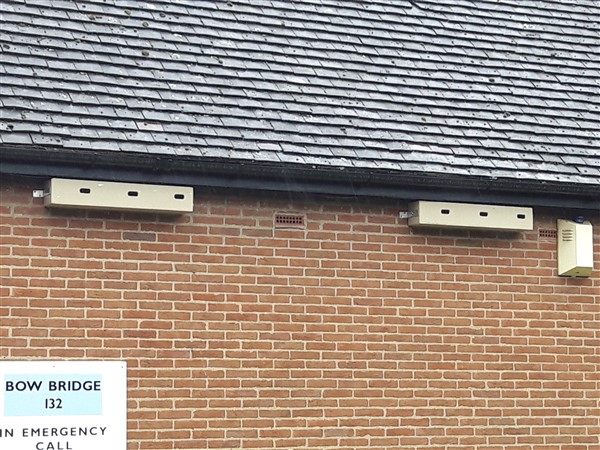
Back
in 2019 we were asked by Affinity, the water company supplying
Hertfordshire, for help with spotting sites for Swift nest boxes at
their facilities, in particular their pumping stations which are dotted
around the County. Working with Natasha Gloor, a scientist working on
Affinity's environmental enhancement programme, as well as with local
Swift enthusiasts, we toured pumping stations and selected potential
sites for the nest boxes.
Photographs © Affinity Water Limited
|
The Federal Palace in Bern Switzerland fits Swift Nest boxes into its facade
A really neat job and an inspiration
to us all! This brilliant new installation uses the original cornice
feature of this important government building to make homes for Swifts.
By such sensitive and imaginative treatment, a site that night
otherwise be dismissed as "Too difficult" or "It won't look good" has
been transformed. It looks good, it provides excellent nest places, it
won't need any maintenance, and it should work just fine.
Local journalist Peter Schneider reported:
"The idea of installing the nesting boxes was initiated by the
President of the National Council and farmer Andreas Aebi. In order to
support Swifts in Switzerland, potentially endangered birds, twelve
nesting boxes were installed Monday on the facade of the Federal Palace
in Bern. Andreas Aebi, in his private life a passionate ornithologist,
is concerned about the preservation of biodiversity in the city and
decided to act to save it. "
Photographs © Keystone/Peter Schneider
|
|
|
Snape Maltings and Aldeburgh Swift Accommodation
On a recent visit to East Anglia we traveled to
Snape Maltings (for coffee in the sun, looking out over the reed beds)
and to Aldeburgh, (for fish and chips on the front).
While we were in both places we spotted new nest boxes for Swifts, with
Swift calls playing at Snape, showing that the managers at The Maltings and
also the local Aldeburgh Swift group ("Aldeburgh's Amazing Swifts") had been hard at work for our favourite
birds!
Did
you know, you can pick up a guiding leaflet in Aldeburgh and do
their "Swift Trail", a walk round all the local Swift colonies
and nest box sites, to burn off the effects of the fish and chips and
ice creams!
Left: Two of the old Maltings buildings at Snape fitted with Swift
nest boxes and at one of them (top photo) a calling system is in use to
lure the birds to take a look at their new accommodation.
Below: Demon Yachts facility at Aldeburgh (near the main car park at
the South end of the town) hosts an array of no less than 12 Swift
nest boxes, a really major contribution to saving these birds from
extinction here in the UK.
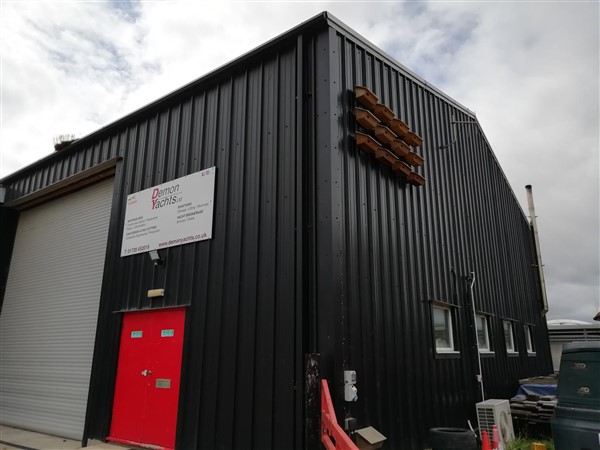
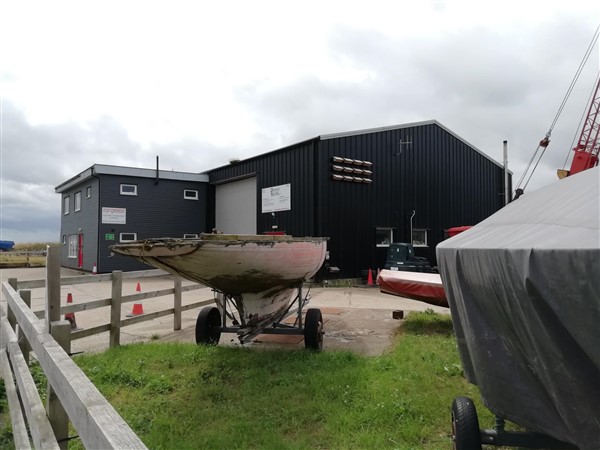
Photographs © Edward Mayer / Swift Conservation
|
Broadstairs College helps Swifts!
For years Nik Mitchell ("Wildlife
Conservation in Thanet" on Facebook) has been keeping an eye out for
tall buildings in Thanet that have scaffolding up and so could easily
become Kent’s first nest-box based Swift colony.
One day Nik’s wife Louise noticed Broadstairs College (where Louise
works) had scaffolding up on one of its tallest buildings, which is in
an area that Swifts regularly visit. Louise emailed the principal to
explain the potential conservation project, and guess what they said,
it was YES !
The college has been making efforts to do its bit for biodiversity on
its campus and the assistant principal Sarah quickly realised the
potential of this project. Installing nest places for a Swift colony has
massive potential; it can bring excitement, joy, life, love, education
and inspiration.
Nik and his friends installed 7 triple-cavity next boxes, that’s a
total of 21 nest places. They also installed a call system because
there is a much better chance of attracting Swifts to nest boxes if you
play a recording of their calls.
They also had information boards made
by criticalart.com and put up around the college to explain the
project. Here's hoping for Swifts at Broadstairs College in 2022!
Opposite right: Top - Broadstairs College - the nest boxes are fitted
right at the very top of the scaffolding. Bottom - the triple cavity
boxes ready to be fitted
|
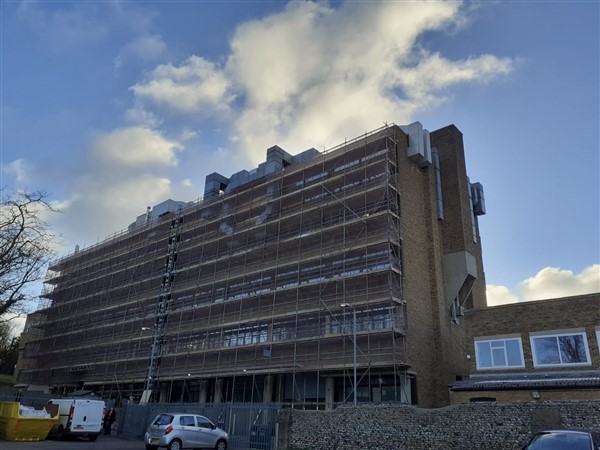
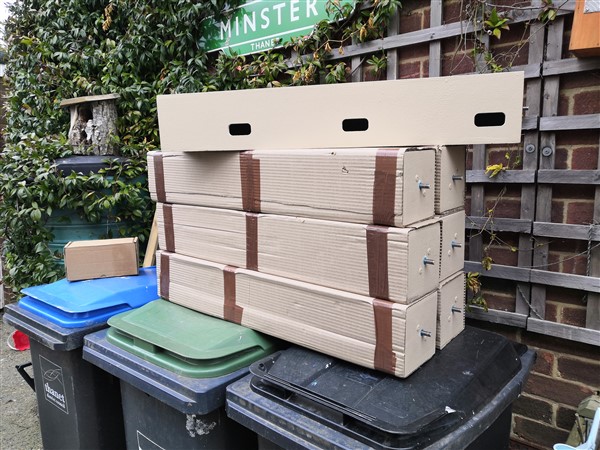
Photos © Nik Mitchell WCiT
|

|
Albury Village Hall in East Hertfordshire
The Village Hall in Albury has had a superb new
multiple Swift nest box installed on its gable, courtesy of UK Power
Networks, who sent along a team (shown below) with all the lifting equipment needed, and put
it up for free! Maybe they would do it for your project too! Why not ask them?
Gavin Vicary of North East Hertfordshire Swifts group sent us these
photographs when he told us about this project. This sort of gable apex
box is very neat, out of the weather, and has been proven to be very
successful. It is also aesthetically highly acceptable. A scheme that is well worth copying wherever you can!
|
A house owner in Elblag, historic Tudor port in Poland, helps Swifts
Back in the 16th Century English
merchants set up shop in Elblag, near Danzig (today's Gdansk) on the
Baltic Coast, as they were excluded from Danzig by the merchants of the
Hanseatic League.
Knowing this fascinating but obscure fact, we were delighted to receive
a message from a Swift fan in modern Elblag, Leszek Serwis Turbin, telling us of his efforts to
help Swifts.
The
town had to be rebuilt after being almost
totally obliterated in the 2nd World War, and so most buildings are
new, and inhospitable to Swifts as with modern central heating and
insulation there are no apertures left in the buildings for Swifts to
nest in.
So nest boxes, not just for Swifts, but for other hole-nesting creatures
like many bird species, small bats, dormice, lizards, salamanders and
bumble-bees, start to become not just desirable, but absolutely
essential if these species are to survive.
Leszek has done a great job here. The publicity gained will be invaluable.
Top right, the nest boxes on his home, below, the innards of the
calling syetm, exposed to view. Wish him and the Swifts of the Baltic
Coast Good Luck in the years to come!
Photographs © Leszek Serwis Turbin
|
|
The Hastings Observer building to get Swift bricks in a brave new project
On
the right is the Observer building in Hastings, East Sussex. It has
lain half-derelict for thirty years or more. But now it is to be
restored as a mixture of workshops, small businesses and affordable
housing for the many people needing such premises within Hastings. A
brilliant and exciting project that will not only build up the economy
of Hastings, but keep fresh and positive its Bohemian charms, and ensure
its streets and buildings are very much alive.
And
it will have Swift nest bricks built into the walls of the old lift
tower, the highest part of the building that you can see going up the
street beside the right hand facade of the building. There may even be
some bat boxes set up there as well, but we will have to see.
Swift Conservation has offered to pay for the Swift bricks using the donations that we have received over the past year.
Watch this space for more news as it becomes available!
|

Photo © Edward Mayer / Swift Conservation
|
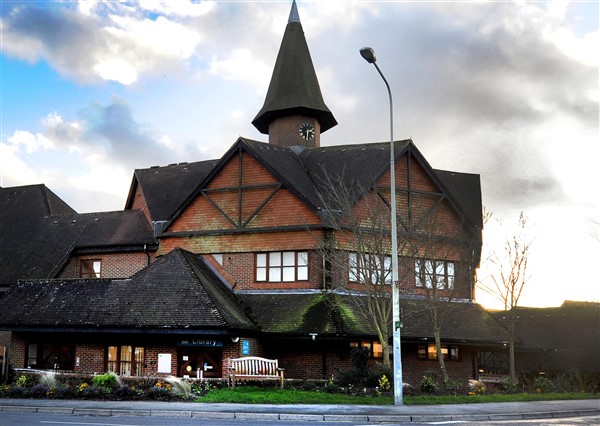
The
Public Library at Battle, and on top of this charismatic building is the
Clock Tower that will house the 12 Swift Bricks being installed in it
this April.
Hastings
& Rother Swifts, East Sussex County Council, Swift Conservation and
Action for Swifts have all worked together to drive forward this
ambitious plan to have Swifts nesting in the clock tower of the Public
Library at Battle.
This
is the fourth UK Public Library to have Swifts nest places installed in it
that we know of. The others are at Cullompton in Devon, Antrim and Bournemouth!
|
Your donations fund 12 nest bricks for Battle Library's clock tower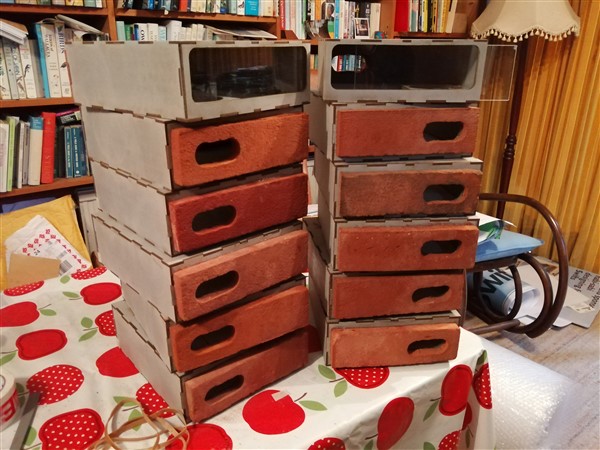 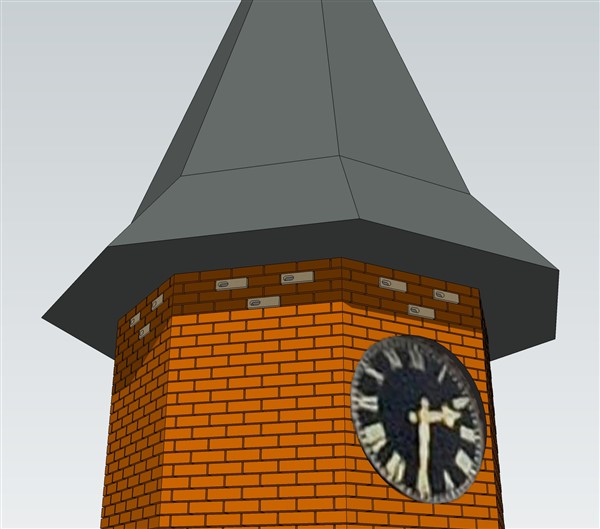
What a perfect site for the local Swifts!
Above left:
12 new "S" Bricks, designed by Dick Newell of Action for Swifts, stand
ready for installation. They have Perspex back panels to permit CCTV
observation in the Library below.
Above right: Dick Newell's idea of how the project might will look when completed, with all the new Swift Bricks in place.
Photo and Sketch above © Dick Newell / Action for Swifts
Photo of the Library (upper left) © Ian Donovan / Hastings & Rother Swifts
|
Major Swift project gets going in CatalunyaHere
are some photos of Ken Anderson and his team of friends in Vilaplana,
in the province of Tarragona, Catalunya, Spain. Ken is transforming this
town with 20 new Impeckable nest boxes made by Len Haworth at his
factory in Wales.
You can see here the yellow nest boxes going up around the lovely little hill town, shown in the photo below.
As
in so many other places, Swifts are losing their nest places in
Vilaplana (photo below) as buildings are repaired, modernised, and
insulated. The answer for Ken is to fix nest boxes to the outside walls
of suitable buildings, and the GRP ones made by Len are going to last
for a very long time indeed and should require neither maintenance
nor cleaning.
Photo © courtesy of Catalunya.com
|
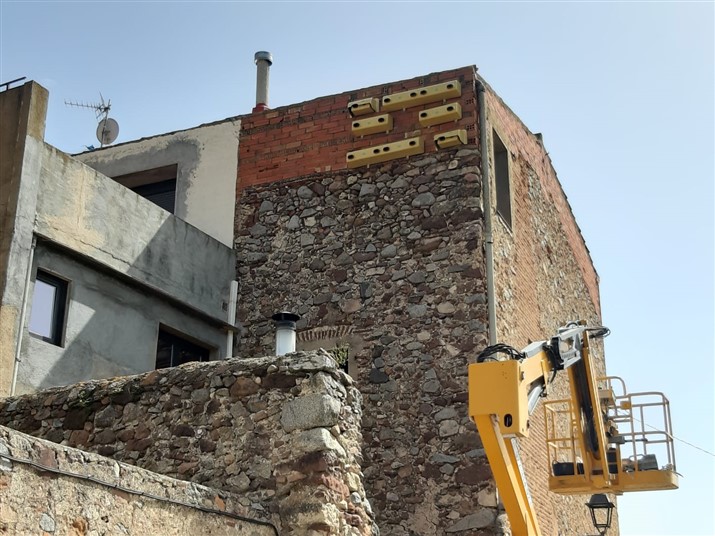
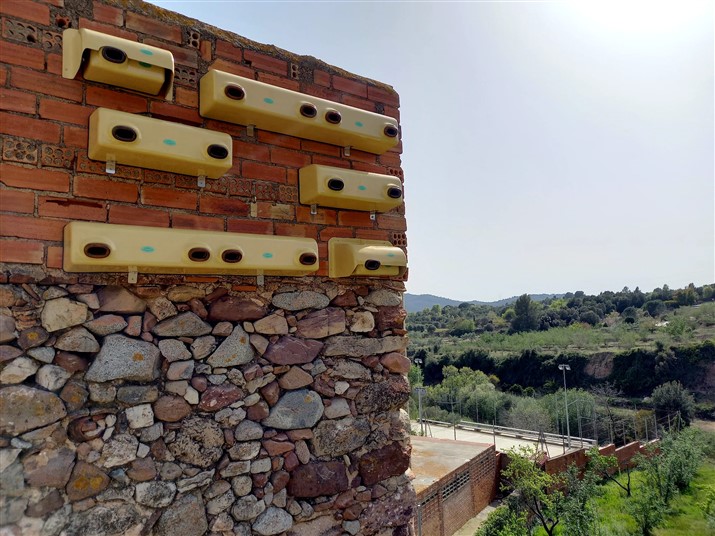 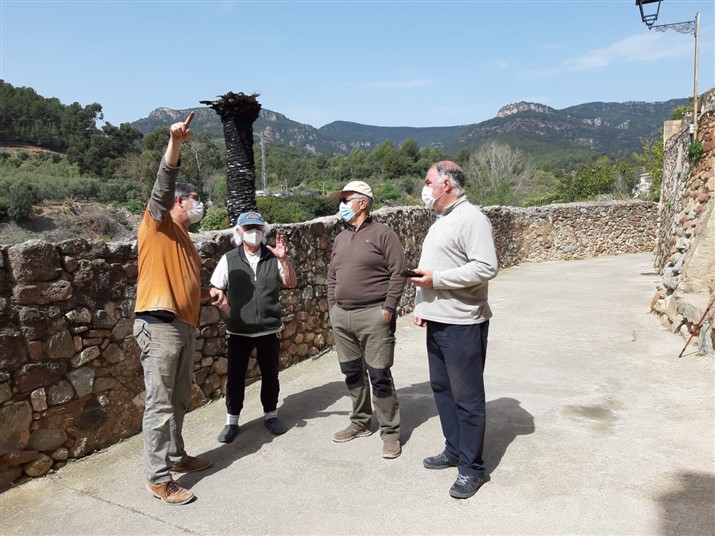
Photos © Ken Anderson
|
With
the help of Mike Priaulx of Islington Swifts, links were established
with the Roger Ascham School in Waltham Forest London. The result was
that Swift Conservation provided the John Stimpson-made Swift nest boxes
now up at the school and awaiting new occupiers.
Photos will follow after COVID has receded and everyone feels confident
about allowing us to photograph the buildings and the nest boxes at the
school. Meanwhile, the Swifts are welcome to nest here as soon as they get back from Africa!
|
Four John Stimpson Model 30 nest boxes installed at Roger Ascham School, Waltham Forest London E17
|
Parma
goes "Swift Friendly", restores a major church and an
iconic hospital in its historic heart retaining the old places
where Swifts nested, and adding some more
 Francesco Mezzatesta writes to us with news of the Swift projects he is advising on in Parma. Francesco Mezzatesta writes to us with news of the Swift projects he is advising on in Parma.
This photo shows what is known in the UK as a "putlog" hole. This one has
been adapted with a piece of brick to restrict entry to Swifts and
other small creatures only, and to exclude Feral Pigeons.
Putlogs are holes made in the outer wall of a building to put wooden
scaffold poles into whenever the building needs to be repaired. It's a
quick, easy and safe way to get the scaffolding up, but no longer used
today in the era of metal scaffolding. They
are a feature of many larger buildings of the pre-industrial
period in the Western
Mediterranean, as well as further afield.
Over time these holes have been used as homes by Swifts, Jackdaws,
Black Redstarts, Sparrows. Lizards and Geckos. In more recent times
they have been taken over by Feral Pigeons, and so very many of them
have been blocked up, or filled with wire or anti-pigeon spikes.
This has been deadly for Swifts and other creatures using them, and it is
also affects the historic authenticity of the architecture.
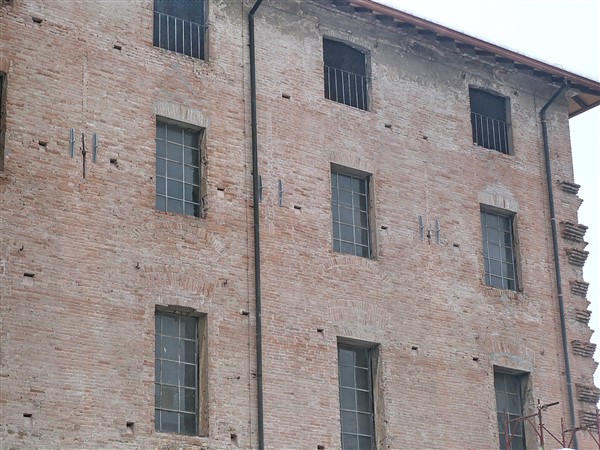
Photos © Francesco Mezzatesta
|
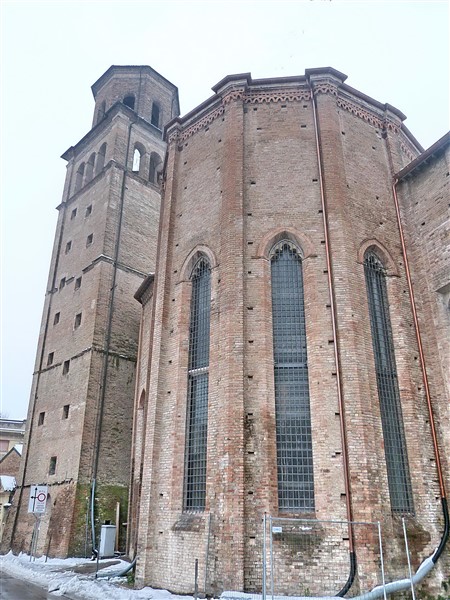
Above you can see the many"putlog" holes or "buche
pontiae" set into the walls of the Church of San Francesco, Parma.
Dr Mauro
Ferri of Modena with Giovanni Boano and Giorgio Malacarne invented
ways of reducing the
aperture size of the holes to suit a broad range of creatures, Swifts
included, while excluding the proliferating Feral Pigeons. They showed
that this could be done while still achieving an acceptable appearance
for historic sites.
Their
techniques have now been used on the Church of San Francesco, above, and
also on the Old Hospital, the Ospedale Vecchio, on the left, by a team advised by Francesco Mezzatesta. The putlog holes are visible as black dots running up the walls.
The Swifts' breeding sites have been saved, and even added to.
This is a superb example of what can be done to help Swifts and many
other beneficial creatures too in ancient histroic buildings.
|
Denmark's very first integral "Swift Bricks" are installed!
Jesper Toft, our Swift correspondent and an activist in Denmark writes:
"24 integrated nest boxes are being fitted into 6 buildings by a pension fund who wanted to expand 6 of their buildings with an extra floor. I made them aware that several Swifts were breeding in the buildings. We
entered into a good dialogue with the result that they chose to
integrate 24 nest bricks with 4 in each building gable. You can see what is being done in the photo on the right.
These are
the first buildings in Denmark with integrated nest bricks. During
the rebuilding of a couple of the buildings (which got underway before
the arrival of the Swifts), we set up temporary nesting boxes on the
scaffolding so the Swifts had the opportunit to use them for that breeding season".
|
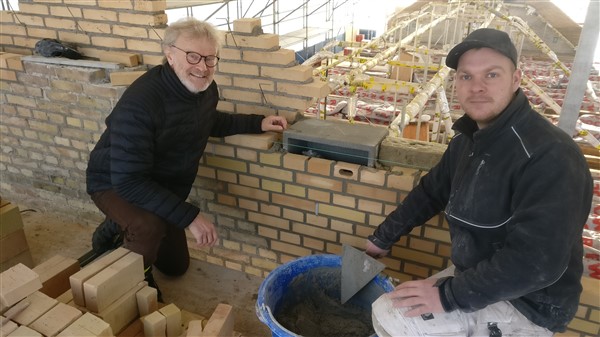
Jesper
Toft (left) with a Swift Hero Bricklayer, fitting one of
Denmark's first
ever integral Swift nest places into this commercial office
building.
Photo ©
Jesper Toft
|
SEO,
The BirdLife partner in Spain, fits 330 UK-made Swift
nest boxes for at a huge housing project in Orcasitas, Madrid
Len
Haworth of the UK's Impeckable Nestboxes, manufacturer of
glass-reinforced
plastic nestboxes, working with Beatriz Sánchez of the Spanish
Ornithological Society, SEO, has delivered 330 triple nest boxes for
fitting during
roof repairs to a very large housing estate in Orcasitas in Madrid.
The estate already houses many Swifts, but it was feared that removing
and replacing the asbestos roofing removal would evict them and prevent
their re-entry, so
the nest boxes are being fitted to re-house them. The shiny white boxes
were
chosen because they will reflect heat well. Summer in Madrid is
extremely hot, so this aspect is very important.
The glass-reinforced plastic is guaranteed for 50 years life, another factor in its favour,
as is the fact that these boxes
are well proven.
The photos show the loading of the boxes at the factory, the boxes
before packing, and the unloading in Madrid. To see SEO's article about their installation please click here.
|
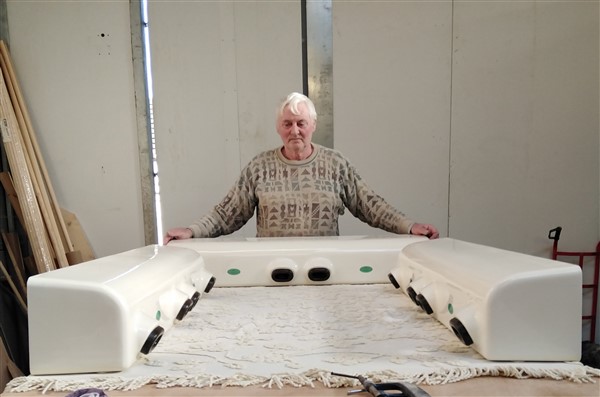
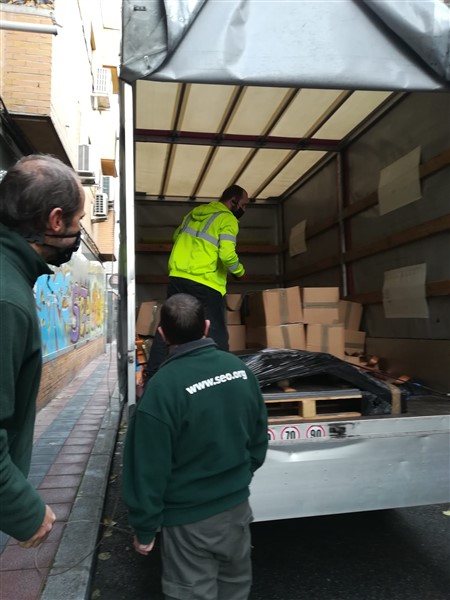
Photos © Len Haworth / Impeckable Nestboxes
|
We are doing our talks on "ZOOM"!
The
Society of Architects, Landscape Architects and Conservation Architects
in Varese, Italy arranged a ZOOM talk with us this December for 377
people
We were invited to give a talk by the ORDINE DEGLI ARCHITETTI,
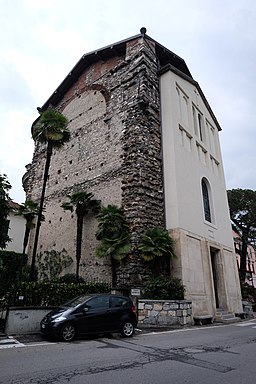 PIANIFICATORI, PAESAGGISTI e CONSERVATORI della PROVINCIA DI VARESE at
a special Webinar. PIANIFICATORI, PAESAGGISTI e CONSERVATORI della PROVINCIA DI VARESE at
a special Webinar.
A great honour for an English person to be invited to speak in Italy, and an invitation that we jumped at.
We spoke about Swifts, their lives and conservation
needs, showing a wealth of slides of sites in the UK and across
Europe where Swifts had been helped to survive by careful restoration
of the building features they were using, and where additional help had
been provided in the form of Swift Bricks to give them more nest places.
Italian Swift and Swallow experts Giovanni Boano and
Francesco Mezzatesta (the man who founded LIPU, the Italian RSPB) also
gave highly-appreciated talks at this Webinar, which is available on-line in Italian.
|
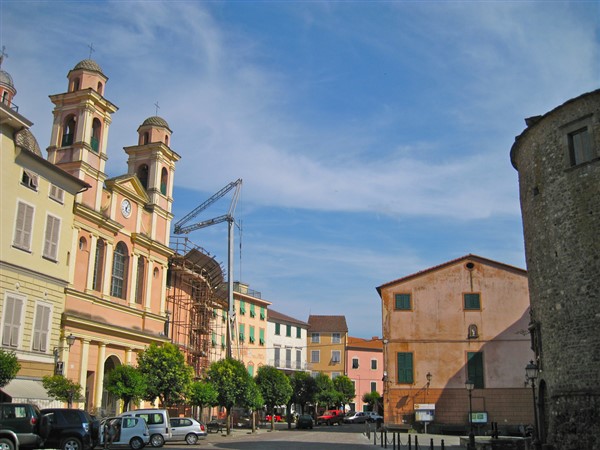
Photos © Ben Bender & Cyril Doussin / Creative Commons/Wikipedia
The photos: On the left the sort of very old but partly restored local
building that can still house Swifts, Bats, Lizards, Geckos, Black Redstarts
& Sparrows. See the many holes in the flank wall - ideal nesting
and roosting spaces for many of these typical local species.
Directly above: a street view showing the variety of building types, in
Varese. Many are old, most have been restored, some are very old but
completely refaced, one is being restored. They are typical of the buildings at the centre
of most Italian small towns and villages.
These sorts of sites can still be good for many urban species to live
and breed in, but with increasing wealth and increasing restoration
many small, beneficial wild creatures are being forced out never to
return.
The tragedy is that this is completely unecessary if we apply the correct techiques at the start of the work.
We can advise you how to get it right!
|
Many More Nest Places go up on buildings...
Amboise: the Old Gendarmerie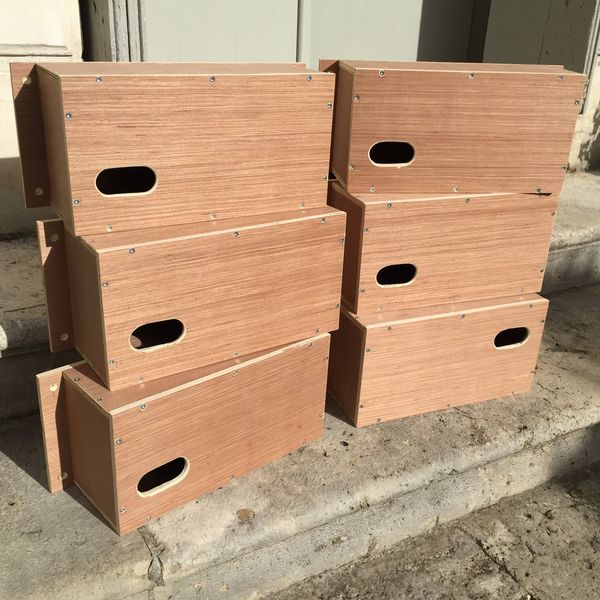
Carolyn Knowlman of the association SOS Martinets
tells us that this
building used to be the local police station. Empty for years, despite its fine location, close to
the banks of the Loire looking across the river to the château &
the old part of town.
But then it was bought for renovation as apartments. As it was thought
that Swifts might had been nesting in apertures under the
gutters, SOS Martinets wrote to the new owner explaining that the town had
a policy of including nest sites for Swifts in new and renovated buildings.
Luckily the new owner was happy about the idea of
installing nest boxes and a plan was developed on how to fix them to
the building, which was to be fitted also with exterior insulation.
The plan was to fix the nest boxes to the old walls, just under the gutters, and then to
surround them with new externally applied wall insulation, then to
apply the standard insulating plaster mix over both nestboxes and the
fixed insulation layer, leaving only the entrance holes accessible. The
nest boxes are completely hidden within the insulation layers.
|
...in France, Spain, Bristol & North Wales... Read On...
You can see the building above, and in close up, the eaves and entrances to the new hidden nestboxes.
Having identified the thickness of external insulation they would be
using, SOS Martinets drew up plans for nestboxes that would sit snugly within
the insulation layer, and the boxes were made up locally.
They
were designed to be easy and quick to fit, and most important,
virtually invisible once fitted. Only the entrance holes would be
visible.
The finished result looks aesthetically good, the nest entrances are
almost imperceptible, very important as this site is within the
legally-enforceable "zone de protection" in place around the château.
Photos & drawing © Tim Knowlman / SOS Martinets
|
|
Bristol builds snug homes for Swifts!
Guy
Hodgson of SNUG Homes Bristol has written to us with two photos of a
new project built by his company on a local brownfield site.
He
says "I thought it would interest you to know we have designed in some
Swift boxes to the parapet wall of our new build. We followed your
advice sheet as best we could. Hopefully we will be able to attract
some in the fulness of time!"
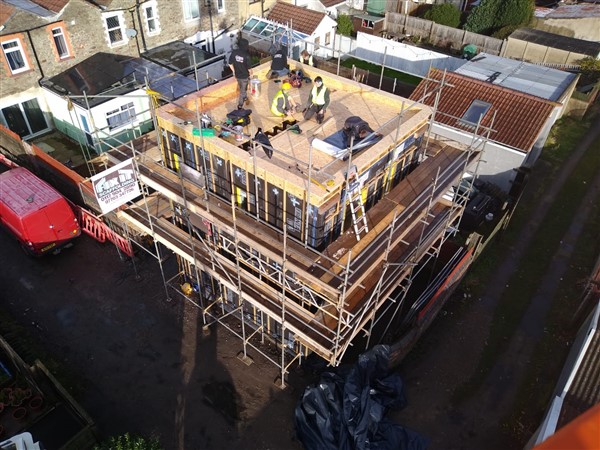
|
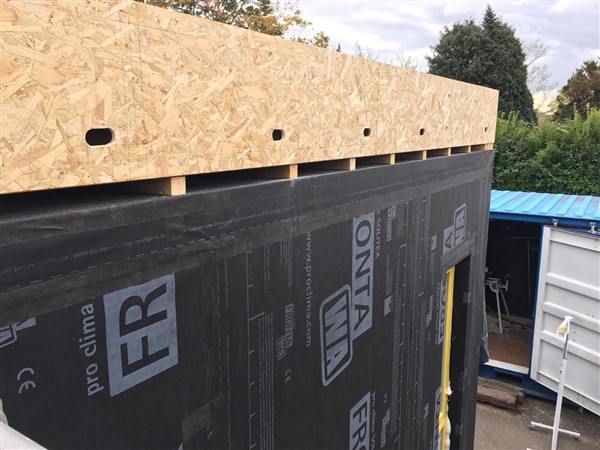
Isn't that great! If you are having a suitable structure built, or you
are say a trustee of a school or institution having something built, do
the same. The Swifts will be there to greet you when you get to Heaven!
Seriously, if you are working on a project like this, we can help you
to design and build in facilities for Swifts and Bats too.
Just ask us, our advice is free.
Photos © Huy Hodgson / SNUG Homes Bristol
|
But sadly the Swift population decline continues unabated
Dick Newell of Action
for Swifts, the East Anglian designers and manufacturers of Swift
Bricks for all sites and specialised nest boxes for church towers, has
made some calculations from trends derived from the British Trust for
Ornithology's Breeding Bird Survey (BBS) between 1994 and 2019, as well
as population estimates for 2009 published in British Birds Magazine
(Musgrove et al), and has created the graphic on the right from these
figures.
A good part of the reason for the decline is loss of nest places. As
old buildings are refurbished, insulated, re-roofed or replaced with
new ones, the old-fashioned eaves and gable gaps where Swifts used to
nest are lost. This, combined with changes in farming world-wide,
requiring the massive use of insecticides, removing the food of
insectivorous birds like Swifts from the environment, makes the
situation very difficult.
But creating new nest places for Swifts should be easy. The Government
is planning for unprecedented increases in house building, millions of
new homes are in the pipeline. If every one of these new homes and
related infrastructure like schools and hospitals, factories, offices
and shopping centres had nest places for Swifts, then more than enough
would have been done to support Swifts, and other birds as well as
several species will cheerfully use Swift nest boxes and bricks too.
The
Royal Institute for British Architects (RIBA) recommends in its
publication "Designing for Biodiversity " (available via our Shopping
Page) a ratio of one new nest place for every new housing unit. An
increasing number of local authorities are saying the same. If this is
implemented (and you can do your bit by commenting to this effect on
all the Planning Applications in your borough) then we will be a long
way down the road to creating the right conditions for a Swift recovery.
The
graphic opposite shows that the UK population of Swifts, calculated
from published data (BBS) and published estimates (Musgrove et al),
declined from
133,600 pairs in 1994 to 52,000 pairs in 2019. That is a
decline of 81,600 pairs (61.1%) in 25 years, running at 5% every year
since 2009.
|
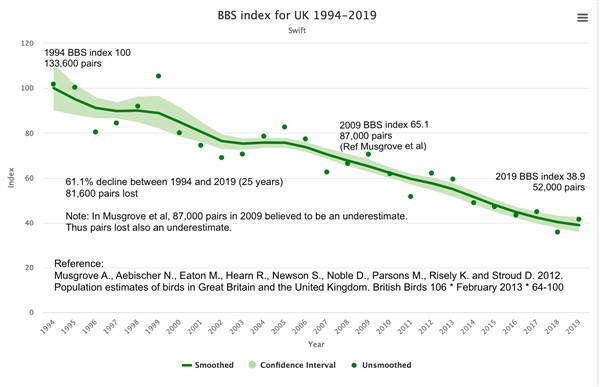
Invariably, when looking for places to nest, Swifts often fail to find
new nest places, and may be choosy about which they use, and so
occupancy rates may be much less than 100%, and more like 30%.
Given that the 2009 population level for Swifts was underestimated we
foresee a need for 300,000 new nest places to be installed in UK
buildings if Swifts are to recover to their level of just 25 years ago,
let alone recovering from the undoubted earlier losses in the 20th
century.
Lobby your MP and Councillors to get Swift
nest bricks made part of local Planning Biodiversity requirements!
Lobby
your councillors also to get your local Borough made pesticide and
weedkiller-free, and to leave their verges uncut all Summer long!
More and more towns are ceasing to use weedkillers and insecticides
when managing their parks, gardens, sports grounds and verges.
It saves money, and it gives our Swifts the insect food they need so badly to survive.
Graph © BTO as annotated by Dick Newell / Action for Swifts
|
Fallen Pallid Swift re-launched at Rye
Marie Denston of
Secret World Wildlife Rescue launches a rescued Pallid Swift on its
journey from Rye back to Spain and Africa. Found in a garden in
Weston-Super-Mare after a big storm that blew several Pallid Swifts all
the way from Spain as far as the Baltic, this little bird was rescued,
fed and cared for until it was well enough to fly again.
Jamie Kingscott together with Marie drove the bird from Somerset
to Rye in East Sussex where it was greeted by Edward Mayer of Swift
Conservation and Barry Yates of the Rye Harbour Nature Reserve. Guided
by Barry, a good safe spot was found for the take off, and after final
checks, it was released and headed straight for Dungeness, and the
shortest route to France, in strong fast flight. Rye was selected for
the launch because it avoided the Swift having to undertake a long
flight across the sea without access to water and food. It is a key migration point for our Common Swifts too.
Pallid Swifts are rare vagrants to the UK; they nest around the
Mediterranean and the Persian Gulf and winter in Northern and Central
Africa, some even winter now in Southern Spain. When they appear here,
it is usually after severe storms from the South.
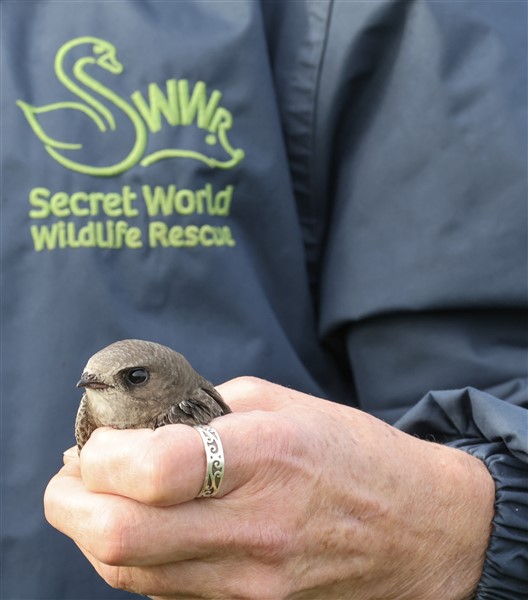 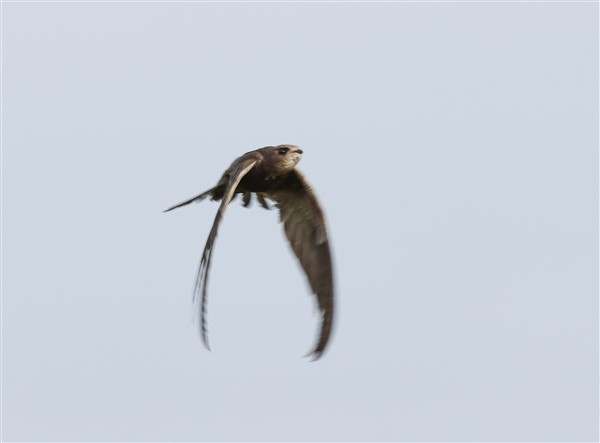 |
Photos © Edward Mayer & James Tomlinson
|
14 Swift nest boxes go up on Zaragoza's Fire Station
Local Swift activists and the local Fire
Brigade got together on November 6 to install another 14 nest boxes at
the Pallid Swift colony at the fire station.
Pallid Swifts are very similar to our Common Swift, but can be the most
common of the two species around the Mediterranean and inland along
river valleys and in the towns along them. They arrive earlier, leave
later, and can have two broods rather than just the one that our Swifts
have. They dominate some towns in the Autumn, good examples being
Seville, Rome and Tirana, and of late a few have started to
overwinter in Andalusia.
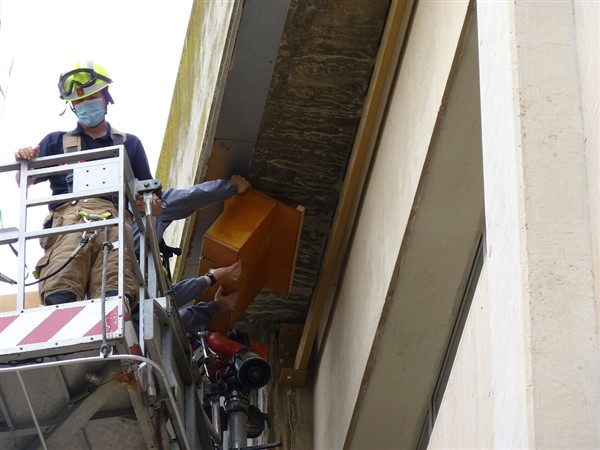 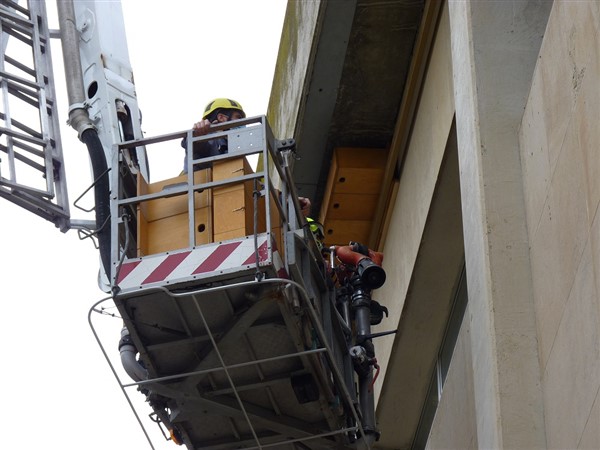
|
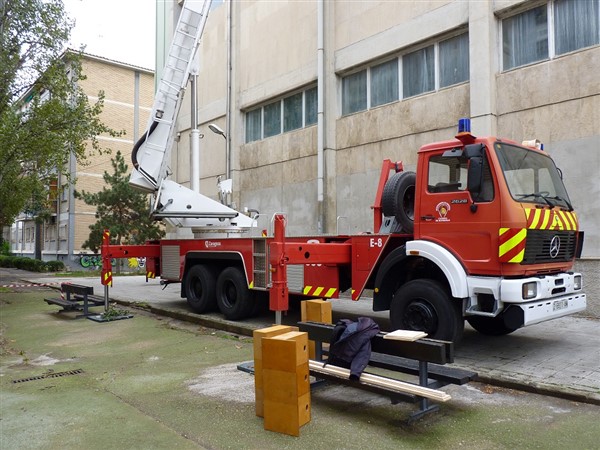
The photos opposite show the nest box placement job under way. The idea is to keep adding more nest boxes as time goes on.
In the coming months boxes will also be put on to the bridges
across
the River Ebro - a most exciting prospect and a very good reason to
visit Zaragoza in the
Summer!
Photos © Jose Antonio Pinzolas
|
Wrexham Industrial Estate: North Wales Wildlife Trust
The
photos show glass-reinforced plastic "glass fibre" Swift nest boxes,
made by Impeckable, installed by Henry Cook of the North Wales Wildlife
Trust onto a prominent factory unit on the Wrexham Industrial Estate.
This is the largest industrial estate in the UK; JCB has two big
factories there, as do Kelloggs. There are hopes that these factories
too will soon have Swift nest boxes fitted to them.
North Wales Wildlife Trust has been especially active in getting Swift
nest places put up around their area; lots of places on Anglesey now
have them, and local people are getting keen on helping the birds.
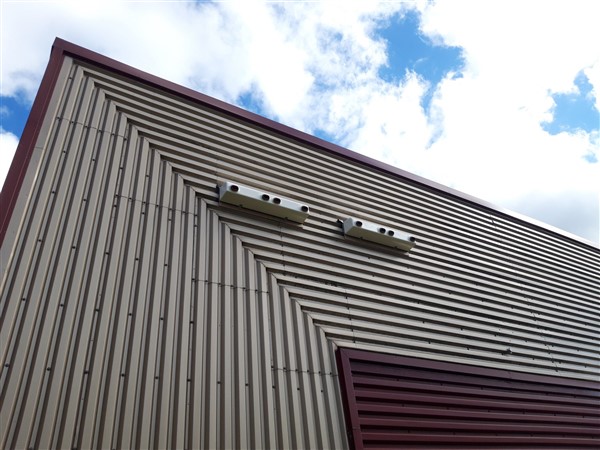 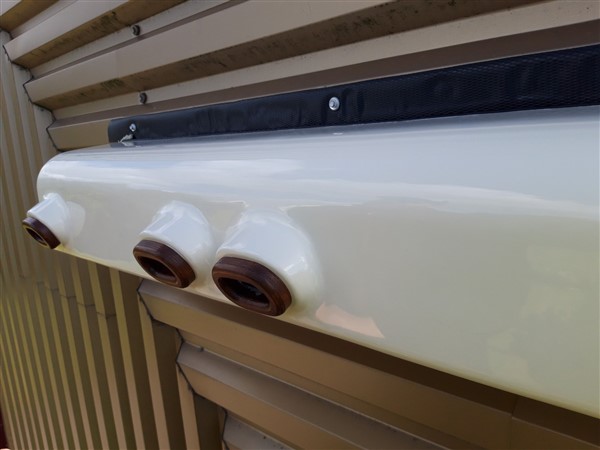
Photos © Henry Cook / North Wales Wildlife Trust
|
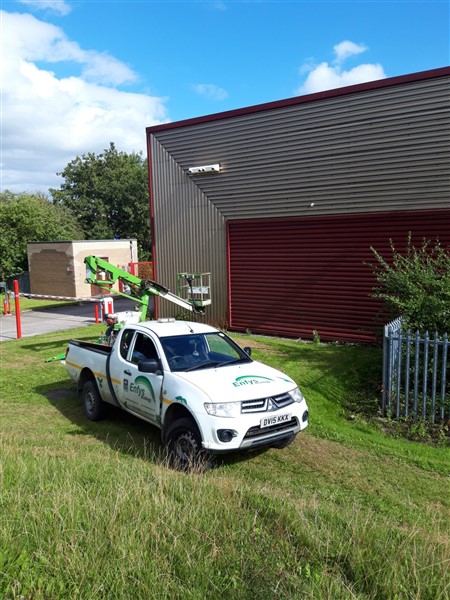
|
Swifts have now headed back to Africa
They'll be back with us next May!
Robert Relph took these amazing photos of a young Swift launching into its first ever flight out of its nestbox.
Two days later it could be over Madrid, a week later over Mali, a month later feasting on insects over the Congo.
Then, next June, it will be heading back to the UK, to fly, socialise
and feed as well as migrate again for another year or two before
finding a place to breed and a mate for the next year.
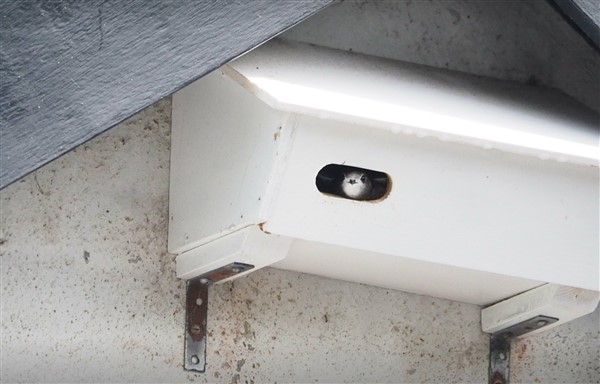 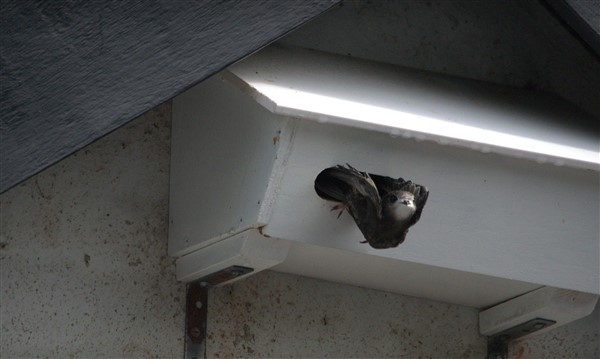
Photos © Robert Relph
|
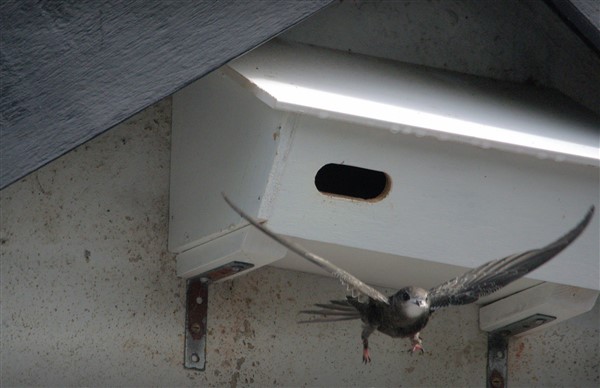
First Flight - The moment of truth - "Can I really Fly?" the answer "Yes!"
Swifts spend nearly all their life in flight, they can fly from one end
of the Earth to another, they can fly at 8,000 feet, they can get
through terrible weather, heat waves, sand storms, they can cross
deserts and seas, and still arrive spot on time here in the UK to breed
for another year.
|
Very Good News from Malta!
Swift nest boxes are set up at the Salina Nature Park Visitor Centre

Photos © BirdLifeMalta
|
Manuel
of BirdLifeMalta writes: In Malta, Common Swifts and Pallid Swifts are
a very recent addition to the breeding birds of the islands.
Probably the absence was due to illegal hunting. But over the
last 10 years or so they have established several colonies in rural
areas and also in built-up areas.
BirdLifeMalta took on the management of the Salina
Nature Park in late 2018, but it lacks breeding birds as it was not
previously managed for wildlife. Now we are trying to encourage various species
to breed, like Little Ringed Plover and Black-winged Stilts, with the
construction of islands in the saltpans. We have also set up nest boxes for
Kingfisher (wjich has never bred in Malta), Spotted Flycatcher, Tree Sparrow and
Swifts.
The
Swift nest boxes were set up at our Visitors Centre (see photo
attached). They were immediately taken over by Spanish Sparrows, so
next year, I’ll block the holes until the Swifts arrive. We are planning
to have many school visits, and having a Swift colony would be a
great educational experience for the kids to observe the birds chasing
each other and visiting their nests. We have also organised nest box
building activities for families which were quite successful.
|
Brighton General Hospital's Swifts are breeding well again this year!
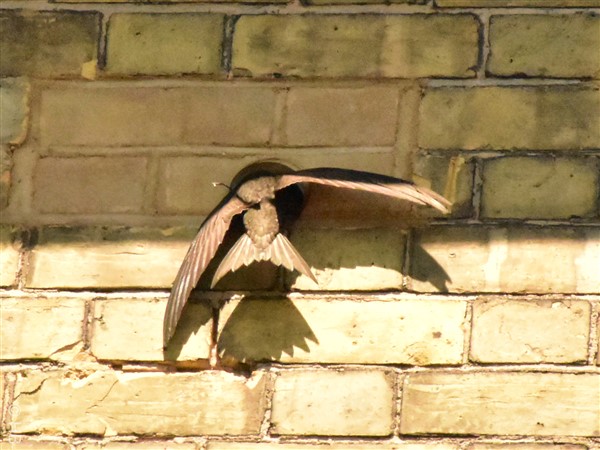 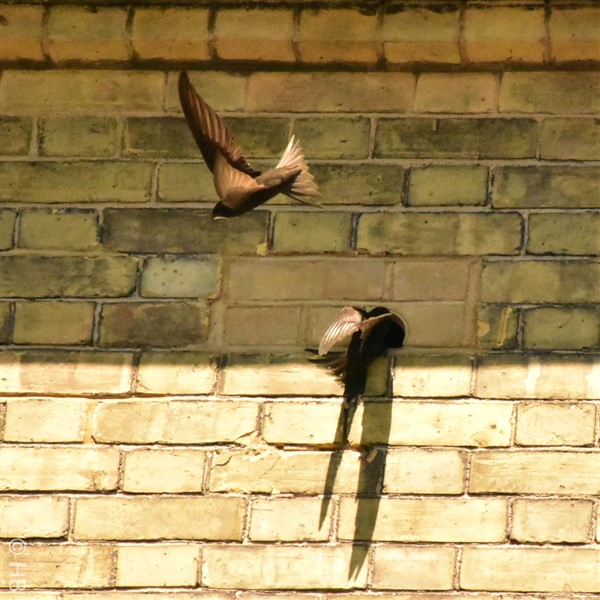
Above,
and to the right, a pair of Swifts nesting again this year in converted
ventilation holes in the Brighton General Hospital buildings.
Just a few years ago, in a project supported by Swift Conservation,
the hospital, and its surveyor agreed a project promoted by Chris Lowe
and Heather Ball of Brighton's Swifts to restore and make suitable old
and decaying ventilators in the walls of the hospital as Swift nesting
holes.
Swifts had already been nesting in them, but obviously any repairs
would have made them unusable by the Swifts. So Heather and Chris
made the case for Swift Bricks to be
installed instead of ventilator bricks when the buildings were
refurbished. A Swift brick made by Ecosurv was selected as it matched
the existing yellow brickwork.
|
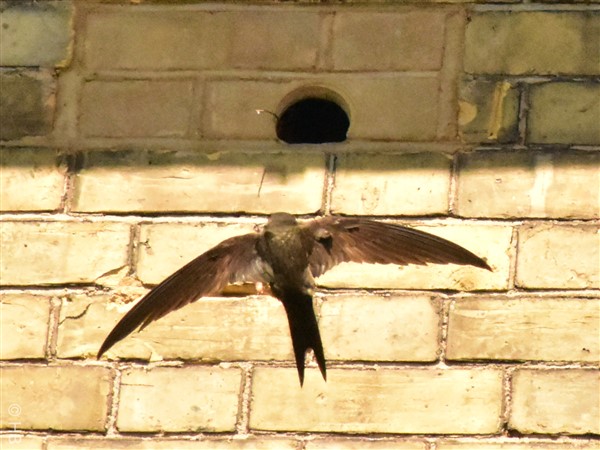
Photos © Heather Ball
The project was a success; the
Swifts returned and have nested there ever since. About 80% of these recently installed Swift bricks now have nesting Swifts in them. This is an excellent result!
The Brighton
General Hospital site has potential for at least 30 nest sites identified in
broken air bricks, soffit holes, and the Ecosurv bricks. Each year new nest sites are discovered by Heather and her colleagues.
|
They're Back & Very Early too!
Swift People have started to report sightings these past few days of April.
Here is Liz Cotton's photo from Italy of a Swift on its migration
North, passing under the Moon on Easter Sunday - an amazing image! Who
knows where it is headed and will nest?
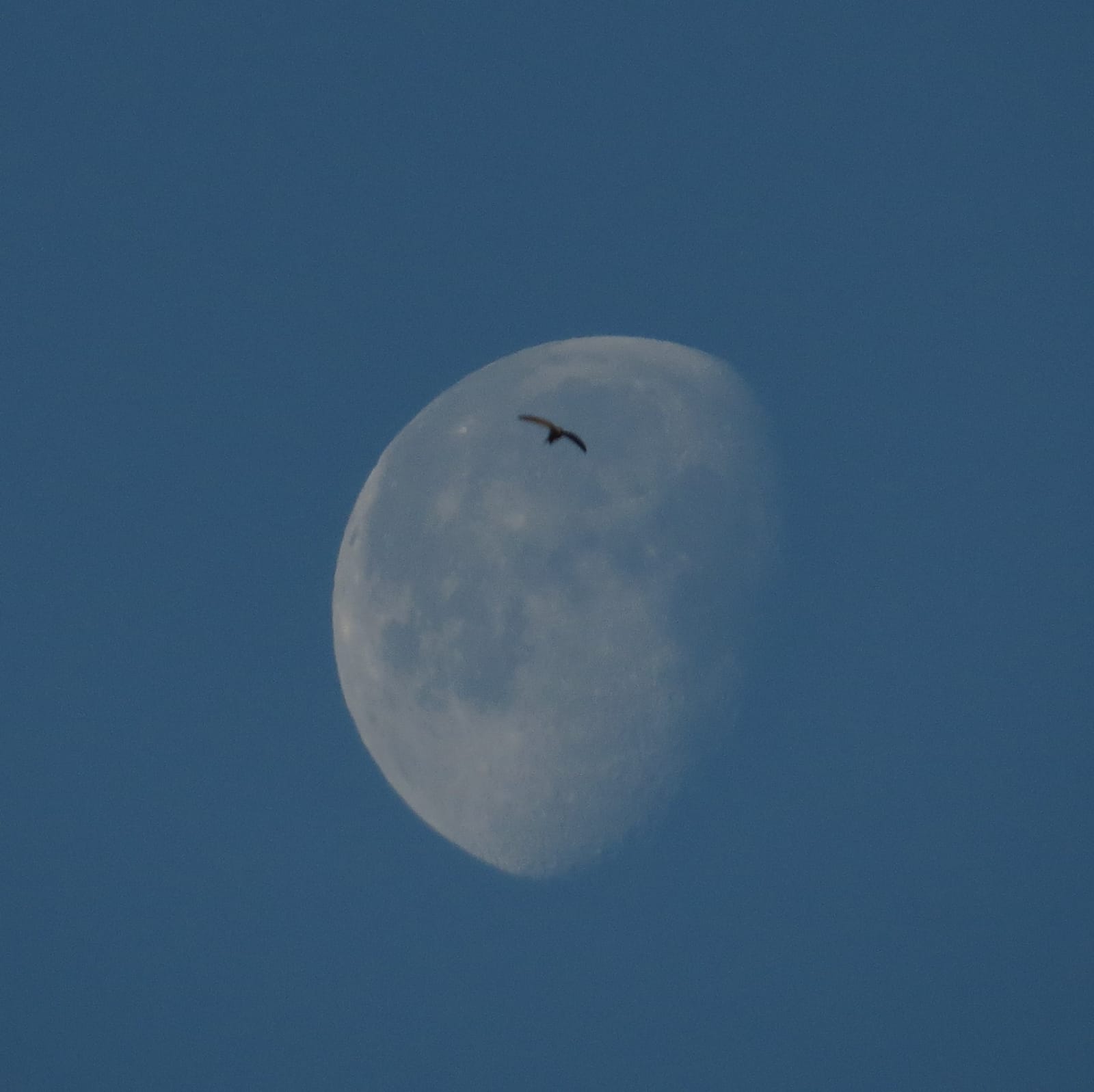
Photo © Elizabeth Cotton
Daffyd Coe told us he had spotted one lone Swift at Shoreham-by-Sea, near Brighton, on Sunday 19th April. Robbie
Gooders spotted a Swift over
Winchelsea, near Rye, the evening of the 21st April. Jacqueline Dubet
at the WWT's London Wetland Centre tells us that Swifts were seen
overhead on 22nd April. and Andrew Mcveigh saw some over his home near
Winchester on the same day.
And amazingly Steven Robinson found a Swift already in one of his next boxes in Dulwich,
South London, on the evening of 22nd April, an incredible three weeks
earlier than last year. Here it is, (photo opposite and above), snug in its nest.
Wayne Lewis in West Wales e-mailed (24th April) to say he has seen
Swifts above his house, 7 to 10 days early. Same for Jennifer
Greitschus (London E5) and Bob Coates (Ewhurst, Surrey), both saw their
first Swifts on the 26th April.
Swifts
will be flooding back to nest all over the Northern Hemisphere
starting now and then on into June. Keep an eye open for them, and keep
their nest holes open for them
too! Protect and save!
|
Back from Africa,
now safe in its nest in Dulwich, South London
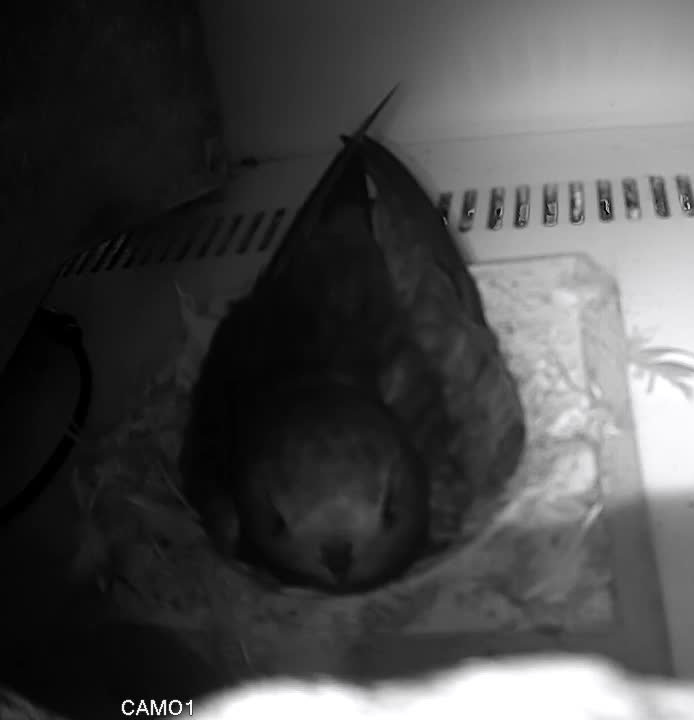 Photo © Steven Robinson
Photo © Steven Robinson
Can't travel? No holidays? Here are some Swifts from Morocco instead
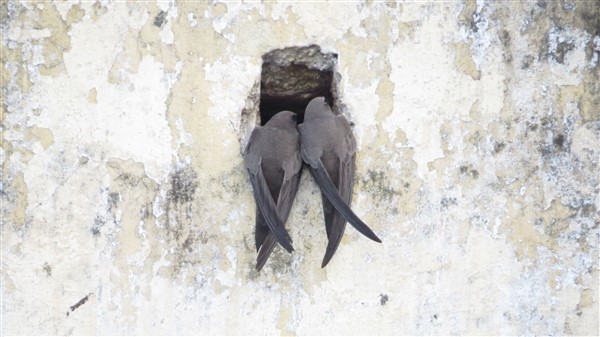
Photo © Elizabeth Cotton
Above,
just to whet your appetite for travel once we are all free
to move again, two magnificent, huge and super-fast Alpine Swifts at
their nest hole in a building in
Fez, Morocco, where they are plentiful, and very easy to see.
See them,
admire them, and encourage local people to treasure them!
|
A difficult New World is here, and we can survive it- with Swifts!
Covid
19 "the Wuhan Flu" has changed our lives, for the immediate and
forseeable future. Until a vaccine is produced and we get it popped
into us, we are all going to have to live more sheltered, carefully
protected lives.
What has this meant for the world of Swift experts, amateurs and
carers? The International Biennial Swift Conference, to be held this
coming May in Segovia, Spain, has been postponed to 2021, the Rutland
Water Bird Fair has been cancelled, though the lecture programme may be
run on-line, Swift Conservation has had to cancel all its public
talks, but...... nest box work is thriving!
Nest box makers are telling us they are handling a big increase in
demand, and we at Swift Conservation are selling record numbers of our
Swift call CD and MP3 recordings. So people stuck at home are thinking
"Let's help Swifts! Let's get a nestbox or two up and running!
Great,
isn't it? Opposite, a "Lockdown DIY Swift Project", Tim Knowlman's (of "SOS Martinets") new nest
box system now up in his and his wife Carolyn's flat in Amboise right by the River Loire, a
great Swift spot where birds (and bats too!) feed over the river on the plentiful insects that swarm there.
You can do it too! Go on, help Swifts, help the World, make nestboxes
for friends and neighbours too, and keep your morale up with a nestbox
project!
You'll find all you need to know right here on this website, and then
you can spend the summer days lolling at your window, on your balcony,
or in your garden, scouring the skies for Swifts, G & T in hand
(note Tim's G & T on top of the nestboxes on the right - an
essential Lock-down Tonic!)
Living or working in France? Then have a look at SOS Martinets too!
|
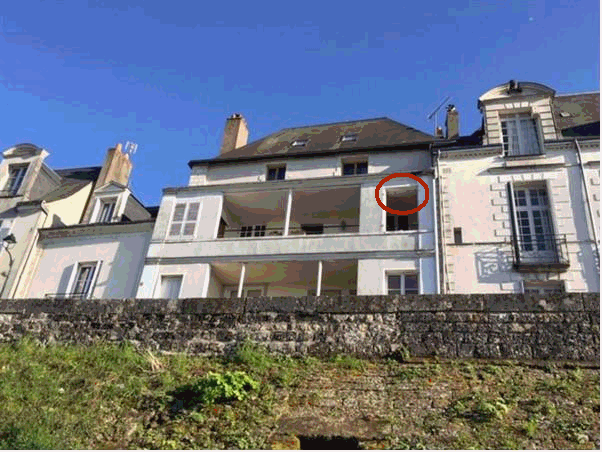
Photos © Carolyn Knowlman Swifts of France
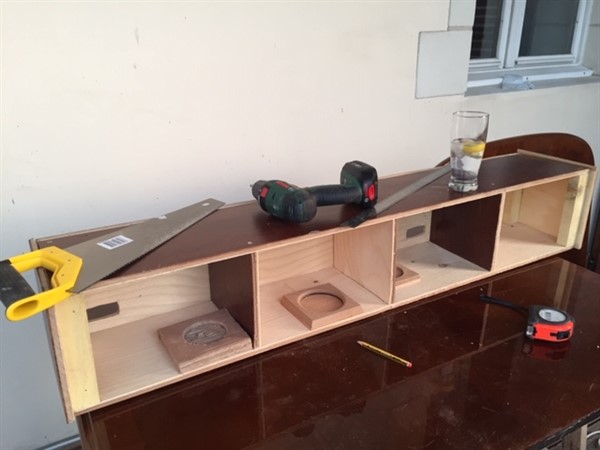 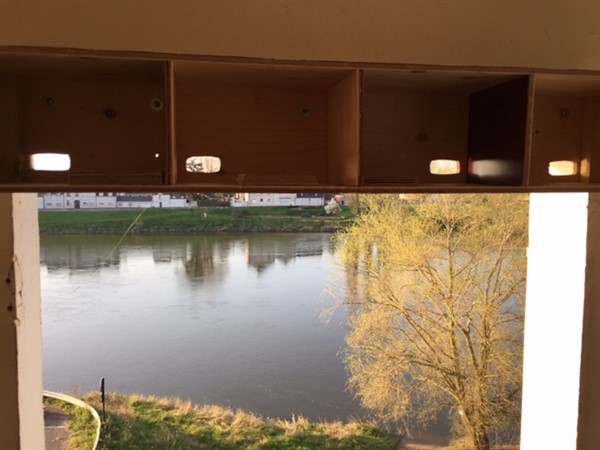
|
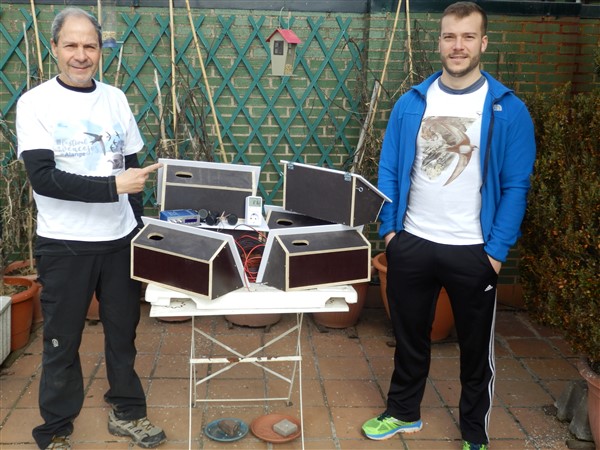
Photo © Carlos Palma Burgos Swift Conservation Group
|
Burgos Swift Nest Box Project
Nest box makers are thriving too in Burgos, Spain! Carlos Palma (on the
left in the photo with Orlando Garzón) has written to us about their
local Swift Project.
With the help of John Stimpson, nest box maker in Cambridgeshire,
(20,000+ Swift nest boxes made and sold so far!) they have been making
Swift nest boxes locally, together with the nest bowls that encourage
Swifts to nest. This can only help the Swifts of this spectacular town,
so rich in historic buildings, and history too.
Spain still has some of the biggest Swift populations in Europe,
concentrated mostly in old buildings in the heart of ancient
towns. With all the endless pressures from redvelopment iy is esential
that they are preserved.
What is more, and unique, is that Spain has populations of no less than
5 species of Swift, Common, Pallid, Alpine, Little and White-rumped,
the last two African species that have moved in to Andalucia in the
extreme South of Spain, maybe as a result of the climate changing to
become warmer and dryer.
All but White-rumped are easy enough to see if you go to the right places.
Use this link for more information on expert Swift watching in Andalucia!
|
Parma Ospedale Vecchio Swift rescue Project heads into second year
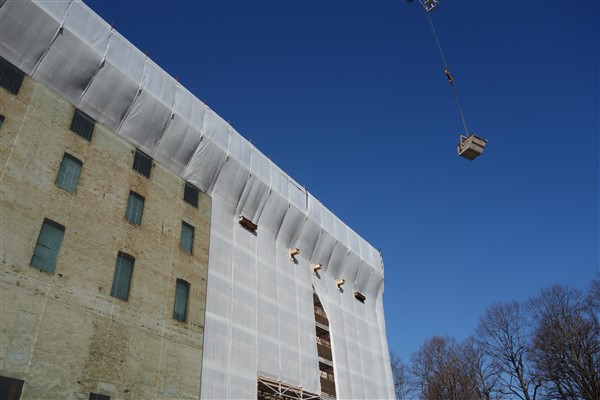
In
February we jetted off to Italy to meet local Swift Groups and
see their projects, to give any advice that might be needed, (and
also to try the unique local cuisine of this area, with its highly
individual wines and foods).
One major project in Emilia Romagna that we visited was at the Ospedale Vecchio in Parma, shown above.
This is a very old public hospital, dating from the 15th Century, and in use until 1926, but now
undergoing renovation for new public uses.
In
poor condition for some years, but very far from derelict, with a sound
structure and watertight roof, many Swifts had found places to breed
inside its eaves. Wrapping the building to protect it during the works
meant the Swifts
could not access their nests, so the Parma Swallows & Swifts Group
("Gruppo Rondini & Rondone Parma") became involved, and a technique
recommended by Mauro
Ferri of Monumenti Vivi was used
to keep the Swifts nesting without population losses.
|
This technique was to fit
temporary nest boxes to the scaffolding, so the Swifts had somewhere to
nest while the works proceeded.
The
project has been a success. Of the 43 nest boxes put up, 22 are
occupied by Swifts, with some Back Redstarts and Titmice using them
too. This is entirely normal; there is always strong competition for
the most desirable holes in a building from the many species of
hole-nesting creatures, and in Italy this will include Lizards, Geckos too. Rather oddly, Swifts seem
to occupy no more than one of every two nest boxes put up at some sites.
Above:
Nest boxes, designed, manufactured and supplied by CISNIAR and donated
by Renzo Rabacchi, were fitted to the scaffolding of the Ospedale
Vecchio
in front of the wrapping. Other nest boxes were donated by Francesco
Mezzatesta, Franco Roselli and Renatao Carini both of As.O.E.R.
Returning
Swifts in 2020 will be using the nest boxes again, as they are still in
place for a second year of works. Hopefully works will end some time
this year or early next, and the Swifts can return to their old nest
places beneath the tiles.
Working in Parma, Piacenza and Pavia, we spent time with Francesco
Mezzatesta of ADA Onlus - Parma Swifts & Swallows Group, Mauro Ferri of
Monumenti Vivi, and Eugenia Parisi of Swifts of Campiglia, all of them
devoted to keeping Swifts, Swallows and Martins thriving in Italy's
ancient monuments and buildings, both old and modern.
Photos © ADA-Onlus Parma
|

Photos © Ian Hartrey
This
wouldn't have happened without all the efforts of Ian Hartrey who
devoted two years to getting Swift and Bat boxes into this new
development.
It meant frequent liaison weith the builders, a huge amount of
determination, drive and, it would seem, sheer nagging, but in the end,
it worked!
And you can do it too!
|
The St Paul's development Penarth
Ian Hartrey writes to us from Penarth in Wales to tell us that the
developers with whom he has been working have fitted 13 Swift nest
boxes and 3 Bat boxes to a local new housing development.
The photo on the left shows in close-up four of the new "woodcrete"
heavy-weight, long-lasting nest boxes, while on the right is a wider
view of more of the development.
This is very much the route we hope to see all new building
developments take. Incorporating nest and rest places for birds, bats
and other wildlife, to replace the devastation we wreak daily on the
living world all about us.
There are many ways to get involved, to if possible help to swing things in local developments Swifts' and Bats' way.
Contact us if you need advice, examples, ideas, and mentors.
|
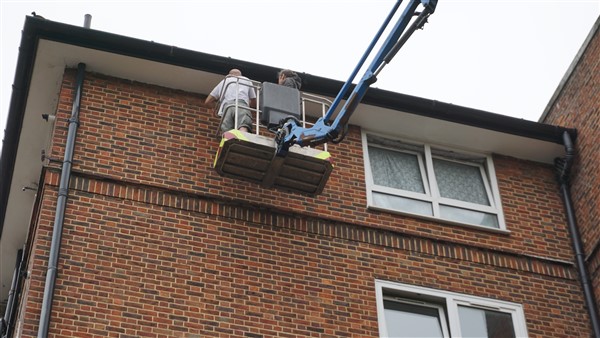
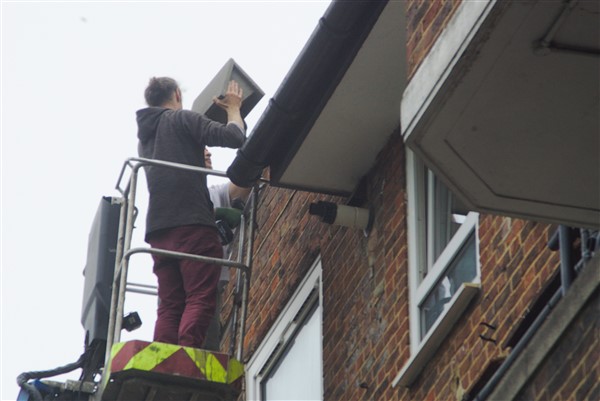
Photos © Daniel O'Byrne - Friends of Surrey Square Park
A
superb project set up on a Southwark Council Estate, the Kinglake
Estate, next to Surrey Square Park and Burgess Park Lake in South
London.
Residents there are already highly aware of the need to support and
enhance local biodiversity, and much has been done in the way of
planting and sympathetic managment to support resident species,
inlcuding a good population of a Red-Listed bird, the House Sparrow,
now extinct from much of its former range in London.
Swift Conservation was invited to survey the site back in early 2019, and to recommend a nest box scheme for Swifts.
To our delight we found an ideal site, handsome and highly suitable
buildings in good condition, and most important of all, highly
committed and enthusiastic people form the Esate, from the Management,
and from Southwark Council itself.
This is really important; hardly any nest box scheme will work without
sustained consistent intelligent support from local people.
A local website is planned, using web-cams fitted within the nest boxes.
|
Southwark's Kinglake Estate
gets more Swifts - thanks to Cleaner, Greener, Safer!
That's the way you do it!
You just need a huge Cherry Picker, and friends at the local Council! Sixteen new Swift Nests right here!
The
nearby lake in Burgess Park is great for attracting Swifts and House
Martins who feed over it, and some Swifts are already nesting in old
ventilation bricks within the Estate.
Last year some 20 Swifts were seen feedingover the Lake, and about 12
were seen to be inspecting the new nest boxes on the Estate. It looks
like there are excellent prospects for establishing a colony there.
This is a Local Biodiversity Project put together with the support of
Julian Weston - Residents Association - Kinglake Estate
Nills Battye - Project Manager - Southwark Council
Edward Mayer - Swift Conservation
Daniel O'Byrne - Friends of Surrey Square Park
Funding: Southwark Council's "Cleaner, Greener, Safer" Scheme
|
Multiple Swift nest box inserted into historic building near Turin
Giovanni
Boano, Curator of Birds and Mammals collections at the Museo
Civico do Storia Naturale di Carmagnola, near Turin in Northern Italy,
has sent us this photo of a new multiple nest box, that he has built
into his old home in the Via San Francesco di Sales in Carmagnola town.
A
project like this can house maybe as many Swifts as have been evicted
from half a dozen nearby buildings by renovatuon and modernisation
works.
Giovanni
has worked hard for years now on behalf of Swifts in his region of
Italy, organising local conferences and activities, participating in
National Swift Day celebrations, leading walks, talks and displays, all
for the benefit of local Swift populations, local school-children, and
local environmental enthusiasts (of which Italy has very many, much to
some people's surprise; they outnumber the hunters by far).
Photo © Giovanni Boano Museo Civico do Storia Naturale di Carmagnola
|
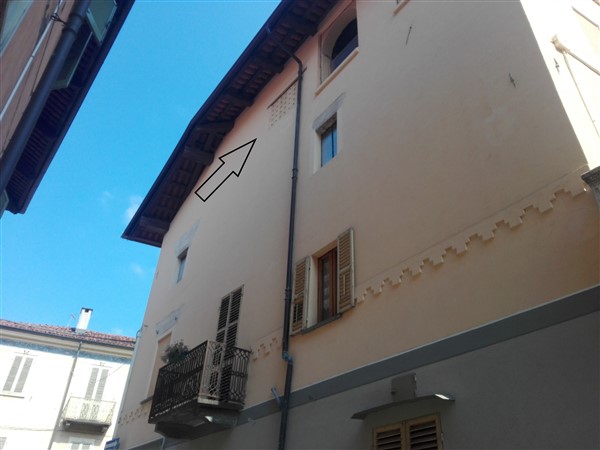
|
Islington Swifts - NE London
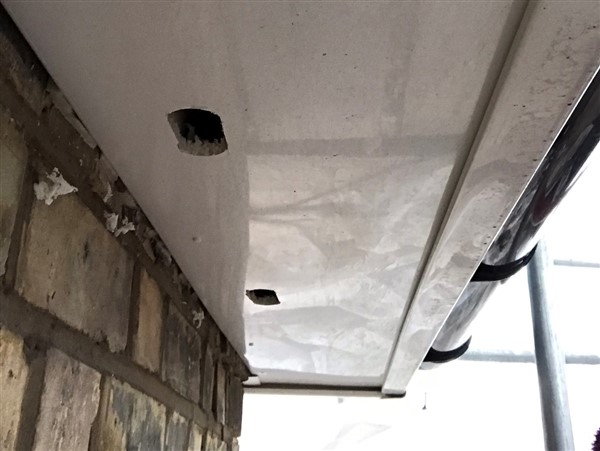
Photos © Michael Priaulx - Islington Swifts
|
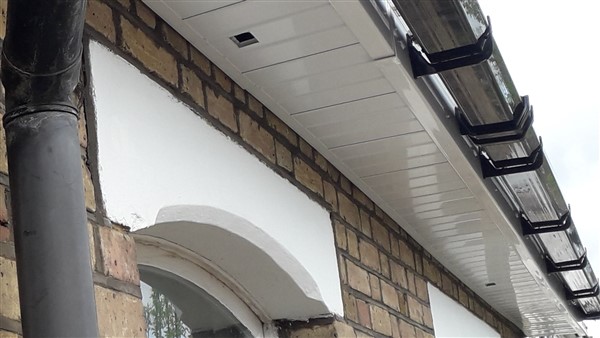 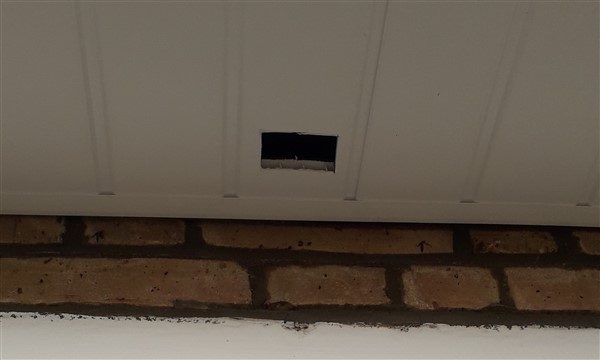
Very Easy Swift Nestplaces!
Where buildings have wide eaves and timber or Upvc "boxed" (i.e.
internally separated from the roofspace) soffits, easy to drill into,
you do not need to install separate nest boxes. Just drill 28 x 65mm
holes in the soffit between the internal timber supports, and you create a Swift nest!
These
photos of a project in Highbury, Islington, NE London, were sent to us
by
Mike Priaulx of Islington Swifts, who works for Swifts all over North
and East London. You can see just how easy it is to create spaces for
Swifts to breed in when the scaffolding is up. All you need is a hole
saw and a drill, and the guidance freely available on this website and
in our leaflets which you can download here.
|
Swift Care in Majorca, Spain
Wildlife casulaties are treated at public expense in Spain. There is a
sort of National Health Service for wildlife there, and each of Spain's
semi-autonomous regions is required to provide veterinary services for
all injured or ill wildlife found by the public and brought in for care.
We were sent some photos form the Majorcan wildife care centre late in
2019, showing their volunteers hard at work looking after the over 700
young Swifts brought in to them. These are mostly young birds that fall
from the nest before being able to fly. It seems that 2019 was a bad
year, with extreme heat causing many young Swifts to jump too early
from their nest holes.
It is hard work, but their success rates can be high, so it is very much worth while.
We are very grateful to Fiona Browne and Cristina Fiol for briefing us and for sending us these photos.
|
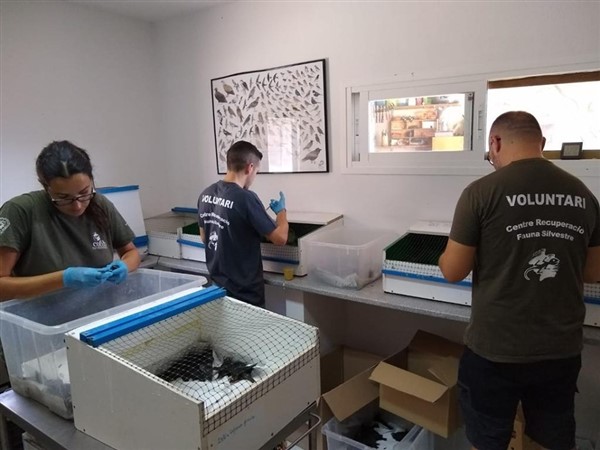
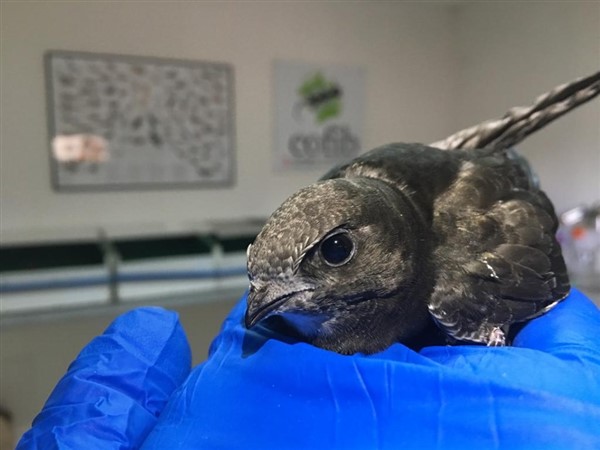
Photos © Conselleria de Medi Ambient, Agricultura i Pesca and COFIB (Wildlife Rehabilitation Centre Mallorca)
|
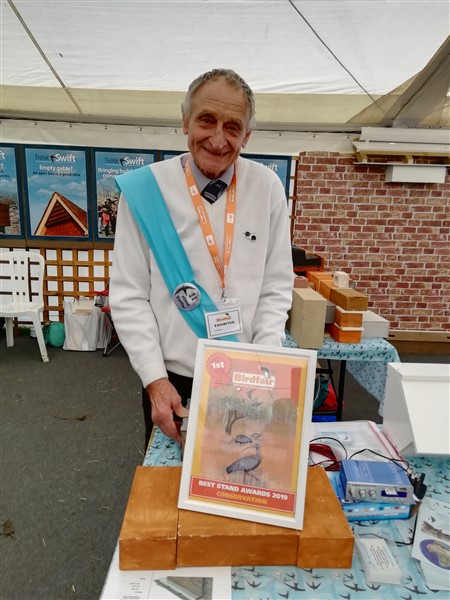
Photo © Swift Conservation & Mandy Mayer
|
Bird Fair 2019
The Swift Stand wins First Prize
The 2019 Bird Fair held at Rutland Water saw the new enlarged and
redesigned Swift Stand win First Prize in the Conservation category.
A joint effort by Action for Swifts, Swift Conservation and Swifts
Local Network, the stand is staffed by volunteers from the UK's 80+
Swift Groups, and greets several thousand visitors every year.
It welcomes enquiries from all over the UK, Europe and indeed the World
regarding Swifts, and it provides a place to sell nestboxes, Swift call
systems and souvenirs.
But its main purpose is to encourage people to set up Swift nestboxes,
establish their own colonies, and spread the word that Swifts need
help, are a vital part of urban biodiversity, and can be helped by
anyone with an interest.
On the left the photo shows Bill
Murrells of Action for Swifts holding the First Prize certificate won
by
the Swift Stand, against the backdrop of the posters and temporary
walls demonstrating how to install the many different types of Swift
nest boxes and Swift bricks now available.
|

Beryl
Hunwicks, Mayor of Woking, formally opens the Woking Swift and Bat Column on
1st August. Woking's column sits in front of the town hall, opposite the
World Wildlife Fund HQ next to the canal. Its base is carved with a migration map, Swift images and Swift facts.
We hope this is the start of a Woking Swift Renaissance,
with many nestboxes being set up in the pedestrianised and greened
shopping streets leading from the Council Offices, where this column is
situated, right through to the railway station. As part of this project,
Swift nestboxes are being fitted to the Peacocks Shopping Centre at the heart of this area.
This is
the first Swift and Bat Column to be commissioned, another one has been installed at the University of
Birmingham. We hope that as interest in our Swift Columns builds up, more will be set up in 2020 and beyond.
Photos © 51 architecture & Edward Mayer
|
A new Swift beacon for Woking
A
couple of years back we gave a talk on Swifts and the benefits of urban diversity to the local
Council staff of Woking, and as a result they were really keen to get a project going!
When
they were looking for a new focal point for the town which would make a
connection between their offices and the
new HQ for the World Wildlife Fund just across the road, and serve as a
waymarker for their twinned towns in Germany and France, they decided
on a Swift Column.
They ordered one of our
new Swift and Bat Columns, designed by us in collaboration with 51
architecture for their Habi-Sabi nestplace range,
and turned it into an educational info-point and waymarker,
with a stone base decorated with Swift images designed by Jonathan
Pomroy, the well known bird
artist, and a time sequence and migration map provided by the British
Trust for Ornitholgy showing Swift migration across the Globe.

The
idea behind the steel and oak Swift and Bat Column is that it mimics the
natural woodpecker holes used by Swifts in parts of Scotland, Poland
and Lapland, and it also fits easily into the modern urban
landscape.
The head of the Column, with places for 8 pairs of Swifts and bats too.
|
New homes for Swifts in Poland
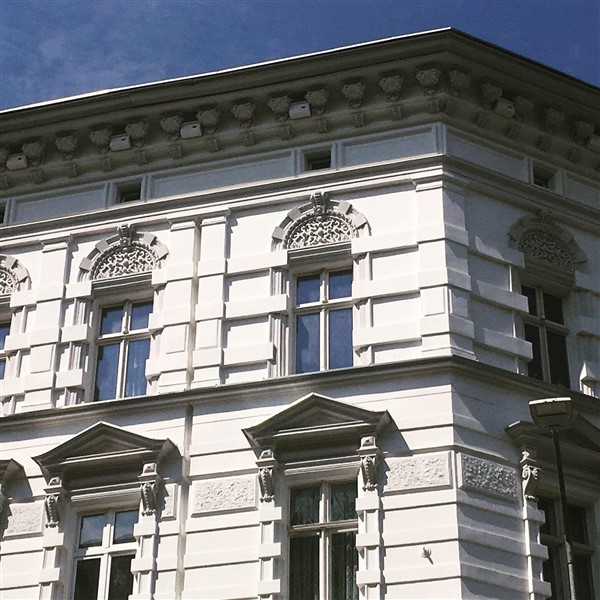
Karen Sayce writes to us from Szczecin:
"I don't have any scientific evidence, but I don't think our
Swift population has suffered as much from the storms further south and west
which seem to have had a detrimental effect on the Swift populations
nearer the Mediterranean. Perhaps ours fly up via Greece and the Balkans. They
were a bit slow arriving, but numbers seem to have picked up recently -
maybe the second wave is here!
I have also found a couple of renovated buildings in town where Swift
nest boxes have been installed, and in large numbers - a very pleasant
surprise! I don't know who runs the buildings - whether they are
privately or council-owned - but I hope it's a sign of things to come.
Photos © Karen Sayce
|
These nest boxes (see close-up photo on the left) were installed under the cornices as part of a renovation of old
art-nouveau apartment blocks (see above) in the city centre (the first on the
corner of Bohaterów Getta Warszawskiego and Królowej Jadwigi, and the
second on plac Zgody) which had not been repaired in over seventy years.
Since they were only completed in the past year, I'm not sure how
occupied they are, but I think I heard some peeping from the first one
when I went past to vote in the Euro Parliament elections on 26 May!
In town, those in charge of housing associations and cooperatives
still have a tendency to do renovations at nesting times and will block
up nest sites with chicks of all species in them. However,
there seems to be an increase in awareness among ordinary
residents who are complaining to the authorities when such building work
starts, and I
think it very much depends on whether you have an enlightened
individual at the housing association."
|
|
|
The Isle of Man helps Swifts
Following
a visit from Swift Conservation's Edward Mayer, who gave a public talk
and ran a private training session for council staff, Manx National
Heritage have installed 6 Swift nestboxes on one of their buildings in Douglas and have fitted a loudspeaker below to encourage
birds to investigate.
The nestsboxes were placed on two of sides of the building on the left, to see which side
the Swifts prefer and once they have made their choice there’s room for
more to be installed. If this trial is a success it is hoped to place more Swift nestboxes on other Heritage buildings.
Photo © Manx National Heritage
|
Huntingdon Station Flyover Swifts
We were asked a few months ago to help with a problem at Huntingdon.
The huge ring road that encircles Huntingdon is to be demolished, but
in the span that crosses the North East railway line, Swifts have
used drainage holes in the underside of the bridge to enter and make
their nests. This is the only place I have seen this happen in the UK,
but we know of a famous site near Siegen in Germany where Swifts
are nesting like this.
The road, bridge included, is to be totally removed. What is to be
done? As discussed with the contractors CH2M UK, we plan to ask nearby
homeowners to let us put Swift nestboxes up on their homes, and to
erect a Swift Tower on a nearby greenspace just up the road. Calls will
be used to attract the birds to use the new nestsites, when they find
their old ones gone.
On the right you can see photos of the bridge, and below in close-up,
one of the holes under the carriage way (near the lamp-post) where the Swifts
are nesting.
|
Photos © Edward Mayer
|
|
|
The Duchy of Corwall installs Swift Nest Places big-time
Stephen Fitt, the RSPB's Volunteer Swift co-ordiator in Exeter,
reports to us that following his approaches, the Prince of Wales
is promoting wholesale installation of Swift nest boxes within the many
new urban developments being built by his contractors and architects
within the County, and also in Dorset and Oxfordshire on Duchy of
Cornwall land.
There have been installations in Nansleden in Newquay, Tregunnel Hill
also in Newquay, and on Union Hill in Truro. More nest places are being
installed in Poundbury, another Duchy site, near Dorchester.
Opposite and below are photos showing the Tregunnel Hill site. Can you spot the Swift nest holes? The
Duchy has committed itself to place at least one Swift nest place in
every house that it builds.
It is hoped that in this way between 5000 and 8000 nestplaces will be
created for Swifts in these properties over the next 30 years.
Photos © Duchy of Cornwall Estate
|
Shepcote House in Enfield to keep its Swifts despite complete rebuilding
Swifts had found plentiful places to nest within apertures in the walls
of a 1960's multi storey Council owned apartment block at the New
Avenue estate in Oakwood, Enfield.
When the time came to rebuild it, a well-informed team of London Swift
activists, Catherine Day, Mike Priaulx and Edward Mayer, guided by a
local Swift fan, Andy Potter, and expert Swift surveyor Mary Dixon, intervened on behalf of the birds,
and secured superb cooperation from the owners and the developers,
Countryside, and the advising ecologists, Middlemarch.
So far 42 nest places have been installed in two of the new buildings,
(one is shown below) with more to come, and Swift calls are being
played to lure the birds in. Swifts were seen there on 1st May, a very
good start!
Photos © Michael Priaulx
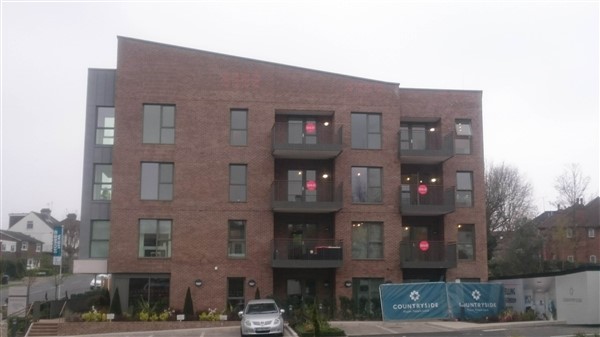
|
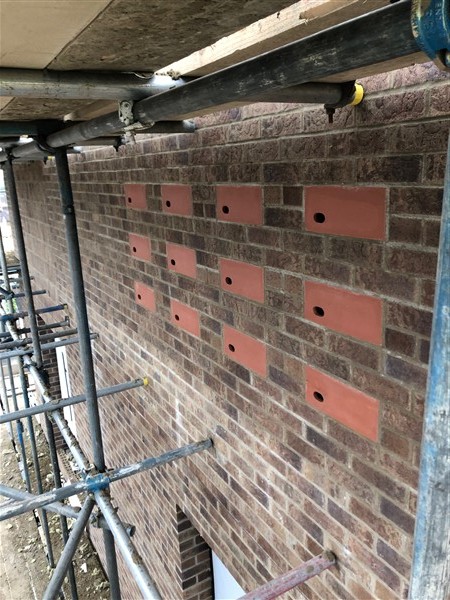
|


|
Menai Bridge in Anglesey
The
Ocean Sciences building in Menai Bridge is part of Bangor University
and was amongst the first places North Wales Wildlife Trust (NWWT)
installed Swift nest boxes at in 2015. It was close to two existing
Swift colonies. In 2017 they saw the first signs of Swift occupation
(the previous two years there were Sparrows in one of the boxes). In
2018 when they surveyed the site they recorded Swifts in and out of all
four boxes which was great.
In addition NWWT has installed five
nest boxes at Bangor University's Dean Street site and also a terrace of nine boxes on their Natural Sciences
building, with the help of
BTO Cymru who are based nearby.
NWWT is preparing
to install some more Swift nest boxes on the same building and possibly
on another University building nearby this Spring.
More Swift nest boxes have been set up on nearby homes too!
Photos © NWWT
|
We talk to Parma!
The ADA-Onlus environmental protection society in Parma invited us to
come and speak at a half-day seminar "Edifici Viventi" (Living
Buildings) all about the Swifts and House Martins living in the
historic heart of this city famous worldwide for its Parma ham and
Parmesan cheese, but also for its stunning Cathedral and the adjacent
amazing multi storey Baptistry.
Students from the local Liceo Scientifico Giacomo Ulivi working with
famous wildlife expert Mauro Ferri and their teacher Andrea Beseghi had
conducted a thorough survey of Swifts and House Martin nesting sites
throughout the historic heart of the city.
They had also looked for
Swallows, but had found none. Older residents can remember days when
the skies were filled with all these birds, but now numbers are sadly
reduced and the conference was called to alert all those concerned.
We were tasked with presenting Swift recovery projects from all over
Eutope and Central Asia too. Showing nest place projects from more than
a dozen countries, we worked hard to inspire all those there with the
hope and the means to start reversing the declines in these amazing,
beautiful, charismatic and life-enhancing creatures.
The conference was supported by the Ministry of Culture and the Gruppo Rondone Italia. See the conference presentations here.
Photos © ADA-Onlus Parma
|
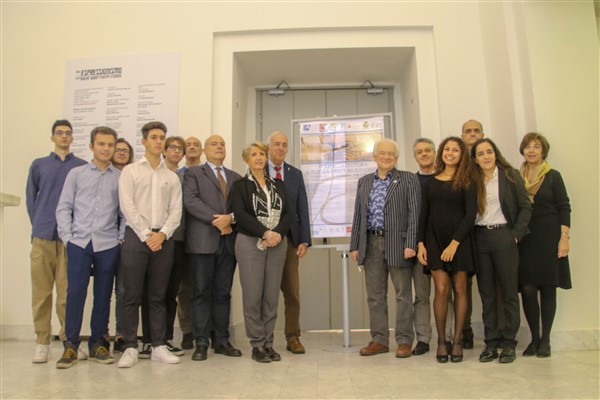
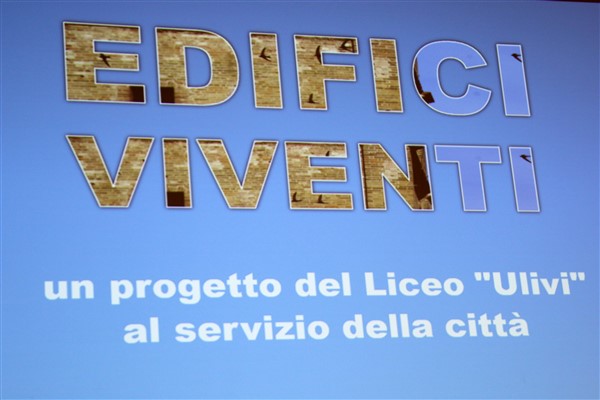
|

|
First success for new UK-made fibre-glass Swift nest box?
We were sent this photo from Tonbridge in Kent, of a Swift checking out
one of the latest types of nest box made here in the UK, the
"Impeckable" fibre glass nest box, single cavity version.
Note the sound system (the tweeter loudspeaker is visible at far lower
right) playing the calls that attract the Swifts to the new nest places.
You can find these nestboxes (guaranteed for 25 years) which are
available in a wide range of colours and sizes, plus the Swift calls
recordings on our "Shopping" page - click here to go to it.
|
Dublin corner shop starts Swift revival
Helen Burke of Dublin Swift Conservation has sent us this photo of a
mural of Swifts, part of a shop improvement scheme supported by Dublin
City Council in association with the Dublin Swift Group and The Haven
Pharmacy.
This new local feature has kickstarted an entire environmental enhancement scheme involving local people.
The partners in this scheme together with Dublin Swift Conservation
have plans for more and similar local projects, all with the aim of
getting more people to both know about and to protect their Swifts, and
to brighten up their neighbourhoods at the same time.
Photos © Helen Burke / Dublin Swift Group
|
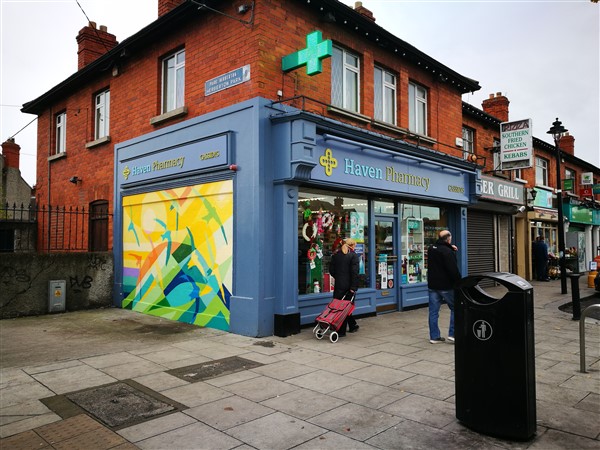 |
Saving House Martins in Italy
We love House Martins too, so when WWF- Italia asked us for our advice
we headed off to a disused oil-powered power station just outside
Piombino, on the coast of the mainland near the island of Elba, where large numbers of
House Martins (Balestrucci in Italian) had nested for years.
Right next to an excellent sea-side and salt-marsh nature reserve,
hosting great populations of Waders, Herons and Flamingoes, this site
could have a great future in wildlife conservation if it is developed
sympathetically.
But unless we could come up with a viable rescue scheme, the nests
were going to be knocked down together with the whole of the power
station, and the site reclaimed for other uses.
Working with the site architect, Riccardo Stoppioni and his team, and
with our wonderful translator Eugenia Parisi always at our side, we
devised a solution; ranges of new walls stacked across the site running
up to a nice muddy drainage canal, that would provide ample attachment
areas for new mud nests, as well as on their lower regions areas for
creeping and rambling plants.
The photos on the right show, top left, original House Martin nests on
the eaves of the metal sheds housing the boilers and generator, and on
the right initial ideas from the architects responsible for restoration
of the site for artificial arcades to support the nests of the House
Martins in nearby locations. Something like this, but with a lot less greenery is likely
to be selected for the scheme.
Below is a photo of the power station site as it is now, awaiting
demolition.
Photos © Edwad Mayer, Drawing © Architect Riccardo Stoppioni
|
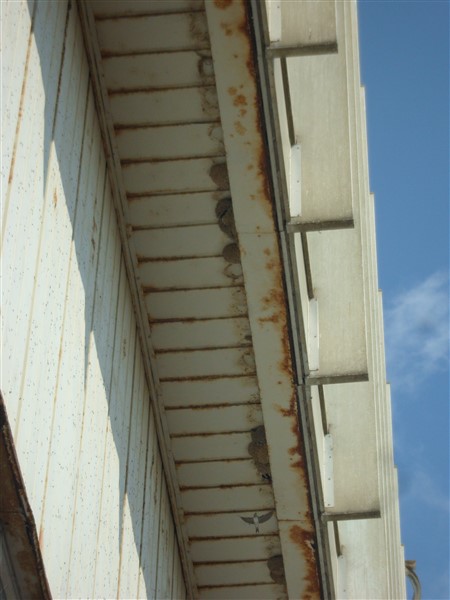 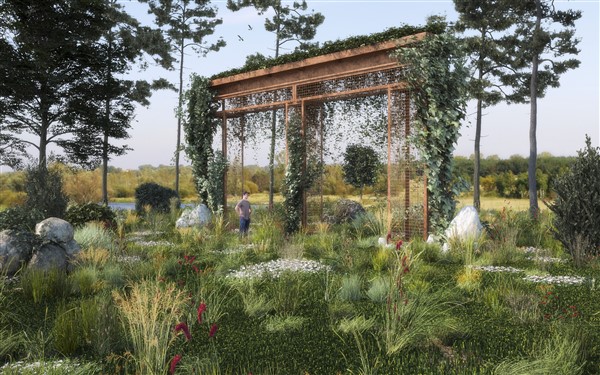
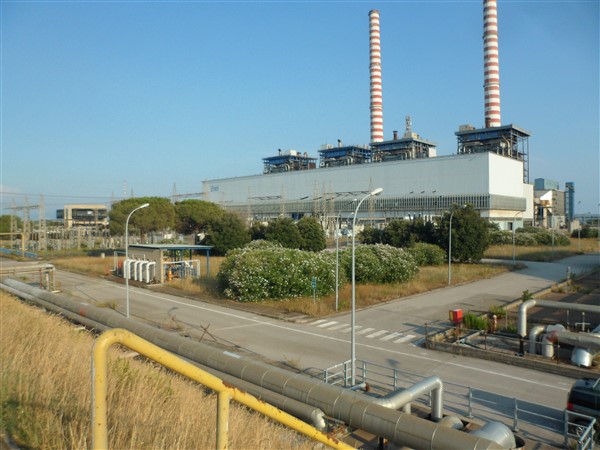
|
Swift Awareness Week - Amazing Results!
We have been featuring just a few of the many amazing (over 90!) events
organised for Swift Awareness Week 16 to 23 June. There was stacks more
going on, over 90 events nationwide, some of them very ambitious indeed!
The famous village of Aldeburgh in Suffolk has done some amazing
things for Swifts. On the right, a lovely little Swift House on show in
the local estate agent! The local Aldeburgh Swift Group got its
leaflets and Swift books for chldren into lots of the local cafés and
shops, and set up a Swift Trail too!
Other Swift Groups like Tring & Hackney & Islington Swifts
& Lewisham Swifts ran Swift Walks & Talks and pub
get-togethers, and some put amazing floats into local fêtes -
we hope to get some photos of them to show you!
On
the right, a Giant Swift being interviewed in Presteigne,
Powys, Wales, for its views on Swift Awareness Week! We hope you got out there and joined in the
fun! Meanwhile, get ready for next year!
Photos © Alan Collett & Peta Sams
|
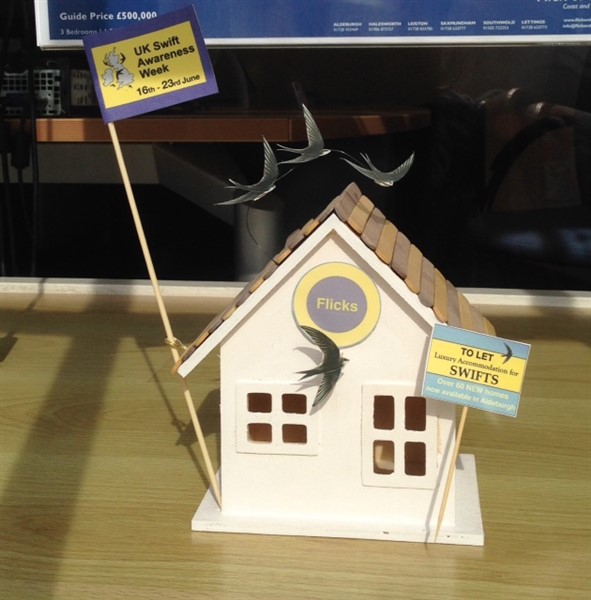 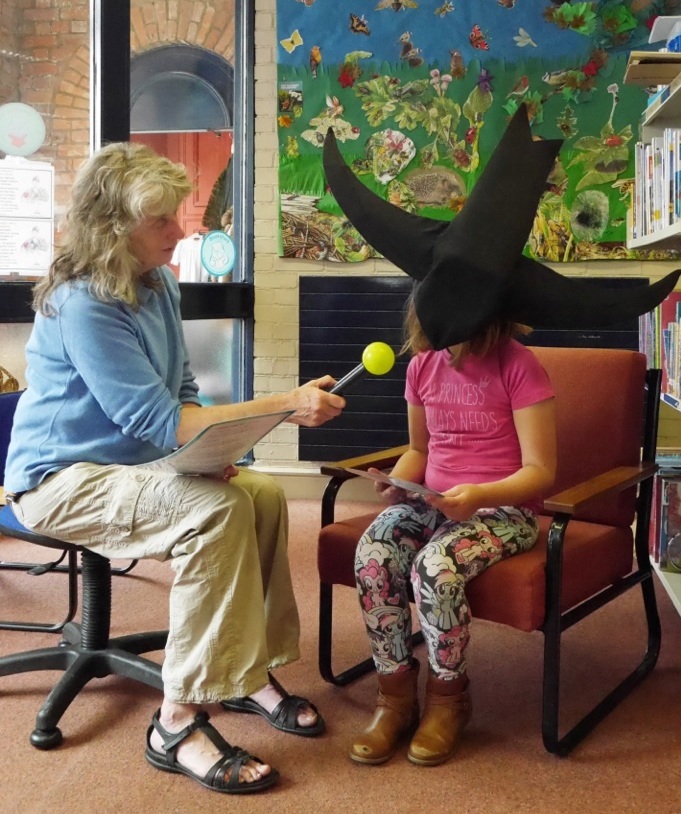
|
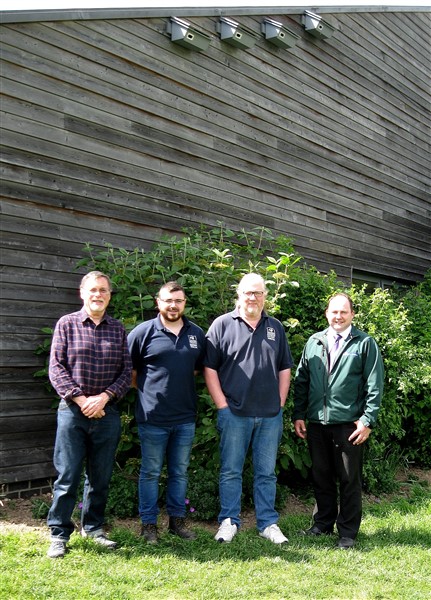
|
Swift News from Southend-on-Sea
John Smart writes to tell us that this area is still a stronghold for
Swifts as it still
has a much older building stock. But refurbishments with additions of
fascia and soffit boards are always ongoing, as is the case
nationally.
Essex Swifts is in partnership with the Essex Birdwatching Society and
the Essex Wildlief Trust, and we were invited to mount a Swift project
on EWT’s Belfairs
Woodland Centre.
It was thought it wise to protect the entrance surrounds with metal plates as Belfairs
Wood is known to be a stronghold for Great Spotted Woodpeckers!
A
tweeter is located in the box furthest from the camera and its cable connects
to the amplifier in the office down on the right.
The
line-up:- From left to right – Essex Swifts is represented by John Smart, EWT
Maintenance Officer & Technician David Murdoch, EWT Centre Manager Greg
Borgartz and Paul Jenkinson from the Southend-on-Sea Borough Council.
Sadly,
EWT’s Assistant Manager Alison Askwith was not available for the group photo on the day of
installation having been so instrumental in assisting the project.
Photos © John Smart / Essex Swifts
|
Dovercourt Estate Swift Development
This Estate is in the east of Islington and is being regenerated by
Islington Council and Lovell, with 70 new homes to be occupied within
two years. The mix of Council and private homes have been designed to
meet Level 4 of the Code for Sustainable Homes, to demonstrate a high
environmental performance.
Despite being quite modern, Dovercourt is excellent for urban
biodiversity. It has colonies of House Sparrows and Swifts nesting on
the boundary of the estate, in addition to a wide range of commoner
species.
The new-build works at Dovercourt successfully avoided disturbance of
the nests, by simple measures such as stopping workmen lingering in the
vicinity of the nests and removing scaffolding before the Swifts
returned in the spring. Juvenile birds were seen at the end of the
summer, demonstrating success.
Sparrow “terrace” nestboxes have been installed to provide additional
nesting for them, and bat roosting blocks and Swift nest bricks of the
Schwegler type are being installed in one of the taller blocks.
It is worth noting that the Swift bricks were installed voluntarily by
the developer in lieu of standard nestboxes, after a request by a
resident. The close proximity of nesting Swifts was only discovered
after planning permission was granted. However, the developer preferred
the simplicity of installing Swifts bricks compared to the
complications of installing nestboxes in trees.
Both Islington and adjacent Hackney make an interesting case study for
how residents can influence their Council to enforce measures for
Swifts, in these two cases to implement their Biodiversity Action Plans
which for both Boroughs specifically mentioned Swifts.
A small number of developments in each Borough had included measures
for Swifts. But there were many high profile buildings that had not
included them.
Hackney Swifts Group took a very assertive approach initially with a
petition and strongly worded articles in local publications. Islington
Swifts Group took a more conversational approach, through commenting on
planning applications and attending events and planning committee
meetings etc. Both have seen significant results with most suitable
applications requiring Swift bricks now, although each relevant
application is still being commented on to make sure none are missed.
In
less than 18 months, more than 20 planning applications have been
approved with planning conditions for Swift bricks, increasing from
almost none at the start of this period. With the help of the Parks
Department, residents and local organisations there have been at least
32 nesting boxes installed in the same period, to provide the Swifts
with interim nest places whilst the buildings with nesting bricks are
put
up.
Mike Priaulx - Islington Swifts
|
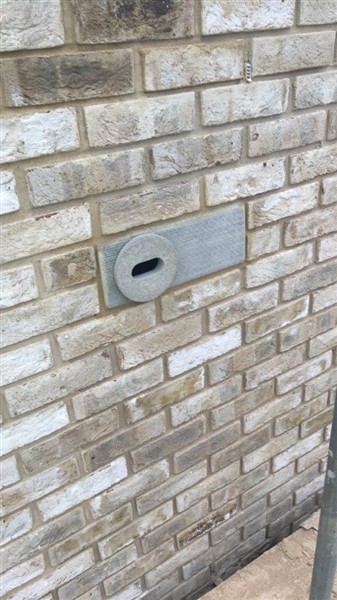 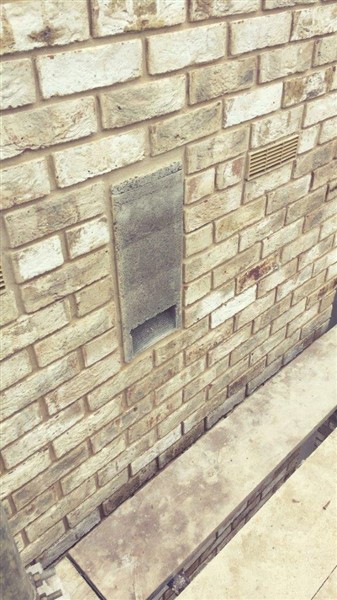
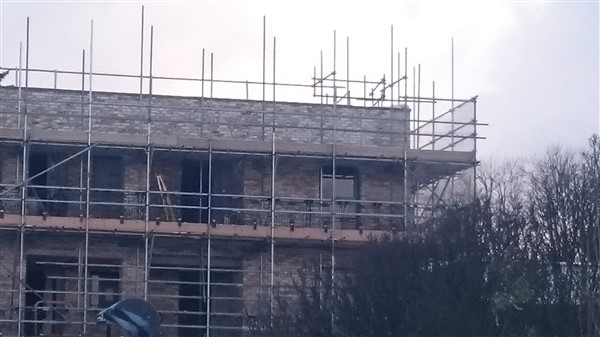
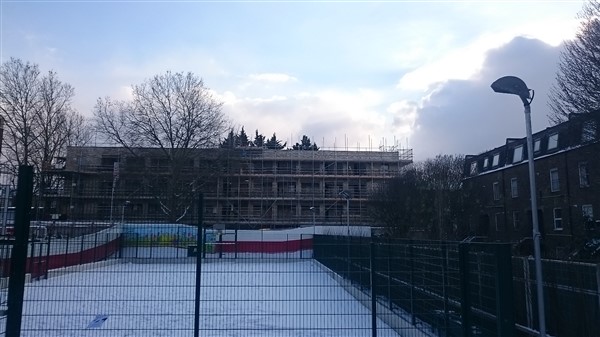
Photos © Mike Priaulx / Islington Swifts
|
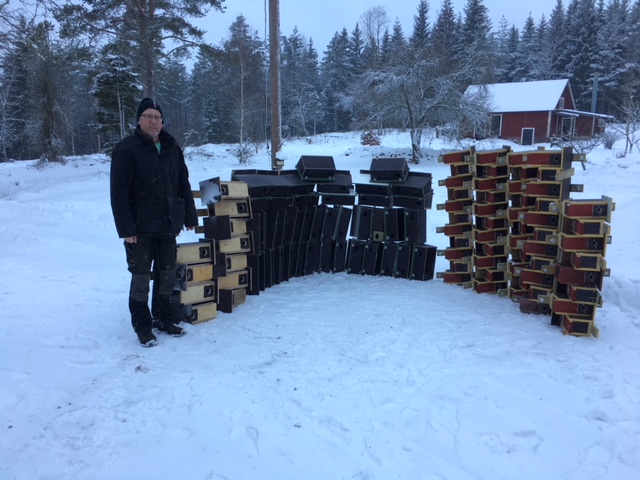
|
News from Sweden
Benny Båth has sent us this photo from his home in snowy Southern Sweden. A
keen supporter of Swifts and other birds, in Winter he makes nest boxes in bulk
and with his brother sets them up in time for the Spring breeding
season. Here he shares with us this winter's work.
11 Starling nestboxes
40 Swift nestboxes
51 small birdboxes for various woodland species
Benny
says: "The Starling boxes will be put up by my brother, he also manages
some nestboxes himself. The boxes for the small birds are mostly for
replacement and presents, I have 850 from this type already and will
not increase that. The Swift nests are intended for two new sites and supplementing and
replacement of older types. I have 103 up now but quite a few are of an old
type and at doubtful locations, I will try to improve the quality of
where I place them".
Isn't this great? We need more Bennies! Can you help? Photo © Benny Båth
|
Eddington Village Swifts
Eddington is a new village on the edge of north west Cambridge, with
several hundred new apartments for both students and the general public
built as medium-rise blocks, plus a Sainsbury's supermarket, a
community centre, a primary school and nursery, and all scheduled for
completion in 2018.
Developed
by the University of Cambridge on farmland between Madingley Road and
Huntingdon Road, the site is designed to meet high environmental
standards under BREEAM and the Code for Sustainable Homes,
environmental assessment methods.
There
is a sustainable drainage system with a new wetland area and Europe's
largest rainwater re-use network for flushing WCs and irrigation, and
planting includes species selected for their benefit to wildlife.
Photographs © Michael Priaulx
|
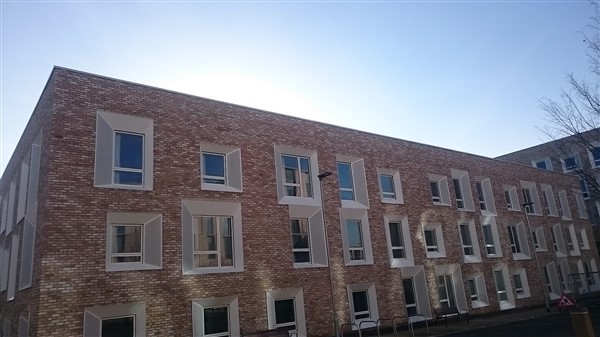
As
part of the overall environmental package, the developers have
installed 38 nesting bricks for Swifts, (one is shown in close-up up on
the left) with more integrated nesting bricks for other species
including House Sparrows. That means a potential breeding population of
76 Swifts, a wonderful sight to behold if it comes to pass!
|
|
Swift Care Training
On
Saturday 11 November 2017 SPARE (Swift Protection
Association Reigate) hosted a visit from Enric Fusté, a
highly qualified biological scientist and wildlife
rehabilitator from Catalonia, and a highly-regarded
expert in the treatment of injured, starving and
dehydrated Swifts.
The cause of many Swift fatalities is starvation,
dehydration, and premature fledging, but prompt rescue
and correct treatment can save them. Expert
rehabilitators can achieve rates of over 85% success.
For the past 10 years Enric's work has been focused on
the veterinary rehabilitation of insectivorous birds,
especially the Common Swift. He described the scientific
project he has conducted to find the most appropriate
diet for hand rearing Swifts and other insectivorous
birds that he encounters at the Torreferrusa Wildlife
Rehabilitation Centre in Barcelona where they are
brought by their rescuers. Torreferrussa is funded by
the Catalan government and provides treatment facilities for wildlife casualties from the Barcelona area and
part of Catalonia.
About
sixty people attended from the Reigate area, among
them RSPB members from East Surrey Local RSPB Group,
members of Holmesdale Natural History Club, the Green
Party, Surrey Wildlife Trust, and members of SPARE.
Enric collaborates with
Torreferrusa Wildlife Rehabilitation centre, which treats
up to 2000 injured and fallen Swifts (mainly chicks),
and annually around 10,000 wildlife casualties. Enric
showed videos of the baby birds being fed on insects and all the stages of the
hand-rearing process. It was an amazing
sight seeing just how much Swift chicks can fit into
their small beaks and how quickly the staff have to work
to feed as many as 600 birds five times a day! Enric's
talk was truly fascinating as well as highly
informative.
|
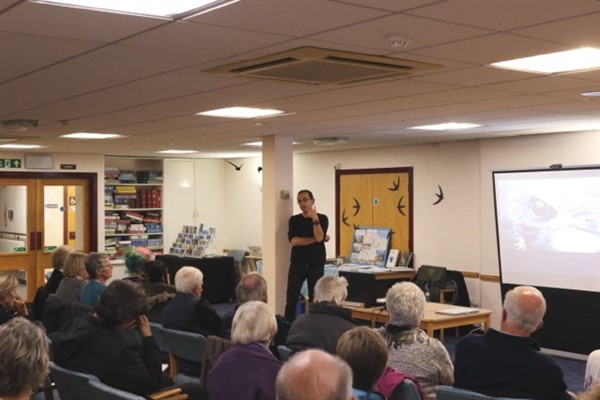
Photo © SPARE
Want to get involved?
If you are interested in hand-rearing information Enric Fusté can be contacted at info@swift-help.org
If you live in the Reigate area, are
concerned about the plight of this dramatic, exciting yet enigmatic bird and the destruction of its nests please email reigateswifts@gmail.com to see how you can easily help to
conserve these migratory wonder-birds of the British summertime.
|
Irish Swifts get a new deal
from Wild Kildare
Paddy Sherican writes to us from County Kildare in Eire "Wild Kildare was set up to promote, enhance and protect
the wildlife and biodiversity of Co Kildare, a land-locked
county adjacent to Dublin.
Our Swift project came about when a talk was given to the local
Birdwatch Ireland branch by Brian Cahalane of the Northern Ireland
Swift Group. Brian really sold the Swift to us while at the same time
clearly getting the message across that these birds were in trouble, of
which we had no idea.
Local supporter Dermot Doran who lives on a farm, put up boxes, having
never seen a Swift over his property. Birds were almost instantly
attracted to them even though the nearest colony is about eight miles
away, and in 2017 a pair fledged two chicks with another pair claiming
a new box (a photo of a Swift in Dermot's box is below).This proved to
us that a nestbox project was possible.
Extensive Swift surveys were carried out in 2015 and 2016. From these two
surveys twelve towns were identified as being in serious need of new
nesting sites and so boxes were put up in May 2017 tgether with call lures.
Surveying continued in 2017 and boxes were put up in a further five
towns in September 2017. The vast majority were put up on schools.
It is hoped to keep the project going on a continuous basis. It is
largely self funding thanks to various grants from Kildare County
Council and kind sponsorship from amenity groups and businesses in each
town. We use Genesis Nestboxes, Irish made, with a twenty five
year guarantee; contact Stephan de Beer.
The picture is of putting up boxes on a school in the town of Naas with
representatives from Naas Tidy Town and Wild Kildare.
|
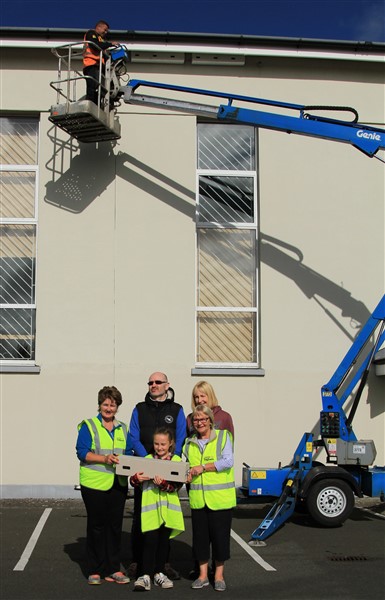
Photograph © Noel Clare
|
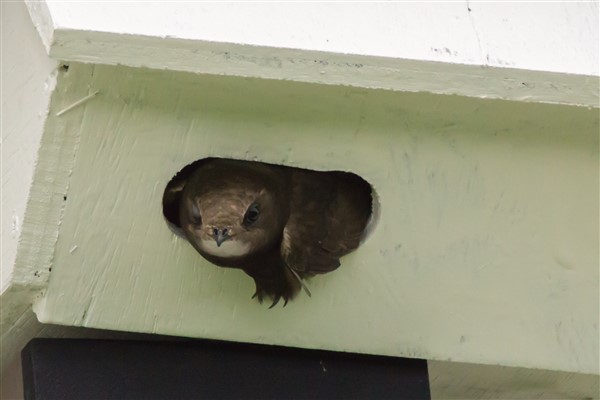
Photograph © Gerry Condron
|
We
at Wild Kildare feel that it is far more important to save existing
nest sites. We discovered that May Wall and Eileen Doyle between them
had eight Swift nests in the front of their dwellings. These two houses
hold one third of the nesting pairs in Castledermot. Wild Kildare was
told that the whole block was due for renovation. We approached both
ladies and they kindly agreed to not block up the nests. Wild Kildare
worked with the contractor and every nest was saved. An excellent
result!
This
year also Wild Kildare with the help of the Council Heritage Officer
got a clause written into the new County Development Plan GI25 . If a
new planning application for a suitable public building such as a new
school is submitted to the council we trigger the clause asking them to
incorporate Swift bricks or boxes. So far of the three proposed
buildings that we deemed suitable, two have agreed.
If you fast forward
one hundred years these are the type of sites Swifts will be nesting on
in Co Kildare, hopefully safeguarding their future for generations to
come."
A brilliant effort all round!
|
|
Aldeburgh gets going for its Swifts!
Alan and Christine Collett have written to us with some great news from
Aldeburgh in Suffolk, famous home of the Snape Maltings Music Festival
and the composer Benjamin Britten, and soon to become famous for its
Swifts, we hope.
"Concerned at the local decline in Swift numbers, my wife
Christine and I started an awareness campaign here in Aldeburgh, Suffolk
back in May. Little did we know that within a couple of weeks we’d be
called upon to rescue our first Swift, which, with a little help from
local bird ringing expert Mike Swindells, was safely released after an
overnight rest.
Over
the summer we held stalls on the High Street, had flags up around the
town and put mini flags in many of the shops and public buildings to
advertise the need to take action now. No-one could have missed our
Swiftmobile ‘float' in the town Carnival either! We have had a
fantastic response from residents wishing to put up nest boxes and
having set ourselves a target of 50 boxes by next May, we are already
well on the way to achieving this.
To read our story so far, go to our website aldeburghsamazingswifts.co.uk "
This is the way to do it! Strong, attractive, persuasive local action
with that all-important fun element added. That's what works. Try it
and see!
|

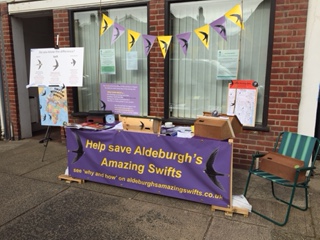
Photographs © Alan & Christine Collett
|
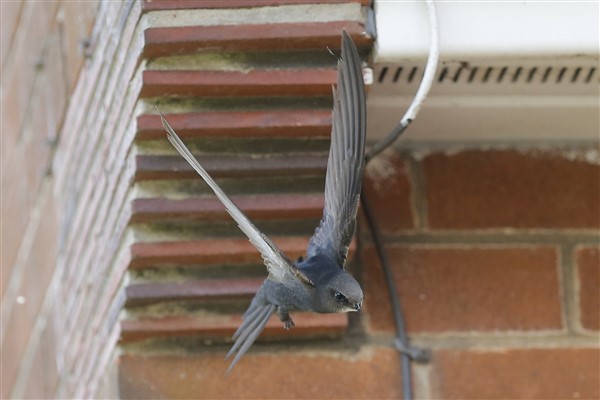
Our Swifts are now officially endangered. To put this into context,
here are a few more of the current assessments for other once
common species:
Vulnerable: Starling, Cuckoo, House Martin, Nightingale
Near Threatened: Corn Bunting, Collared Dove
Endangered: Willow Tit, Greenfinch, Lesser Spotted Woodpecker
Critical: Turtle Dove
|
UK Swifts: Now officially "Endangered"
Depressing
but hardly unexpected news, the September 2017 edition of "British
Birds" in an article titled "The risk of extinction for birds in Great
Britain", using
the standard IUCN Red List criteria, rates the Swift in the UK as
"endangered".
The emphasis of the IUCN Red List approach is on extinction risk,
informed by species' rarity, range restrictions and rate of recent
decline (measured over the last ten years or three generations,
whichever is longer).
Clearly a lot more needs to be done to keep our wild bird populations. We
need to keep up the pressure on the media, on NGO decision-makers, local government administrators,
politicians and civil servants, and of course do even more ourselves to
prevent the dying-off of our wildlife and the sterilisation of our world.
Easy actions you can take: buy and put up a Swift nest box or even
better two. Write to your MP, MEP and local councillors, get an article
into your local paper, start off a campaign on social media.
Photograph © David Naylor
|
Our 3rd Year at Bird Fair!
On the long weekend of August 18, 19 & 20 we were back at Bird Fair with our own stand, shared with fellow Swift activists Action for Swifts and local advice service Swifts Local Network for the third year running. We featured our new Swift Column on the stand, and it attracted a lot of interest (see our Shopping Page for more information on this).
Hundreds of people visited our stand in Marquee 8, and it was a great
pleasure to meet them all and see just how interested they all were in
helping Swifts!
Volunteers from all three groups plus Hampshire Ornithological Society,
and also John Stimpson the Swift nest box maker, attended to ensure that
there was plentiful advice to hand.
John Stimpson has made to date almost 11,000 Swift nest boxes, you can see the models and their details here. Scroll down the Shopping page to find the boxes.
Sales of Swift nest boxes and
sound systems were very good, ensuring that Swifts returning to the UK
next year will find more places to breed, and that we can all afford to
have a stand again at the 2018 Bird Fair.
We hope to see you there!
|
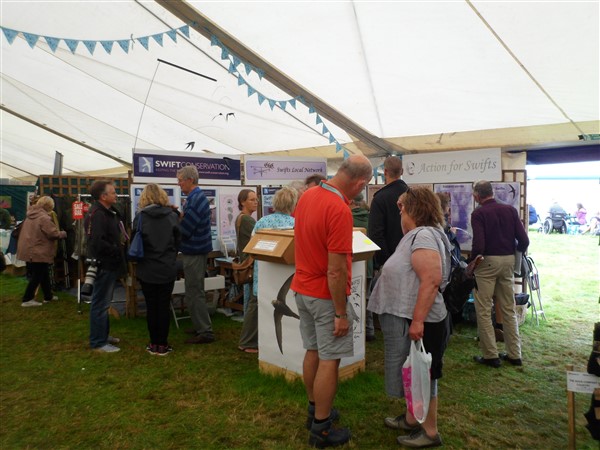
Photograph © Edward Mayer
|
More Swifts for Essex
On
the right is the latest Swift project of the Essex Birdwatching Society
(EBS) Swifts team, working with the Essex Wildlife Trust. Essex is a
good place for Swifts, with livestock farming, a lengthy coastline with
many inlets and salt-marshes, excellent nature reserves, many rivers
and some large reservoirs, all providing good supplies of flying insect
food. Yet much of the new housing and building development in this busy
county has been effectively Swift-proof, denying them any chance of
finding nest-places.
Six Swift nest boxes and a Swift call device have just been set up
under the eaves of the Maddison building at Writtle University
College.
John Smart of the EBS, and Alan Roscoe, Senior Lecturer at the College
oversaw the installation, with copious assistance from Peter, of the
college maintenance team, and Gerry, chairman of the EBS who together
rode the cherry-picker to fix the boxes.
The call system works with one "tweeter" loudspeaker in one of the nest
boxes, the recommended position for it, and the call equipment operated
from a timer in the room behind the window you can see in the photo on
the right.
With a bit of luck Swifts may be nesting at Writtle College in 2018 or 2019!
|
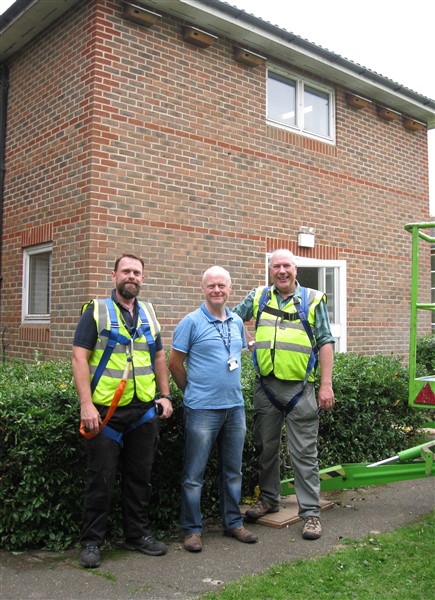
Photograph © Essex Birdwatching Society
|

Designed
for the modern urban and industrial environment, the Habi Sabi / Swift
Conservation Swift & Bat Column is
robust, long lasting, low-profile, automatic in operation, and easy to install.
|
A New Swift Column
On
the left is an artist's impression of two of our new Swift & Bat
Columns at the Velodrome at the London 2012 Olympics site. Designed by
award-winning 51% Architects from a concept by Edward Mayer, head of
Swift Conservation, with financial support from the RSPB, these towers
provide a high-quality, long-lasting product, that
can be erected with ease.
Intended to mimic tree-hole nest sites used by some Swifts in Scotland,
Scandinavia and Poland, these columns are intended to
merge into the modern urban and industrial environment
with its plentiful street lighting poles, mobile-phone masts,
road signs and CCTV columns.
The columns are fitted with
automatic Swift call players to attract the birds to the 8
internal nest places. Ample roosting space for small Bats is provided
in the base of the Swift nesting area.
For more information please contact Matt at 51% Architecture, 1a Cobham Mews, London NW1 9SB tel:0044 (0) 2033 551205
info@51architecture.com
|
We visit Seville & Mérida
In May we were invited to visit Southern Spain, Seville, Mérida, Alange
& Cacerès, to advise on problems concerning the use or renovation
of buildings, & infrastructure like bridges, holding Swift &
Hirundine nest sites.
Accompanied by an impressive array of Swift experts from Belgium and
Switzerland, we were taken to key Swift and Hirundine sites in all
these towns, shown the problems, and our advice considered and
discussed.
Meetings had been
organised with the Mayors of Seville and Alange, with the Biodiversity
Officers for Mérida and Cacerès, with journalists, and with local wildlife vets and
enthusiasts, so that we could put the case for municipal & public
support for these species, we hope with some success.
We met brilliant people, saw marvelous sights, had splendid meals, had a great time, and
we hope, managed to do a bit to save these vulnerable populations,
maybe even to change minds about their value to human communities, via
health and tourism benefits.
Our grateful thanks go out to Jésus Solana, who masterminded &
managed the entire trip, and escorted us everywhere, to Elena Moreno
Portillo, who arranged everything for us in Seville, and to Carolina
Climent Villegas, for her kind hospitality at her cosy B & B in
Alange (with Black Wheatears in the back garden!)
If you would like to follow in our footsteps, see these beautiful
places and their Swifts (and lots of other great birds too), just get in touch!
|
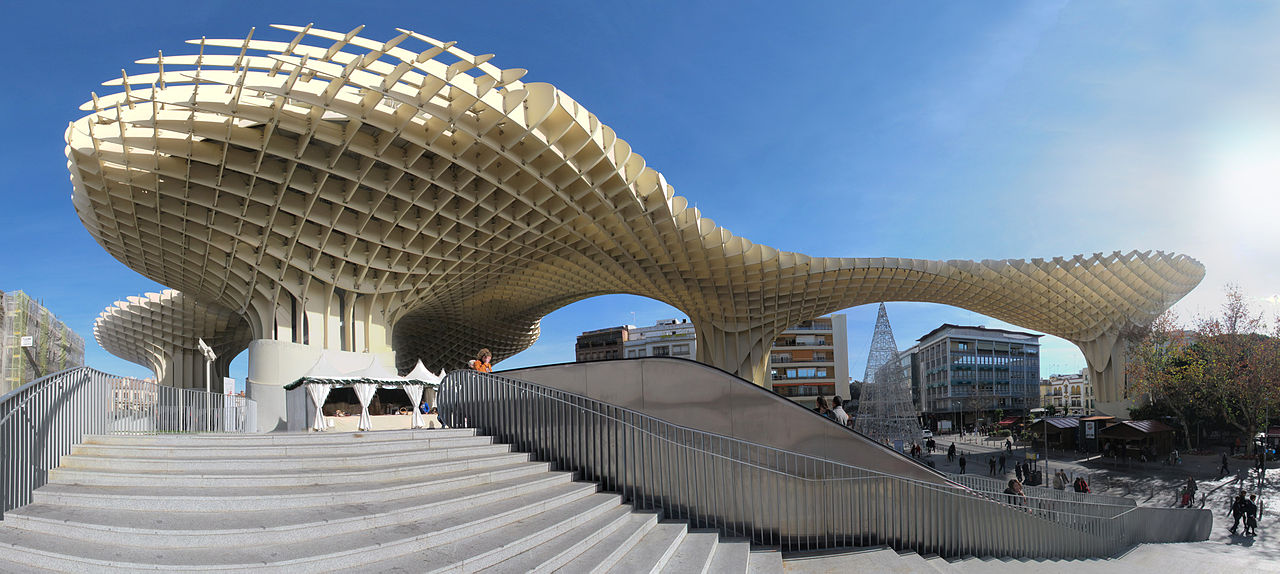
This is home to 100's of Seville's Pallid Swifts!
The Metropol Parasol is a spectacular & vast wooden structure
located at La Encarnación square, in an old quarter of Seville. It was
designed by the German architect Jürgen Mayer & completed in April
2011. Soon after it was taken over by Pallid Swifts, who nest in
profusion in the joints.
Experiencing the sight and sound of these birds at dusk on a Summer's
evening is just magical - you could head there in 2018 for a
brilliant time!
Two species of Swift, Common and Pallid, nest in Seville, including in the lovely
courtyards of the Alcazar. They can be seen together with Lesser
Kestrels over the Cathedral, feeding by night in the floodlighting.
Photograph courtesy of Wikipedia
|
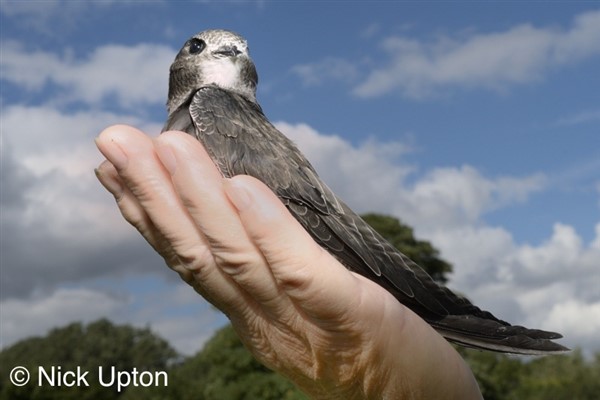
A rescued Swift contemplating the skies before its first take off. It
will head straight for Africa, and the Congo where it will spend most of
the Winter. It will migrate alone, or with a few other Swifts, but how
it knows how to get to Africa, and back again, is still a complete
mystery to
us. Photographs © Nick Upton
|
Swift Care in Action
One of the unique features of the "Swift World" is the network of highly-skilled & dedicated specialists
across the UK and Europe who care for rescued Swifts.
Swifts need specialised care; they must eat only insects or else
they will eventually die from feather malformation, & they need extremely
careful feeding & very high standards of hygiene if they are to thrive.
One of these specialists is Judith Wakelam of Worlington, shown here
feeding a fine young chick well on its way to its first flight.
|
Swifts over Tuscany
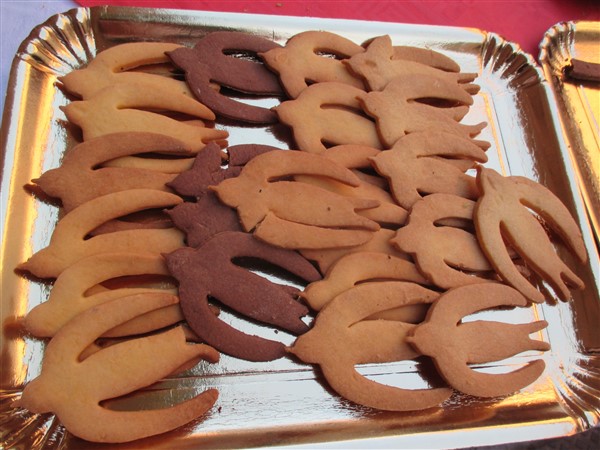 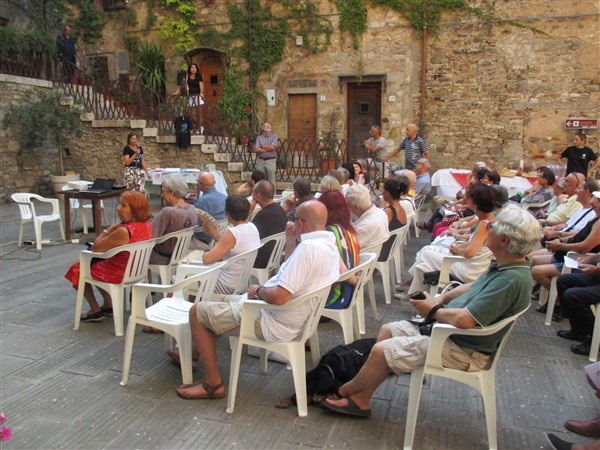
Uniting the initiatives of the "Festival dei Rondoni" and "Swifts and Fun
2017", Giuseppe Bogliani, ornithologist and Professor of Zoology at the
University of Pavia, gives a talk
on Swifts in Campiglia Marittima in Tuscany on 24th June last.
Photographs © Eugenia Parisi
A
few kilometres inland from the Tyrrhenian seashore, the medieval
village of Campiglia Marittima is still a favorite nesting site for
Swifts: old stone walls and traditional roofs encourage the annual
return of a large Swift colony. Local residents have realised that this
colony depends entirely on nest places being kept available for them in
the ancient
buildings, something that repairs and renovation can easily overlook,
so they have got together to create awareness, tell people about their
Swifts, and also, most important, have a bit of fun!
The biscuits were specially made for the event and are called "The Sweet Swifts of Campiglia".
|
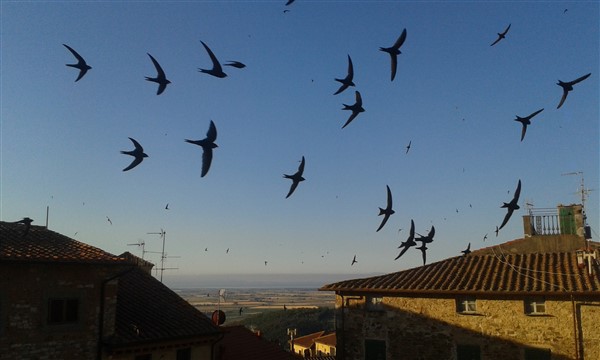
Swifts fly-past over Campiglia Marittima - flimed with a mobile 'phone!
See more on this facebook page
Photograph © Eugenia Parisi
To celebrate the Swifts and their presence in Campiglia a special
evening event was organized jointly by newly-formed Rondoni Campigliesi
/ Swifts of Campiglia, and Ente Valorizzazione Campiglia.
They held a
meeting in the main square, and afterwards there was food and drink for
all, together with concentrated Swift watching until dusk! It formed
part of nation-wide Italian Swift Evenings and Events, called
the "Festival dei Rondoni - Swifts & Fun", taking place usually in the second half of June,
when the Swift presence is at its peak, and with more towns joining up each year.
|
Swifts
go Woolly in Walthamstow!

Walthamstow
Primary Academy's contribution to the 1000 Swifts
Project
Photo
© Waltham Forest Echo
The
most amazing things have been happening with
Swifts in Walthamstow, NE London! Walthamstow
Wetlands is a new nature reserve, open to the
public, made from the lovely old Walthamstow
Reservoirs, an area of luscious watery calm
and liquid vistas in a predominantly Victorian
urban area. To get people thinking about the
possibilities for enriching everyone's lives
that the new reserve offers, the textile artist,
Deidre Nelson, set up knitting groups who together
made, under the umbrella of an "Urban Swifts"
campaign, 1000 Swifts, knitted or else made
from recycled materials. Something like 3000
local people have now been involved in this
amazing campaign, which has seen hand-made Swifts
set up in and around people's homes in Walthamstow,
with a flock of knitted Swifts enlivening the
indoor sky of the Wetlands Centre in time for
its opening in June. |
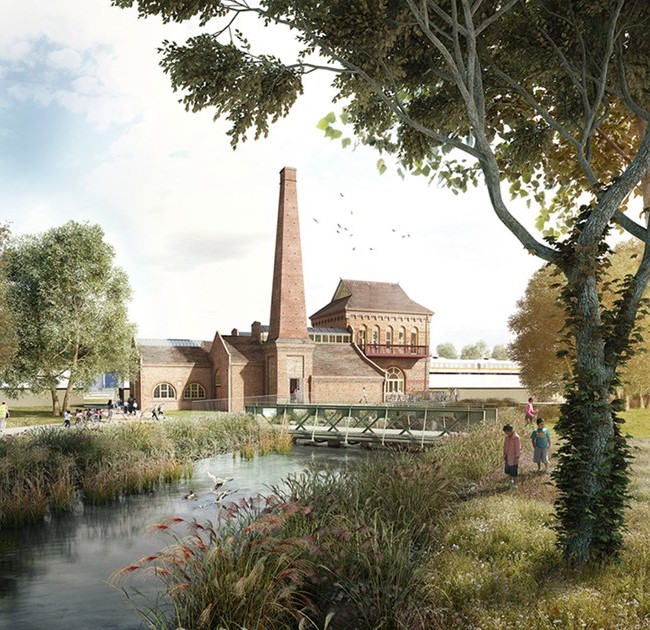
The
old Pumping Station chimney has been rebuilt
with
plentiful accommodation for Swifts and Bats
Artist's
impression © London Wildife Trust
Focal
point for the new Reserve will be the spectacular
rebuilt chimney of the old pumping station, now
recreated with plentiful accommodation for Swifts
and bats too! We advised on this aspect of the project,
and are keeping our fingers crossed that Swifts will
move in soon! The area is perfect for them, with
plentiful insect food emerging from the waters of
the reservoir in the form of Mayflies and similar
species.
Click here
to go to the Walthamstow Wetlands web site for more
info
|
New!
Abbotts Hall, Essex Swift Project

The Essex
Birdwatching Society, the Essex Wildlife Trust and John Smart have formed a
partnership to create more nestplaces for Swifts in Essex.
Working with
Andrew
Impey, the new CEO of the Trust, (who previously worked on Swift migration in
Southern Africa for the RSPB and who very kindly
arranged funding for the project) Lisa Smart,
the Trust's Operations Manager and Emma Ormond its Living
Landscape Coordinator, a site was chosen on an agricultural barn at the Trust's
Abbott's Hall reserve.
The Trust's maintenance
team (David, Bones, Brian and the tractor driver Mark)
swiftly fitted all the John Stimpson-type boxes
as well as the Swift call sound system on 15
May.
We are hoping that this is just
the first of many such projects that will be
created in Essex by this team. The County can
be a brilliant place for Swifts, this sort of
project should keep it that way. |

The
new Swift Nestplace Project at the Essex
Wildlife Trust’s Head Office at Abbotts Hall, near Abberton reservoir, a feeding
area for many thousands of Swifts
Photographs
© John Smart |
They're
back!!!
The long wait is over! On 5th May, we received reports
of Swifts over Walthamstow in North
East London, and Harleston
in South Norfolk in East Anglia where community group Harleston's
Future/Swift Action are flying their flag of welcome (see right).
Today, 6th May, we
received reports of Swifts over
Dulwich in
South London, (see two nestbox photos below
right), and most exciting of all, our own Swifts
returned over West Hampstead, screaming over
the local gardens just before 11am!
In
fact Swifts arrived back on the same day,
5th May, as far apart in
Shepreth in Hertfordshire and in Askrigg in
Scotland!
We
had heard earlier of hundreds of Swifts seen
feeding low over the trees in Epping Forest,
over the past weekend.
This is a typical
strategy for migrating Swifts; they may head
for their nest areas, but as these are still too
cold and wet to support many flying insects, Swift's
only source of nourishment, they
spend their time gathering their aerial food where the richest sources
of flying insects can be found, hatching
from fresh water ponds, flooded gravel pits
and reservoirs, or flying just above the canopies
of forest and woodland.
It's not too
late to set up your nestboxes and Swift calls
systems for 2017. Give Swifts a home and keep
them flying above us for ever and ever after!
Check out our web site for all the information
you will need, on nestboxes, where to site them,
how to make or buy them.
Any questions?
Contact us by e-mail here
|

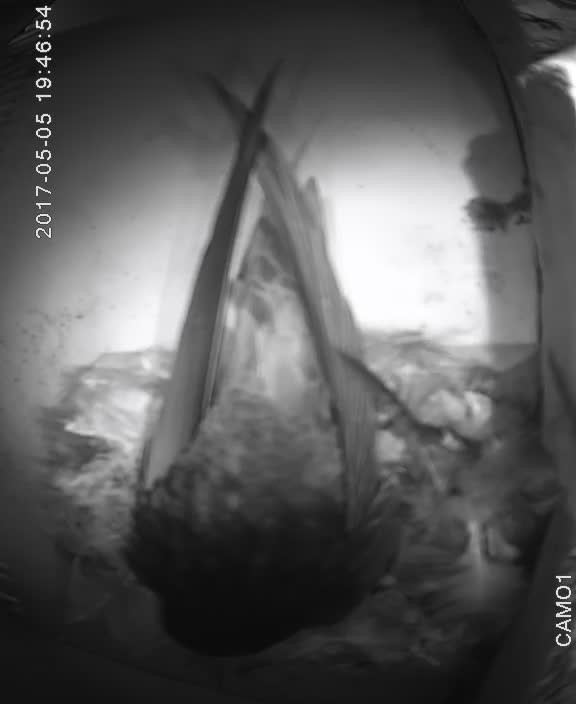 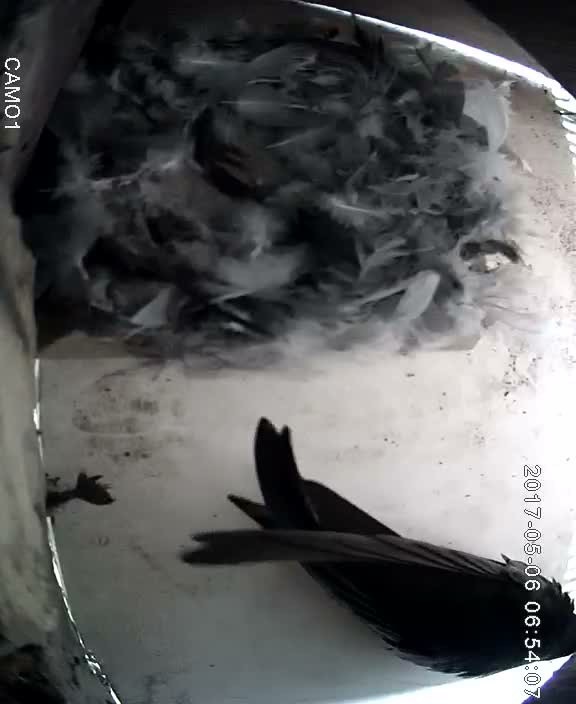
Photographs
© Ian Carstairs & Steven Robinson
|
|

The
Ospedale Vecchio, above, and on the right some of
the temporary nestboxes, and far right, an historic scaffold
pole hole, left in the facade to enable rapid cost-effective re-scaffolding
with timber scaffolds, but now adapted to house
only Swifts, and not the feral pigeons that were
taking over the site to the detriment of the Swifts
and other small birds.
Italy has suffered outbreaks
of three newly introduced mosquito-borne diseases
in recent years, and is promoting support of urban
insect-eating birds, like Swifts and Swallows, as
one way of keeping control of these insect populations.
|
Parma
helps its Swifts
The
historic Ospedale Vecchio (Old Hospital) in
Parma, Italy, is home to many Swifts. To preserve
the colony during renovation work the Municipality
at the behest of local ornithologist Franco
Roscelli consulted Francesco Mezzatesta, the Swift expert
from Elba.
He advised them to set up
temporary Swift nestboxes on the metal
scaffolding during the works, and to reinstate
the old wooden scaffold pole holes that had
been used by the Swifts for nesting. City Planning
Commissioner Michele
Alinovi supported the initiative, which was
put into practice by Architect Tiziano Magri,
surveyor Marco Ferrari and site foreman
Giovanni Ciampa.
Scaffold
pole holes are a common feature of many old Mediterranean buildings,
but are often filled in to stop feral pigeons nesting. It is however
very easy to convert them for use by Swifts, excluding the problematic
pigeons.


Photographs
© Francesco Mezzatesta |
|
Essex
helps Swifts!
The Essex
Birdwatching Society and the Swift Representative for Essex (Chairman Gerry
Johnson and John Smart respectively) have recently embarked on a series of
Swift box projects at colleges and farms.
Shown below is a photograph of GJ
atop a cherry picker just about to install the eighth box on the north face of
a grain silo at a farm in Blackmore, not far from Chelmsford. The farm owner,
John Bucknell, was very keen to pursue the project and kindly funded the
operation. A call system has been installed with the tweeter within the box
second in from the right. John Bucknell is seen standing by the cherry picker.
Luckily, some very high winds during the earlier part of the day died down in
time to complete the project in the afternoon.
Although the EBwS is essentially
a recording society for the county’s birds, it has as you can see here a keen and active conservation
aspect to its remit. |
|
Italy's
"Save the Swallows" Campaign
We
have just heard from Italy that the "Save
the Swallows" resolution for the protection
of Swift, Swallow and House Martin nests has
now been adopted by 100 towns countrywide. Part
of the impetus comes from the fact that all
these birds eat copious amounts of mosquitos
and gnats, that otherwise would make life very
unpleasant indeed during the hot humid summers
of the peninsular.
This is a campaign that
we have been promoting during our work in Italy
for many years now, and with excellent local
support and activism it is taking off really
well. It started back in 1999, and a complete
list of the towns that sighed up to this resolution
can be had from the Lega Italiana Protezione
Uccelli at http://www.lipu.it/
or
you can write to LIPU's Head of Urban Ecology marco.dinetti@alice.it |
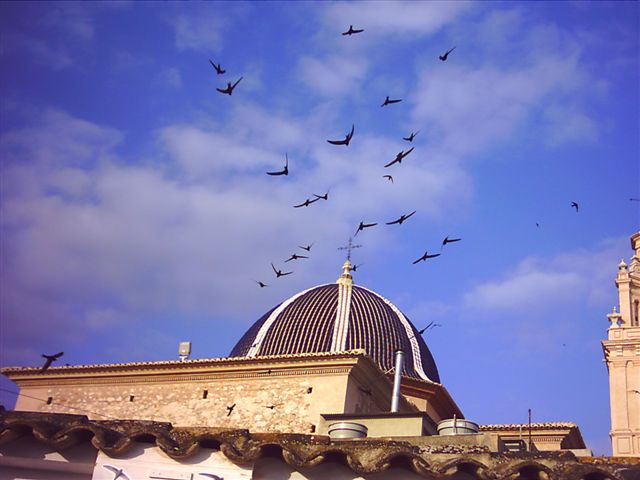
Swifts
fly like rockets over an ancient church - Photo
© Jorge Sanz
|
|
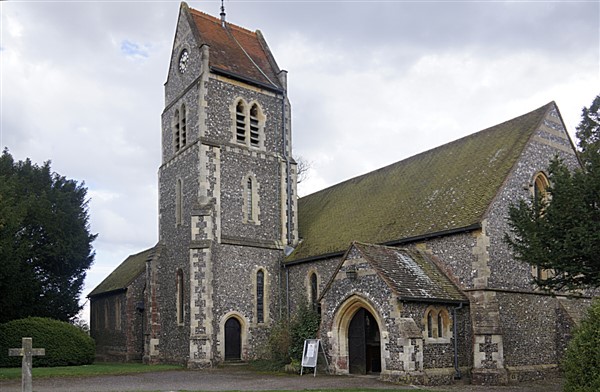
Holy
Trinity Church, Lane End, Buckinghamshire now hosts
eight Swift nest boxes in its belfry; see them in
close up on the right. A sound system to call the
Swifts in is being fitted soon. The project was
started by activist Tim Grout-Smith who wrote an
article in the local magazine asking for volunteers
to build boxes - eight responded! With the aid of
a generous grant from the Buckinghamshire Bird Club
the project was brought to fruition. There had been
Swifts in the local methodist Chapel until it was
sold and converted - this project aims to get them
back into the village. Photos
© Mel Davies
|
New
Swifts for Lane End, Bucks?
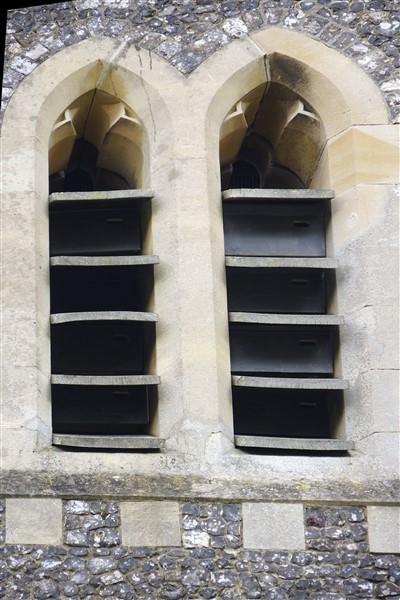
|
Swift
Farewells!
Most
of the UK's Swifts were leaving our shores during July and August, (with some
huge numbers passing the observatory at Spurn!)
but some went much later. Dick Newell of "Action
for Swifts" reports that one of his nestboxes
held a single adult left alone with one chick until they
both fledged on the evening of 22 September,
a touching moment!
You can still see a few Swifts heading
South / South East down the UK. These will be
birds from Scandinavia, the Baltic and Russia,
that start, and finish, their breeding rather
later than ours do.
Singer songwriter Maggie Groom wrote and performed "Swifts: Harleston's Farewell" to wish them well on their journeys.
The
lovely song is backed-up by video images of more than 400 cut out
paper Swifts designed in the colours of African Flags by Harleston Primary
School pupils (seen on the right) which were turned into many decorative flags and displayed
throughout the town and in the Church.
You can hear the song on
You-Tube here: https://youtu.be/Vziv6yDDZA4 |

|
|
Rutland
Water BirdFair
2016 - great!
This
August, Swift Conservation got together again with Action
for Swifts and the Swifts Local Network to run a
stand; we also gave a talk at the prestigious Rutland
Water BirdFair.
And we won Second Prize
for the best Conservation-themed stand!
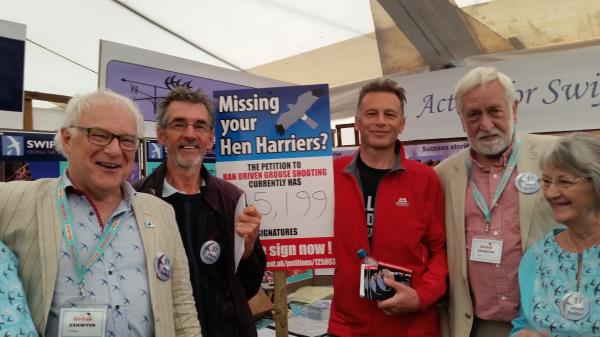
 Chris
Packham graced our stand and had a good look at
our work for Swifts, including an exciting new project
in Harleston, new integral and wall-mounted nest
boxes and the famous Cheng-Sheng Swift call system. Chris
Packham graced our stand and had a good look at
our work for Swifts, including an exciting new project
in Harleston, new integral and wall-mounted nest
boxes and the famous Cheng-Sheng Swift call system.
Above we
see right to left: Judith Wakelam and Dick
Newell of Action for Swifts, Chris Packham, Chris
Mason of Oxford Swifts and Edward Mayer of Swift
Conservation. On the left, our prize certificate!
Enthusiasts
from Action for Swifts, Swifts Local Network, Swift
Conservation, Hampshire Swifts and beyond all helped staff
the stand and inspire our many visitors.
Photos
© Louise Bentley and Edward Mayer
|
What
a show!
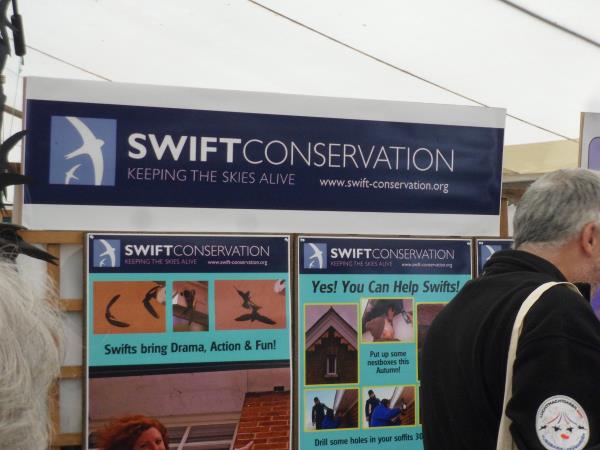
This
was our third year at Bird Fair, our second running
a stand with Action for Swifts and Swifts Local
Network. On sale were new nestboxes, the heat and
rain-resistant Model 30 from John Stimpson
(available in a self assembly flatpack) and being
demonstrated was the new Swift Brick from Manthorpe
Building products (see item below). .
This
year, like the last, the Swift Conservation talk "Yes! You can help
Swifts!" in the Reserve
Centre was standing room only, (at 9-30am on the
first day! OK, it was raining...) and hundreds of leaflets
went on their way. With all this effort, and the
great response we had, we hope that when the Swifts
come back to us next year more of them will find
new homes, rather than the blocked up eaves and
gables that re-roofing, insulation and rebuilding
have caused them to be greeted with in so many past
years.
Photos
© Judith Wakelam & Dick Newell
|
|
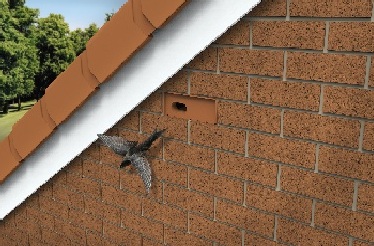
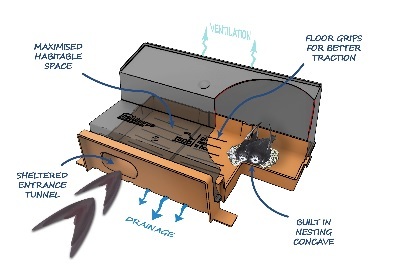
The
Manthorpe Swift brick comes in several different
colours to match various brick clays. Easy to fit,
it provides a suitable nest space for Swifts at
a very low price - the cheapest such product on
sale in the UK. All
pictures © Manthorpe Building Products |

New
UK-made Swift Brick on sale!
A
new UK manufactured "Swift Brick" has
been designed and is on sale for about £15. This
makes it the most cost-effective such item on sale, as far as we know, and a potential
market leader.
The Manthorpe Swift Brick was promoted by
a major house builder and the RSPB, inspired by work done by Dick Newell of
Action for Swifts, providing a safe,
habitable area for Swifts to nest within the walls of modern houses.
This new and innovatory design -
- Takes the place of a single brick
Coloured faces blend in
with surrounding brickwork
Neat, simple to install, can be fitted quickly during bricklaying
Integral nest concave provides ideal point for nest building
29 x 65 mm opening leads into the
entry tunnel
413
cm2 floor gives maximum habitable living space within the wall
A built-in cavity tray protects against water ingress
Nest
area has integral drainage to keep
it dry
The Manthorpe Swift Brick
could change the future for UK Swifts - So start
installing them at a rate of two to every second
home you build, and 10 to 20 in groups of four or
five for a School, Hospital, Factory, Warehouse
or Shopping Mall. This should help redress the immense
loss of nest places suffered during the past 50
years, and get Swifts back in our skies again!
|
|
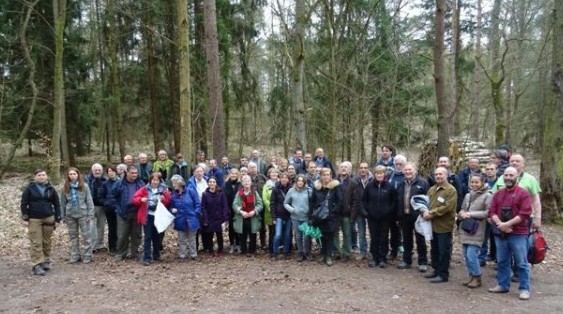
Off
to the woods - some of the delegates head out for
professionally-guided local birdwatching in the Puszcza Bukowa. Photographs
© Zofia Brzozowska
The
4th International Swift Conference was held in
Szczecin this April. Adjudged a great success by
all who went, the four day event provided an ideal forum for intense
and detailed discussion of the many issues arising
from the efforts across Europe, Russia, the Middle
East and NE Asia to retain
and if possible restore dwindling populations of
Swifts.
As well a sharing many ideas and
learning new strategies for conservation, delegates
enjoyed excellent facilities, food and hospitality
at the Hotel Nord in Szczecin, and also participated
in a high-interest local birdwatching trip on the
final day, before leaving for home.
Great
credit is due to the local organisers of this
conference, Zofia Brzozowska and her dedicated team,
for making the arrangements that brought this ground-breaking
event to a very successful conclusion.
For
further information and abstracts please contact
Zofia here
|
The 4th
International Swift
Conference held in Szczecin, Poland, April 2016
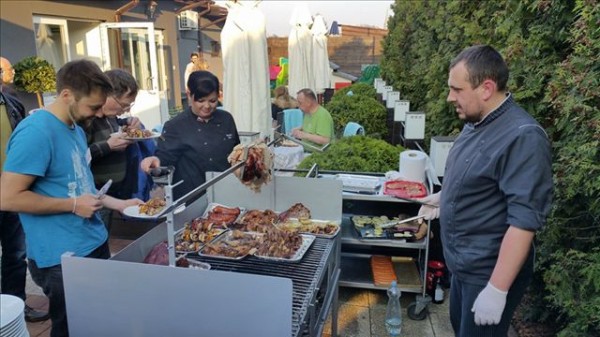
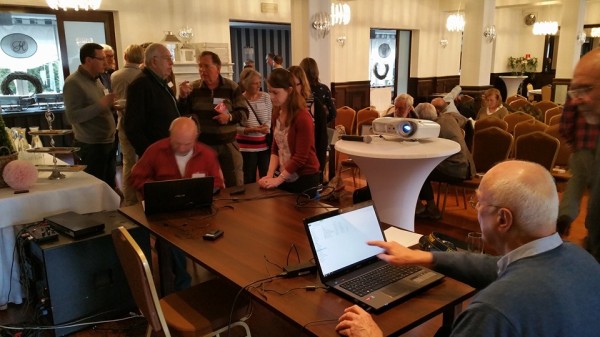
Don't
miss the next International
Swift Conference
in Tel Aviv, Israel in Spring 2018
For more
information click here
|
|
Harleston Norfolk welcomes its Swifts
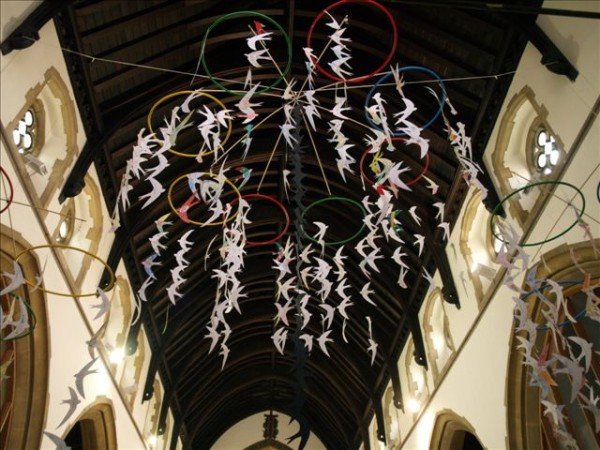
The
historic market town of Harleston, Norfolk, UK which
recently launched its Swift Action Harleston to
improve the fortunes of the town's Swifts.
Harleston, has
just held its Swift welcoming ceremony, helped on
its way by a talk from us at Swift Conservation.
Children
from local schools made flags and paper cut-outs
and decorated the streets and the church (right
and above) to let everyone know that the Swifts
were on their way, and to illustrate the African
countries where they over-winter by showing their
flags. Organisers of the
project say that caring for the Swifts is to care for the wider
community, and will involve all ages and abilities and will contribute to the social
and economic well-being of the town.
The
project has three objectives: to record and look after existing nest sites, create as many new sites as possible and help everyone build biodiversity within the town.
|
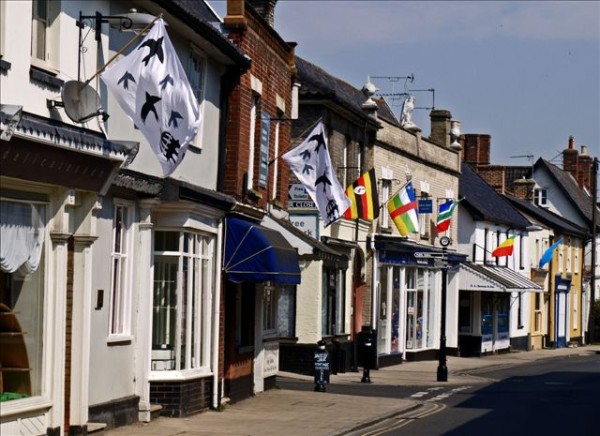
Flags
of Swifts & the African countries where Swifts over-winter
welcome them back to Harleston, which still has
lots of places
for Swifts to nest in
Photos
© Ian Carstairs
|
|
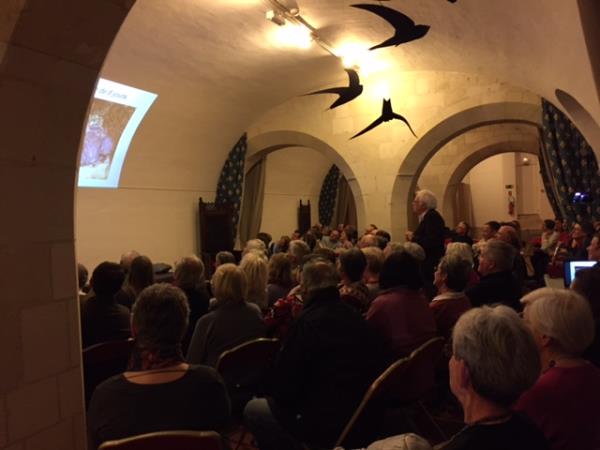
Edward
talks with Swifts overhead! It's a mobile - you can make one too!
Photo
© Carolyn Knowlman
|
Amboise
Swifts Club gets going!
Deep
in the dungeons of Amboise Castle, on the River
Loire in France, Swift Conservation does its bit
to get a new Swift support club going. Amboise and
other historic towns along the Loire and Cher rivers
are still rich in Swifts, Swallows and Martins too.
But the pace of restoration and urban renewal is
strong, and these building-dependent birds are losing
out in the search for nestplaces.
That is
where concerned local residents Carolyn, Tim and
Gismonde come in. They set up a local
Swift evening, with Marcel Jacquat, the Swiss Swift
expert, and his UK colleague Edward Mayer to enthuse
Amboise's many residents interested in birds and
the environment, and try and get them to help their
Swifts.
Next: Amboise Swift &
Bat walks at the beginning of July! We'll be
helping people find, admire and count Swifts and
Bats on an extended evening stroll, taking in a
few cooling drinks en route!
|
|
Swift
Boxes
move to Petty France
A
few years back we worked with the Metropolitan Police
on the installation of Swift nest boxes, 20 in all,
at New Scotland Yard and a selection of their sites
around London.
With the forthcoming sale
and demolition of New Scotland Yard the
nest boxes there had to be re-sited. So we arranged
with Dr Phil Thomas, Ecology Manager at the Ministry
of Justice (MoJ), for them to be found a new home
nearby on top of the roof of their offices at Petty
France, right next to St James Park, an ideal location.
A hand-over
ceremony for the nest boxes was held on the roof
of the MoJ on 5th November. Right to left: Dr Phil
Thomas from MoJ, Metropolitan Police Assistant Commissioner
Martin Hewitt, Sarah Foster, Recycling Officer for
the Metropolitan Police, and Edward Mayer of Swift
Conservation.
Don't worry! The nest boxes
are being fixed well above the anti-gull netting
you can see in the photo. It's not that MoJ don't
like gulls, it's that the gulls pick
up and drop those pebbles onto the glass roof below!
|

Photo
© Metropolitan Police London
|
|
Slovak Swift Conference Success
Our
contact in Slovakia Dr. Lubomira Vavrová, writes
about the recent LIFE Project conference held in Zilina
in Slovakia:
"I am happy to tell you that our
project's conference was very successful. We had 80 participants, mostly
from regional environmental bureaus, and also nature conservation
professionals, NGOs and a few construction companies.
Our new documentary, which
shows practical and simple ways to preserve
Swift nesting populations in buildings undergoing
insulation and refurbishment works, was presented and was received very positively.
We have already had some requests to present it in schools".
For
more information and / or to participate with
the schools exhibitions, showing the documentary
(an English translation is available) or with
any other aspect please send an e-mail. To do
so click HERE |
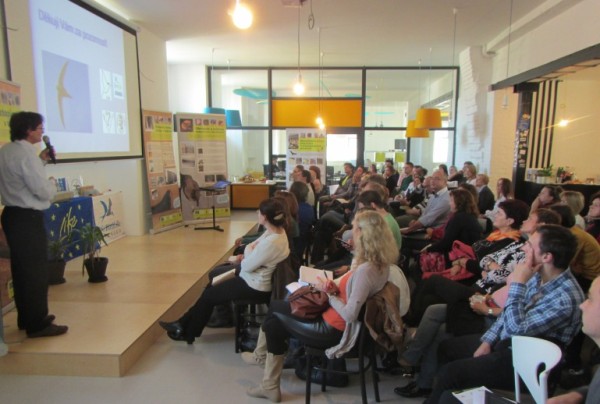
Photo
© Mgr. Lubomíra Vavrová, PhD
Here
is a photograph from the event; you can see Lukas Viktora of
the Czech Society for Ornithology, (one of the
star lecturers at the 2014 Cambridge Swift conference),
presenting his session. You can see also the pull-up
posters
that are going to be used for the LIFE Project's mobile exhibition.
|
|
Belfast
gets a Swift Tower too...
After
Warsaw and Exeter, Belfast too has put up a Swift
tower, one of the increasingly popular pattern
designed by Menthol Architects of Dublin and Warsaw,
and incorporating nest boxes built from information
provided by Swift Conservation and Action for Swifts,
and using a solar powered call system to attract
Swifts in to breed.
The tower is at the Window
on Wildlife (WOW) site on Belfast Lough, a
new reserve enshrining a brilliant area for saltmarsh
and marine species. You can find out more at these
links:
http://visit-belfast.com/things-to-do/member/belfasts-window-on-wildlife http://www.rspb.org.uk/discoverandenjoynature/seenature/reserves/guide/b/belfastlough/about.aspx
The
Belfast WOW project was made possible with funding from the
European Regional Development Fund administered by the Northern Ireland
Tourist Board, the Heritage Lottery Fund, Belfast Harbour Commission and
the Alpha Programme administered by Groundwork NI.
Call
the reserve directly on 028 9046 1458 for visitor information.
|

Photo
© RSPB Northern Ireland
|
|
Luxury
and Beauty for Vauxhall's Swifts in Tyers
Street

Swifts
will be able to nest in the nine nestbricks hidden
within the amazing intaglio sculpture of five flying
Swifts featured on the wall of this modern apartment
block. Buy a flat there and have Swifts grace the
skies and enliven your days all Summer long. What
a change from looking at the I-Phone and watching
Strictly Come Dancing. Life-enhancing - just do
it!
|

Jeremy
Wingate-Saul developed and built this unique property
in Tyers Street, Vauxhall, London.
After
consultation with Swift Conservation, the
result has been this magnificent installation of
nine Swift bricks hidden within a delightful intaglio
sculpture showing five Swifts in flight. 
What
a
stunner, I hope you will agree! And what an advertisement
for hosting Swifts in Central London properties.
Just
what's needed. Let's hope it starts a trend! For
more info please contact Jeremy
Wingate-Saul
direct via this link.
Photos
© Jeremy Wingate-Saul
|
|
Berwick's
Swift tower goes up
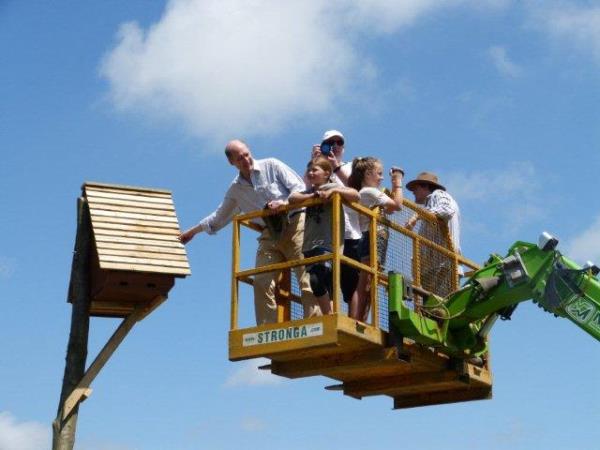
Down
in Sussex, Chris Powles has been equipping his solar
farm with bird and bat boxes. Latest to go up is
this Swift tower, an all-timber structure on a tall
pole, with plenty of places for not just Swifts,
but bats too. It has an integral MP3 system to play
Swift calls to lure them in and breed.
For
more information, please contact Chris
Powles via this link.
|
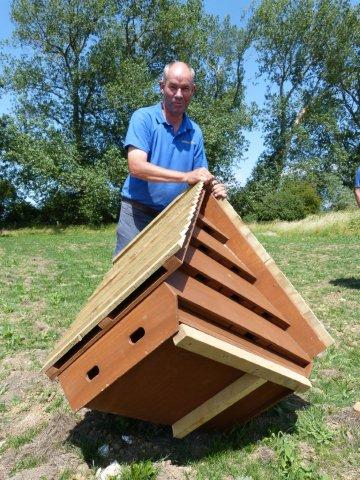
Photos
© Chris Powles
|
|
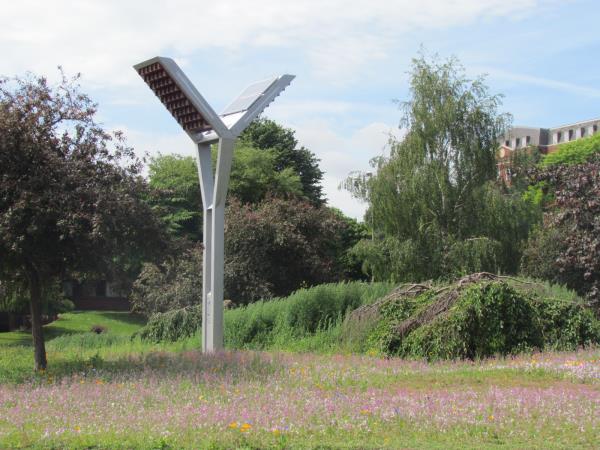
The tower
provides an excellent opportunity to publicise the plight of urban
birds. A hundred Swift nest
boxes have been installed in high rise
buildings neaby and also in Exeter's new Bus Station. Photo
© Emily Stallworthy - Devon Wildlife Trust
|
Swifts
get a new home in Exeter
Much determination
from Devon Wildlife Trust, Exeter City Council and the RSPB, plus developer
funding, has given the town a 90 nest
Swift Tower!
It has just been installed on a roundabout near the city centre along
with new wildflower sowing to benefit all pollinators too.
The
tower is a version of the Warsaw Swift Tower designed by Rafal Pieszko
of Menthol Architects, with solar panels to power Swifts' calls
played during the summer to attract new nesters. The
tower is perfectly located between residential areas known to hold
nests and the city centre where there are fewer opportunities to nest
but where screaming parties have been recorded.
The Tower was developed under the
Exeter Wild City
initiative, a partnership that seeks to help residents
enjoy and support urban wildlife. Advice and support were been
provided throughout the process
by Swift Conservation and Action for Swifts.
This project team
are grateful for the support throughout of Stephen Fitt, the South West RSPB's
Swift expert,
who has ensured that hundreds of bird nest bricks have been included
within new developments in the city as recommended
in the city’s
Residential Design Guide. |
|
At
Last! China's Swifts Reveal their Migration Routes
Last
year a joint Chinese-European team of Swift experts
and enthusasts fitted geo-loggers to 31 Swifts nesting
in ancient buildings in Beijing. This year they
went back to try and recover the geo-loggers.
This May the China Birdwatching Society and its volunteers
set up the nets at 2.30 am and, together
with visiting swift ringer Lyndon Kearsley from Belgium and Dick Newell of the
UK's Action for Swifts nest box project group, they
captured, processed and released more than 80 Swifts in 2 hours,
including downloading data from 13 birds with geolocators and fitting a
further 25 geolocators to ‘new’ birds. Liu Yang, one of China’s top ornithological academics,
travelled from Guangdong to participate in the ground-breaking project.
After processing the data they discovered that these
Swifts had travelled an
amazing 13,000km on their migration to spend the winter in
southern Africa. and another 13,000km to return to Beijing. They seemed to
have spent a good time over the Congo, as "our"
western Swifts do, and then moved on to Namibia
and South Africa for a further spell while ours
go over to Mozambique.
 See
the full story on Birding Beijing - and visit
Beijing too!
See
the full story on Birding Beijing - and visit
Beijing too!
|

The map above
from Beijing Birding's web site shows a typical track of a Beijing Swift, based on
preliminary analysis of the data from the 13 birds re-trapped so far in 2015. A
fuller analysis will be made in due course with a scientific paper
planned for later this year.
|
|
Sedburgh
People's Hall's gets Swift Bricks in its new extension

Photo
© Tanya Hoare / SCS |
Sedbergh Community
Swifts (SCS) has been successful in getting Swift nest bricks into the walls
of
the People’s Hall - the community building for the town of Sedbergh in Cumbria.
A new gym extension to the Hall was being built during the winter so they seized
the opportunity to get bricks installed.
After establishing that there was no technical
reason why the Swift
bricks could not be installed, they obtained agreement from the Peoples Hall
management. An important point was that Swifts are not
messy birds.
The building is of
blockwork with a rendered exterior, and it was important not
to compromise the insulation of the building. It was decided to use four
Schwegler bricks (Type 1A) in the gable end. Also included was the
facility to play Swift attraction calls, using the Cheng Sheng amplifier system.
There being
a number of Starlings in the area, they reduced the height of the
entrance holes to 27-28mm by smearing Isopon (a car body filler) on the upper
surface to reduce their height and obstruct the Starlings, but not the Swifts.
Swifts often fly over the
adjacent playing fields and a few nest in nearby buildings, so it is hoped it
will not take too long to attract them.
SCS would like to thank Edward Mayer of
Swift-Conservation for advice, and architects Garsdale Design
for their enthusiastic support. The project was
funded by a grant to SCS from the Yorkshire Dales National Park. |
|

Eight
of the sixteen new nestbox entrances
on the West side

The
four completed cabinets,
fuly installed and showing rear access
doors

Above:
The four completed cabinets, ready for installation
Photos
© Dick Newell / Action for Swifts
Above
right: St
Mary the Virgin St Neots. Photo © E
Mayer
|
More
nest boxes for St Mary's in St Neots - already
a proven success!
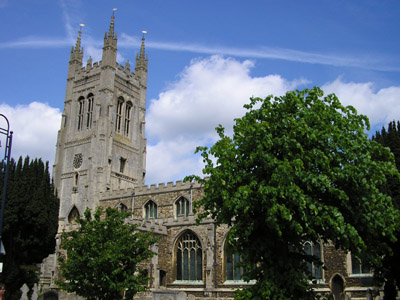
Dick
Newell of Action
for Swifts
who devised the project, and designed
and installed these nestboxes writes:
"In 2007, we installed 12 Swift boxes in the north side of the belfry of St Mary the Virgin, St Neots. Most
years, attraction calls have been played and in 2014, 9 of the 12 boxes
were occupied. With the help of generous funding from 'St Neots in Bloom' we have now added 32 more boxes, 16 in the east and 16 in the west.
It was quite a feat of engineering to erect boxes 15 feet
above the floor of the belfry but we thought that entrances here would be
more obvious to the Swifts compared to entrances behind the louvres.
We chose
stone coloured paint (Sandtex 'Mid Stone') to provide a better contrast for the
entrances. Whether this contributed to the success of the first 12 boxes
we cannot say, but it worked.
The original 2 cabinets contained 6 boxes each. This was done at a time
when we thought that Swifts required a larger space. Since then we have
discovered that Swifts readily accept smaller boxes, so we increased the
number of boxes to 8 per cabinet.
We would like to thank Alison
Pearson of St Neots in Bloom for their generous funding and
encouragement, and the Vicar, the Reverand Dr Paul Andrews, and the PCC for their
permission to do this project as well as Catherina Griffiths, David
Griffiths and George Bonham for their help with access to the church."
To
find out lots more please go to Action
for Swifts
|
|
Edinburgh
gets cracking for Swifts
Architects
and developers working in Edinburgh
have been responding to the local
authority's imaginative and groundbreaking
innitiative to support and restore
Swift populations in the city via
their Swift
Action Plan.
By
encouraging the installation of Swift nest places
in selected new
build projects when they seek
Planning Permission, Edinburgh is
working towards ensuring that its Swifts still have
places to breed in when they get
back from their long migration to
Central Africa.
Our
local Contact, John Wilson, has
very kindly sent us this photo
we show here, just one from several
very interesting new developments
that he has been documenting and
promoting.
|

Above:
Beaverbank Place and Logie Green Road, Edinburgh EH7, a development
including residential flats, some for student accommodation, completed
in 2011 and already of interest to the local Titmice - if they spot
this activity Swifts may soon follow their lead!
Photos
© John
S Wilson
|
|
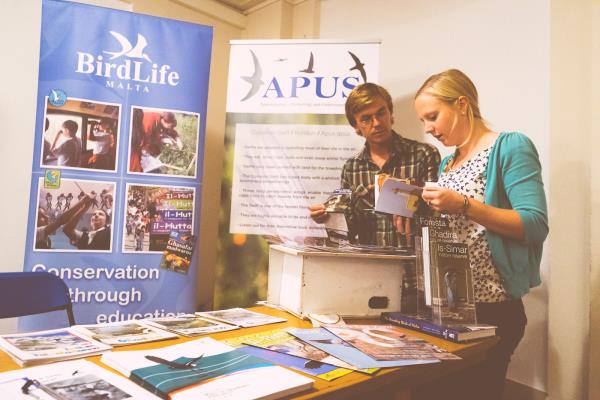
Hannah Chisholm,
BirdLife Malta's Education Manager, with Thomas Hendry, BirdLife Malta's assistant nature reserve warden,
setting the scene before
a workshop at an environment fair last November. Photo and information supplied
by Tim Micallef, APUS Project Coordinator
Photos
© Bird Life Malta
|
Maltese
Youth Project to Help Swifts


The
EUPA (European Union Programmes Agency) recently
granted funds for a Swift project proposed by BirdLife Malta’s youth section, Falko. Named APUS
(Appreciating, Protecting and Understanding Swifts), it aims to
encourage these birds to breed in greater numbers, especially in current
breeding localities and nearby areas, working with
birders, local councils & authorities and the general public (youth in
particular) to encourage and celebrate them.
This includes introducing Swift
nest boxes to schools and public buildings, also
celebrating the return of these birds to the Maltese islands through public events, education in schools and information
about them online, through publications and the media. Most activities are
to start from January 2015, while most of the research,
preparation and monitoring is ongoing and will be continued throughout the project.
Falko will encourage birders, volunteers and the public to
monitor the use of nest boxes, and will also encourage local councils to
organise Swift celebration events, along the lines of those run in Northern
Ireland, Israel and Italy.
Swift
Conservation wishes this project and
its volunteers the greatest possible
success.
|
|
Derby's
Swifts keep their nests
Nick
Brown of the Derbyshire Wildlife
Trust has sent us a good news story from Derby:
"Opposite is a photo I
took last summer of a Victorian factory (now a warehouse) on Dean Street
in downtown Derby. The photo shows about half the full length of the
building. The building
is surrounded by terraced housing. From locals I discovered
that some years ago they got together a petition asking the owner, who
was about to re-roof the building, to take care of the Swifts that
nested in it. The owner
agreed and had
the work done in such as way as to
ensure the Swifts could still gain access.
They do this by flying up behind the new white barge boarding which was
fixed away from the wall deliberately.
I saw at least 30 Swifts
flying over the building last summer and, standing in the back garden
from which I took the photo, I counted at least seven Swifts going in at
different points on the East side….and I could
only see half of the building.
Sadly the old guy who got
the petition together has since died but I met his widow and her
neighbours, all of whom really love their Swifts, as he did."
A
really nice ‘good news’ story…and all carried out with no recourse to any
nature protection organisation at all! Brilliant!
|

Above:
The factory on Dean Street in central
Derby where sympathetic re-roofing
has let the many Swifts nesting
there continue to use the site for
breeding. They enter the roof under
the white bargeboards, and probably
breed in nests built on top of the
brick walls just beneath the edges
of the tiling. Photo
© Nick
Brown DWT
|
|
Success!
Swifts check out the new Cambridge
Swift Tower!
Dick
Newell of "Action for Swifts"
has told us of the
signs of success seen last summer
at the highly
innovatory Cambridge Swift Tower.
Dick
tells us: "During July, one could stop by
the tower any time and there would always be between three and ten Swifts in
attendance. We did not succeed in proving that any Swifts roosted
overnight, though we did see Swifts entering or leaving 15 different
entrances, so fingers crossed for 2015."
 
|

Above: The Cambridge Swift Tower, an artwork created under the management of Guy Belcher of Cambridge City Council
using Section 106 Funding, evoking the setting African sun, and also
providing many homes for that part-time African bird, the Swift!
Left: two close-up photographs
showing Swifts entering and leaving
the nest boxes. Swifts will often
check out several prospective nest
places, and even make a practice
nest, before settling on their choice
to nest in with their partner the
next year. Photos
© Alan
Clarke
|
|
Liverpool's
new Everyman Theatre wins the RIBA
Stirling Prize and has ten Swift
Bricks in its walls On
7th August
the Royal Institute of British
Architects announced the winner
of the 2014 RIBA Stirling prize,
named in honour of James Stirling, famous
British architect of the Tate's
Clore Gallery as well as of museums
in Cologne, Stuttgart and Düsseldorf.
Early on in the design process
Michael McLaughlin of the
contractors Gilbert- Ash had the
idea of installing some Swift Bricks
(prefabricated
Swift nest places made to fit into
the walls) to
enable these supremely urban birds
to nest in central Liverpool. With
guidance from Peter Cush of the
Northern Ireland Swift group, and
Swift Conservation's local adviser
Ian Walker, ten Swift Bricks were
fitted into the project.
The
Everyman Theatre beat Renzo Piano's Shard,
and the Zaha Hadid's Olympics Aquatic
Centre
to win the prize, and we like
to think that amongst its many eco-friendly
features, Swift Bricks helped
it to win. By the way,
they are on the roof, at the back
near those "chimneys"!
|

Photo
© MSM
/ Swift Conservation
|
|
Full Sutton
Prison may soon get some winged
inmates The
Ministry of Justice (MoJ) Ecology Team has been working with Swift Conservation for several years to
try and reduce
the decline of the Swift across its estate, just part of the wider
agenda for the Team, as they work towards the Biodiversity 2020 targets set
by Government. The
MoJ first included Swift bricks when maintaining HMP Nottingham, which proved a lot easier than first thought by the
project sponsors. With this success, the Ecology
Team, led by Dr Phil Thomas, Principal Ecologist, turned to one of
the Prison Service’s top security prisons at HMP Full Sutton in
Yorkshire, and the imposing boiler house and solid fuel store there. The prison gardeners,
lead by the local works
department, fitted Swift nest boxes to the solid fuel
store, (which can be seen in the photo on the right), adding loud-speakers playing recordings
of Swift calls. The
MoJ Ecology Team is now working with
the National Archives, managing the Swift nest boxes
at Kew (see below for our News item on that site). For further information regarding this project and other work carried out by the MoJ ecology team please contact: Dr
Phil Thomas at the MoJ |

Photo
© HM Ministry of Justice
|
|
Waitrose
gets a Swift tower
7th August saw
the opening of Waitrose Malmesbury and the second store where the
business trialled the objective of achieving no-net-loss of biodiversity
as a result of their development. To
ensure proper management and care of the site, a partnership was
established with the Malmesbury River Valleys Trust, who will look
after, maintain and develop the wildlife area alongside two other
nature reserves that they own within 1/4 mile from the site. Local
knowledge highlighted the need for bird and bat boxes and a
suggestion was made to install a Swift tower. BTO data showed that
a modest number of Swifts nest in the area and that a tower may help
boost the local population. A
site was agreed and Stoneyford Engineering installed the tower the day
before the store opened, just as this year's Swifts were leaving.
Next spring the solar powered
calling system on the tower will be switched on to attract next year's
returning Swifts. Keep your finger's crossed! |
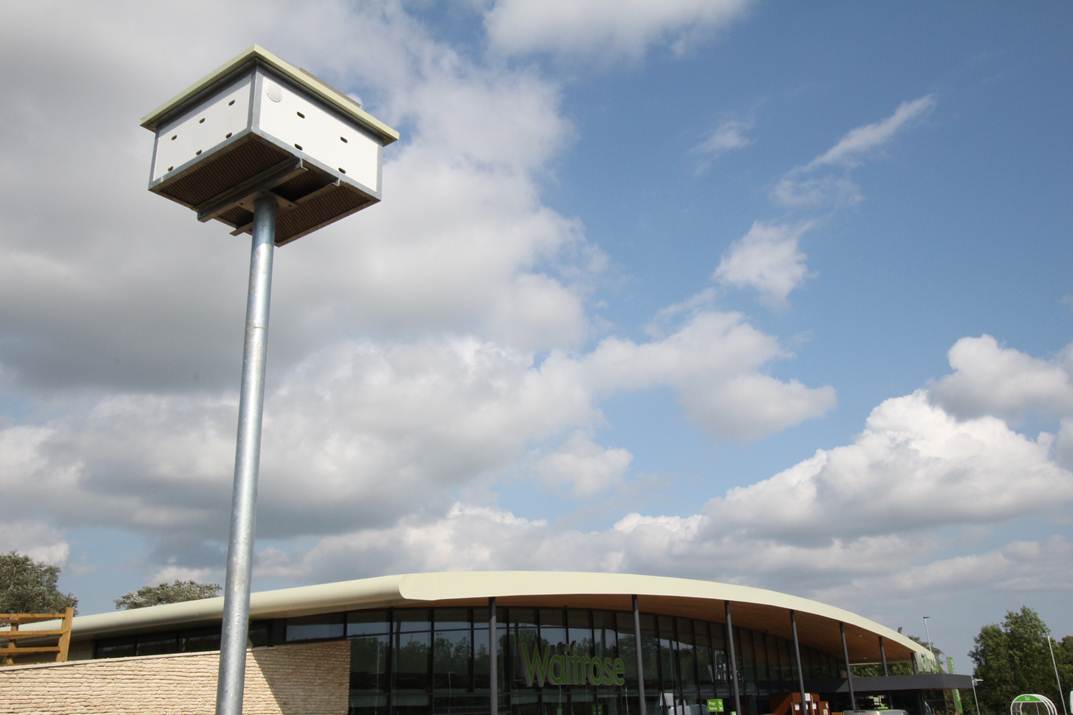
"We're
all very excited about the Swift tower. Learning all about the unique
needs of Swifts has been very interesting and we hope the Swift tower
will create interest and raise awareness amongst the community as well."
Toby Marlow, Sustainable Development Manager for the John Lewis
Partnership
Photo
© Waitrose
plc
|
|
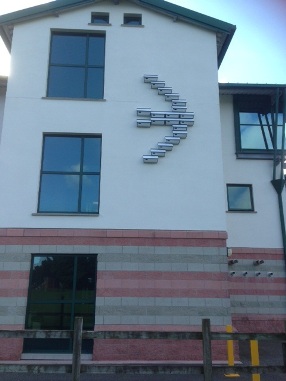
Photo
© Thais Martins
|
Swifts
get their own digs at
Camborne's
Cornwall College
Thais
Martins, Swift activist in Cornwall
and the West Country, sends us this
photo of a dramatic new artificial
Swift colony that she has helped
set up at Cornwall College in Camborne.
As
their web site says: "At Cornwall College Camborne all of our courses
are vocational. That means they are practical, with a focus on getting
you ready for the career you want or university, through practical
skills training and real-work environments and projects."
We at Swift Conservation
are hoping that their new Swift
nest boxes will becoame part of
a new "Practical Biodiversity
for the Built Environment"
course!
Here's hoping for
that and some new Swifts too!
|
|
New
homes for Swifts on the Loire
Here's a
photo of the 5 boxes put up by the
Toussaints, who are friends of one
of our keen supporters, Carolyn
Knowlman of Amboise, in the
Loire Valley in France.
A
very lush and beautiful area, it
is home to swarms of Swifts, Martins
and Swallows too every summer. It
is a great place to visit, not just
for the birds but for the spectacular
countryside, the historic Chateaux
and small towns, the wine and the
delicious food.
But as everywhere
these days, modernisation and renovation
of old buildings is forcing out
many Swifts families from their
old nests, with few places left
to go to.
Note the neat and
not displeasing installation of
these nestboxes, with each box placed
between the rafter ends, adding
to rather than diminishing the appearance
of the building.
Swifts are already going into at least 2 of the
boxes already, which argues
a local nest box shortage, which
suggests even more should be
put up!
|

Photo
© Carolyn Knowlman
|
|
The
Cambridge International Swift Conference
2104 - a brilliant success!
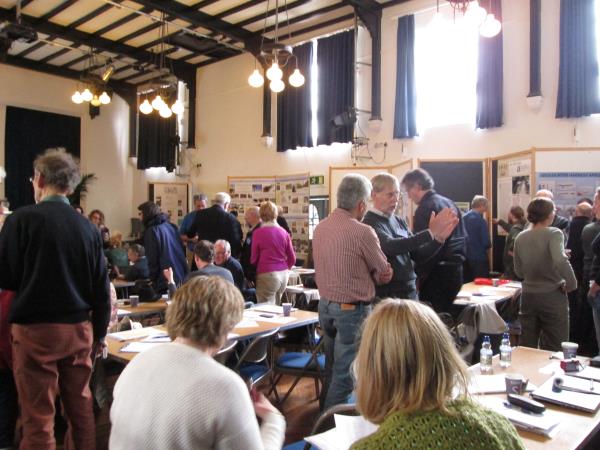
Above:
Lyndon Kearsley (centre, facing
right) of Belgium explains a point
to Giorgio Paesani of Italy during
a break in the sessions in the Parkside
Community College
Above Right:
Edward Mayer (second from right)
of Swift Conservation with Silvana
di Mauro and Kevin Prince and friends
from Trieste, Italy, before the
formal dinner in Caius College
 Click
on the Swift
to see the Summary Proceedings - fascinating!
Click
on the Swift
to see the Summary Proceedings - fascinating! |
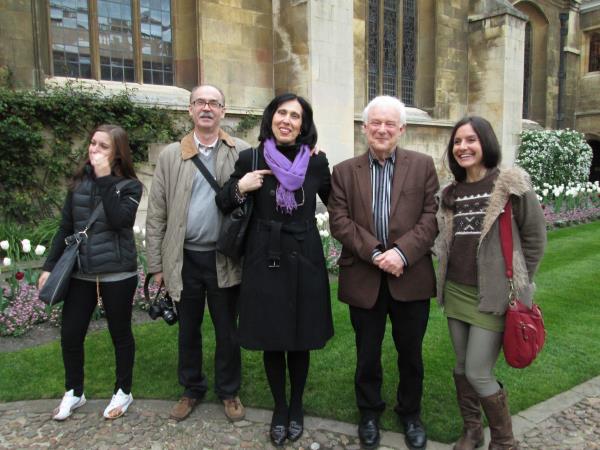
April
saw the third International Swift
Conference being held in Cambridge.
The previous two, in 2010 and 2012
were held very successfully in Berlin.
The Cambridge Conference was the
biggest and most successful yet,
with over 150 delegates from 24
countries giving 45 talks as well
as a special seminar for Architects
and Planners.
Included for
the first time were representatives
from the Americas talking about
the many fascinating New World Swift
species, as well as a representative
from the City of Baku, in Azerbaijan,
talking about the successful historic
Maiden Tower Swift conservation
project.
Highlights from
three days of excellent fascinating
presentations were Luit Buurma's
session on his radar-based studies
of nocturnal Swift activity over
the Netherlands, Jonathan Pomroy's
show of his paintings and drawings
of Swifts, Anders Hedenstrõm of
Lund University's work on analysing
Swift wing capabilities in wind
tunnels, and Hayley Sherwin of the
RSPB, talking about the innovatory
Belfast Swift Survey. From the Americas,
Larry Schwitters session on his
work with Vaux's Swift was outstanding.
Immaculately
organised by a team led by Dick
Newell from the Action for Swifts
blog-site, with assistance from
Swift Conservation, this event set
a very high standard for the next
such event, to be held in 2016.
Photos
© M S Mayer
|
|
Swifts get homes at Tottenham Court Road Underground
Station
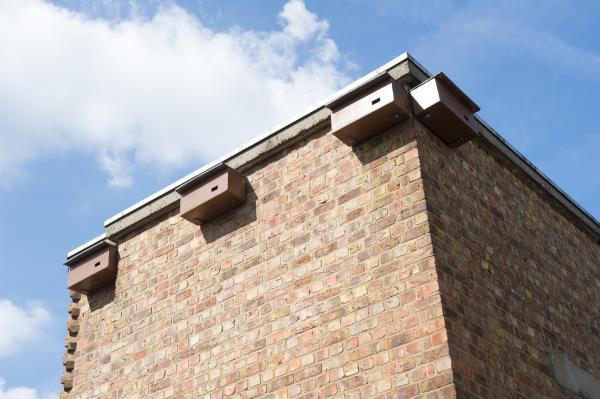
The photos show (above)
the new boxes in position on the
disused chimney stack, and on the
right, a view of
the site from street level, far from finished but coming along fast. Shown below
are Csaba Revesz and Assad Khalfe,
who made the Swift
Boxes, and some Insect Hotels too.
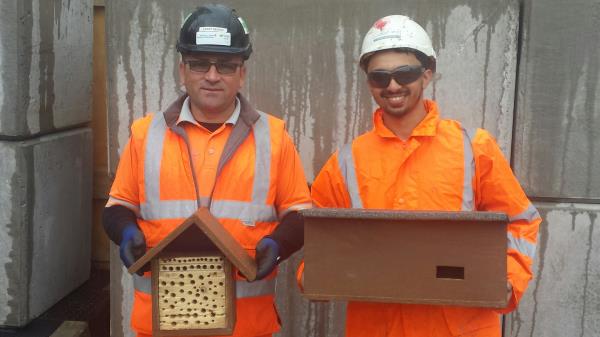
|
With encouragement from the London Wildlife Trust, Taylor Woodrow BAM Nuttall, the
contractors working on the new underground station at Tottenham Court Road,
have made up some nest boxes for Swifts from recycled plywood, and have set
them up on a disused chimney stack high above the street, on one of the
buildings remaining on the site.

Ed Warner, Environmental Manager, and Bukky Olose,
Environmental Advisor, were instrumental in getting the project up and running.
Swift Conservation sourced the sound equipment being used to attract juvenile Swifts
to breed in the new boxes. With Swifts active over King’s Cross, Highbury and
Islington and Hackney Central stations, it is hoped that they will find
Tottenham Court Road a pleasing new location.
Photos
© (above) London
Underground & (left) Taylor Woodrow BAM Nuttall
|
|
Linenhall
Arts Centre in County Mayo, Eire,
gets its nest boxes up!


Lynda
Huxley of the Galway-Mayo Institute
for Technology (GMIT) in the West
of Ireland writes to us:
"Here is a picture of
the Linenhall building (the red arrow marks the new nest boxes). I approached them with the idea of putting them
up
and they were delighted to support Swift conservation in Castlebar.
There
are cameras in the two outer boxes which are linked to a TV in the
coffee shop. Hopefully in the next couple of years the Linenhall will
get birds in their boxes, visible to all who drop in for a cup of tea
or a coffee. The project was funded jointly by the Linenhall,
Mayo County Council and a Local Agenda 21 grant.
Photos
above: the new Linenhall nest boxes
going up (right) and in situ (left)
©
Lynda Huxley
|

At
Galway Mayo Institute of Technology we have our first chicks and we are
very excited about this. The second ones are due to hatch any day
now. The project at the college was jointly
funded by a Local Agenda 21 grant, GMIT and staff (who sponsored all the
cameras)."
Lynda
has also put up nest boxes at two schools in
the county!
That
is not all! She has published
and distributed 3000 copies
of a lovely little book about
Swifts "I am a Swift" with 1500 copies
being
ordered by Environmental Awareness Officers in 7 counties around
Ireland. Quite a set of achievements, and we are sure there is a lot more
to come!
Photo
above: A local school class
visits GMIT to view some of
their nest boxes ©
Lynda Huxley
|
|
|
|
|

The re-pointing
work needed on the South wall was completed and scaffolding removed in time for the arrival of the Swifts. The open spaces around the rafters and in the
top courses of stonework are being left untouched, likewise the deep
overlapping eaves that ensure that the building is watertight and also protect
the Swifts from harm. The ivy shown in the
photo above, that might give access to predators like Squirrels and Stoats, is being removed.
Ludlow
Swift Group thanks Caring for God’s Acre for its support and hopes they
can
continue to work together to help Hereford Diocese look after the wildlife
that relies on churches for survival. Adapted
from information and photos supplied by Peta
Sams, Shropshire
|
The Church of St James the Apostle, Wigmore
in Herefordshire
The
Church of St James the Apostle,
(left)
built in the 11th Century.
It is important
as it has an early Norman Nave and herringbone masonry on the outside of the north wall.
But of great interest to local naturalist
Michael Fieldsend is the Swift colony that breeds in the eaves of the South wall
of the church each summer, a typical site in medieval buildings. Michael contacted Ludlow Swift Group in 2012 when
plans to restore this wonderful building were being made, asking for their help
in saving the Swifts from eviction
or worse.
Following
negotiations it was agreed that to
accommodate the Swifts' breeding season the contractors would leave the site between
mid-May and mid-August.
Below: the South aspect holds many Swift nest sites
sited between the
rafters
 Photos
© Peta Sams Photos
© Peta Sams |
|
|
|
|
London's
Whittington Hospital
 The
famous hospital near Archway in
London, founded by Dick Whittington
(left, with his cat and a dog) has
just had two "Habi-Sabi"
Swift Nest Boxes installed (right)
on its rooftop plant rooms by site
contractors Ecolab Ltd. The
famous hospital near Archway in
London, founded by Dick Whittington
(left, with his cat and a dog) has
just had two "Habi-Sabi"
Swift Nest Boxes installed (right)
on its rooftop plant rooms by site
contractors Ecolab Ltd.
The
prominent position and playing of
Swift calls should ensure that Swifts
will take up the nests before too
long. |

Photos
© Simon
Walker at Ecolab Ltd.

|
|
|
|
|
St Michael's School, Ballyfermot,
Eire
Helen
Burke writes: "Our Boxes are up at last! This is St Michael's School
In Ballyfermot. This project is being sponsored by the Ballyfermot
Environment Group, Dublin City Council's Ballyfermot Area Office and the
Dublin Swift Conservation Group
of which I am the founder member."
This is an excellent example
of local initiatives backed up by
local government and NGOs, with
eager local participation, ending
up with great new nest places for
Swifts.
Why not set up a
scheme like this in your area? If
you can do it you will have played
a vital part in saving our Swift
populations from decline and extinction.
Get going now! We can supply
helpful advice and useful contacts. |
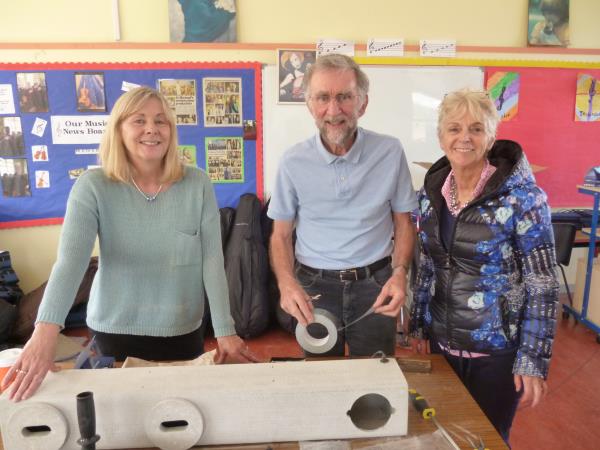
Photos
© Dublin Swift Conservation
Group
|
|
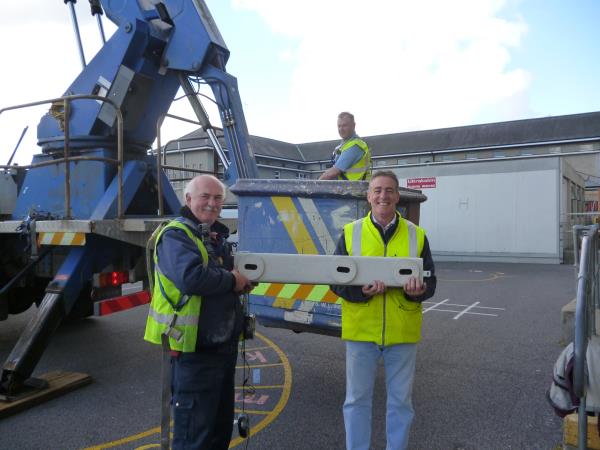
|
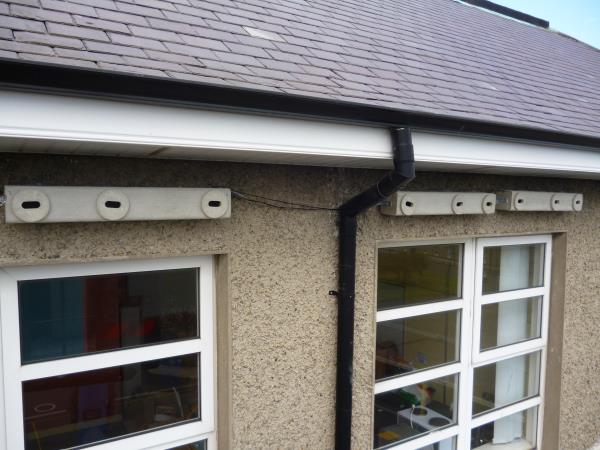
|
|
|
|
|
Bishop's
Castle project completed!
This
handsome Georgian town hall in Bishop's
Castle in Shropshire, a Listed Building
with great historic character, has
been fitted with two bespoke nestboxes
mounted inside the louvred
ventilation hood, seen below right.
The Swifts' accommodation
is accessed via the two small slots
in the new leadwork, visible below
and to thr right of the flagpost.
The
brainchild of Peta Sams (who runs
the
Ludlow Swift
group) working with the architect
Philp Belchere and Peter Carty of
the National Trust, the work was
done with input from Swift Conservation's
Edward Mayer. An electronic system
to play Swift calls to attract the
birds is also being installed.


Photos
© Peta Sams
|
Military
areas on Salisbury Plain get
some much-needed Swift nests
 
The
Tilshead Water Tower on Salisbury
Plain. No longer in use for water
storage, but now converted (above
right) for use by Swifts! This project
was conceived, designed, built and
installed by Major Nigel Lewis and
his Imber Owl & Raptor Group.
Their prime rôle is installing,
monitoring and maintaining
some 800 Barn Owl, Tawny Owl and
Kestrel nestboxes across the Plain
and far beyond, but with a little
time on their hands they decided
to help Swifts too.
 Left:
The four boxes as they appear from
inside the Tower, mounted in one
of the empty window frames shown
above. The black oblongs on the
back of each box are labels, and
the gap at the base of the window
is to let in Swallows to continue
to nest inside the Tower. Left:
The four boxes as they appear from
inside the Tower, mounted in one
of the empty window frames shown
above. The black oblongs on the
back of each box are labels, and
the gap at the base of the window
is to let in Swallows to continue
to nest inside the Tower.
We
are often asked if there is any
conflict between Swifts and Swallows,
House Martins, and Bats. The
answer is "No". Sometimes
Swifts do try and nest in House
Martin nests, with foreseeable unfortunate
consequences!
Bats and Swifts
make good companions, one flies
by day, the other by night, one
roosts on the floor, the other hangs
from the roof!
Photos
© Major Nigel Lewis
|
|
|
|
|
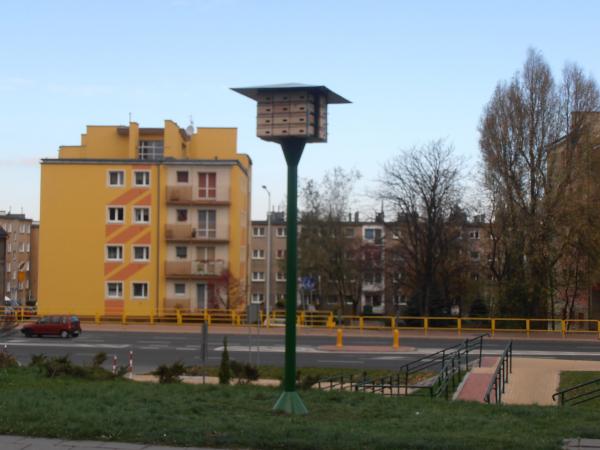
|
Zielona
Gora, South Eastern Poland
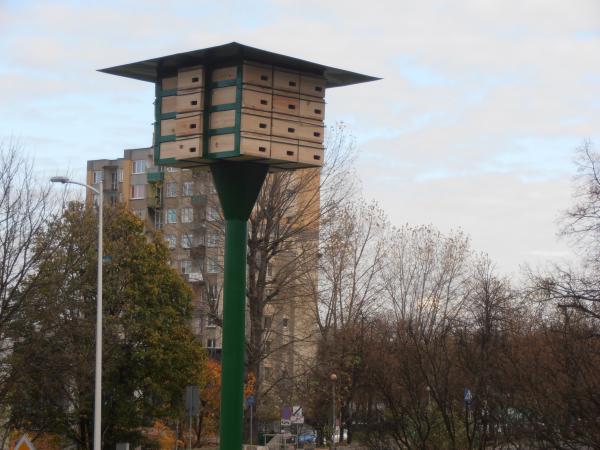 Jacub
Marcinowski is the designer behind
the setting up of two new Swift
Towers in the South Eastern town
of Zielona Gora in Poland. Jacub
Marcinowski is the designer behind
the setting up of two new Swift
Towers in the South Eastern town
of Zielona Gora in Poland.
This
sort of installation is usually done
to compensate for loss of nest places
when apartment blocks are re-insulated
to bring them up to the latest EU
standards. This has caused severe
problems for Swifts all over Europe,
but with this sort of response there
is now hope that Swifts may find
alternative nest places ready and
waiting for them on their return
from migration over Africa. Photos
© Jacub Marcinowski |
|
|
|
|
Swift nestboxes
go up in Berkhamsted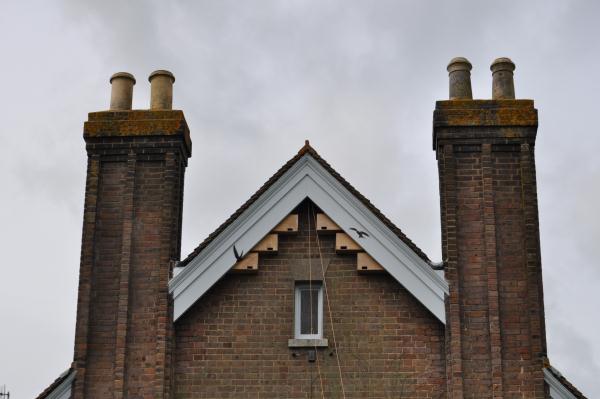
The NE gable, with two
Swifts investigating, on the 13thJune
2013. The Swift-call loudspeaker hangs from the halyard below the
window-sill, and can be hauled up and down so that it does not get
soaked by rain. Swifts investigate new nest places only when the
weather is very good, so that's OK!
Photos
© Patrick Lepper
The best day was June 16th when he
was able to watch from a position facing the gable, and to his delight saw
several birds actually entering the nesting boxes, "Presumably not to nest now
but to prepare a site for next summer".
|
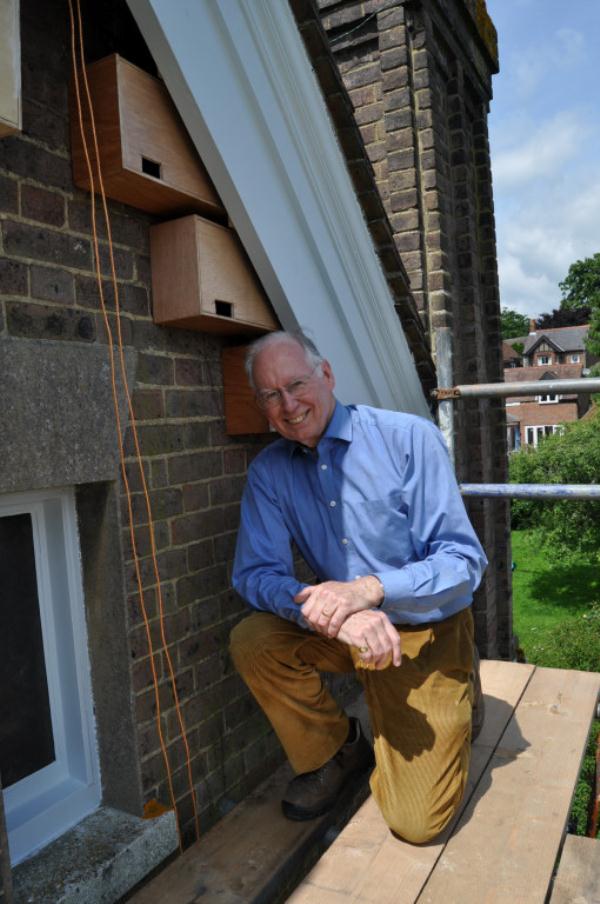
A few years ago, a local magazine article about “London’s Swifts” gave Patrick Lepper the idea of providing nest
boxes for Swifts. Last year he got in touch
with Hamish Burnett, a young expert on Swifts and a capable handyman, and
made plans to place some nest boxes under the eaves of his
north-east-facing gable.
So one Sunday Hamish, Pete the
painter and Patrick ascended the high scaffold with six nest boxes of weather-proofed
plywood, made by Hamish. With Pete’s help Hamish installed them in the preferred
positions at the peak of the gable. He also installed a “Swift-caller”,
playing a recording of nesting Swifts’ calls.
The first sign of
interest was on June 5th, when a party of 3 or 4 flew around
the house, and several times Patrick saw a bird break off and flutter up close to the
nesting boxes.
We are keeping our fingers crossed for Patrick and his
Swifts! |
|
|
|
New Swift
Tower at Yorkshire reserve
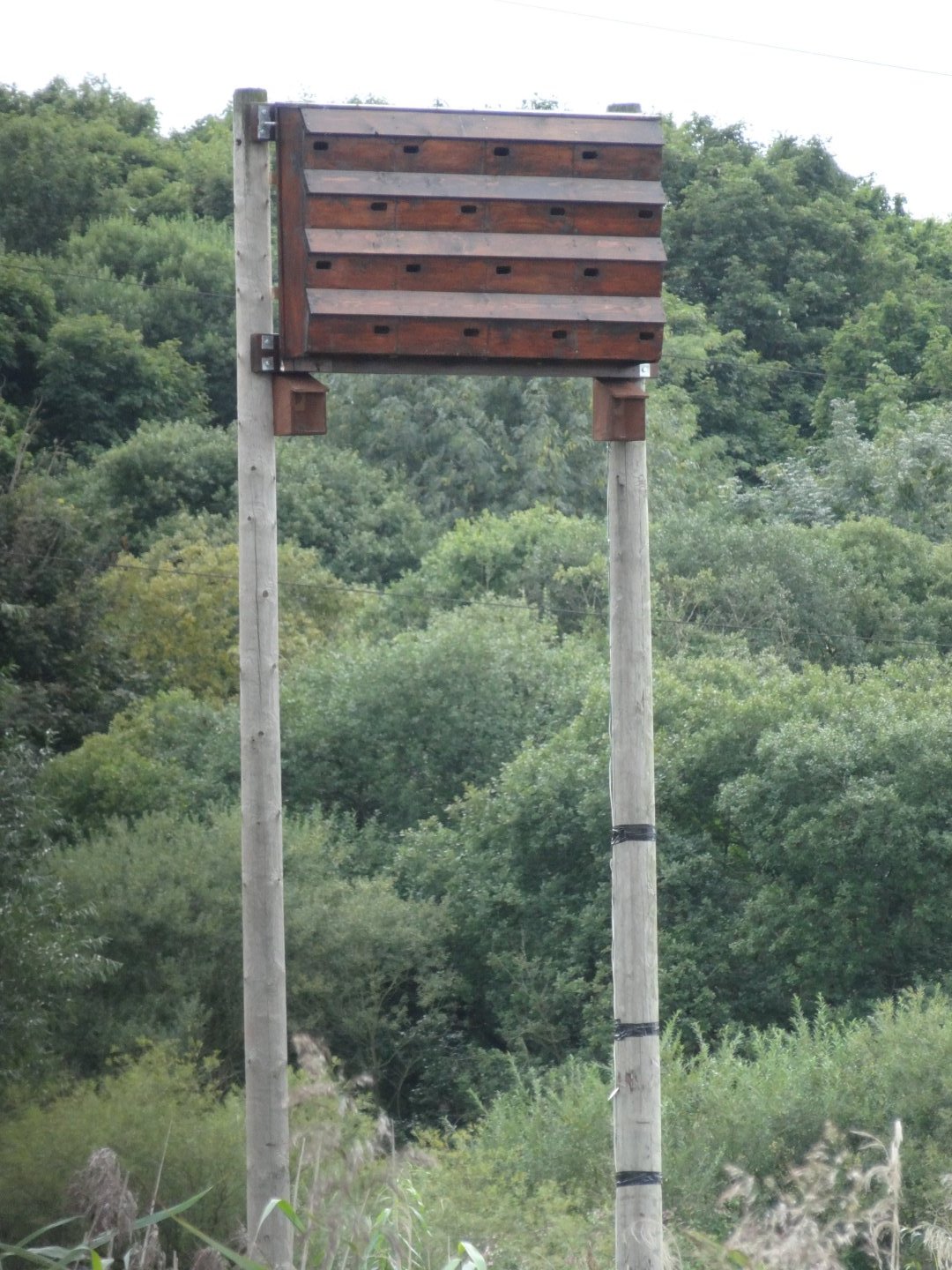 |
Rodley
Nature Reserve is a progressive local reserve which has taken over a
former sewage farm belonging to the Yorkshire Water Authority. With their
help it has become an independent nature reserve and charity
run entirely by volunteers. It boasts wildflower meadows, a field
farmed for wildlife, several lakes and ponds, reed beds, marshland,
woodland and a visitor centre. The reserve is within a large bend on the
River Aire which provides protection and a
source of water for the wetlands. The river is a brilliant habitat in
its own right with kingfishers and otters included in the list of
inhabitants.
Swifts regularly occur over the reserve but there were no suitable
buildings where they could nest. When contractors were there this
spring, building a fish pass around a weir in the Aire, they agreed to
help put in the Swift boxes at the top of two
eight metre poles.
Behind the project is Dave Nesham, in charge of habitat
management. He built a
four tier structure of sixteen innovative nesting compartments. The nests are
in a very open position but are still largely hidden
from the trails open to the public. The discrete positioning will help
to avoid any unwanted attention from vandals. They have also
been insulated across the back for fear they may get too hot in summer.
The boxes were up by the end of March 2013. Dave ordered
specialist audio equipment so that calls could be played
automatically. Swifts have been flying
around the tower, but it can take a couple of
years before Swifts accept a new structure. There is abundant
insect life at the reserve; the Swift Tower is of
a very high standard. Everybody at the reserve is hopeful
that Swifts are
added soon to the long list of species breeding there.
See: www.rodleynaturereserve.org for
more information
Contributed
by: Andy Woodall -
Friend of Rodley Nature Reserve
|
|
|
|
|
Swift Nestboxes go up in a shopping street in Nyborg, Denmark Inger Lund, our new Swift
contact person in Denmark, has just
sent us these interesting views
of Swift nestboxes that have been
set up in a shopping street in Nyborg,
on the island of Fyn in Denmark.
Inger has her own Swifts
nesting at her home in Starling
nest boxes; you can see one of them
on our Home Page.
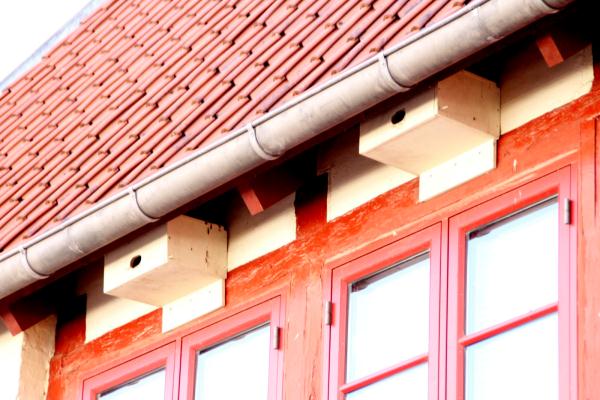
|
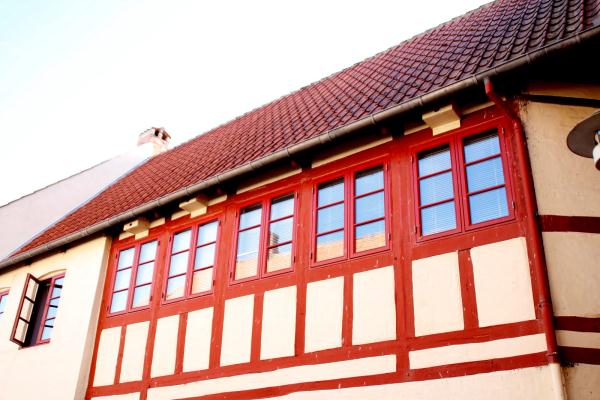
How nice to see that the
idea of helping Swifts survive and
thrive is reaching out from Ireland, the UK
and Germany, right across Europe, up
to Denmark, Sweden, Lithuania and
Poland, down to Spain and across
to Italy, Romania and Israel,
and now into Central Asia (see
our news from Baku, Azerbaijan,
below!) Photos © Inger
Lund
|
|
|
|
|
Brilliant success at Johnstown Castle Co Wexford, in Southern Ireland
Matt Wheeler, Curator /Manager of the Irish Agricultural Museum located within the grounds of the Castle, was inspired to
erect four Swift boxes at the museum after hearing a talk from Brian
Cahalane, a member of the Northern Ireland Swift Group.
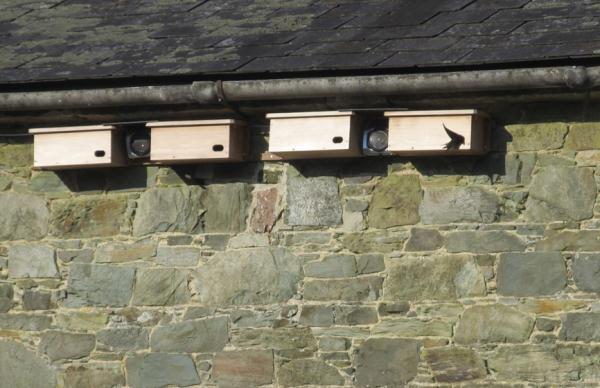
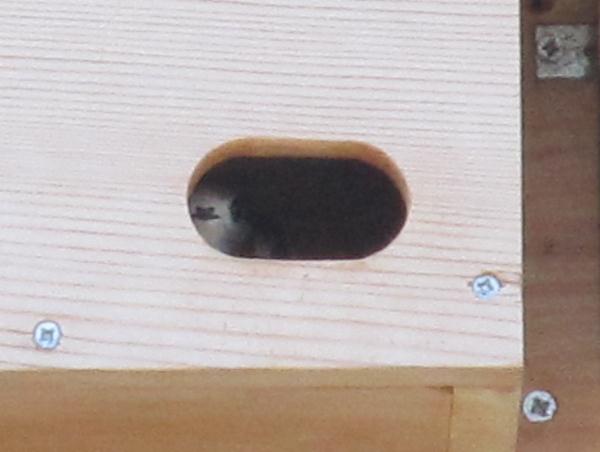 Matt played the Swift attraction CD last year
and this, and got his first pair this year. Here is the result, a
beautiful young Swift almost ready to fledge .
Matt played the Swift attraction CD last year
and this, and got his first pair this year. Here is the result, a
beautiful young Swift almost ready to fledge . |
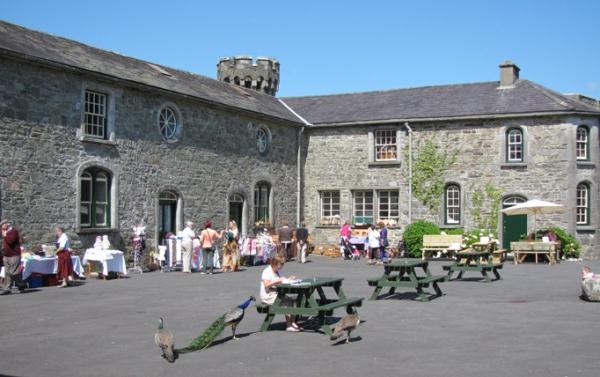
This is
great news and hopefully when all four boxes are filled
the guests dining at the museum will be able to enjoy the exhilarating
fly-pasts of the
Swifts,
and learn more about this wonderful bird.
Photos
© Brian Cahalane
|
|
|
|
|
Ove
Claessen who
farms inland from Gothenberg, in
Sweden, has sent us these lovely
photos
He
writes " The
Swift call I got from you attracted two new nesting Swift pairs to my
farm. Some evenings we have about 20 Swifts circulating between the
farm's houses. Never have there been so many Swifts here, not even
twenty years ago, when we had five nesting pairs on the farm. The Swift
pairs nest under tiles on the residential building, but they have also
looked inside nests which I have put up in the tower of my water mill.
This is where I have played the Swifts call . Hoping that they nest
there next year! Many thanks for your help!"
Photos
© Ove Claessen

|

An
adult Swift returns to the nest
to feed its chicks, just under
the tiles at this old farm in Central
Sweden; you might be surprised to
know that Swifts breed a lot further
North than this!
|
|
Stunning
photos from Barcelona
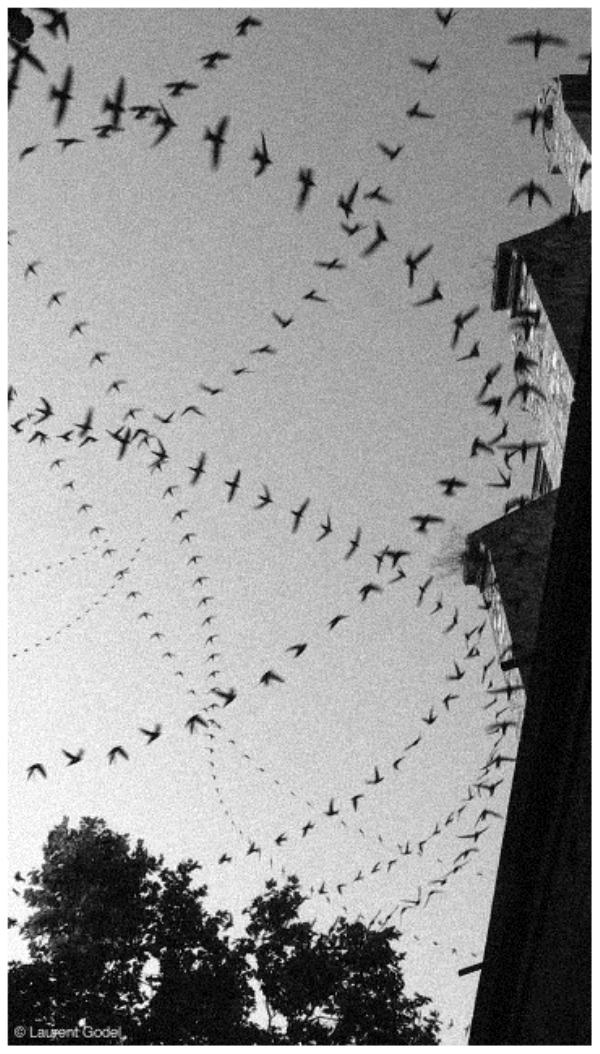
Laurent
Godel, an architect and interior
designer working in Barcelona, has
been taking amazing photographs
of Swifts zooming through the skies
abve the famous city with its spectacular
buildings created by Gaudi.
Here
Swifts fly across the sky above
"La Pedrera", a famous
apartment block with turret chimneys
like massed lines of armoured warriors,
and the Christopher Columbus Monument
(left, below).
By looking
closely you can see just how they
fly, with each wing beat shown clearly.
You
can see many more at his Blog site
by clicking here
Photos
© Laurent Godel
|
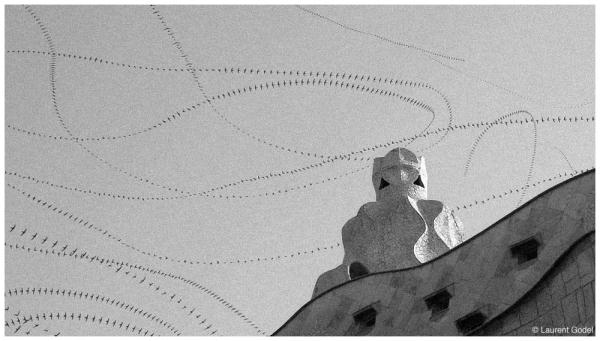
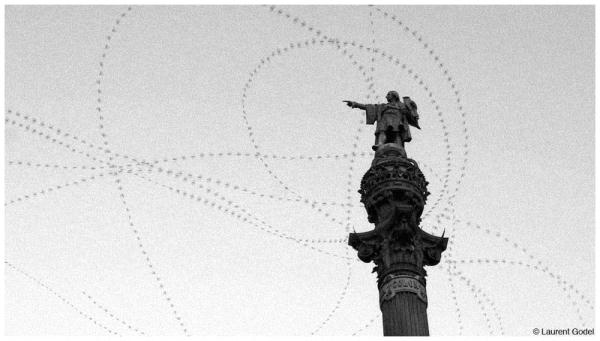
|
|
|
|
|
Over
6000
Stimpson Nest Boxes Sold!
John Stimpson,
maker of the simple and economical
Zeist-type Swift nest box shown
on our "Shopping" page,
has been in touch to tell us he
has now made and sold over 6000 of them,
to all parts of the UK and now to
France too.
Sales
and take-up at this level can start
to make a very real difference to
the UK's Swift population, confined
as it is by de-forestation and history
to seek nest places in our buildings.
Put together with other box sales
and nest place initiatives, maybe
things are getting a bit better
for our Swifts? All we need now
is a long succession of glorious
summers!
Opposite is a photo
of a young Swift looking out from
one of John's boxes, fitted to a
building in Dunblane, Scotland.
|

Photo
© Anne Youngman BCT
|
|
More
Successes with Nest Boxes!
Bob Freeman sent us this
brilliant photo of a Swift leaving
one of his Schwegler nestboxes in
South Shields.
Bob says: "I
have had Swift nest boxes fitted below the eaves on my house for 10
years now, and over the last few days I have had Swifts enter all three
boxes. On the night of 6 July I noticed a bird fly in late dusk and not
reappear, so it looked like this bird had gone in to roost. By the
way, these birds were lured into the box area with a Swift Calls CD". It may be that the
Swifts found the boxes after being
evicted by building or insulation
work at a nearby property.
It shows it's well worth putting
up boxes, and being very patient,
as well as playing the Swift calls.
|
 Photo
© Robert Freeman
Photo
© Robert Freeman
|
|

|
Another
Splendid Swift Success!
From Dunblane, not far
from Edinburgh in Scotland,
John Haddow sends us this dramatic photo
of a Swift leaving a Zeist type
nest box fitted to his house with
the help of the Scottish Bat
Officer, Anne Youngman.
Here again,
Sparrows moved in first, but then
Swifts moved into both boxes. Never forget, Swifts can
fly almost as fast as Andy Murray's
tennis balls!
It has taken
a few years to achieve success,
and again it shows very clearly
the values of patience and persistence
when working with Swifts. Photo
© John Haddow
|
|
A
Big Surprise at Slaithwaite
From Yorkshire comes this
evidence that Swift nest boxes are
taking off in a big way. We're very
grateful to Robert Harrison for
both discovering this amazing installation
of Schwegler nestboxes on a viaduct
in Slaithwaite, Kirklees, and telling
us all about it.
Do you know
who put them up? Please let
us know!
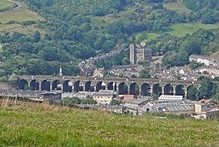
The
famous historic Viaduct in Slaithwaite,
West Yorkshire dominates the valley.
Photo
courtesy of Wikipedia
|
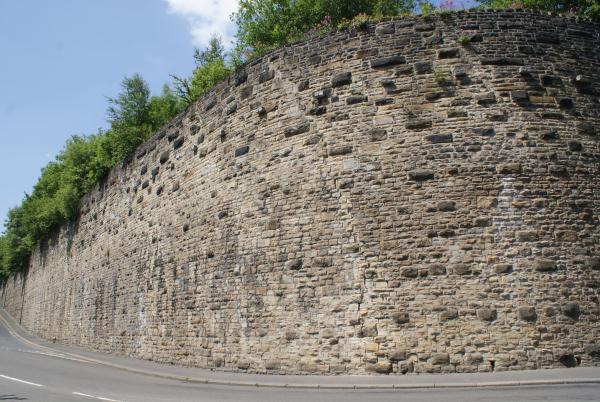
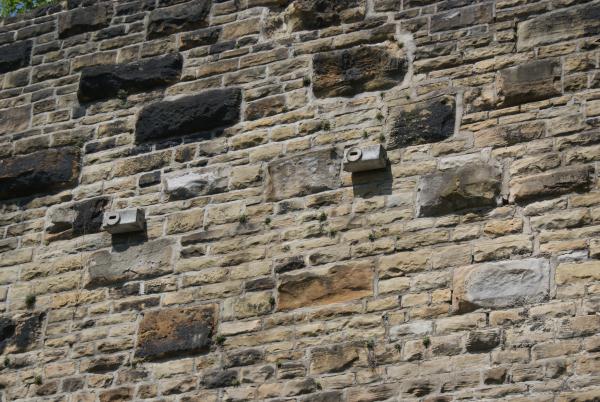
The
Slaithwaite Viaduct is at Crimble on the road to Golcar
(Huddersfield). There are
14 Schwegler nest boxes mounted
between 25 and 30 feet up on the
walls. Two are shown in the close-up
above right. Robert Harrison has
seen that at least 12 of the boxes
were in use in Summer 2014. Such
a take-up without using Swift calls
is exceptional. It may indicate
Swifts are moving in
having been evicted elsewhere. Photos
© Robert Harrison
|
|

A
Swift heads for its new home, an
Ibstock Swift Brick in the end wall
of the new Library in Antrim, one
of 15 installed at public request.
Photo
© Brenda Campbell
|
Antrim's
new library gets its Swifts
Rodney Monteith in Antrim,
Northern Ireland, the man behind
the 15 "Ibstock
EcoHomes for Swifts" (Swift
Bricks) in the Antrim Library, has
been keeping a close eye on them,
together with Brenda Campbell, Mark
Smyth and Peter Cush of the Northern
Ireland Swift Group. He reports
that the nest bricks were enthusiastically
taken up by House Sparrows
(not a bad thing as they too are
in sad decline) but now two are
occupied by Swifts.
Things
are starting
to happen! 11 Swift Bricks have
been
installed in Antrim's Oriel Gallery, (formerly
known as The Long Barn), others
at
the new Train and Bus Station, and
no less than 37 at Greenmount College!
It's
a splendid way to get some life
and action into otherwise sterile
townscapes, isn't it? And that's
a major aim
of Urban Biodiversity!
|
|
2013
- A very bad year for
Swifts
Early
breeding attempts by Swifts in parts
of the UK and Northern Europe failed, due to the cold
weather and resulting dearth of
flying insects for the Swifts to
feed on. There has been a huge mortality
of Swifts in some areas; it is estimated
that 90% of Swifts who made it to
Bavaria have subsequently starved
to death or died of hypothermia.
From Spain and France
come news items of Swifts falling
dead from the sky in their hundreds;
fromSwitzerland we have eye-witness
accounts of Swifts desperately seeking
food in rain and low cloud over
Lake Lucerne, and falling into the
waters there to be eaten by Gulls.
From Bavaria we have instances of Swifts
being found dead in their nests,
and of abandoned eggs and chicks.
Our local contact in the Czech Republic,
Lukáš Victora, tells us the breeding
season there is delayed by
at least a month, and numbers are
down sharply.
With the recent much
warmer
weather in the UK Swifts have likewise
laid again. It means a very
late end to the nesting season;
some breeders could still be with us now
right through August, even into
September.
|
Very sadly,
our colony at London Zoo has failed
to produce any chicks for the first
time since Swifts moved in. Just
one lonely adult Swift
spent its nights in a nest box
there, without a partner. Maybe
next year will be better.
.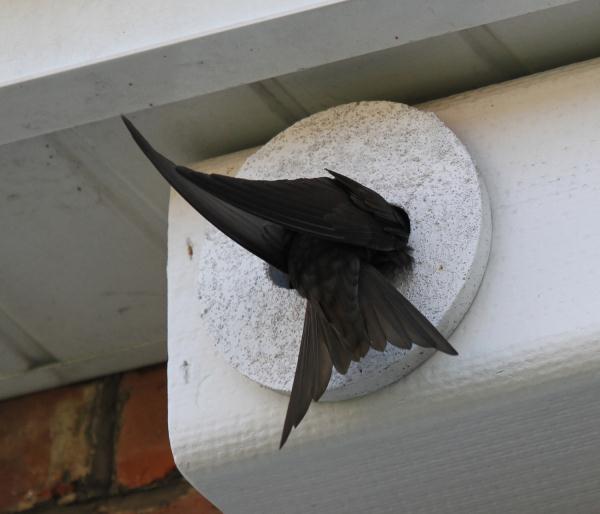
Bob
Freeman (see News item above) had
nest boxes up for 10 years
and at last
Swifts have moved in!
It is always worth the wait.....
Photo
© Robert Freeman
|
From
Moscow we have an excisting new
idea, that came about as an entry
into a competition to find radical
new uses for the DuPont product
Corian, more usually used in washrooms.
This is what the architect designers
say about it....
"Prefabricated
concrete panel houses - that's the environment in which we grew up. They are everywhere - they are the real face of the city, its flesh. Over
time, areas built of such houses are beginning to be overgrown with
tall trees, and the houses themselves take the form of the familiar,
safe home, like an old, beloved cave. Districts are now
picturesque, quiet and comfortable.
The air is calm, broken only by the gleeful shrieks of Swifts whose
wings cut the blue sky. Swifts - unique creatures. Spending all their life in flight: eating in flight, in-flight drinking, sleeping in flight, in-flight multiplying too. They
do not walk on the ground on principle, do
not feed on garbage, and are totally different from other urban birds. They
bring the maximum benefit, no harm. One adult
brings its chicks about 30,000 insects
a day. Thus, the greater the number
of Swifts in the city, the better for our
environment. Currently
Swifts have to compete with feral pigeons in finding suitable
nest-places, which does not contribute to an increase in their
population. These
nest pods are built from Corain,
expensive but durable. Each pod
as well as providing numerous nest
holes for Swifts, is a giant house
number, which can be seen from afar. So
it is very convenient for the residents
and visitors. The unusual shape of the
nest pods radically changes the residents'
homes from simple concrete boxes to a
high-grade naturalistic object. The old, familiar areas finally acquire a unique natural charm. ...........
"
But
these pods could change the
scene for Moscow's Swifts, as well
as for its residents. Let's hope
this dramatic, handsome idea
gets taken up, and soon! For
more information contact
Arch
Group Architects, Moscow |
New
Homes for Moscow's Swifts?

Photo
© Arch Group Architects, Moscow
|
|
New
nests for Swifts at Goose Green Primary
in East Dulwich
Steven
Robinson, South London Swift Conservation Adviser, has been helping his
son's primary school, Goose Green in East Dulwich, with a nest box
project. The boxes look excellent; the school made three, a parent
made the other, and the pupils painted
them. They are insulated from excess solar heat with an extra roof and
a ventilation gap between the two roofs. The school is using the Cheng
Sheng player to broadcast the calls via a tweeter in one of the boxes.
Here they are in all their glory!

|

The
boxes' design follows the well-tested Dutch
Zeist model, named after the town
of the same name. Such boxes can
be bought here in the UK for about
£13.00 from John Stimpson. Please
see our Shopping
Page
for more details.
For information
on using the Cheg Shen amplifier
please contact Dick
Newell
Photos
© Steven Robinson
|
|
Another
Swift Tower goes up in Northern
Ireland
Congratulations
to the pupils of
Pond Park Primary School, Lisburn Co Antrim, and their teacher Mr
Burns, who with the help of Mr
Declan Philips of Stoneyford Engineering (who built and installed
this superb Swift mini-tower) and the Northern Ireland Swift
Group, have ensured that Swifts now
have a new home at Pond Park Primary.
The tower has its own built-in sound system to
attract Swifts, and when a pair take up residence in one of the nest boxes a
camera will be fitted when the birds are in Africa during the winter. This
will allow the pupils and staff to learn more about this wonderful bird when they return.
Stoneyford Engineering build a range
of Swift
towers and as well as having supplied them to Tesco's and the Belfast
Bus Station, also now have orders for
mini towers for private houses.
Photo
© Brian Cahalane: Northern Ireland
Swift Group
|
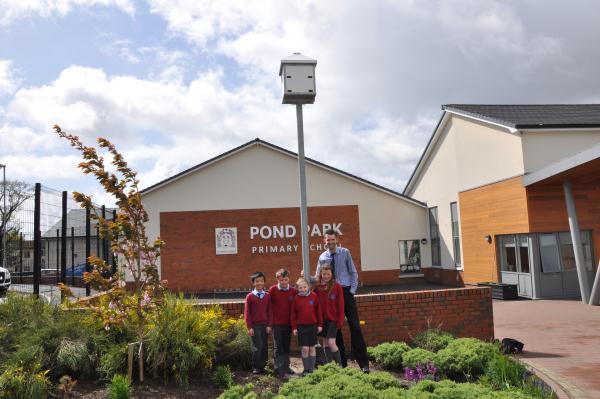
|
|
Dublin
puts up some Swift Nest Boxes

Photos
© Alan Hester / Dublin City Council
|
We
have been working with Helen Burke
of Dublin City Council on Swift nest place projects for the
capital city. With the help
of Eric Dempsey, one of Ireland's
leading ornithologists, who is giving
public talks to promote the scheme, and
Alan Hester who is in charge
of the building and has been instrumental in getting this project off
the ground, the first project
has now been completed.

Here are photos of
the boxes fitted to plant rooms on top of Dublin Council's Civic Offices on
Wood Quay. A sound system has been installed and is playing Swift calls
to attract potential occupiers. The
boxes may be viewed from Ormond
Quay.
|
|
Cullompton's
Library gets Swift homes
Stephen
Fitt, who works as a volunteer for
the RSPB in the South West, tells
us the following: "With
the approval of the Devon County Ecologist I check their monthly
planning list and if there are any obvious potential candidates for
Biodiversity enhancement I liaise with the relevant Planning Officer. In
this instance Swift boxes were made a consition of Planning approval, and I worked with their
Architects, the Exeter Office of the NPS Group, on how and where. 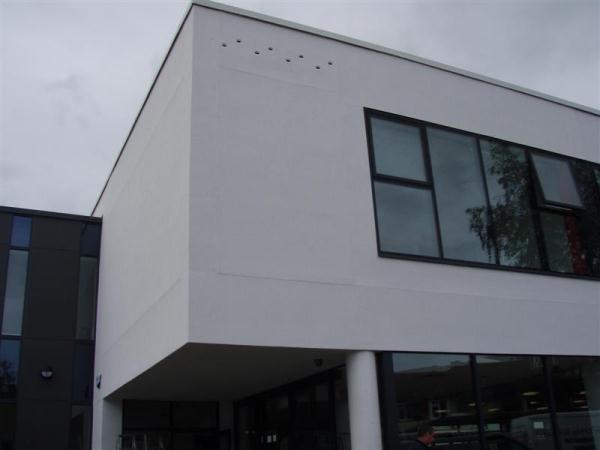
We installed Schwegler
Light Weight Swift Box Type 1A's. There is a loud speaker wired to
the Library’s PA System to play calls. Due to ongoing building work,
there was only a very limited opportunity to play the latter last July, but I
was told Swifts came visiting almost immediately and created lots of local interest!
My work with Devon County continues and we are currently working on a number of school projects and the main library in Exeter. As
a consequence of this work I am spreading the word and
two or three schools in Dorset have adopted similar policies."
|

Photo
© John Baggley NPS South West
Ltd
Above
left: a close-up
view of the eight Schwegler
boxes sunk into the
facade of the new building
in Cullompton, and right,
a general view of the
building, showing how
they augment the street
view. Swifts will be
a very exciting aerial
component of this town's
summer skies.
|
|
|
|
|
Frankfurt's
Swifts take up new boxes

|
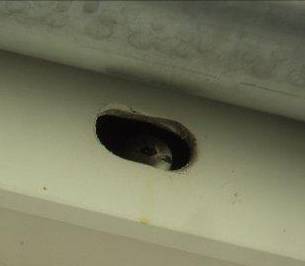
These
new boxes for Swifts, as shown on
the left, are of the simplest type.
Just a timber box with internal
partitions, fitted under the gutters
of existing buildings. Cheap, and
yet highly effective, as you can
see.
This is the work of
Ingolf Grabow and the Frankfurt
Swift Group 2010, and they are
starting to get results.
With
over 1400 Swift nestboxes now up
and ready for Swifts in Frankfurt,
they are achieving a successful
breeding occupancy rate of 55% at
one well-monitored site. This is
a remarkable achievement by any
standards.
Photos
© Ingolf Grabow FMI 2010
|
|
|
|
|
More
nest opportunities created in
historic
Brussels apartments
Martine
Wauters, who works on biodiversity
projects for the Municipality of
Molenbeek in Brussels, has sent
us these photos of a new project
she masterminded to provide Swift
nest places within existing architectural
features in apartment blocks.
These
sorts of buildings date from the
turn of the 19th Century up to the
First World War, and have interesting
architectural details, in this case
an extended windowsill that goes
across the front of the upper story
and is of hollow construction.
This
feature was used to provide eight
new self-contained Swift nest places.
|
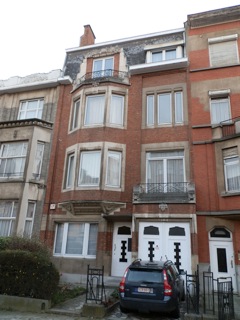
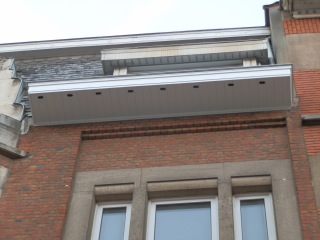
Photographs
© Martine Wauters
Above left:
the apartment block showing the
extended windowsill. Above right:
the adaptation to house Swift nest
places.
|
|
|
|
|
New
Swift Tower at Belfast
Bus Station
Brian Cahalane, an enthusiastic
supporter of Swifts
in Northern Ireland,
and a man with his own
home colonies of Swifts
and House Martins, has
just sent us this great
photo of the new Swift
Tower at the bus station
in Belfast.
Built
by the Stoneyford Engineering
Company to Brian's specifications, this
prefabricated tower
can be delivered ready-made
to any site in Europe
for a very modest overall
cost.
Find out
more by e-mail - use
this
link to Christy Cush
at Stoneyford
Photo
© Bran Cahalane
|
|
|
|
|
|
Amazing
news on Swift Migration
For
the past three years researchers
across Europe have been fitting
a handful of Swifts in accessible
breeding colonies with "data-loggers"
minute electronic devices that record
time and daylight.
When
these are recovered from Swifts
that have migrated to
and from
Africa, they can reveal their route
with some accuracy.
The results
for four projects in Sweden, Germany
and the UK are now known, and
they paint a picture much enhanced
over the minimal results gained
from ringing many thousands
of Swifts over many years.
In
part this is because Swifts fly
high and do not land. One has to
rely on getting rings back from
birds that die naturally and are
found, or are killed and eaten.
Also, rings cannot tell us
the time spent in any location,
only that it has been visited. The
information gained from them turns out to have been only partial,
huge parts of their migration route
having never been recorded before.
Find
out more - See
the BTO's full report at this
web site
See the full Swedish
results here
|
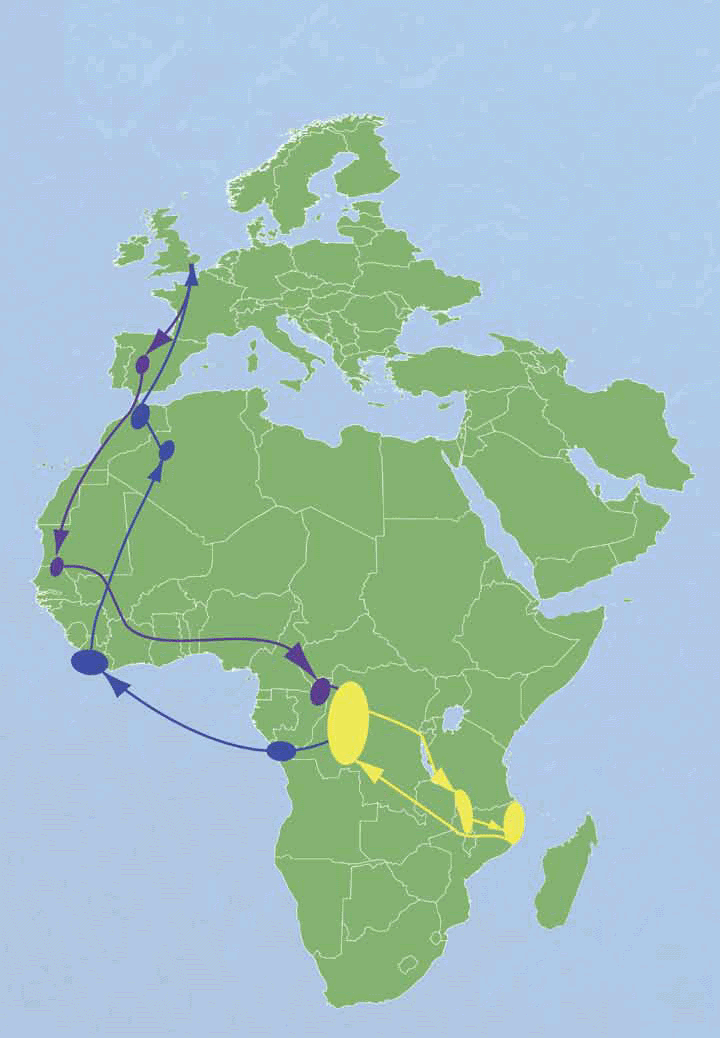
The
flight of A320, a Swift tagged at
Fowlmere on 22 July 2010 and recovered
on its return on 8 May 2011.
This
Swift spent significant periods (the
blobs)
on its route (purple) feeding over
lush West African rainforest zones,
and stayed for much of the
Winter over the Congo, (yellow blob)
apart from a significant Christmas
break (yellow arrows & blobs) over Tanzania,
& Mozambique, before returning
(blue route & blobs) to the UK, again spending
time feeding over West Africa.
This
information greatly augments and
improves on previous
ringing results, but quite a bit
of it does match local observations
made by skilled bird watchers.
Map
diagram © British Trust for Ornithology
|
|
|
|
|
Swift
Tower Competition Winner
This
is the winning entry in a recent
competition held in Poland for a
Swift tower, organised by STOP,
the Warsaw bird protection organisation.
Designed by Menthol
Architects, it is intended to
provide stand-alone, well sheltered,
robust, safe and long lasting nest
places for a large number of Swifts,
as well as being an aesthetically
valid landmark in itself.
Click
here for further information
(in Polish)
 left:
details of the boxes left:
details of the boxes
|

The
Menthol / STOP Swift Tower visualised on the banks of the Vistula river
in Warsaw, just along from the Copernicus Centre. Swifts have been
having just as bad a time in Poland as elsewhere in Euroipe, as the old
building stock is updated and insulated, and all their old nest places
are obliterated. Population losses in parts of Eastern Europe are
thought to be as high as 70% in the past few years alone.
drawings
© Menthol Architects / STOP
|
|
New
Swift homes in Teignmouth
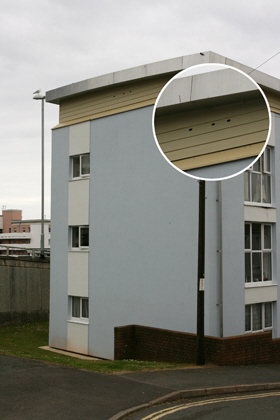
Photo
© Teign Housing
|
See the three small holes along the roofline of the
completed blocks of flats? These are a new part of Teign Housing’s
regeneration work in central Teignmouth. They are built in Swift nesting boxes.
A total of 51 new nest
places have been created,
using Schwegler's No
17A "triple"
box fitted behind the
cladding.
There is a small
Swift colony nesting under the road bridge next to the blocks, and
during the planning stage of the project Teign Housing (TH), the RSPB
and Teignbridge District Council planners, advised by Edward Mayer and
Stephen Fitt of Swift Conservation, agreed to install the nest boxes on
each block so the colony could expand.
Paul Davies, Head of Asset Management said: “As a housing
association it is our responsibility to meet local housing need, and we
thought we could extend this to some of our feathered friends. Sadly,
the Swift population is in decline, but we hope
that the boxes will encourage more to nest and help increase the Swift
population in Teignmouth.”
As TH's head office is in Newton Abbot it is difficult to monitor
whether the boxes are being used. If anyone in Teignmouth spots a Swift
or any other bird moving into these boxes, please let TH know the time
and date of your Swift spot by using the online Contact Us form.
|
|
Great
news from Exeter
RSPB
volunteer
gets amazing results...
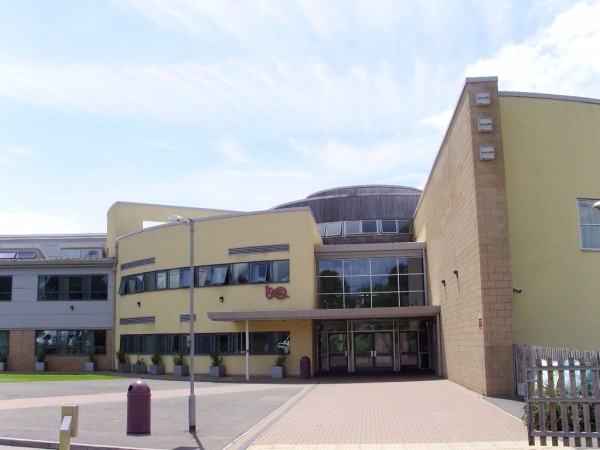
Above:
Isca College Exeter; Three Schwegler
nestboxes have been fitted to the
high brick wall to encourage Swifts
to nest there. Photo
© Emily Stallworthy, Devon Wildlife
Trust
|
Stephen Fitt, a Swift enthusiast and a
volunteer for the RSPB in the
South West of England has been working very hard with Exeter City Council, whose official
policy is to integrate nest/roost boxes for birds/bats into all new residential
properties.
Of course
a degree of flexibility to make sure that unsuitable locations
are not used, but a ratio of one nest box per residential unit is
the aim.
Within this policy, Swifts are treated as
a priority species, and the work being done by the Exeter Swift Project, a
partnership of the Council, Devon Wildlife Trust (see illustration) and the
RSPB, should make sure that there will be ample nesting opportunities for Swifts
in the foreseeable future.
Even
better, the Town and Country Planning
Association has adopted the Exeter Model as an example within its new "Good
Practice Guidance" which
is being promoted throughout
the UK.
See a special
feature on the "Good Practice
Guidance" here Download
the Town & Country Planning
Association / Wildlife Trusts "Good
Practice Guidance" documents
(inc Annex C)
here
For
more information please contact
Stephen here
|
| Caution!
Low
flying Swifts!
This
new road sign was put up last Summer
near Koblenz in the Rhineland. Swifts
fly low to catch insects when the
weather is bad, and so can come
into conflict with vehicles, something
their 49 million years on Earth
may not have prepared them for.
The
sign can be folded up when the Swifts
have gone back to Africa. But while
they are here they are now protected
from accidents with traffic, just
so long as drivers are careful.
Let's
hope this good idea gets copied
elsewhere!
Photo
supplied by the Frankfurt Swift
Group: see here
for lots more information
|
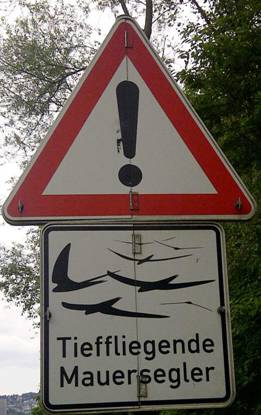
|
|
We
visit the Swifts of Andalucia -
millions of them!
What
with the rotten "summer"
we (and our Swifts too) were having,
we felt the need for a bit of intensive
Swift therapy, and headed off to
Andalucia in Southern Spain for
guaranteed sunshine, heat, paella
and.... Swifts!
We were not disappointed
- there were millions of them! Nesting
in the eaves opposite our hotel
in Malaga, right by the Cathedral,
nesting in a special roof made just
for them above the bar of our hotel
in Granada, and filling the sky
in Ubéda, they were everything we
needed. If only it could be the
same here in the UK.
See
our videos! Just click
on the blue logos to go to You Tube
 Swifts at the Alhambra Palace
Hotel, Granada
Swifts at the Alhambra Palace
Hotel, Granada
 Swifts over Malaga
Swifts over Malaga  Swifts
flying over Ubeda Swifts
flying over Ubeda
|
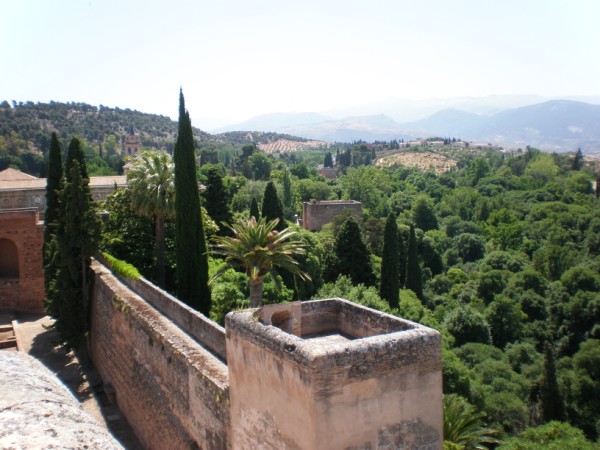
The Alcazar, the ancient
Moorish castle at the Alhambra:
a landscape that is just perfect
for Swifts; sun, heat, water, insects
and hundreds of old holes to breed
in
© Edward
Mayer www.swift-conservation.org
|
|
|
St
Rémy, Molenbeek, Brussels
A
new Swift nestbox
project in Belgium - designed by
Dick Newell and project managed
by Martine Wauters of the Municipality
of Molenbeek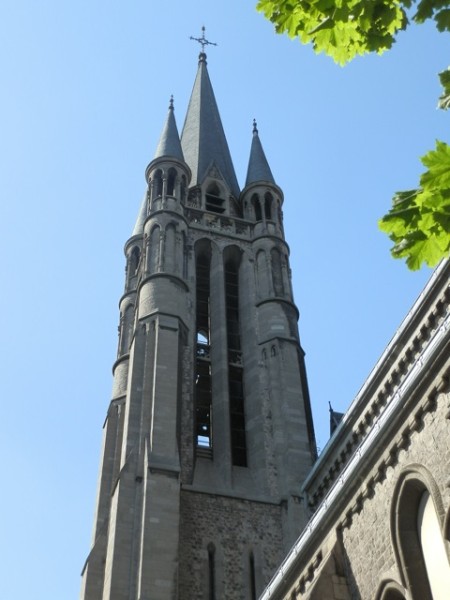
The
Swift nest box cabinets are being
fitted at the base of the long louvred
apertures in the tower of the Church
of St Rémy. All
photos © Martine Wauters - Municipality
of Molenbeek
|
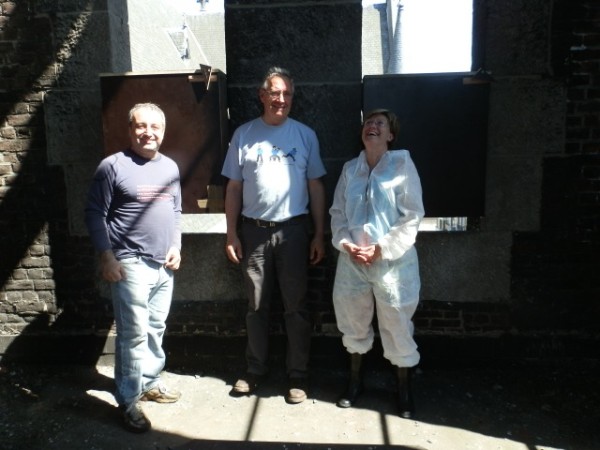
Above:
the
team that installed the
boxes - helping Swifts is fun!
Below
left: the boxes in position. More
can be added as the project takes
off and Swifts move in, and in that
way the feral pigeon population
of the tower can be reduced, and
a pest removed.
Below right:
a Swift's eye-view of the prospect
from the nest. Not bad!
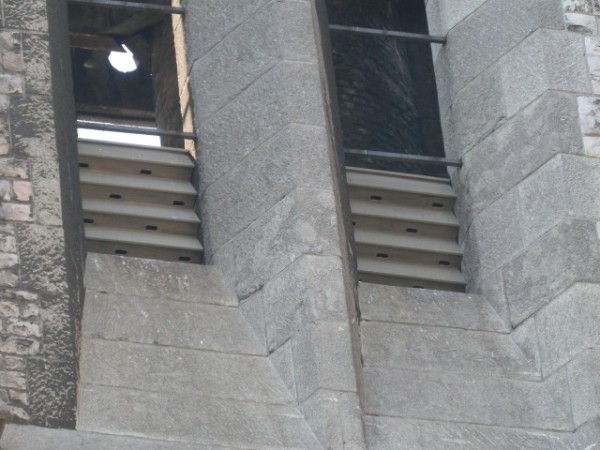 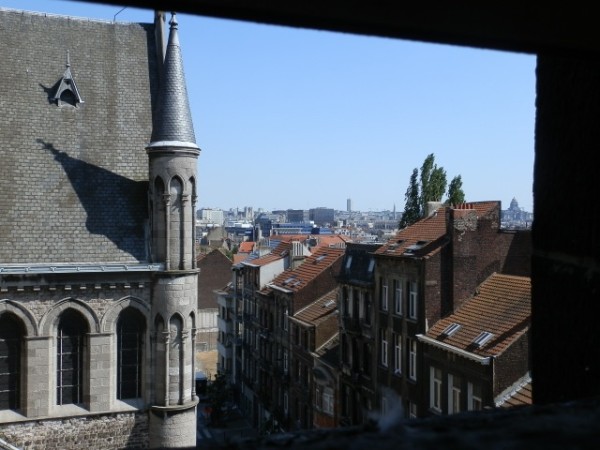
|
Swifts get 500 new nest places in Baku, Azerbaijan
|
New
Nests for the Swifts of Baku's famous 8th
Century BC Maiden Tower
|
|
The
Maiden Tower, a highly
important 8th Century BC national
monument in Baku's
UNESCO World Heritage Old Walled
City, Icherisheher,
is
being conserved after many
years of weather damage.
Holes
in its crumbling walls provided
nestplaces for about 250 Swifts
for the past 30 or 40 years. But
the conservation, when completed, will
leave only about 40 holes usable
by the Swifts.
Leyla Aliyeva,
the Vice-President of the Heydar Aliyev Foundation and founder of International Dialogue for Environmental Action
(IDEA) initiated and coordinated a special project providing the displaced
Swifts
with alternative nest places. A nearby site was selected, and the Administration of Icherisheher, through its specialist
restoration contractor
Atelier Erich Pummer GesMBH, installed
500 Schwegler Swift nest boxes.
The number of new nests has been doubled with the aim of
increasing the future population
of Baku's Swifts.
Checks
made after the Swifts finished breeding
in Summer 2012 showed that some
30 nests had been made in the new
boxes, a very promising start. In
2013 further efforts will be made
to attract more Swifts to breed
in the new nestboxes.
|
|
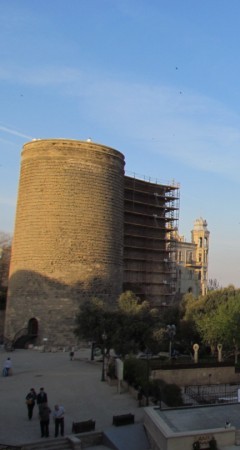 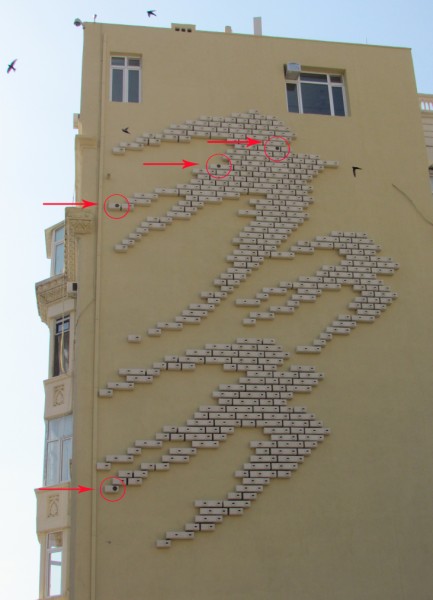
|
Left
above:
The 8th Century BC Maiden Tower,
undergoing conservation; on the
right, the new Swift nest boxes
installed on the wall of an adjacent
building
See
the video of the Swifts checking
out their new nest boxes here
Left:
Close-up showing the postions of
loudspeakers within some of the
nestboxes, used to play Swift
calls to attract the Swifts to nest
in them
Far
left: The Maiden Tower, centrepiece
of the ancient historical heart
of Baku, a UNESCO World Heritage
Site, following conservation works
Below left: Another
view of the new Swift Nest box
arrays in the shape of three Swifts
Photos © Samir Nuriyev
/ State Historical
Architectural Reserve "Icherisheher"
|
|
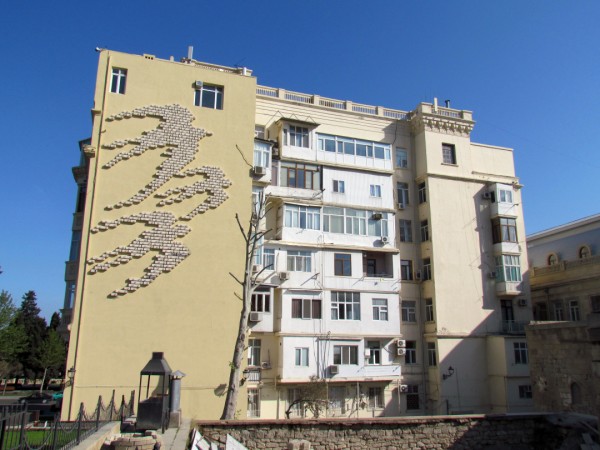
|
In order to smooth
the Swifts’ relocation, the
Tower’s conservation works were planned so that the number of
holes in the façade would decrease gradually during 2012 to 2013. In February 2012, the nest
boxes were
fixed on the wall in the shape of three
flying Swifts, to underline the purpose of the project and to enhance the appearance of the site.
The new nestboxes were
painted light beige to reflect the sunlight and prevent overheating.
Swift Conservation
provided Swift
Call CD's to encourage the Swifts to check out the new nests, and advice on how
to attract Swifts and maintain the
colony for the future.
The process of
attracting Baku's Swifts to the new nest places
may take 2 to 3 years, but the initial results are
very promising. Just 2 weeks after the Swifts’ arrival in Baku, thanks to the use
of the Swift
Call CD, several were noticed flying up to the nest boxes and some
were captured by video camera at the moment of flying into the nestboxes.
|
Berlin
2012 - the 2nd International Swift Seminars conference
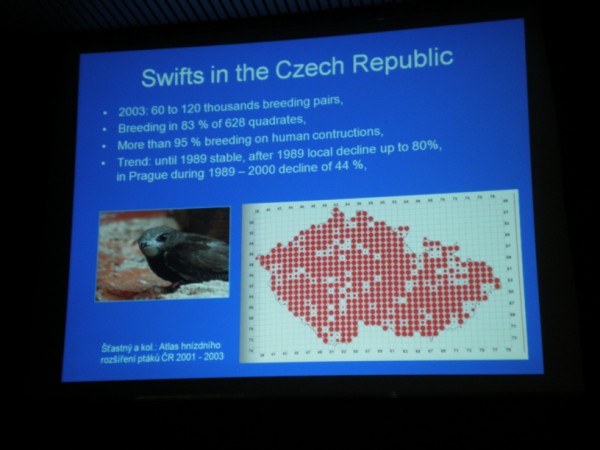
Photos © Edward
Mayer www.swift-conservation.org Presentation
© Lukáš Viktora CSO |
Swifts
are getting much more attention:
The
2nd International Swift Seminars were
held in Berlin from 10 to 12 April,
attracting 77 delegates from Europe, Turkey,
Russia, Indonesia, Israel and China, to discuss ways to
prevent further losses of this
amazing bird.
Decline
across Europe appears to be consistent,
and closely linked to trends in renovation
and insulation of the building stock.
Figures
from the Czech Republic (left) match
the UK's very closely.
|
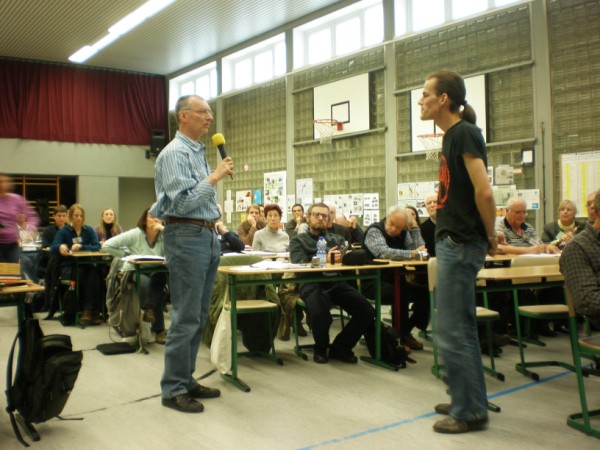
Ulrich
Tigges, conference organiser, addresses
a question to Martin Cel'uch, a speaker
from the Slovakian delegation whose
topic was "Will the Common Swift
survive in Slovakia?"
|
| Zaragoza
puts up nestplaces for Swifts
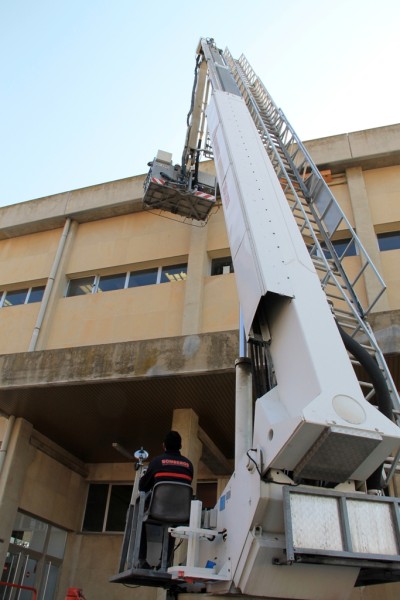
Up
go the new boxes! Brand new plywood
boxes, specially for Pallid Swifts,
are lifted to their final postion by
the Fire Brigade team in Zaragoza.
Photos
© Municipality of Zaragoza
|
The fire station in Zaragoza,
Aragon in Spain has finally saved its famous
Pallid Swift colony
Following a public appeal, helped by us
at Swift Conservation, the Municipality
of Zaragoza agreed to save the prominent
colony of Pallid Swifts (Apus pallidus)
established at the local Fire Station.
Threatened
by maintenance work, the colony became
the subject of great public interest,
and a campaign to save it was organised
by Spanish Swift enthusiasts, with support
from right across Europe.
The
campaign was successful, and the Municipality
agreed to have the special boxes made
up and installed on their fires station.
Here you can see them being put up,
the result, and the team from the Municipality
that got the job done so successfully.
We
are all hoping for a very successful
breeding season for this colony in 2012
and for a long time ahead.
Below:
The multi-disciplinary team from the
Municipality of Zaragoza that designed,
built and installed the multiple nest
boxes for the Pallid Swifts at the Fire
Station.
|
|
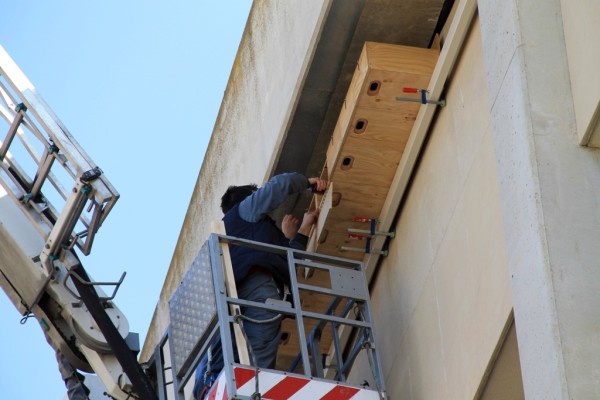
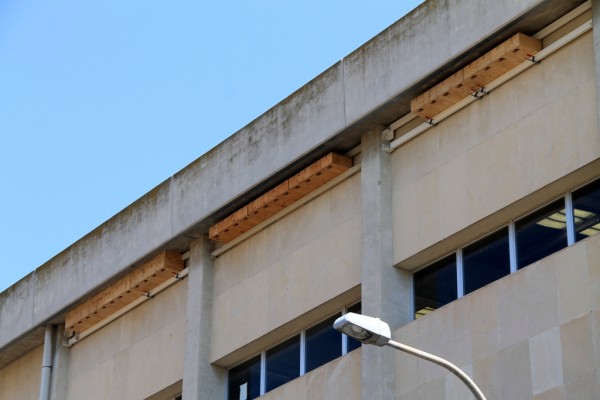
|
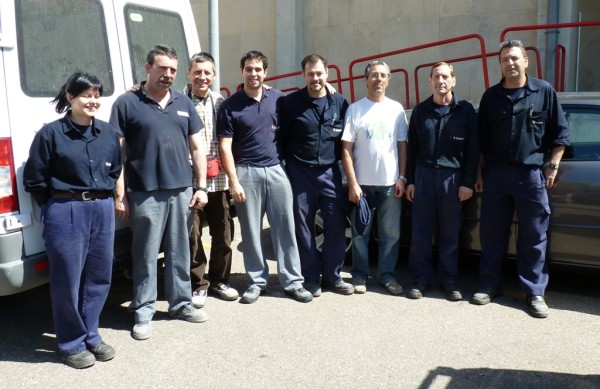
|
| St
Peter & St Paul keep Swifts safe in Lingfield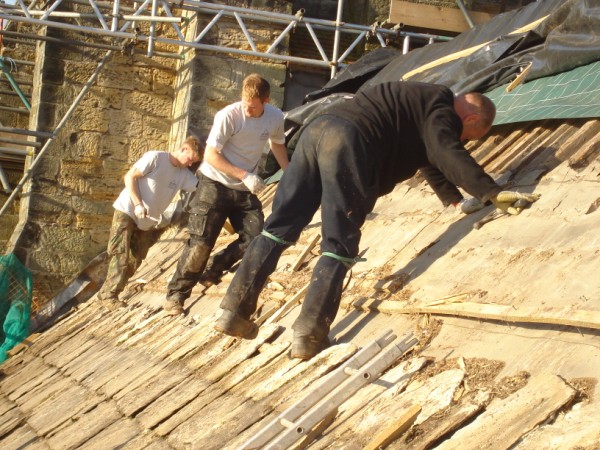
|
The
late Roland
Giddy, local Swift expert
in Surrey, was instrumental in saving a major Swift colony in
the roof of St Peter & St Paul's Church
in Lingfield.
Local neighbours
& Swift enthusiasts Ian & Pat Smith
were concerned the Swifts nesting under
the massive stone roof were potentially
under threat from renovations.
So
with the help of Richard Young of the
Church Council and Robert George, the
architect, plans were made with Roland's
help for the
colony to be saved.
|
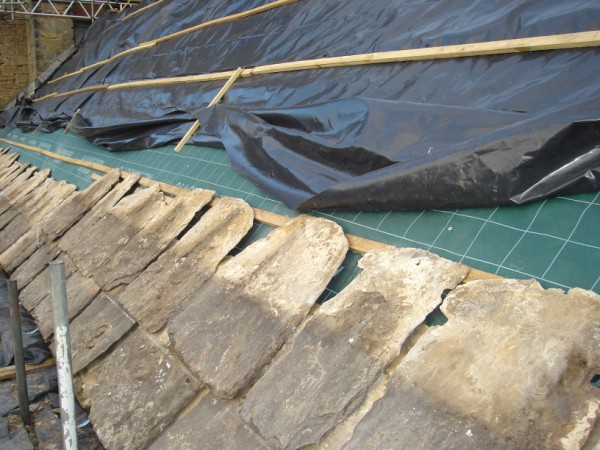
|
Lower
left: a view of the church & the
Swift roof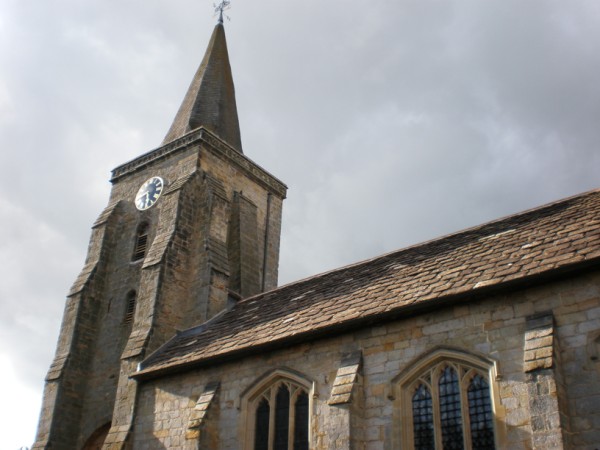 |
Heritage
Roofers Clarke Roofing Southern Ltd
(www.clarke-roofing.co.uk)
performed the works, ensuring that the
old nest places were retained.
The
old stone tiles were removed, the nest
positions between them and the roofing
membrane were noted, and retained
under the replaced stone tiles.
The
result: plenty of nest places ready
for the Swifts when they returned in May
2012.
Top
left: roofers remove the old roof, revealing
debris from the old nests.
Top right: the new roof
goes on, using recovered stone tiles
|
Lower
right: just about finished!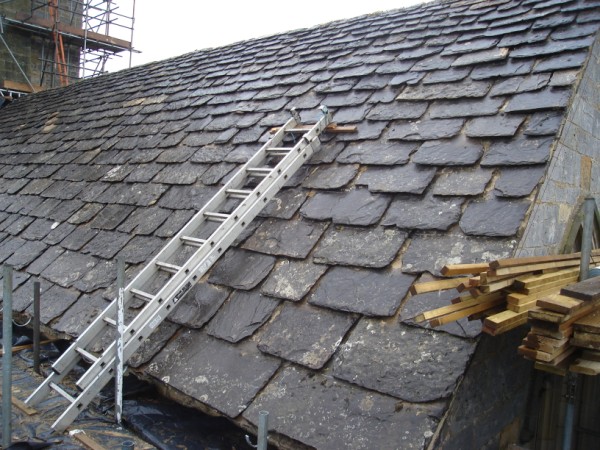
Photos
(roof) © Ian Smith; (church) © Edward
Mayer |
|
Guernsey's
Swifts get a Reprieve
Vic
Froome, our man on Guernsey, has helped
save a major Swift Colony
Demolition
of the housing estate had already started
when residents spoke up for their Swifts.
With Vic's help, it was swiftly agreed
that the demolition would stop, and
the Guernsey Housing Association allowed a further
delay of six weeks to enable the Swifts
to fledge and fly off to Africa. Even
better, the Housing Association agreed
to buy 50 Swift nestboxes, and
then the building contractor J W Rihoy
put them
up for free! Even more good news,
Vic has been asked to give a seminar
to all the property professionals involved,
on buildings and biodiversity, and he
has also been asked to advise on stage
two of the project. You couldn't ask
for any more!
|

|
|

Left:
Swifts' nests found under the tiles
of the old housing estate demolished
to be replaced by the new one (right).
You can see the four new nestboxes
just under the eaves.
Upper
right, Vic, his work and the estate
featured in the Guernsey Times, a great
victory for common sense local conservation
and for the Swifts too.
Photographs
© Vic Froome
|

|
|
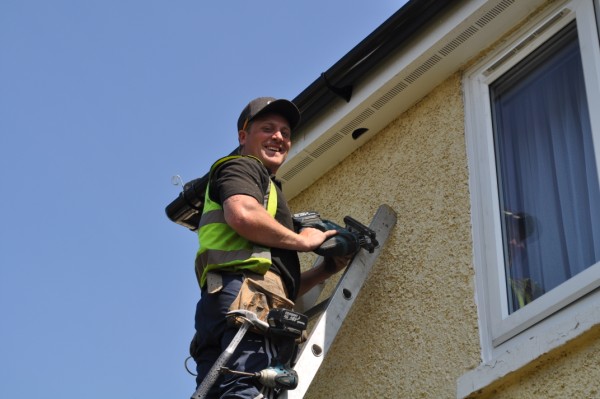 Photograph
© Beth Hales
Photograph
© Beth Hales
A
Niblock Building Contractors roofer
cuts a hole for Swifts to continue nesting
in eaves at the Village Park Estate
in Ealing. This hole is a special one
to resist entry by Starlings but let
the Swifts get back to the same nest
sites they used before the old wooden
soffits were replaced with the modern
Upvc ones. You can contact Niblock here.
Swifts usually
only nest in pre-1944 buildings. But
modernisation of these
has lead to a massive drop in their numbers. Swifts create a sense of well-being and
eat up lots of harmful insects. They
are well worth saving!
|
Ealing and Niblock get it right first time... with
a little help from Beth!
Beth Hales, of the Village Park Estate in South Ealing, tells
us how she saved the Swifts on her
estate: We had been given notice that our roofs would be repaired under the Decent Homes
programme.
As I stood chatting with site manager Mark Lenzi, of
contractor Niblock, I looked up and noticed the
Swifts. I asked: “what will happen to the Swifts as they nest in the
eaves”. Mark was sympathetic, but had no power to change
the plastic soffits that would close the eaves. I decided not to let the issue go that
easily, as I had spent the
last 18 summers enjoying watching them.
I got in touch with local
RSPB member Peter Bird and the author of the Birds of Ealing, John Green.
Together with resident Gary Fisher we wrote to the leader of the Council. At
the same time the Swifts were becoming a topic in local Council and wildlife
meetings. Within days the Council was talking to the building contractor.
With the Council on board, Mark Lenzi agreed my suggestion to bring
in Edward Mayer of Swift Conservation, who advise architects and
builders on how to keep or encourage Swifts to nest.
So I found myself squeezed into a
portacabin along with 17 roofers to hear a presentation on Swifts. I wasn’t sure
if they would take it seriously but as Edward began they quickly became engaged
and the talk moved on to the technical details.
The result? Niblock installed 70 Swift holes and two summers on it goes to show how an
action as simple as cutting a small hole can have such a dramatic impact on
local wildlife. The Swifts are still with us!
|
|

|
A Very
Nice Swift Story
SWIFTS by Abbie Hart aged 6 years and 1
month
Once there was 2 poorly swifts and then my Mum saved them and made them
better. She let them go, but one of them couldn't fly. And then she made it
better and she let it go. They ate lots of insects and waxworms. They were
happy. They played with their friends in the sky and they flew past every day,
so we knew they were better. But they went to Africa for the winter where it was
warm. All the time they were thinking about us. They wished they could have more
waxworms. They were too happy now. They will come back in April or May. We will
be happy when we see them again. And, if they come back in May on my Mum's
birthday, they might be happy. And, they are good at flying now - they used to
not be. And it's good to fly, because everyone wants to fly. They fly even when
they are asleep and eat little bugs in the air. I love the Swifts so much, they
will come back soon because it's nearly Spring. It's good when it's Spring. The
Swifts are always happy, they love it. They just love drinking and they are
black. They love us and my Dad is making a nest box for them. My Mum says that
they are her favourite bird, but they're just my second favourite. My favourites
are Long-Tailed Tits and Sparrows and the beautiful Swifts. Drawings
© Abbie Hart |

|
Where
Swifts still nest in ancient trees..... the Bialowieza
Primeval Forest, Poland
|

|
In
2011 we visited the magnificent Bialowieza
Primeval Forest in North East Poland.
What a superb place!
And what
a surprise too as this ancient forest,
where trees are allowed to die and fall
and rot naturally, has a resident population
of nesting Swifts. In 1985 to 1994 this
was estimated as 600 to 700 pairs. These
Swifts nest mainly in holes in
Hornbeams and sometimes Conifers on
open flood plain areas.
They
breed in groups of a couple of pairs,
quite unlike the large colonies
they set up in big buildings, but
similar to a typical suburban Swift colony.
We
think that this is how Swifts bred before
we deforested Europe and eliminated
all old and dead trees from our modern
managed forests. Of course, Swifts
nest in crevices in cliffs too, but
we have never seen large colonies in
such places.
Visit Bialowieza
soon - such beauty cannot last.
|

Above:
Swifts' nest in an old Great Spotted
Woodpecker nest in this ancient
pine. This is at the
RSPB's Abernethy Reserve in Scotland
where a few
Swifts breed in tree holes, believed
to be unique in the UK.
Photos © E
Mayer / Swift Conservation (left)
&
John S Wilson (right)
|
The
National Archives hopes to host Swifts at Kew with
its new nest boxes
|
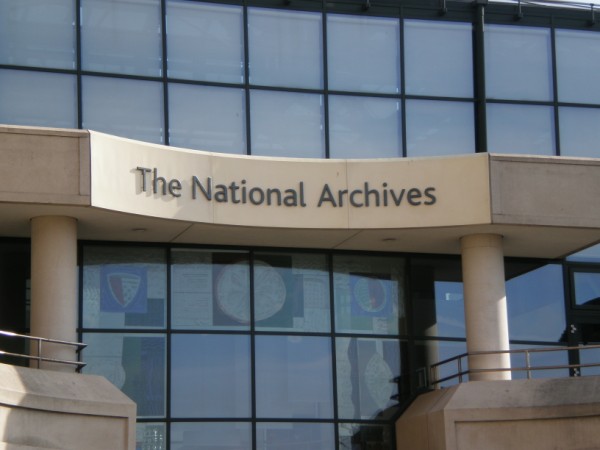
|
The
National Archives at Kew have installed
some Swift nest boxes!
They
are the brainchild of Christine
Berry, a keen wildlife enthusiast
who works there. Christine contacted
us and we did a site survey. We
recommended locations and techniques
to attract the Swifts to them.
Situated
right by the Thames the site is
ideal; it already hosts a good selection
of wild birds and other creatures,
and has pools and gardens of its
own to shelter them.
Photos © E
Mayer / Swift Conservation &
Christine Berry / National Archives |

|
WWT
puts up Swift Boxes on its Tower Hide at the London
Wetlands Centre
|

|
Swifts
should love these nest boxes built
beneath the eaves of the Tower Hide
at the London Wetlands Centre just
across the Thames from Hammersmith.
The
pools of the Wetlands Centre provide
masses of flying insects for
Swifts to feed on, and many Swifts
already visit the Centre just to
feed.
On
the left you can see two of the nest
boxes fitted to the Tower Hide; on the
right you can see, open, the CD player
system that plays Swift calls to attract
new birds to look for vacant spaces.
Photos ©
Wildlfowl
& Wetlands Trust
|
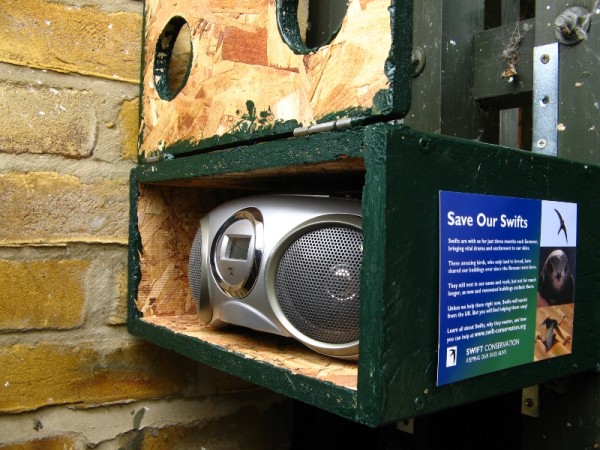
|
Swifts
get a Tower at the Hawk Conservancy Trust in Andover
|
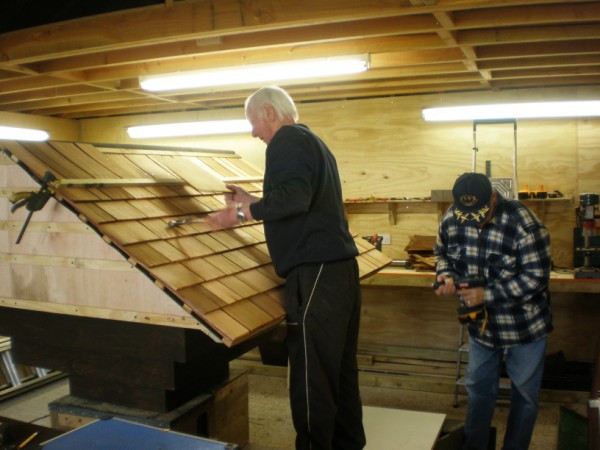
Here
we see Terry and his team mate Ray
putting
the shingles onto the second tower
on the production line.The first
tower, set up with help from HM
Forces, is on the far right. In
between is Cheyenne, one of their
superb Bald Eagles, after her long
range flight display.
Photos © E
Mayer / Swift Conservation
|
Staff
at the Hawk Conservancy Trust at
Andover in Hampshire have taken
up the challenge of making and erecting
one of the Swift Tower concept designs
prepared by Dick Newell of the Ely
Swifts Group and featured elsewhere
on this web site.
Inspired
by one of our lectures, they devoted
their time and effort to making
this superb structure which holds
30 nest places under a roof covered
in Western Red Cedar shingles.
Visit
the Hawk
Conservancy to see the Tower
and lots more - their flight displays
of raptors are just amazing!
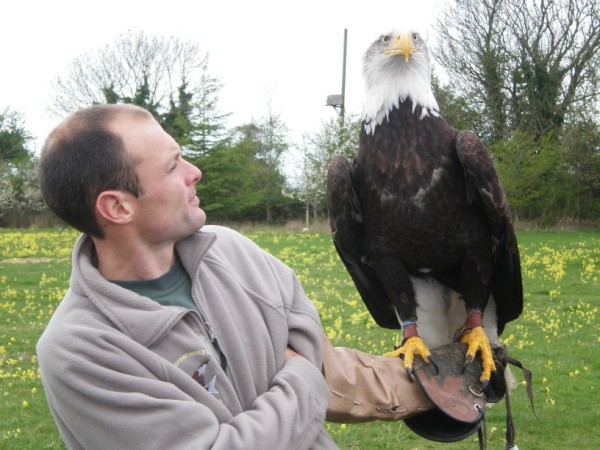
|
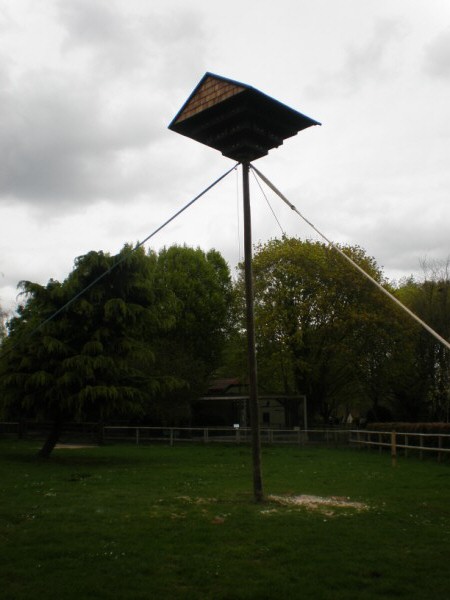
|
Dulwich
Park's Buildings are fitted with Swift nestboxes
|

|
Dulwich
Park's Friends have made a big commitment
to Swift conservation by fitting
one of the buildings in Dulwich
Park with Swift nest boxes and an
associated hifi system to play Swift
calls to lure the birds in. Seven boxes were
installed; six Schwegler No.18's (plus the hi-fi system) and one Filchris
nestbox. Southwark's Parks department
arranged for the installation.
Watch
this space!

|

Photos © Steven
Robinson
|
|
Tesco
Puts up a Swift Tower in Crumlin, Northern
Ireland
|
|
|
|

|
Brian Cahalane, a member of the Northern Ireland Swift Group wrote
to Sir Terence Leahy, CEO of Tesco Plc, and explained to him why Swift numbers
were falling through out the British Isles and asked if Tesco could help.
Sir Terence replied sympathetically
and
discussions began resulting in this magnificent tower.
The Northern Ireland Swift Group wishes to express their appreciation to
Tesco Plc. who funded the project. Thanks
to their awareness of the biodiversity in the area, Swifts in Northern
Ireland now have twenty new nest boxes which will help their numbers increase
in
Crumlin.
A plaque will be placed below the tower explaining its purpose and
giving information on this magnificent bird, Already it has been visited by
school children from the local schools.
It
is hoped that Tesco's example will encourage other supermarkets to
follow their lead.
Photos © Brian
Cahalane
|
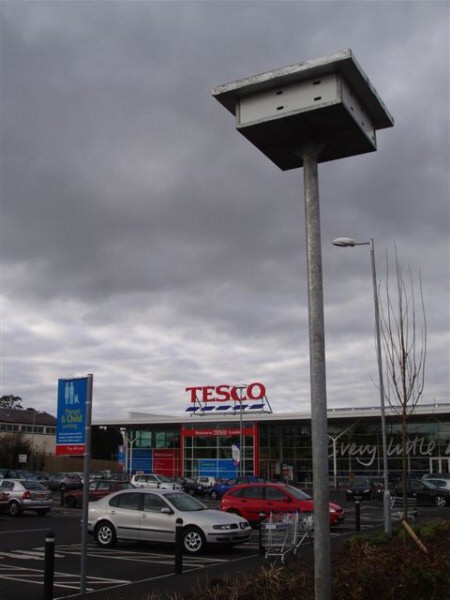
|
Hannover's
Bethlehem Church gets Swift Nest Boxes!
|

|
Rose-Marie
Schulz, a Swift Activist in Hannover,
Germany, has been running Swift
projects for some years now.
Here
is her latest, fitting 24 nestboxes
to the Bethlehem Church, with the
help of a large team of helpers,
some shown here.
You can
do the same! With a little help
from your friends and some recycled
plywood you can build boxes for
Swifts and install them in your
local landmarks.
There's
not a minute to be lost.......
Photos © Rose-Marie Schulz |

|
Stevenage's
Lister Hospital & the London Olympics get Swift Nest
Boxes
|

|
Herts
& Middlesex Wildlife Trust, working
with the Lister Hospital Board and Osborne
Construction, have completed installation
of eight Swift nest bricks in the new
maternity unit at this hospital in Stevenage.
It
is this sort of thoughtful planning
that is going to save Swifts here in
the UK, as inaccessible new buildings replace
their old homes in open timber eaves
and gables.
We can ensure them
a future only by building in special features
where Swifts can breed.
But it's easy
and it's cheap too!
Photos © Tim
Hill HMWT
|

|
|

|
We
worked with the London Olympics
2012 project starting in 2004, with
the aim of providing nest
site location advice and training as
part of their commitment to biodiversity.
We
eventually got 70 + Swift nestboxes
installed at various places on the site.
Here you can see an
installation of six nestboxes under
one of the bridges leading to
the Olympics Stadium.
Photos © E
Mayer Swift Conservation
|

|
New
Swift nest place projects, old and new, from Belgium
& Italy
|


|
Scaffold
Pole Holes = Swift Nests!
Swifts
in Brussels have adapted to use a feature of
Belgian architecture. Round
(or square) holes were placed under the eaves of older
buildings, to provide ready-made locations
for the timber scaffold poles used whenever
the building needed
renovation.
They
were often covered with a decorative
feature. On the left you can see one,
a carved stone plug in the shape of
a lion's head. With the plug slightly
open, access is provided for a Swift
to nest inside. On the right you
can see a line of these holes; some
were converted to Swift nest places,
two are still plugged, two
have lost their plugs.
No
longer in use for scaffolding, they are in peril of
being lost when repairs are made. So
Belgian biodiversity activists and professionals
are encouraging their conversion to
nest places for Swifts, House Sparrows and
Black Redstarts. With some success!
|

Left
- Photos © Jean-Claude Hardy
Above
- Photo
© Aline Spriet
|
|

|
New
nestholes a-plenty in Melegnano!
Left:
St. John the The Baptist's Church in Melegnano, a small town very close to
Milan, where all the old scaffold holes in the walls of the bell tower were
modified to provide nest places for Swifts.
These holes are an integral
part of historic structures, and were
used to support timber scaffold beams.
You can see how they have been made
smaller with little pieces of brick,
cemented in. This gives a permanent,
safe, low-cost refuge for breeding Swifts,
while excluding feral pigeons.
Everyone
concerned with this project is hopeful
that this idea will catch on across
the whole of Italy, and also in other
Mediterranean countries where these
scaffold holes are still commonplace.
|

Photos © Arch. Gaetano Arricobene
Project
Advice & Design: Mauro Ferri of
the
Veterinary Service / Local Health Agency of Modena, and Luca Ravizza, Municipality of Melegnano
Client: The Parish of Melegnano
Contractor: GASPAROLI
s.r.l. (Gallarate, VA),
Project Manager: Arch. G. Arricobene
|
|

Photo
©
Eve
Templeton
The
colony's nest holes can be seen under
the eaves and also under the window
to the right of and just below the tower.
|
Swifts
get a Good Deal in Cortona, Italy
A
Swift enthusiast who is
setting up her own colony at home
in the UK, has sent us these pictures
of a D I Y Swift colony she spotted
on her travels in Italy.
"When
I was in Cortona, Tuscany, a couple of years ago, I saw purpose-built
Swift nest holes in houses. As a result there was a huge colony
of Swifts. They used to wheel over the high point of the hill town,
screaming. Fantastic."
Colonies are easy to create when renovating
a building. The holes can be drilled
with minimal vibration and mess from
outside using a diamond core drill .
Nestplaces or boxes can then be
created in or on the interior walls.
Most
have the nest boxes totally
hidden within the wall, as shown on
the right. The holes may be used during
winter by other species as roosts.
Tits, Wrens and Sparrows may seek shelter
and manage to survive in this way.
These
projects can help to replace Swift nests
lost in other building re-developments,
& vital if Swifts are to survive!
|

Photo
©
Eve Templeton
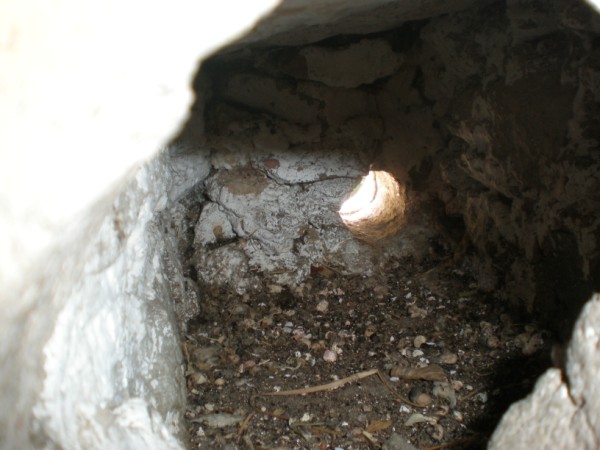
Photo
©
Edward Mayer
|
|
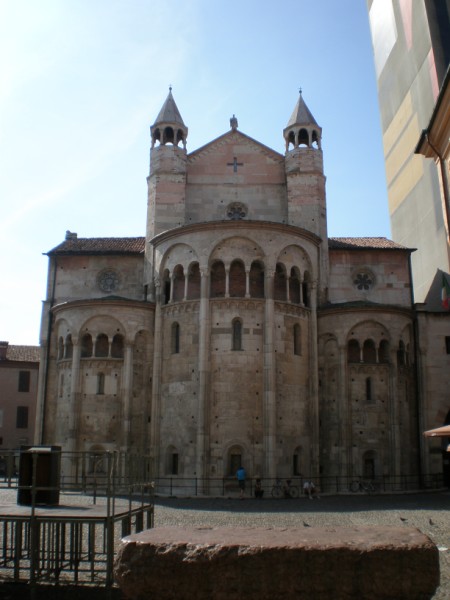
Photo
©
E Mayer
|
New nests for Swifts in Modena,
Italy
Modena,
an exceptionally beautiful city,
has a wealth of ancient historic buildings
of supreme cultural value. Amongst these
is the Cathedral and its Tower.
The
Municipality, advised by specialists
of the Veterinary Service of the local
Public Health Agency, made plans to
retain the Swifts nesting in the scaffold
pole holes of the magnificent Cathedral
Tower. A major aim was to exclude feral
pigeons, whilst encouraging Swifts and
Bats to roost and nest.
On
the left you can see the Cathedral and,
far right in the photo, covered in hoardings,
its Tower. On the right you can see
the technique used to convert the scaffold
pole holes from places that could shelter
feral pigeons to ones that can provide
nests for Swifts. All that is required
is again the insertion of a piece of brick,
but cut to the right size.
Simple,
cheap, effective! So why doesn't everyone
do it?
|
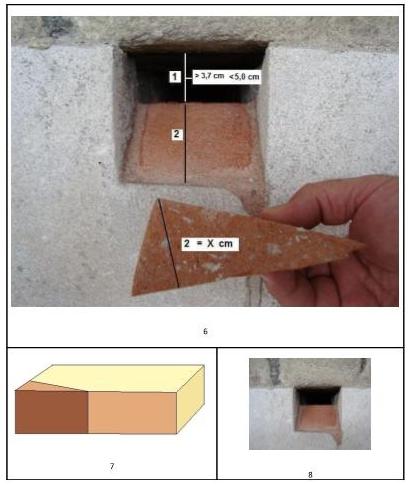
|
|
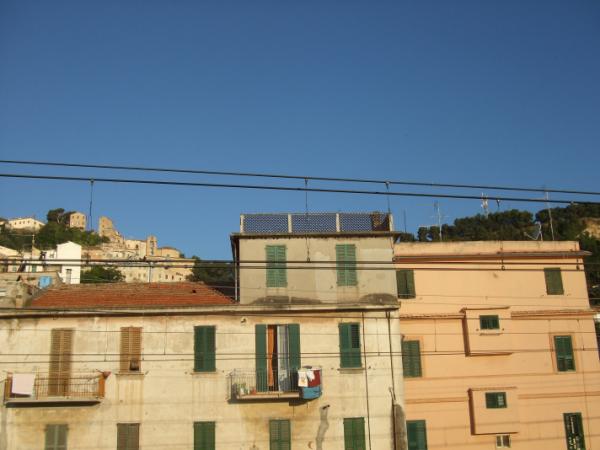
|
More Swift Houses in Grottammare,
Italy
Margaret
Jarvis, who lives in Grottamare, Italy, spotted
Swifts around a house by the railway
tracks. Here is what she saw! Some
brilliant person adapted this building
for Swifts. We know of lots of Swift
Towers in North East Italy, but this
is the first such site we have seen
in the Appennines. Are there more? Find
out and tell us!
Photos ©
M Jarvis
|
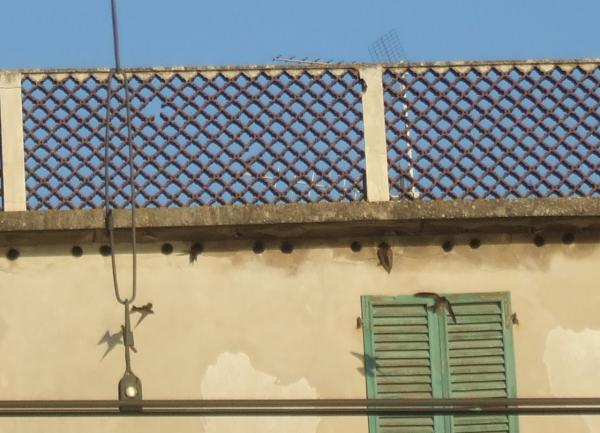
|
|
|
|
 
Midges
and Aphids make up almost half the items
taken
by Swifts for their young
in Antrim, Northern Ireland
Top
- Chironomid Midge
©
Entomart;
Bottom - Aphid giving birth
©
MedievalRich
|
What do Swifts eat? Mostly
Midges and Aphids
As
part of continuing research into Swifts'
diets, amateur naturalist Marian James examined 10 pellets excreted
by the juvenile Swifts in Mark Smyth's colony
in Antrim, Northern Ireland.
The results were as follows: There were in total 897 items or identifiable
categories:
Chironomids 25.7% - non biting midges (possibly Lough Neagh fly) 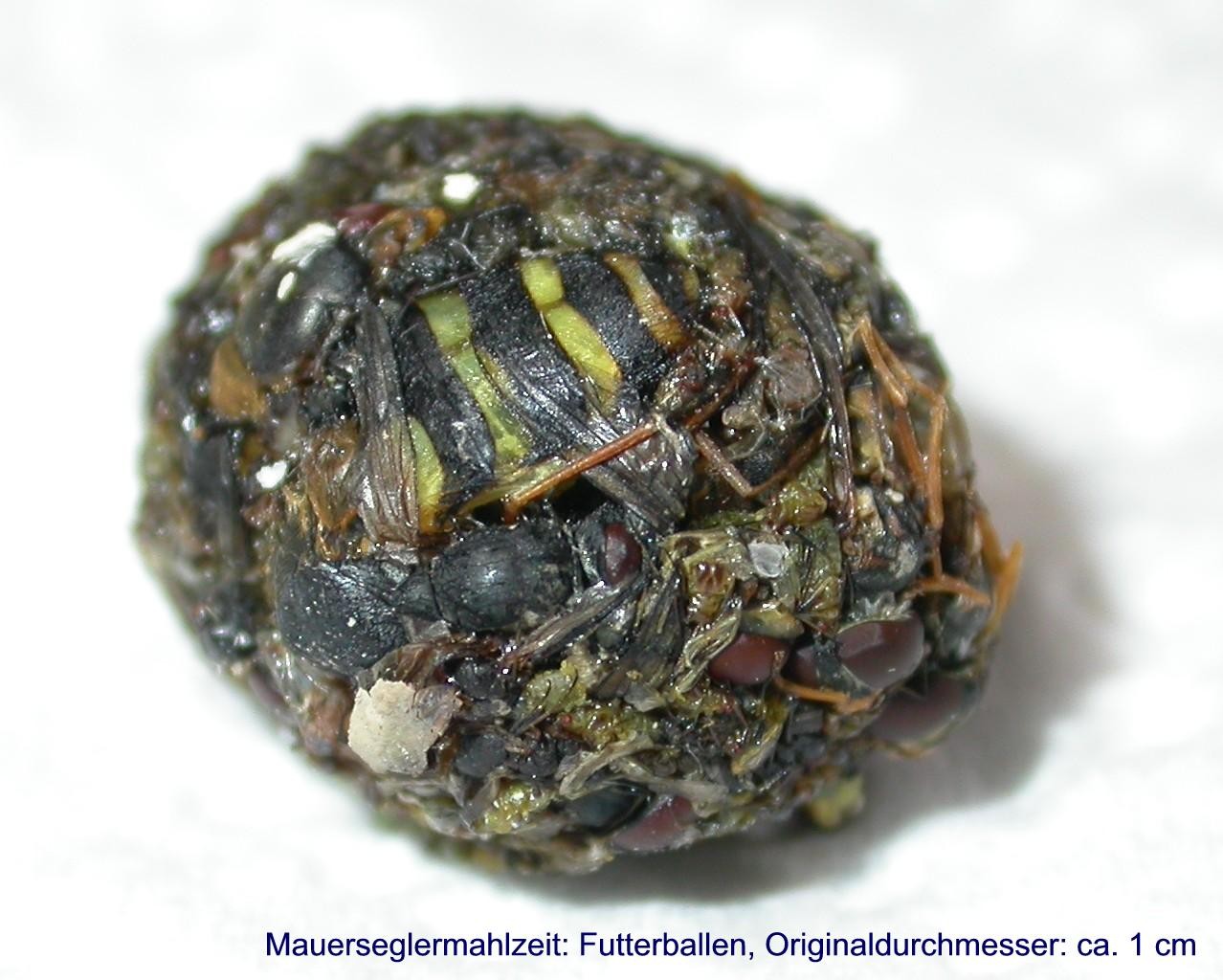
Aphids 18.0%
Psyllids 11.6% - sap
sucking insects
Lonchoptera 11.5% - small spear-winged flies
Coleoptera
11.1% - water beetles
Phoridae 0.8% - hump-backed flies (resembling fruit
flies)
Sciaridae 0.7% - fungus gnats
Dolichopodidae 0.4% - long-legged
flies
Muscids / Calliphorids 0.4% - house & stable flies / blow
flies
Scathophagidae 0.3% - dung flies
Hemiptera 2.1% - bugs
Tipulid
0.1% - craneflies
with traces of
Hymenoptera - small solitary wasps
Coccinellidae - 11
spot ladybird
The
majority of catches was of very small, weak fliers which become wafted
by air currents and cannot escape. There was also evidence of spiders,
presumably caught at their dispersal or "ballooning" stage. We can see
that in Antrim, Swifts are catching a wide range of flying insects for
their chicks, but that the biggest percentage is of midges hatching
from the local lake. The photograph of the food ball above right shows
it is composed of a wide variety of flying insects, including a very
large hoverfly, caught and compressed into a near ball which is then
fed to the chicks, often in one go, several times a day.
|
|
|
Neat
and New! Swift nestboxes for traditional house eaves
|
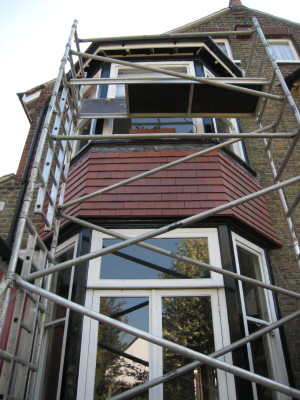
|
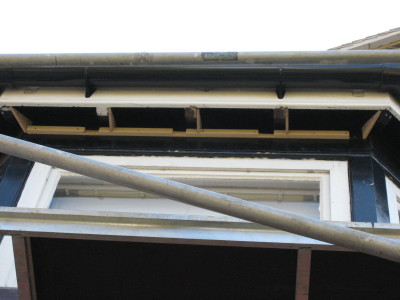
|
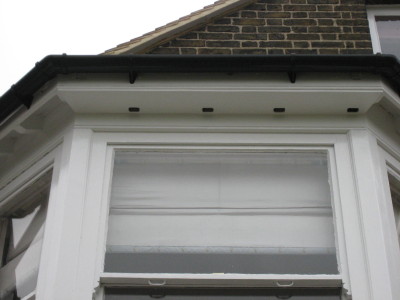
|
|
The late
Roland
Giddy converted his eaves to house
4 pairs of nesting Swifts - he used a scaffold to access the eaves, and
boxed them in with integral
nesting
platforms (see right).
Above
right - the result - a neat and sound home
for the Swifts, fitting in nicely with the
eaves detail.
|
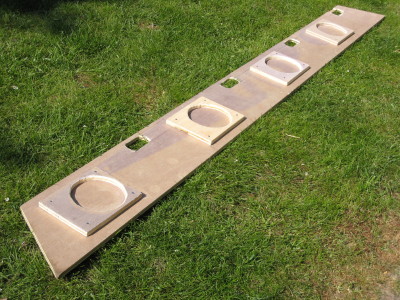
|
This sort of conversion to
provide nest places for Swifts replaces
others lost
during re-roofing. It's low-tech,
low-cost, easy, long lasting and effective.
If eveyone did this when they renovated
their house then Swifts wouldn't have lost
half their UK population in the past 20
years.
Photos
© Roland Giddy
|
New
Swift Colonies set up in M'dina, Malta
| Following
a cessation of the infamous Spring
Shooting Season in Malta in 2009 (it has been reinstated
this year) Swifts bred in M'dina.
Mario Gauci discovered their nest, (below).
|
A
Swift flies over M'dina, Malta - not normally
the
best place in the world to be a wild bird!
Photos
© Mario V Gauci
|
Determined
to assist Swifts, Mario started a nest place
project - a series of Swift nestboxes fitted
into old ventilators on a building facade.
As you can see, the Swifts are already interested!
|
| 
|

|

|
Camden
Council builds for Swifts
|

|
Camden
Council has installed 10 nest boxes at
their Regent's Park Estate to help reverse a decline in Swift populations.
"One
of the reasons for the decline is modern construction practices which
render once-accessible nesting sites under roof eaves inaccessible. The
installation of Swift nesting boxes in high-rise buildings is seen as
one way to counter-act this problem, providing suitable nesting sites
for this fascinating bird. In Camden, local surveys have established
the Regent’s Park area as a population stronghold. Using the
opportunity we combined our high-rise insulation programme on the
estate with the installation of these specially designed brick-boxes."
Camden tell us that more installations are planned
throughout the Borough. This is splendid news and we
hope this project will be a trend-setter throughout
the UK and in the EU too.
Photo
© London Borough of Camden
|
|
Swifts
get more new homes in Northern Ireland
Swift
enthusiasts Norman Watterson and Adrian McElhone have been working
on a new Swift nestbox scheme at a modern industrial
building on the shores of fly-rich Lough Neagh, in Northern
Ireland. Swifts gather from miles around to feast on
the Lough Neagh flies. The new one-piece nest box has 12 separate compartments
for the Swifts; their food supply can be seen waiting
for them!
|
|
|
|
|

|
On
the left you can see the 12 place nest box
before it was fitted to the roof edge of
the Ballyronan Marina facilities building (right).
The
myriad black specks visible are the famous
Lough Neagh flies, which hatch from the
waters to provide food for thousands of
Swifts.
It
is believed that Swifts fly in from as far
away as Scotland to feed on this amazing
resource.
Photos ©
Mark Smyth
|

|
|
Ideal
Homes for Swifts in East Dulwich, London
| 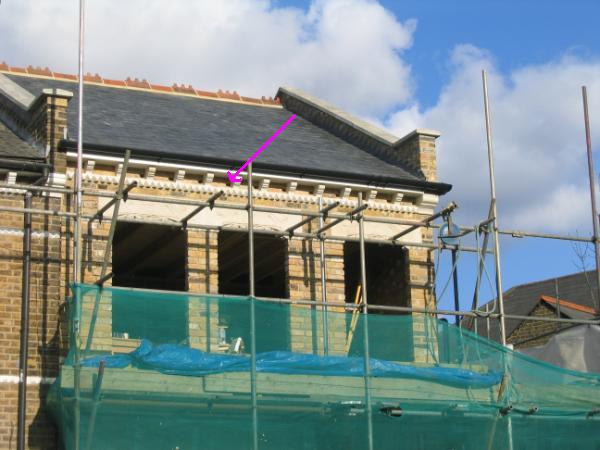
|
This
Victorian terraced house has been ingeniously renovated
to provide excellent accommodation for Swifts. The
arrow points to one of eleven Swift nest access holes,
built in to the under-eaves brickwork. This
is the creation of George Mavrias, who as you can imagine,
is keen on keeping Swifts flying over his home! It goes
to show that where there's a will there's a way, and
Swift nestplaces can be created and sustained in nearly
all types of buildings.
Photos ©
George Mavrias
|
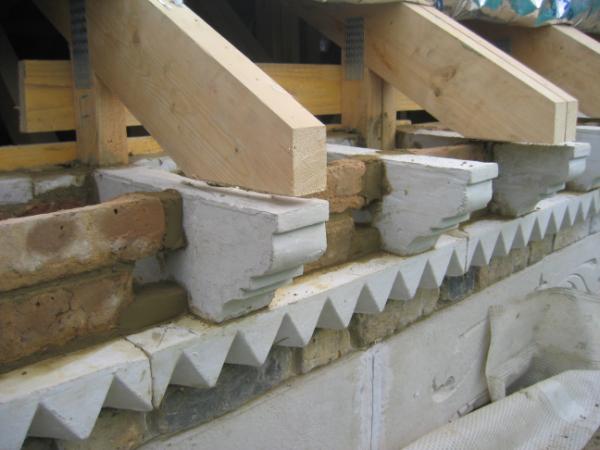
|
|
|
|
|
Success
for Swift Attraction Calls CD
Brian
Cahalane of Northern Ireland set up his own Swift colony
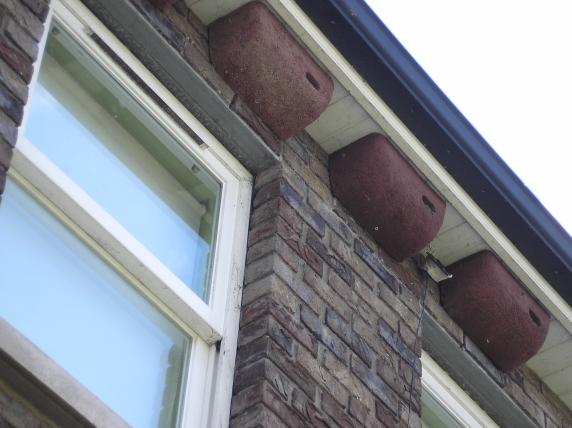 He
used a Swift Calls CD to
attract the birds to a previously unused nesting area. He
used a Swift Calls CD to
attract the birds to a previously unused nesting area.
This is how he did it - you can do it too! Photo © Edward
Mayer
"It is usually relatively easy to attract Swifts
to new nesting boxes by using a calls CD. Play the CD on a CD player
linked to a separate amplifier, use cheap speaker cable and as many speakers
as possible, each one right beside a nest box. I often have twelve speakers
going at once. I bought the cheapest and
smallest speakers you can buy. Play from late April onwards, continuously from dawn to
darkness as loud as you dare, and you will
attract Swifts. But it may take two seasons for them to nest.
I
have been able to attract Swifts from a half mile away and more. I
conducted a simple experiment using my wife and son and mobile phones.
One was positioned at the house, the other a quarter of a mile away,
and myself a half mile away. It's almost a straight line from my house
to the centre of the village.
A phone call from myself and the CD was switched on at my house at full
volume, I could hear it in the village. Swifts began to move towards my
house and I could observe them through my binoculars, when they passed
my wife she rang me, and when they arrived at the house my son rang me.
I have 24 potential nesting sites and often have as many as ten
speakers playing at once, positioned at ten boxes. I now have a colony
established!"
Swift
Conservation supplies a Swift Calls CD using recordings from Ulrich Tigges' Berlin Swift Colony. To
order click on the Swift button below.
 Order a Swift Calls CD - click on the Swift!
Order a Swift Calls CD - click on the Swift!
 Click on the Swift
to learn how to use the Swift Calls CD
Click on the Swift
to learn how to use the Swift Calls CD
|
|
 For further information contact
Swift Conservation
For further information contact
Swift Conservation
 Back to Contents
Back to Contents
Thank you for your interest - Please help Swifts
|
|
|
































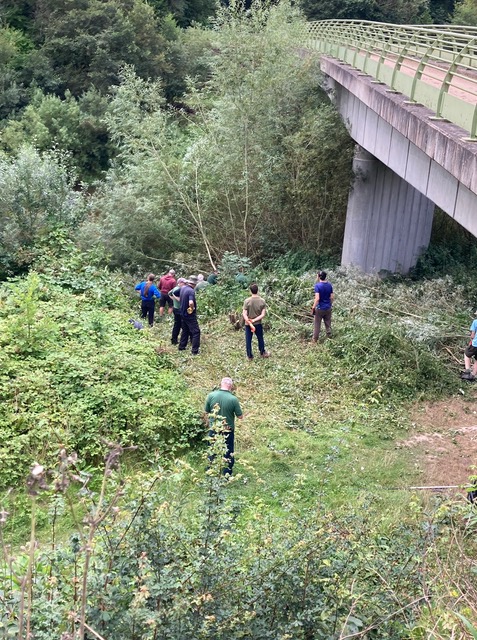





















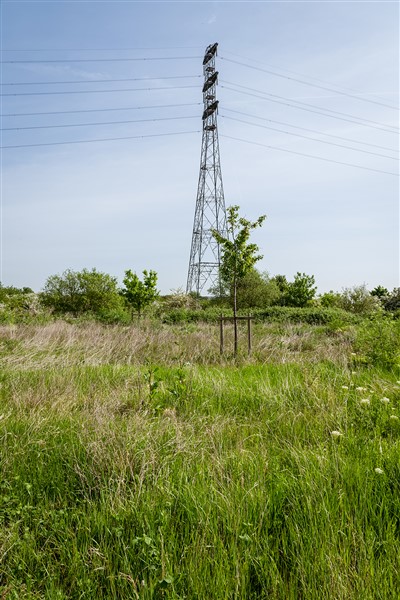

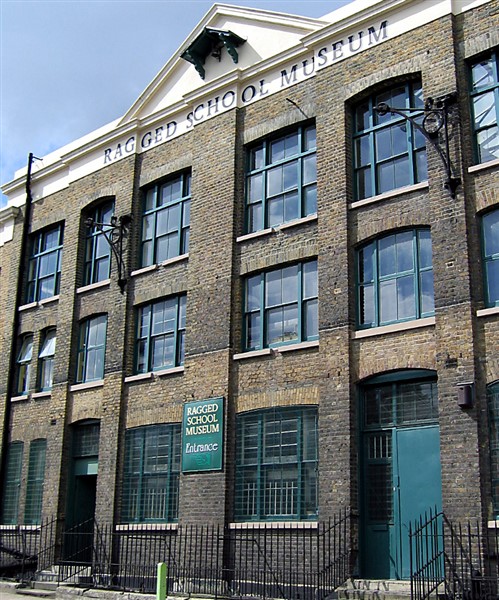




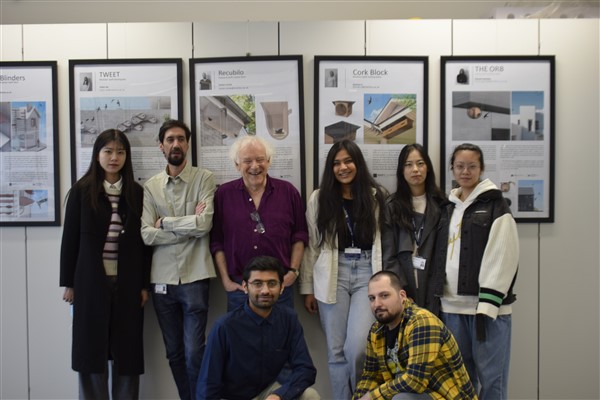

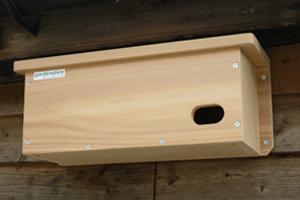

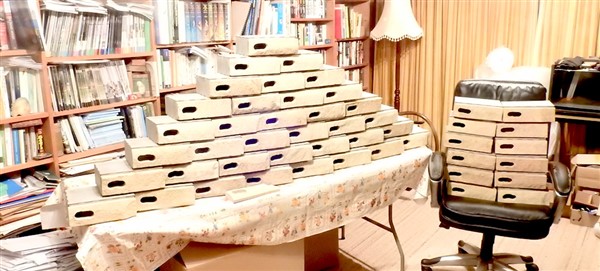
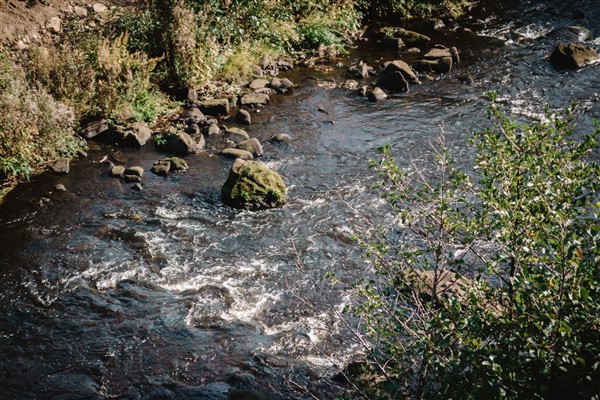
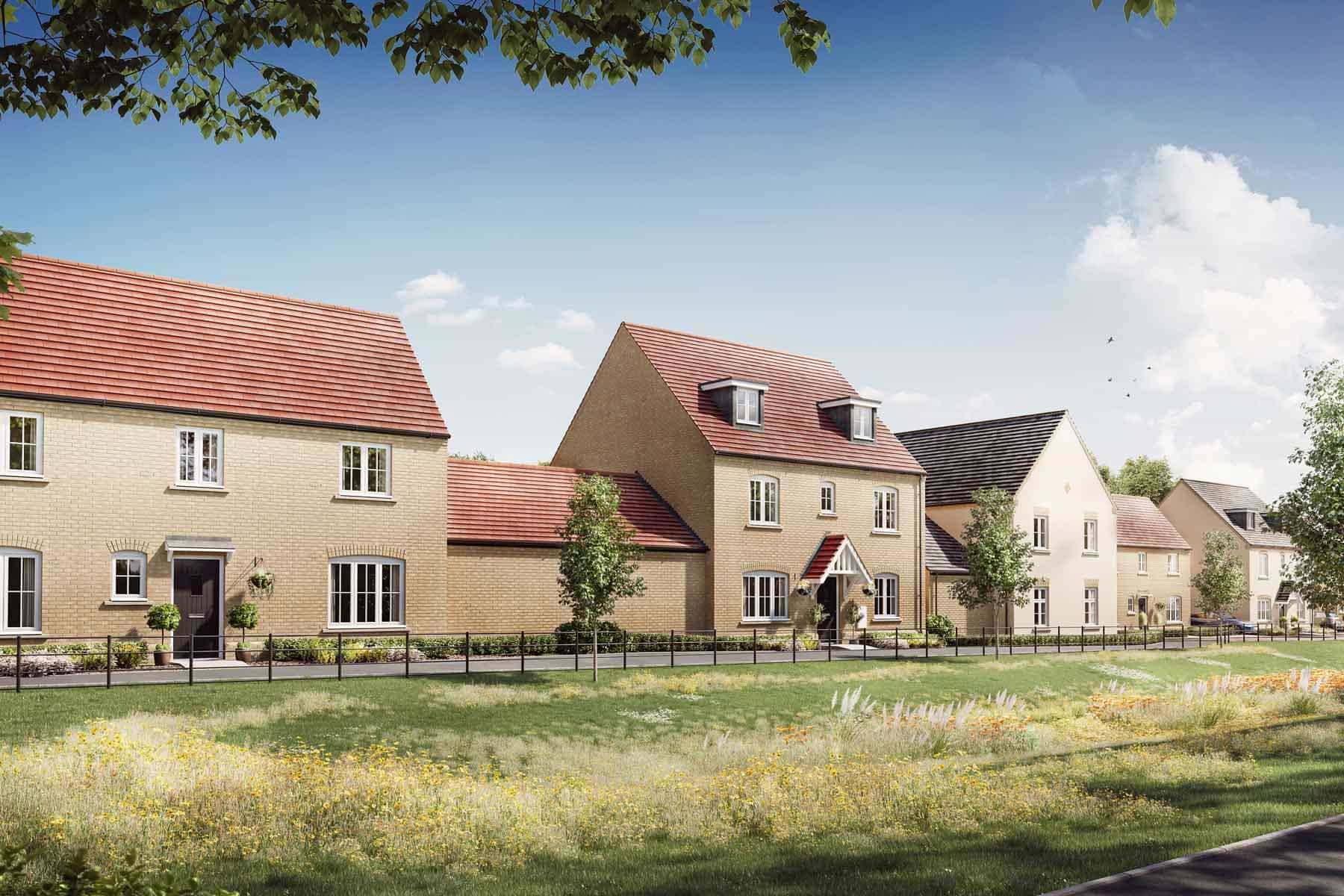
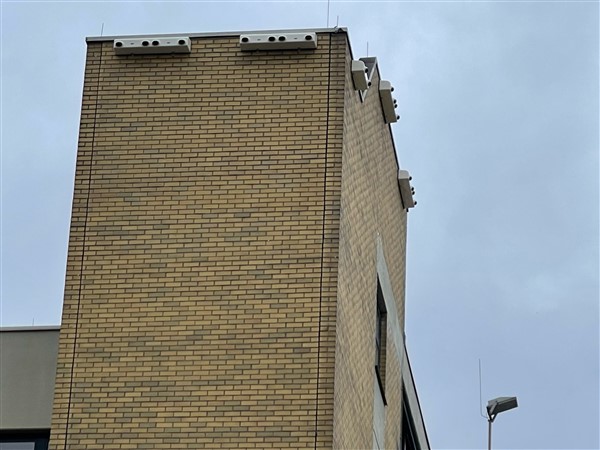


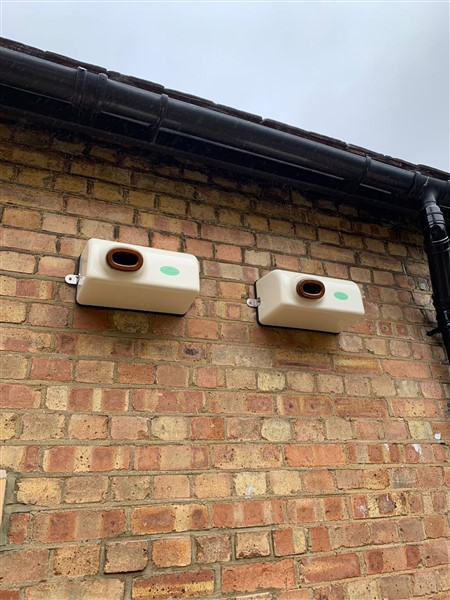

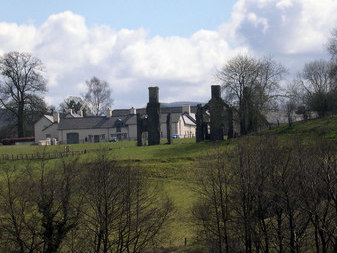
 Reed St Mary Church near Royston and Cambridge in North Hertfordshire.
Reed St Mary Church near Royston and Cambridge in North Hertfordshire. 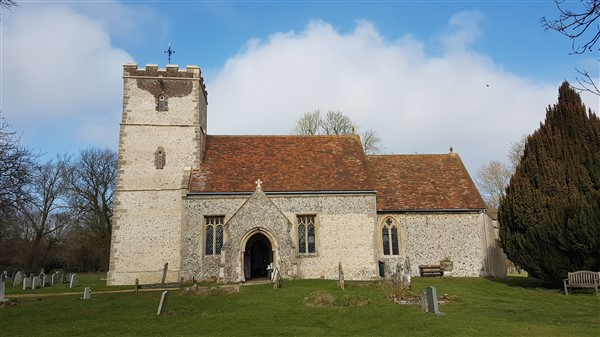
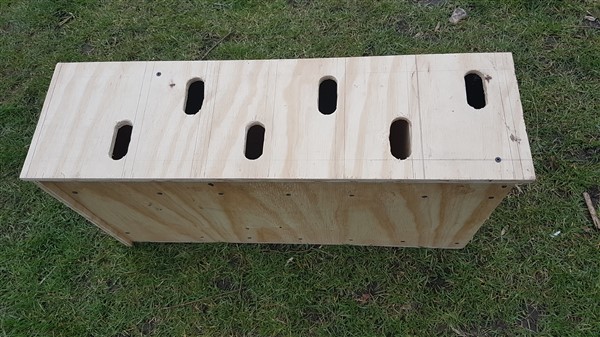


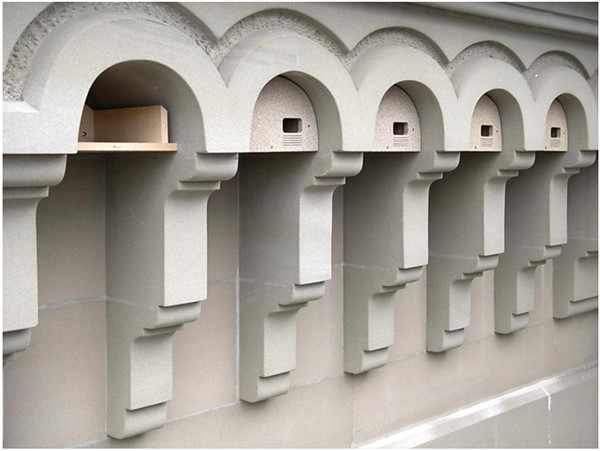
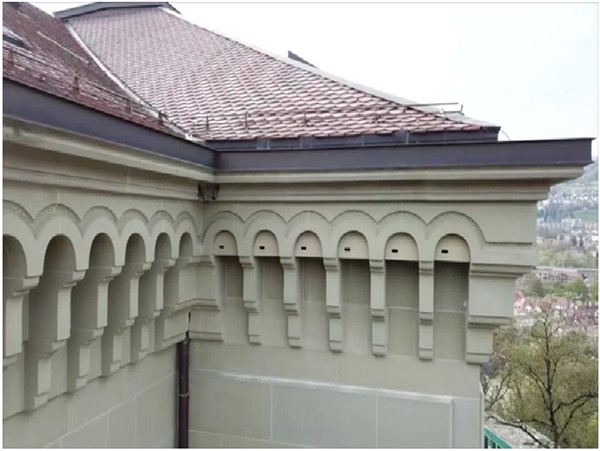
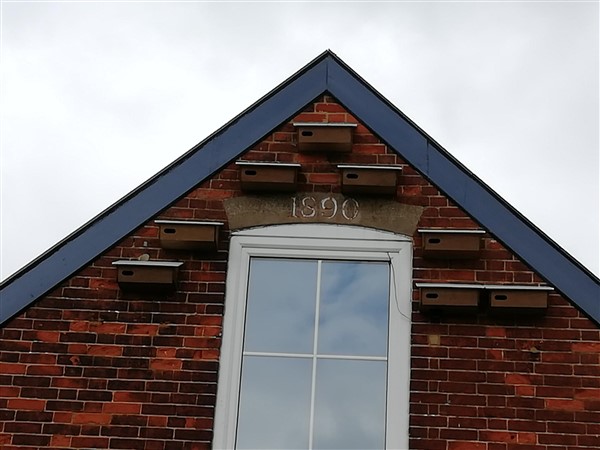
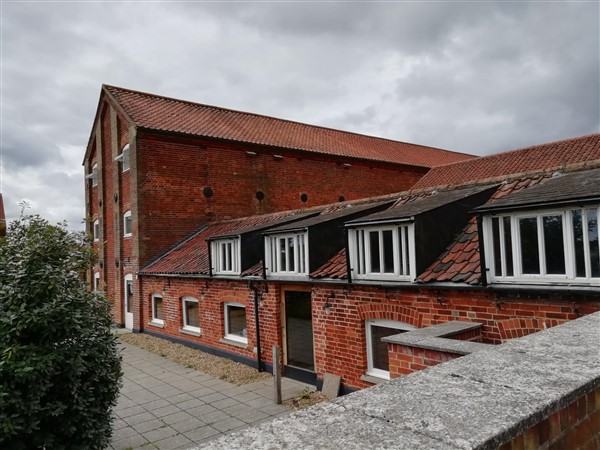
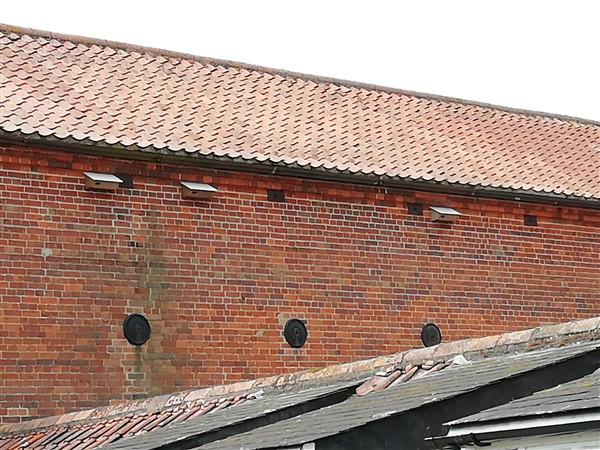





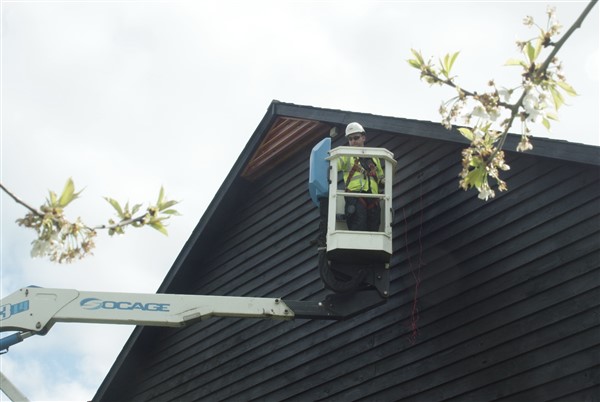
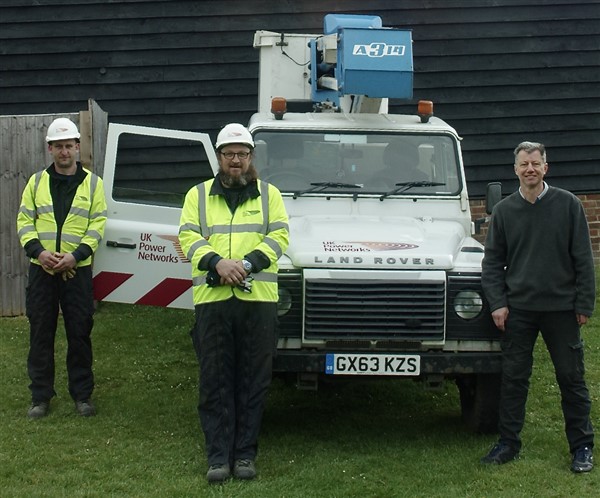
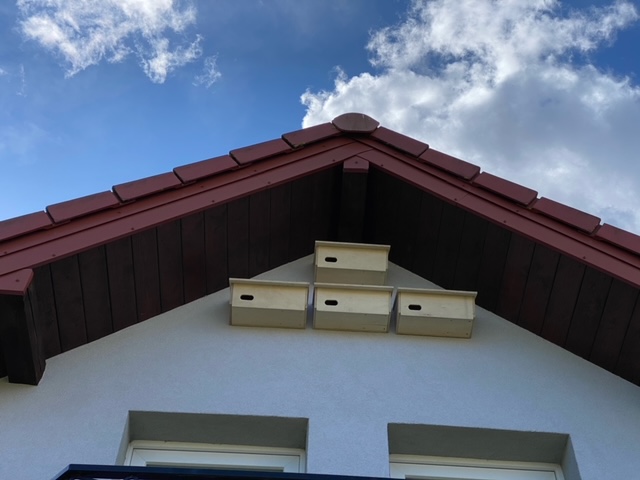
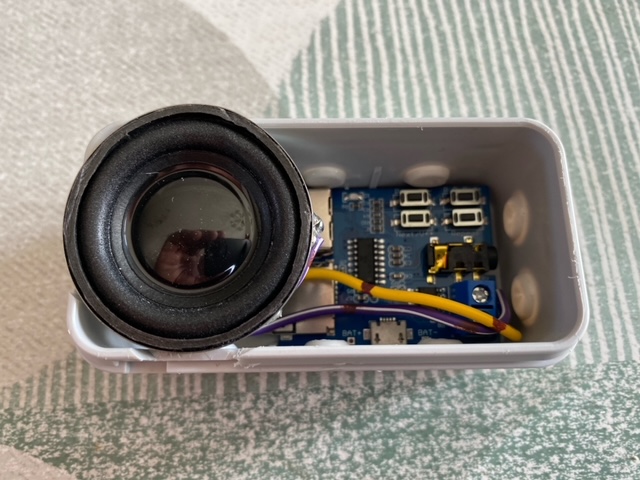



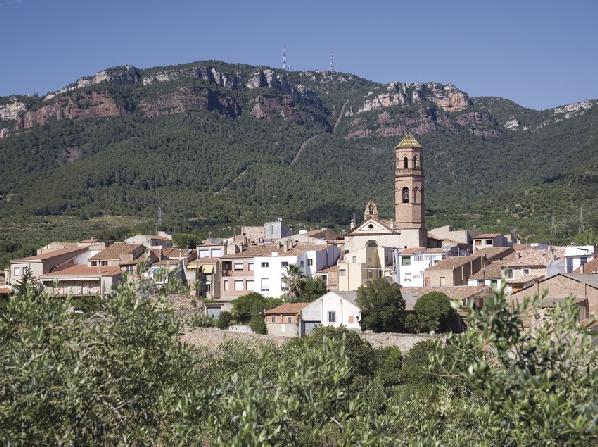







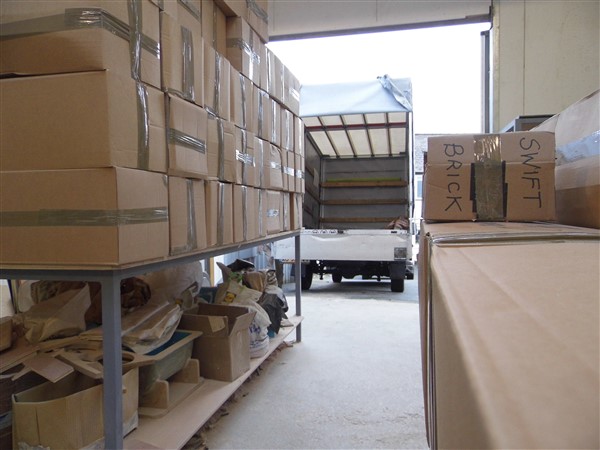





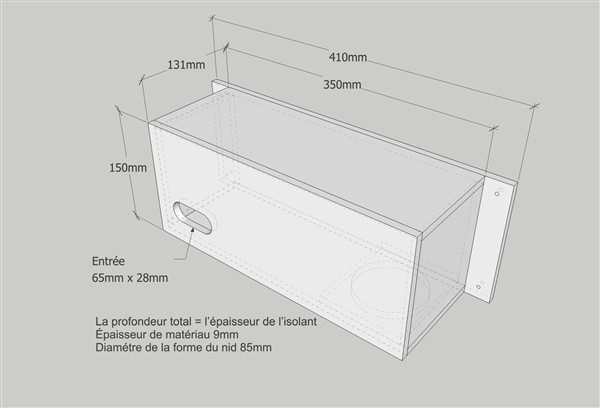
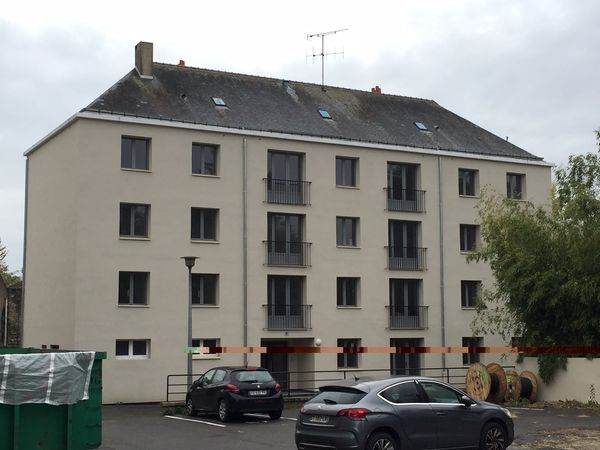






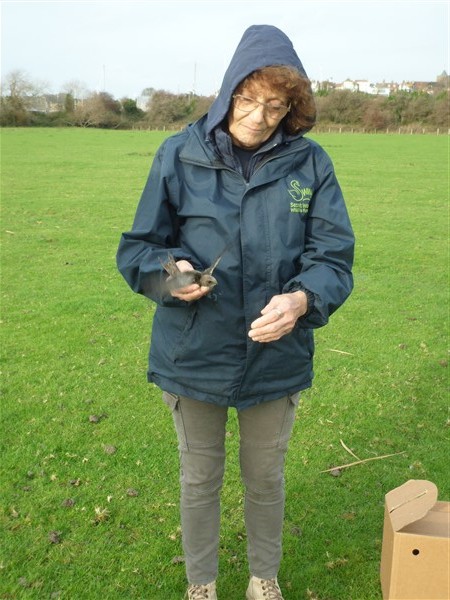





















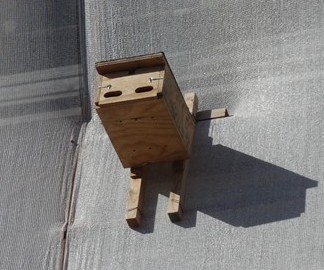




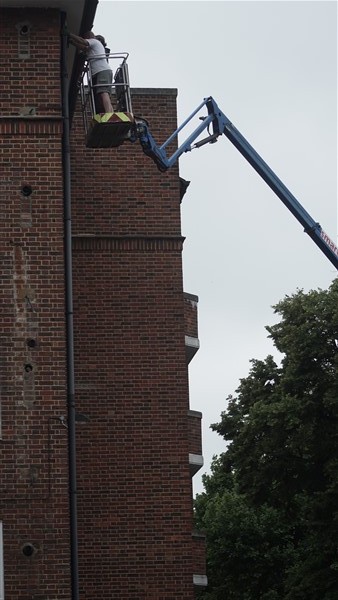




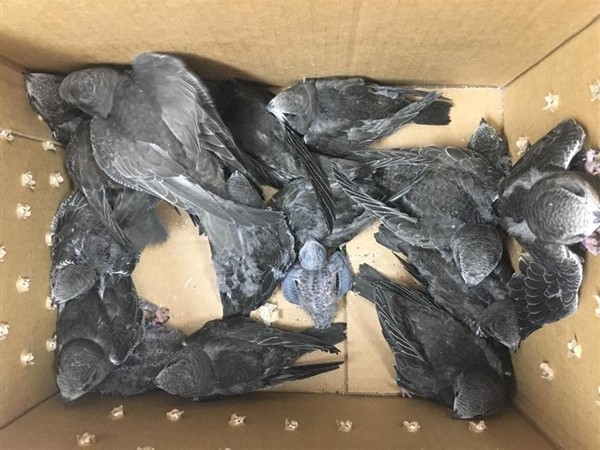







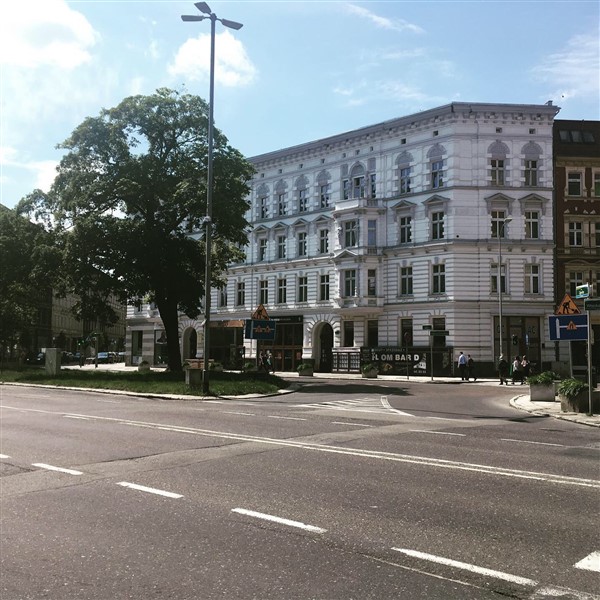
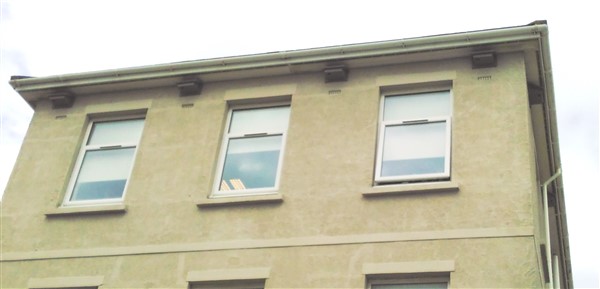
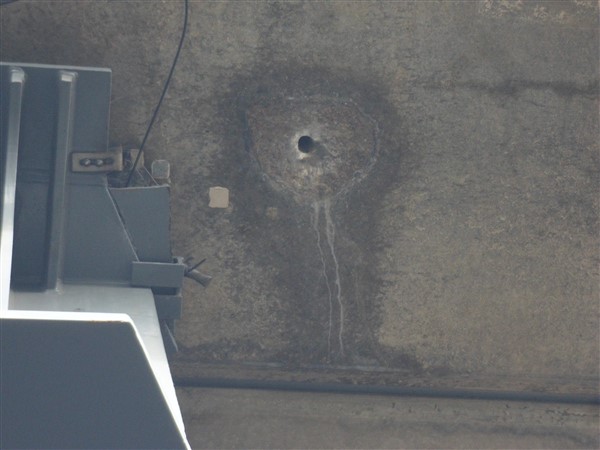
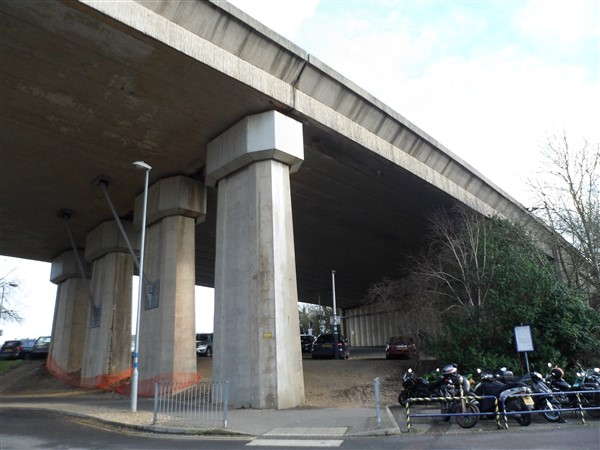
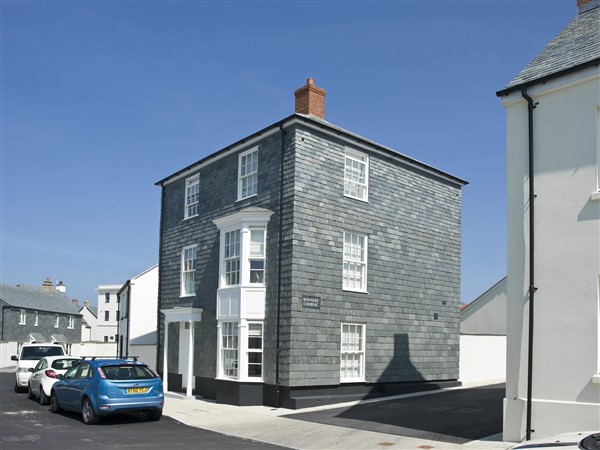
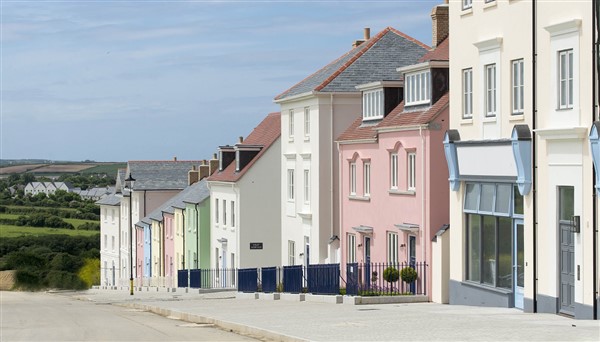
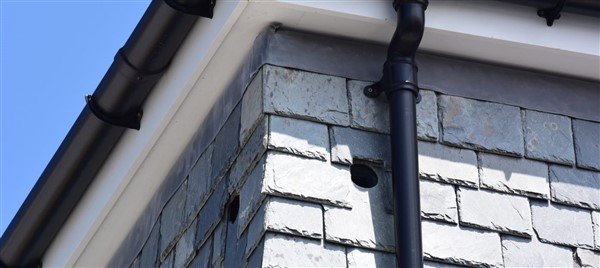



















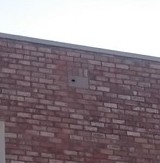




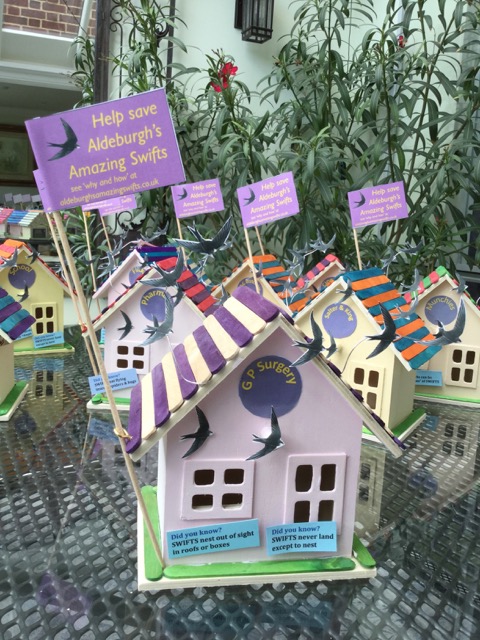







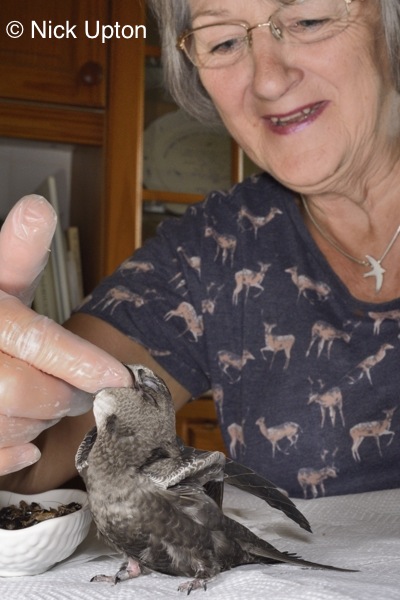











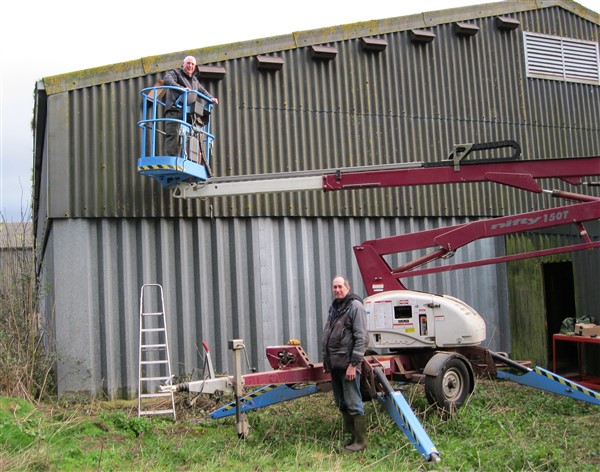




 Chris
Packham graced our stand and had a good look at
our work for Swifts, including an exciting new project
in Harleston, new integral and wall-mounted nest
boxes and the famous Cheng-Sheng Swift call system.
Chris
Packham graced our stand and had a good look at
our work for Swifts, including an exciting new project
in Harleston, new integral and wall-mounted nest
boxes and the famous Cheng-Sheng Swift call system.



























































 Left:
The four boxes as they appear from
inside the Tower, mounted in one
of the empty window frames shown
above. The black oblongs on the
back of each box are labels, and
the gap at the base of the window
is to let in Swallows to continue
to nest inside the Tower.
Left:
The four boxes as they appear from
inside the Tower, mounted in one
of the empty window frames shown
above. The black oblongs on the
back of each box are labels, and
the gap at the base of the window
is to let in Swallows to continue
to nest inside the Tower.







 Matt played the Swift attraction CD last year
and this, and got his first pair this year. Here is the result, a
beautiful young Swift almost ready to fledge .
Matt played the Swift attraction CD last year
and this, and got his first pair this year. Here is the result, a
beautiful young Swift almost ready to fledge .






 Photo
© Robert Freeman
Photo
© Robert Freeman













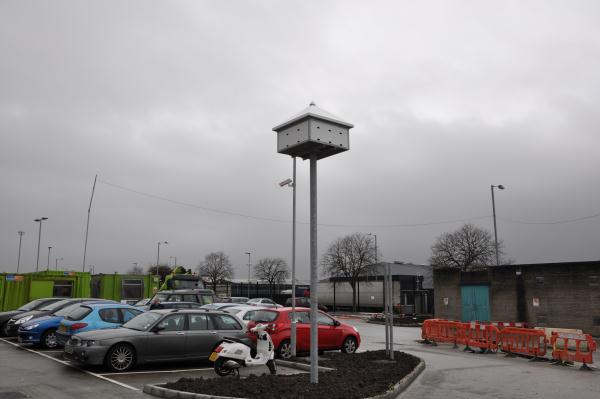

 left:
details of the boxes
left:
details of the boxes









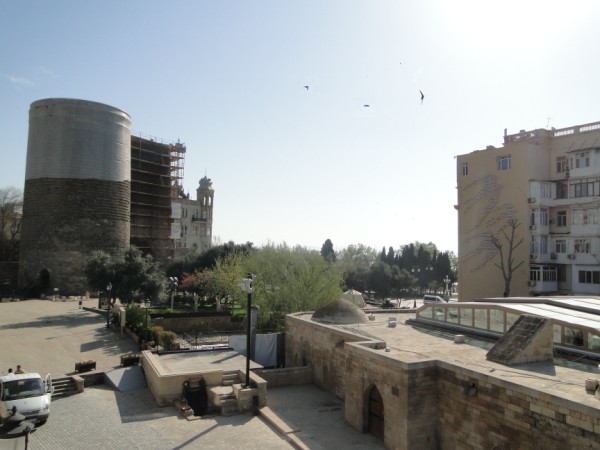
















 Photograph
© Beth Hales
Photograph
© Beth Hales











































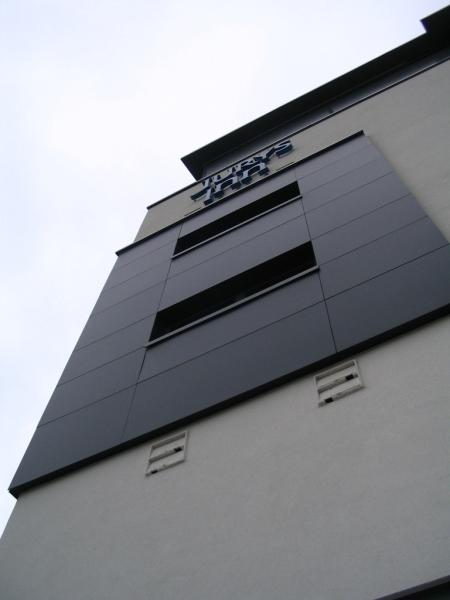
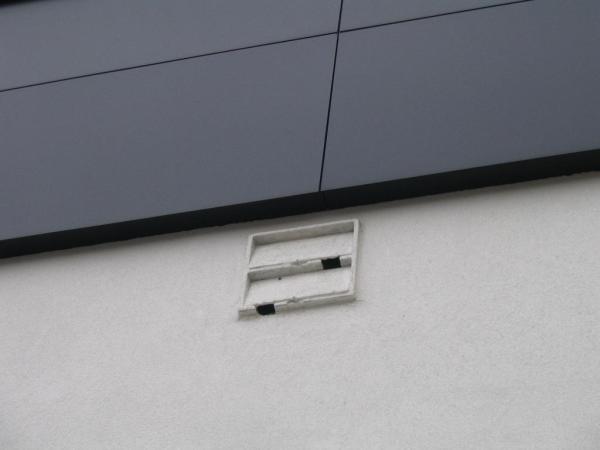
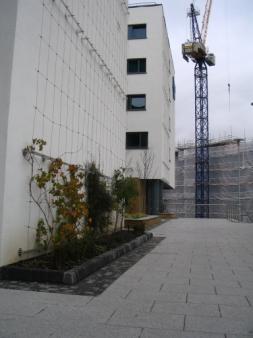
 He
used a Swift Calls CD to
attract the birds to a previously unused nesting area.
He
used a Swift Calls CD to
attract the birds to a previously unused nesting area.